Version 1.5 launched this week and it's a pretty big one. There's a new dye system, extra colour evolutions for a handful of outfits, and the introduction of the Star Sea ensemble, an iconic fit in the Nikki series. Aside from the multitude of bugs it seems to have introduced—if you can even get into the game to experience them right now—there's been a real subtle monetisation push on Infold's side.
Both of the new Infinity Nikki banners, for example, contain two 5-star outfits that sport a record 11 pieces to collect. That's a maximum of 220 pulls, or 26,400 diamonds just to complete one outfit. For context, all other 5-star outfits have either been nine or 10 pieces each, taking the cost down to 180 pulls and 200 pulls respectively.
It's an extremely small change, but one that's already ringing alarm bells for future outfits. As it stands, Infinity Nikki's banner cadence is already pretty unfriendly to low spenders or free-to-play folk—I fall into the low spender category and have had to skip around half of the banners released since December—and outfits with extra items only make it more difficult for budget-friendly players.
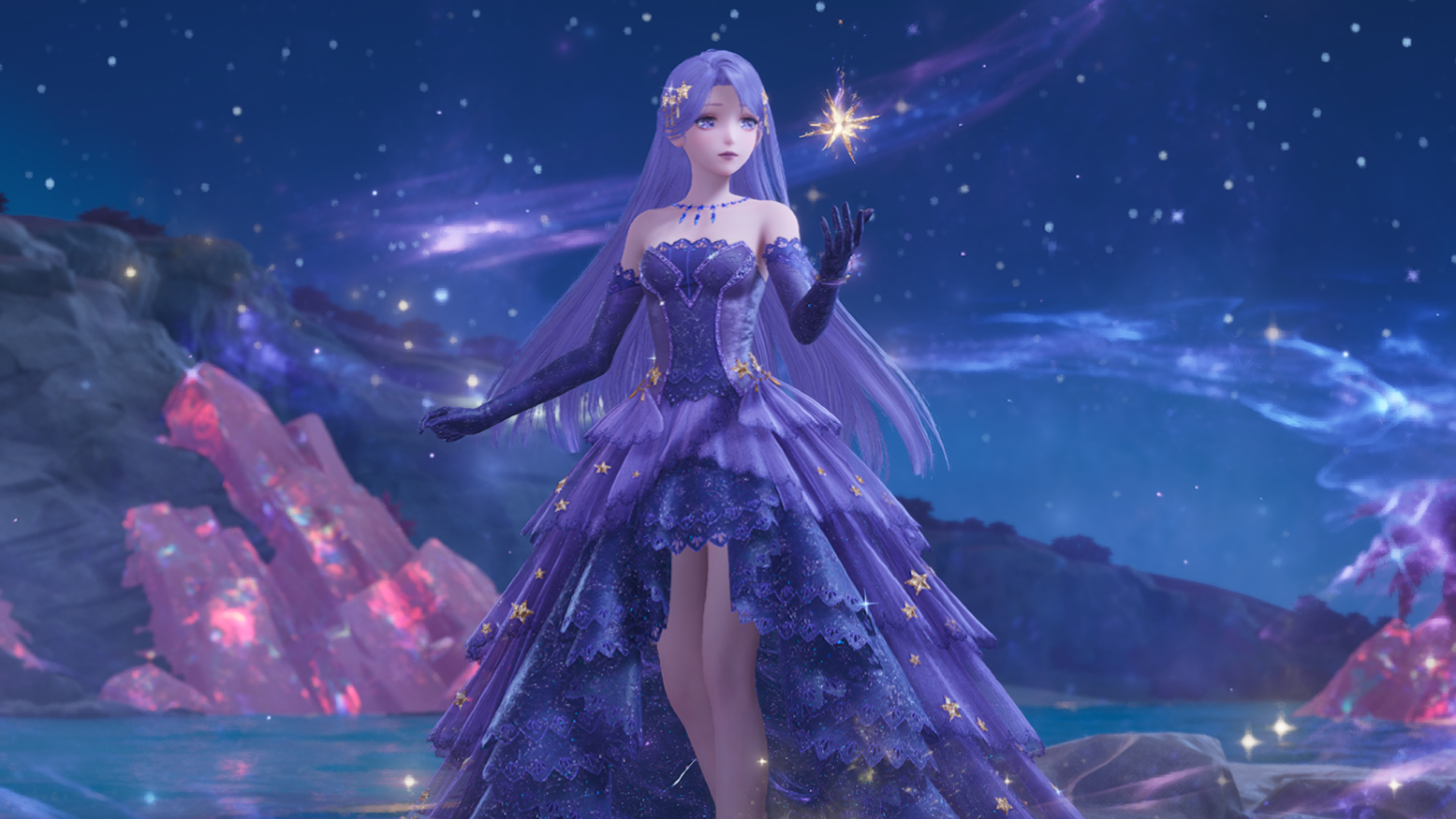
Couple that with the fact that Infold has extended the duration of Mira Crown—the biggest and easiest source of free currency—from two weeks to three weeks, and it's causing more than a few players to feel the financial squeeze.
Chinese players in particular seem deeply unhappy with the changes, and haven't been shy about vocalising their thoughts and even reaching out across the pond to potential stylists in the west in an attempt to deter them.
The forums for the new Steam release has been the main vessel for this, with an absurd number of both Chinese language and English translated posts venting frustrations. One forum post called Infinity Nikki "a fraudulent product that betrays its core promise," citing "pity system sabotage" and "progres-resetting crashes" as issues.
Another titled "Don't play! Don't play! Don't play!" claimed Infold was "a game company that only stares at the player's wallet" and called some of the Version 1.5 changes "sneaky". Another post simply calls for a maximum of 180 pulls to obtain a full outfit.

I could go on forever, as there's around a dozen pages right now, the majority filled with these posts. As someone who's been playing both gacha games and the Nikki series for a hot sec, seeing Chinese players reach out to English-speaking communities to vent frustrations and band together is an incredibly rare occurrence. Most of this noise usually tends to happen over on Chinese social media like Billibilli.
Whether it's because Steam's a pretty easy vessel to connect the two communities, or if it's because the situation is truly so dire that folk are crossing oceans and language barriers to protest, I don't know. Maybe a bit of both. It's still in the early hours of the new update so no word from Infold yet. It's done a good amount of backpedaling on unfavorable additions in the past, though, so I expect to see at least some sort of acknowledgement in the coming days.
]]>These issues come as a result of the 1.5 update which rolled out on April 28 and have caused issues for Infinity Nikki across all platforms including its own launcher. Although they aren't exclusive to the Steam release, it definitely doesn't reflect well for players who have waited for the launch, and the disappointment is obvious.
One player took to Steam reviews to share that "the game crashes when I try to open it. I tried several times, but it crashes at different points. I haven't been able to come far enough to join a server." Another shared that they had been a player since the original release in December, but the 1.5 update has "a lot of bugs" and "generally isn't all that stable."
In addition, multiple players have left a bad review sharing that their issues stem from using Linux too, with one user stating that "Linux is unnecessarily blacklisted" from launching the game. Another shared that they had "hope for the Steam release, but yet again I'm not able to play it on Linux." Both resulted in a "not recommended" review.
In a post shared to the official Infinity Nikki blog about the 1.5 update, players are encouraged to report any issues found through customer service in the game. But since so many players are being met with a black screen rather than being able to load the game, it's no surprise they are taking to reviews in an attempt to be heard.
However, given just how many people are having issues with the game thanks to the newest update I'm hopeful that Infold is working on rolling out a fix as soon as possible so we can go back to exploring Miraland. Or at least publish a statement acknowledging the issues people are raising and reassuring us that some sort of solution is on the way.
]]>Created by the late French illustrator and game developer Beno?t Sokal, Amerzone introduced the world that was later used by the Syberia games, but tells a different, self-contained story. Set in a fictional region of South America inhabited by fantastical creatures, it puts you in the shoes of a nameless journalist tasked with returning the last egg of a species of giant bird to the region, according to the dying wishes of zoology expert Alexandre Valembois.
At the time, Amerzone was praised for its advanced 3D visuals and was a big hit for Microids, selling a million copies. Comparisons were drawn to Myst, which Sokol cited as one of his major inspirations for the game. Indeed, I wonder whether it was Cyan Worlds' recent overhaul of Myst that prompted Microids to give Amerzone similar treatment.
According to Amerzone's Steam page, the remake "naturally pays tribute to the original game, but also offers a totally new experience of it." Primarily, this comes in the form of a significant visual overhaul. There's a gif on the Steam page comparing the old and new versions of the game's Jesuit priest David Mackowski, and it's quite the improvement. The original Mackowski looks like a jump scare, while the new one looks like an actual person.
While it's pleasing to see this adventure gaming artefact get a new lease of life, the broader future of the Syberia series looks highly in doubt. Sokol died during the production of 2022's Syberia: The World Before, and the game is dedicated to his memory.
Moreover, Microids reportedly laid off its entire Paris team—who developed both The World Before and this Amerzone remake, earlier this month. While I wonder how big the audience is for an Amerzone remake in 2025, laying off the development team before the game it made even has a chance to prove itself is brutal.
Amerzone – The Explorer's Legacy is available now for $40 (?35). There's also a demo available on the game's Steam page, if you'd like to try it before you buy.
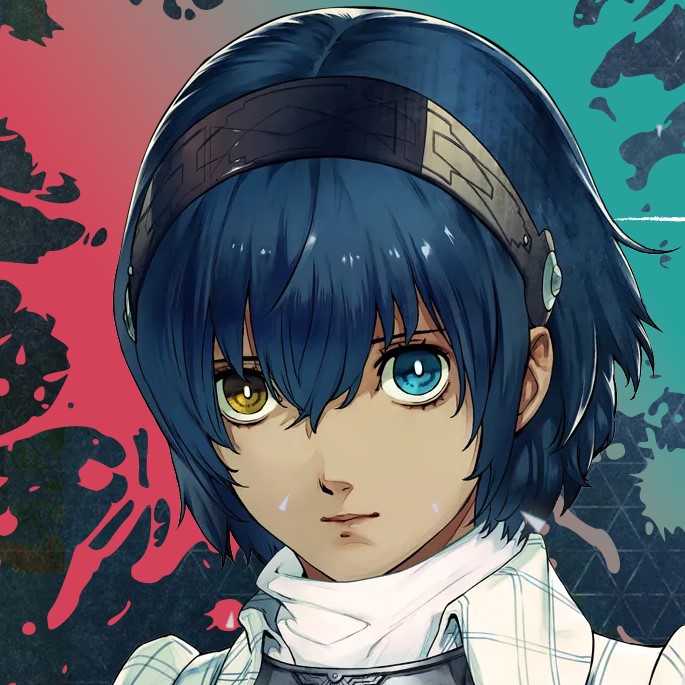
Best cozy games: Relaxed gaming
Best anime games: Animation-inspired
Best JRPGs: Classics and beyond
Best cyberpunk games: Techno futures
Best gacha games: Freemium fanatics
What is it? A time-hopping adventure game set in NYC.
Release date April 23, 2024
Developer Wadjet Eye Games
Publisher Wadjet Eye Games
Reviewed on RTX 4090, Intel i9-13900k, 32GB RAM
Steam Deck Verified
Link Official site
Time travel is perhaps the most deliciously compelling of all the sci-fi conceits because it taps into something so incredibly human and primal that we're all burdened with: regret. By turning back the clock, we can fix all of our mistakes. A better version of our lives is just one time jump away—at least in Wadjet Eye's brilliant new adventure game, Old Skies.
Not for Fia Quinn, though. A ChronoZen agent in 2060s New York, she serves as guide, bodyguard and fixer for tourists with enough money to book some time in the past. In this tantalisingly close future, she gets to watch people make their time tweaks, and all the changes they create just wash over her.
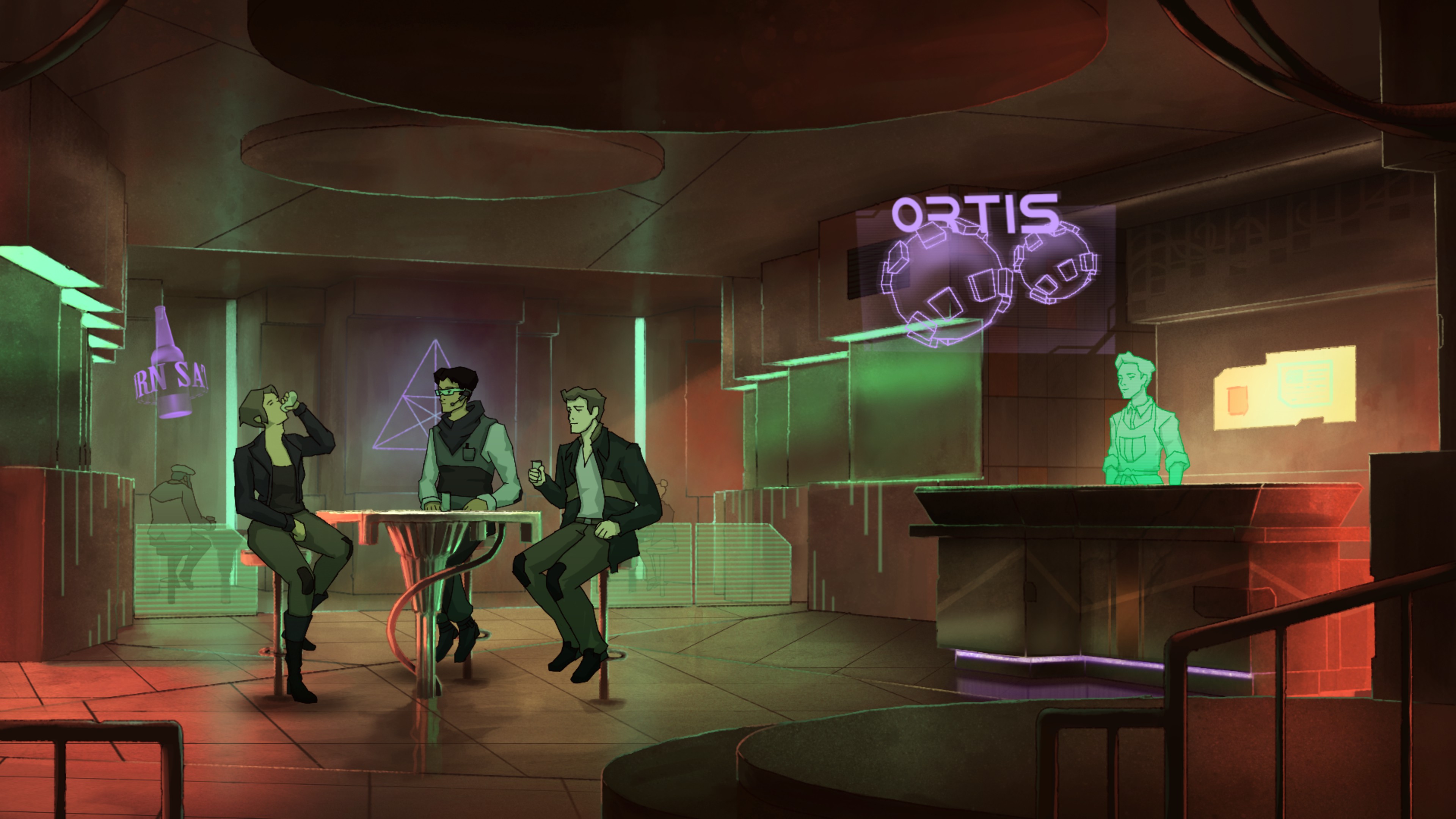
See, like her fellow ChronoZen agents—and important historical events, people and even buildings—Fia's chronolocked. This means she's unaltered by the constant changes to the timeline—even her personal timeline. One moment, she might have a spouse and a child who she's never technically met before, the next she's a free-spirited party girl. But from her perspective, she's always the same Fia—immutable, diligent, lonely and dedicated entirely to the job.
As we enter Fia's life, she's an experienced, busy agent helping her clients fix their present by exploring the past. It's a job that tends to come with complications. Sometimes clients go rogue. Simple missions might get tangled up in elaborate mysteries. And then there's the risk of getting shot in the head—something that happens repeatedly. It's a good thing her handler, Nozzo, always has a finger hovering over that rewind button.
Old Skies' conundrums are not the sort of thing that'll lead to your own head wounds, as you smash your face against the keyboard. Indeed, most of the time they're pretty simple—at least compared to the ridiculous leaps that so many other point and clicks expect you to make. Logic and common sense will keep you moving forward at a good clip, most of the time. But the puzzles are also frequently tactile and playful, and crucially they don't forget that you're a time traveller.
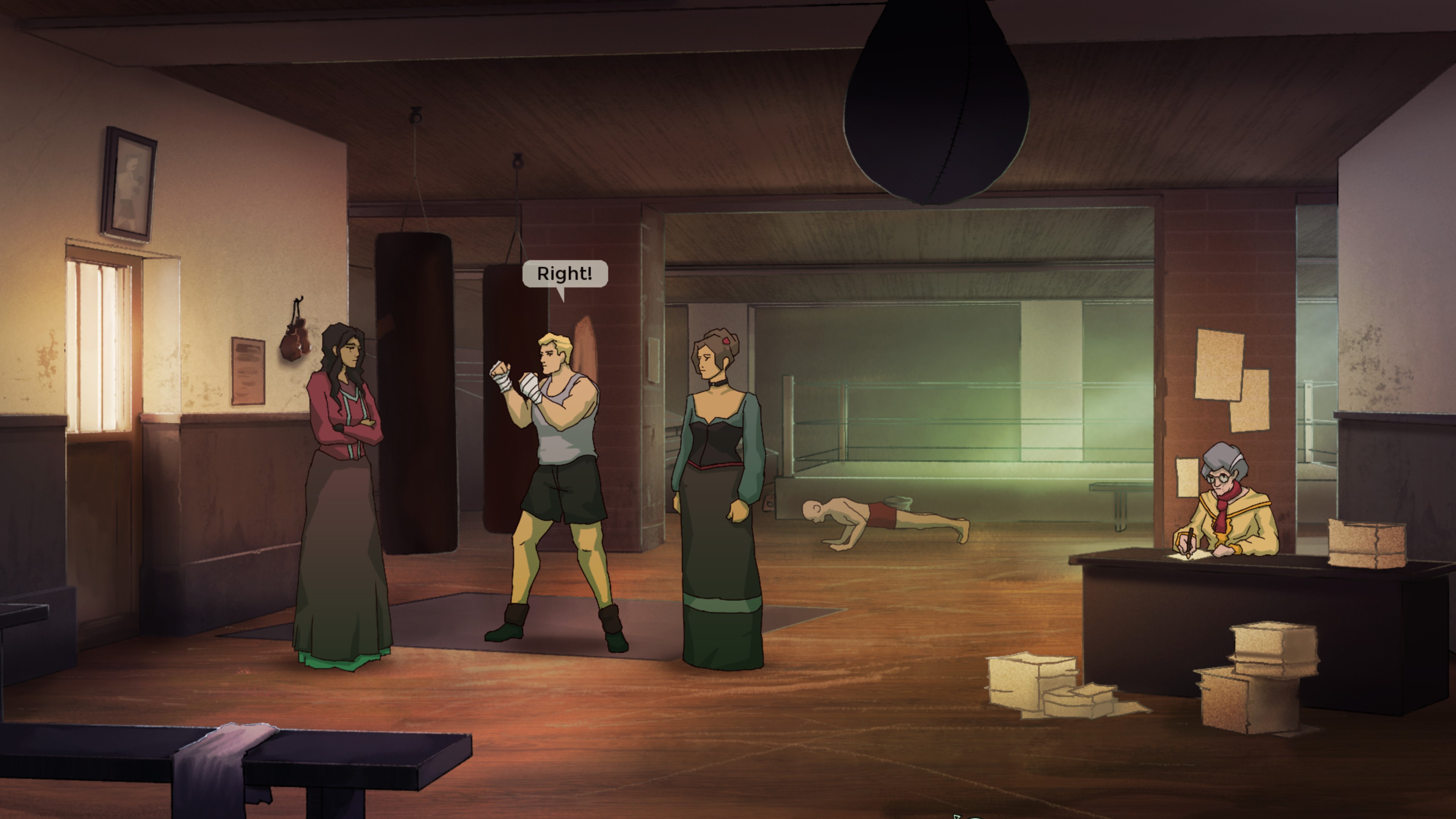
Sometimes that means you can resolve obstacles simply by searching the historical record. Other times, it means you'll need to hop between two different time periods, making changes in the past to solve problems at a later date. One of my favourites sees you trying to save your own life in 30 minutes by creating a life-saving drug that doesn't exist yet, using ingredients that have ceased to exist.
I took a few notes here and there, but mostly because middle age has stolen my ability to remember things for more than a minute. Like most Wadjet Eye games, especially those created by Dave Gilbert, the puzzles are fun rather than challenging. But the end result is largely the same: I always feel incredibly satisfied. I might not feel like a genius for solving them, but they're still clever and fulfilling.
One thing that is a little different from the rest of Wadjet Eye's oeuvre is the art. Artist Ben Chandler's vibrant, hand-painted backgrounds persist, but the character art has made the switch from intricate pixel art to something more evocative of a comic book: bold colours, thick lines, and a hand-drawn, sketched quality. I thought I'd miss the classic pixels more, but this new style is so confident and the characters so lively that I grew to dig it just as much.
Storytime
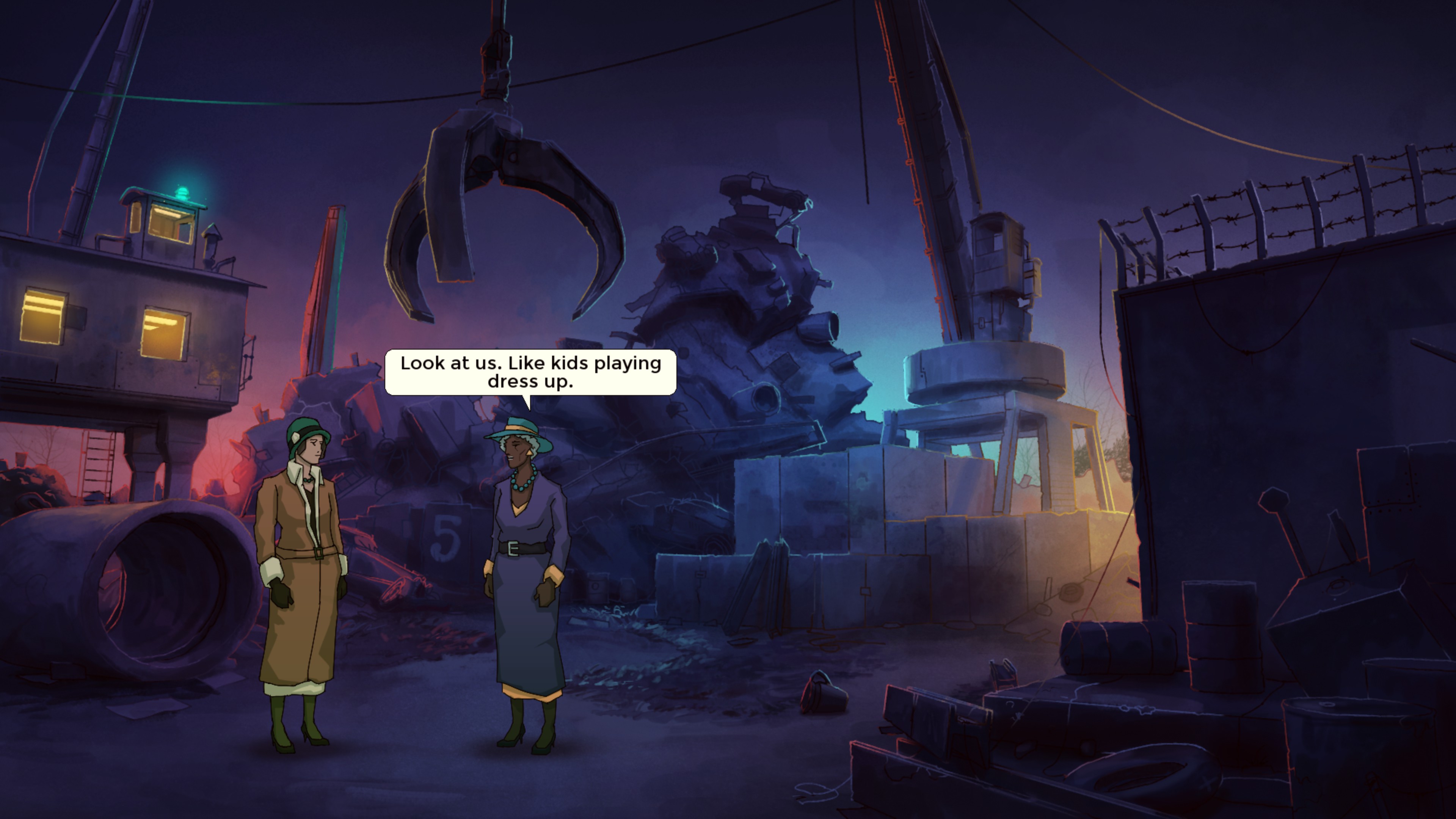
The art, puzzles and Thomas Regin's jazzy, bluesy score all contribute towards this being another feather in Wadjet Eye's cap, but I found myself even more smitten than usual this time, elevated as Old Skies is by the potency of the writing and the large cast's phenomenal performances. Gilbert's adventure games have never let me down in this regard, but this feels like a notable leap forward.
The missions initially have an anthology-like vibe—each a discrete adventure set in a different era, but always in New York. They are intimate examinations of human nature, but equally stories about the changing face of the city that Gilbert has spent his career depicting. These aren't really our stories, though. Like Fia, we are observers and facilitators. At first, anyway.
But Old Skies slowly grows into a cohesive story of love, loss and regret that started to punch me in the gut with alarming regularity. There were a few points where I simply had to stop playing for a wee bit to regain my composure. As Fia develops more agency, more personal connections, a desire to have a real life rather than just being stuck in the eye of the storm, surrounded by an ever-changing reality, Old Skies truly becomes something special.
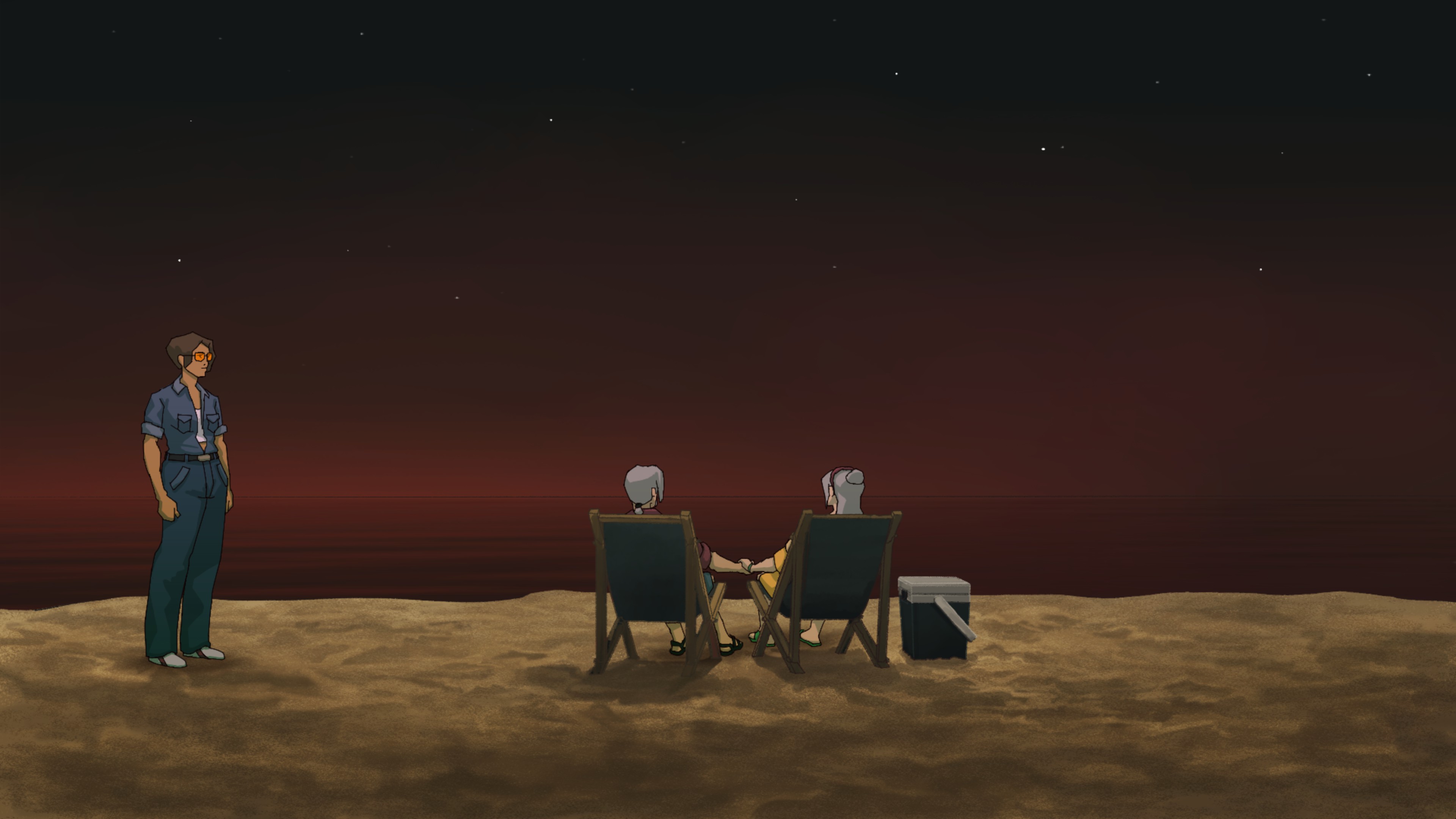
My heart shattered into a million tiny pieces as I listened to her recite her mantra, "Focus on the job", after she'd once again had a chance at a sliver of happiness mercilessly ripped away from her by another change in the timeline. Rather than devolving into melodrama, Sally Beaumont's understated performance is uncomfortably real—you can feel Fia's composure and experience as she tries to move on, but also her weariness, and the cracks snaking across the surface of the walls she's been maintaining for all these years.
Her journey from composed workaholic to tragic hero chips away at all the sci-fi gizmos and macguffins until you've just got this incredibly heartfelt story. Too many time-hopping adventures—especially videogame ones—get lost in the high-stakes, sci-fi nonsense, but Old Skies is far more interested in familiar, evocative human stories, finding the root of what makes time travel such a gripping concept, and then keeping that at the heart of everything.
It's beautiful, sad and one of my favourite adventure games.
]]>When I sat down to play Lost Records: Bloom & Rage’s Tape 2, I was surprised just how much anticipation I felt. Over two months since the release of its first part, Bloom, the quartet of punk girls finding themselves through riot grrrl had sunk into my heart. How could they not when I saw so much of myself—who I was, who I wanted to be—in them.
What is it? A choices-filled narrative adventure through '90s girlhood nostalgia
Release date: Part 1 February 18, 2025; Part 2 April 15, 2025
Price: $40 / ?36
Multiplayer: No
Developer: Don't Nod Montréal
Publisher: Don't Nod
Reviewed On: RTX 3060 Ti, Intel i7-10700F, 32GB DDR4
Steam Deck: Verified
Link: Official site
Tape 1 ended in a messy but emotional climax that revealed Kat, the weird girl of the group who makes zines and feels like the small town is killing her, is indeed dying. Leukemia. Much in the mold of Stand By Me, it was obvious this would be everyone's last summer together, though with supernatural elements and many questions left unanswered, a part of me hoped that we could amend this past, record over the tape, or rewind to some point that would change things. Tape 2, Rage, instead leaves mostly dead space.
I want to draw out the wordplay. It’s mimetic how Tape 2 arrives after delays that belie some development problems. Bugs give it away, and so does the short length. Tape 2 is not a whole second part, but a third act. It feels like its flame is burning up too bright, too soon. And so is Kat’s, right? There’s some probably unintentional meaning there, and it affects me, though I’m left wanting to see all that could have been if both Don't Nod Montreal and Kat had more time.
Tape 2 adds very little new to engage with. As in Bloom, I pick up intricately modeled objects around the levels, examine them, and find clues to the story and puzzles. I also use Swann’s camcorder to record these memories and edit together videos. There are gestures towards some iteration that could’ve been (in one scene Nora misremembers a story and time is rewound like a tape) but there is ultimately very little play in Tape 2.
At least half of the four hours must have been spent in cutscenes, which did still offer me dialogue choices that continued to shape my relationships to each girl, but were edited together with more noticeable gaps and continuity errors. It starts to look like an unintentional '90s homage to Xenogears and its infamously curtailed disc 2 that was all visual novel instead of JRPG.
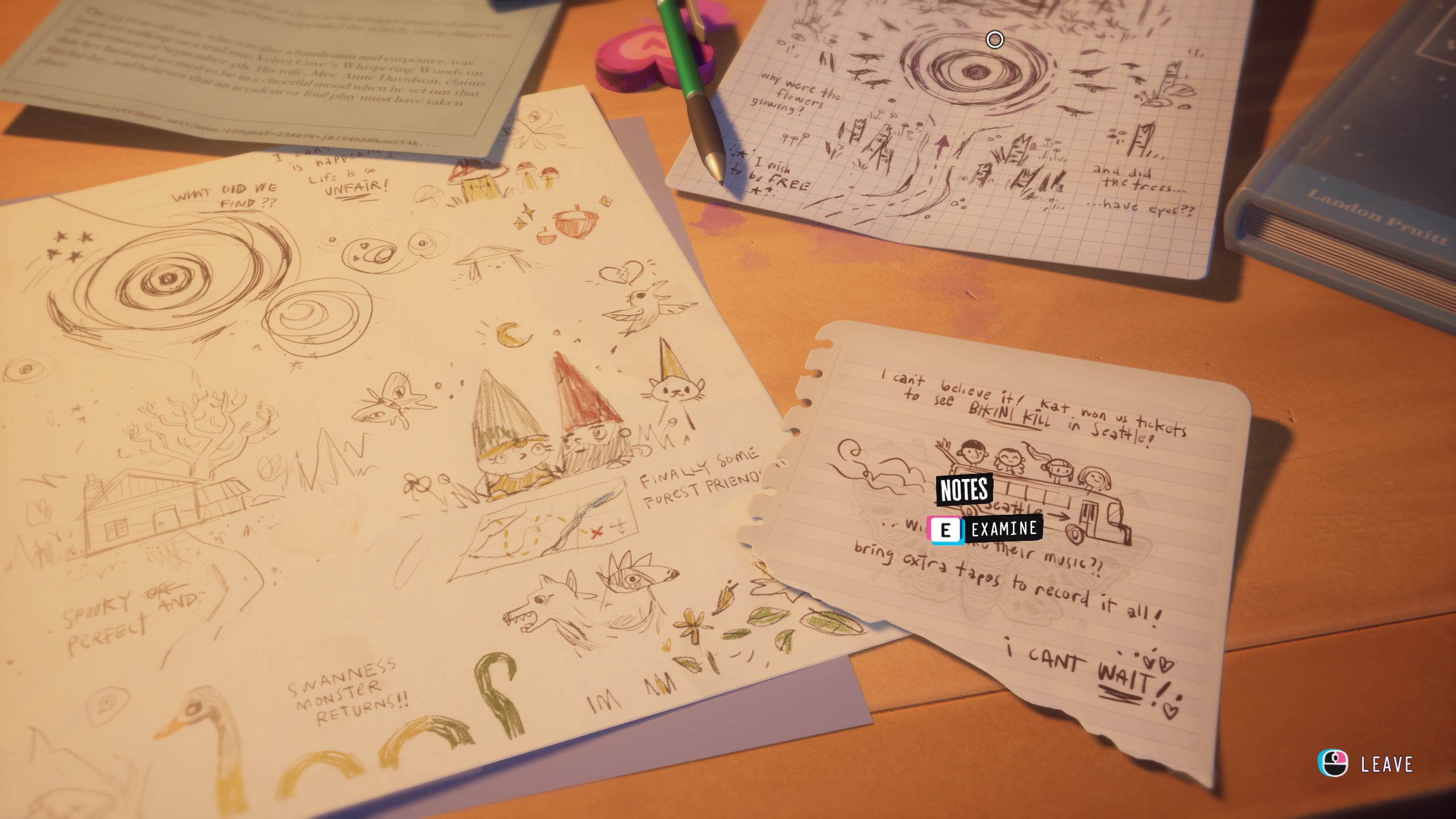
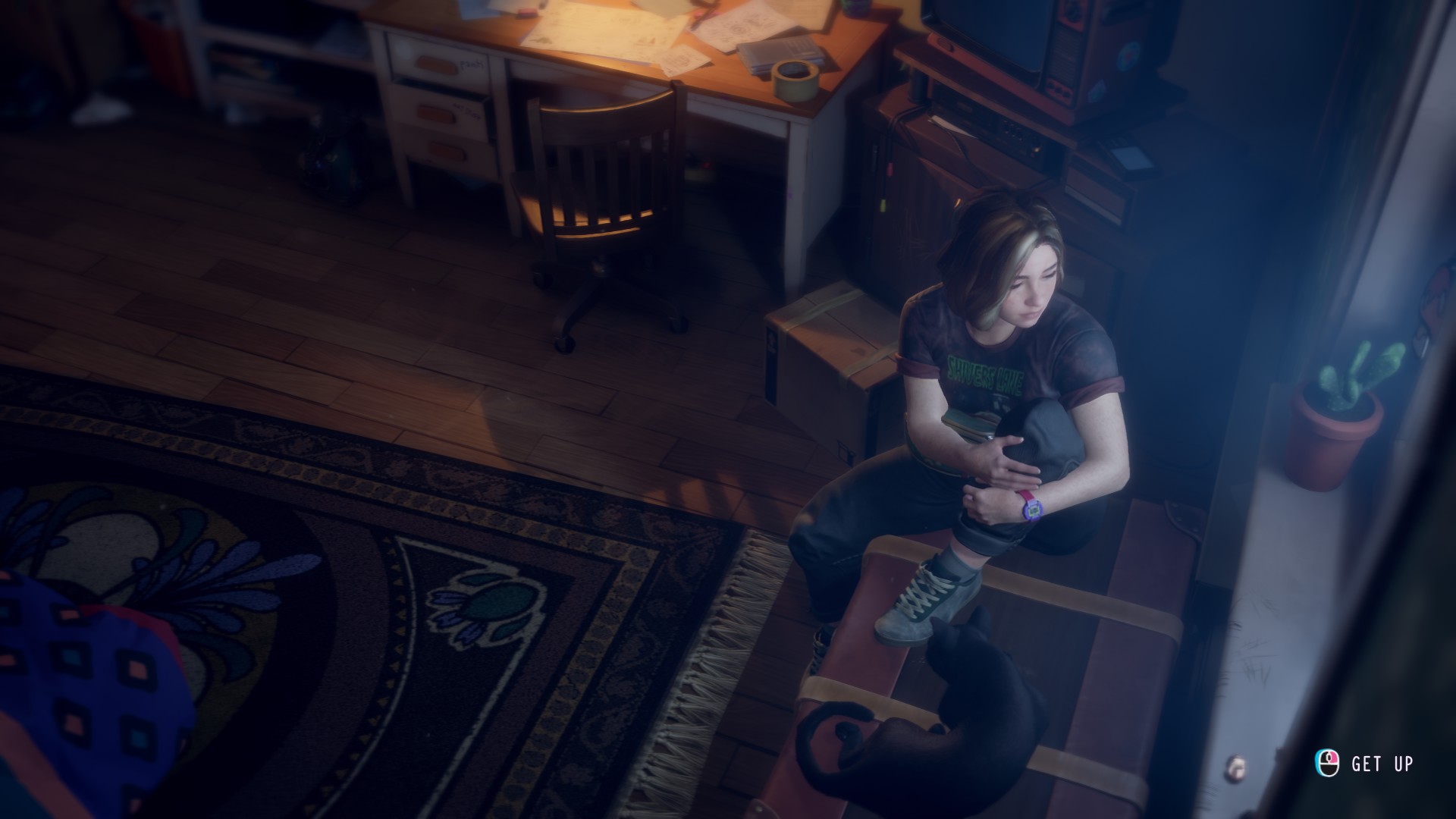
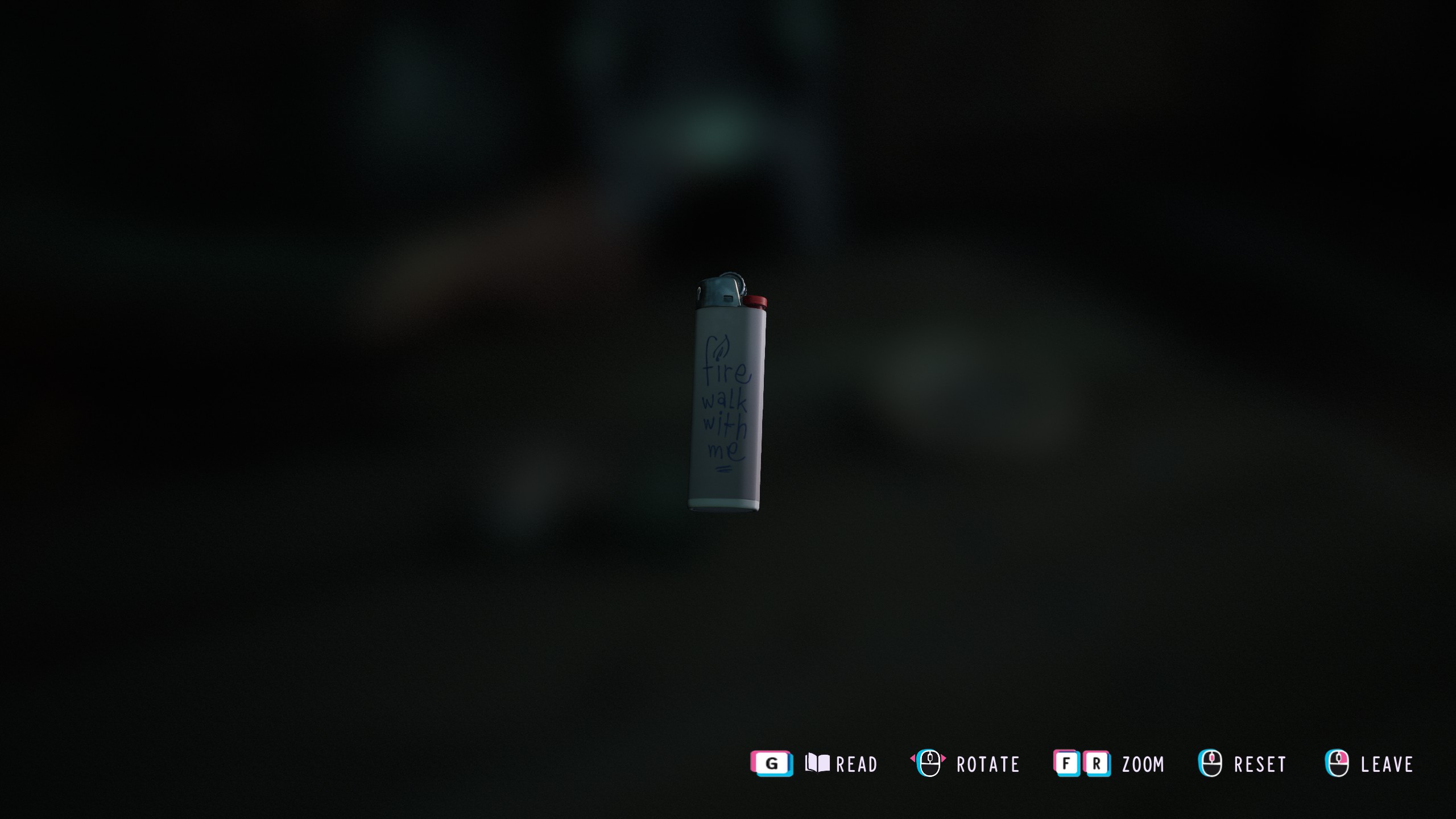
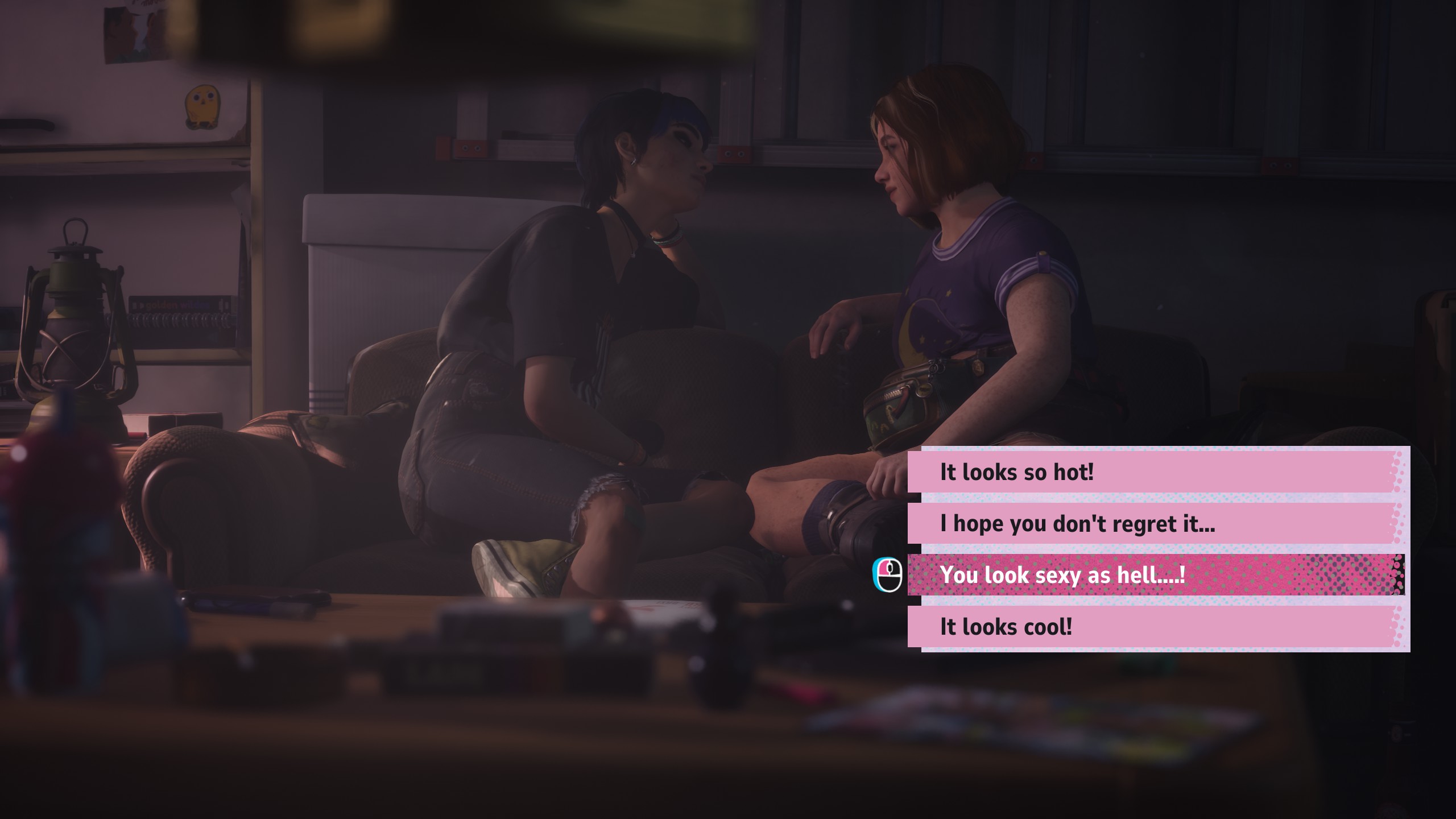
While there's little for me to actually do, Tape 2 does reach its narrative and thematic conclusion. It still feels too fast, but this is almost appropriate given Kat's dwindling vitality. And while I have not yet read closely the many branches that the ending accommodates to consider how much can change in response to the player, I can see how the ending is shaped around the relationships I chose to prioritize. I don’t think there’s any bad ending, but some emphasize the bigger themes the game is interested in. And those are worth talking about.
It shows gay bashing and intimate partner violence as much a part of a nostalgia for the '90s that remains unspoken, but not unremembered
It is not just Kat who must die. In the finale each girl is beaten, chased, harassed, and torn from girlhood, the impetus for their coming-of-age being the death of their innocence to the violence in the world. This grows from the discordant undertones of nostalgia heard in Tape 1. It shows gay bashing and intimate partner violence as much a part of a nostalgia for the '90s that remains unspoken, but not unremembered.
Lost Records makes its protagonists feel as viscerally strong as the movement—empowered by riot grrrl and feminism and makeup and each other—and as weak as the children they are—powerless to remain together once Swann’s family moves away at the end of the summer. There is another axis. Not powerless, but consigned to be abused. Ultimately, what the quartet rebels against with their songs, their hair, their makeup, their clothes, their friendship, and their intimacy is the violence of men.
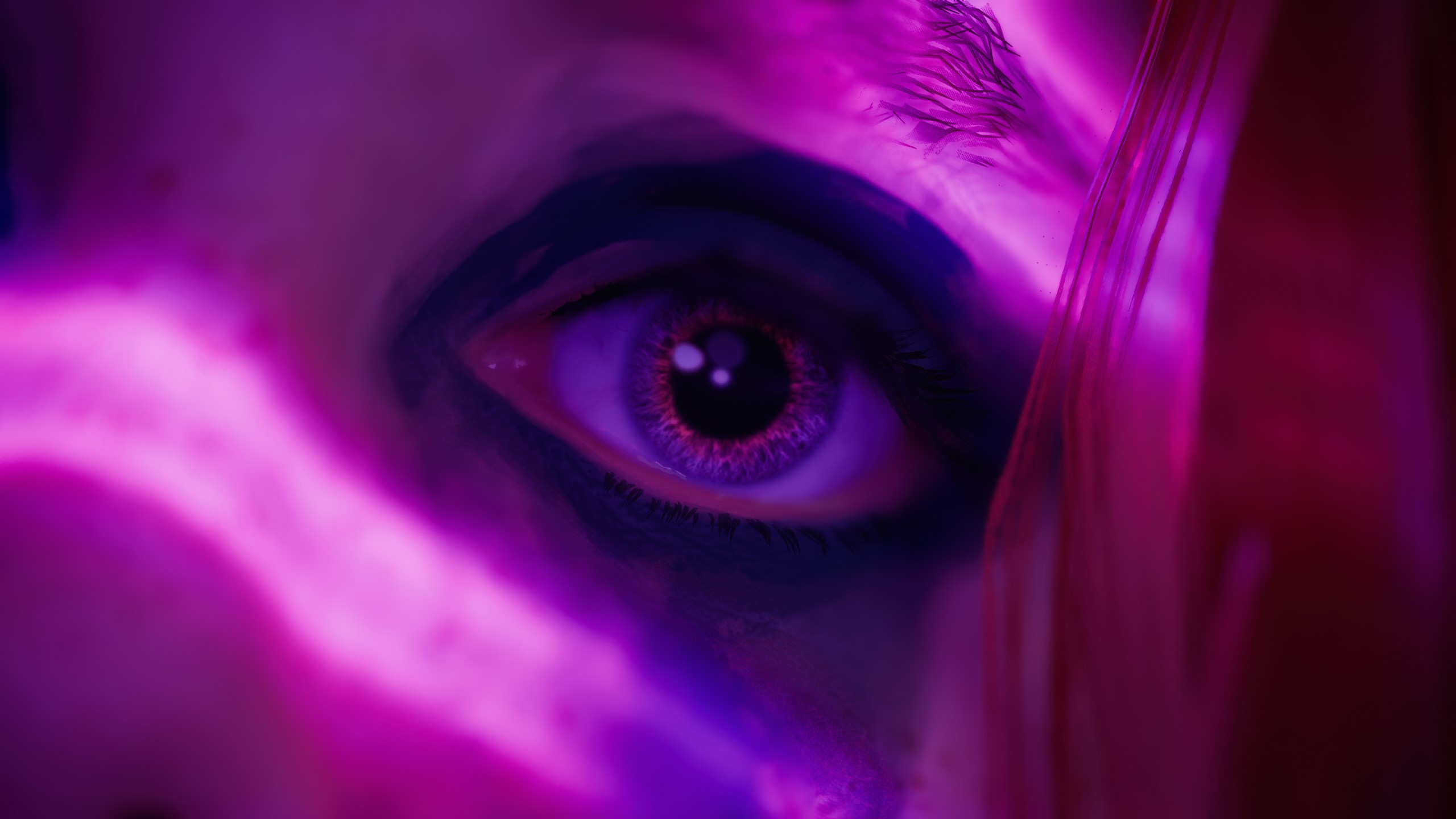
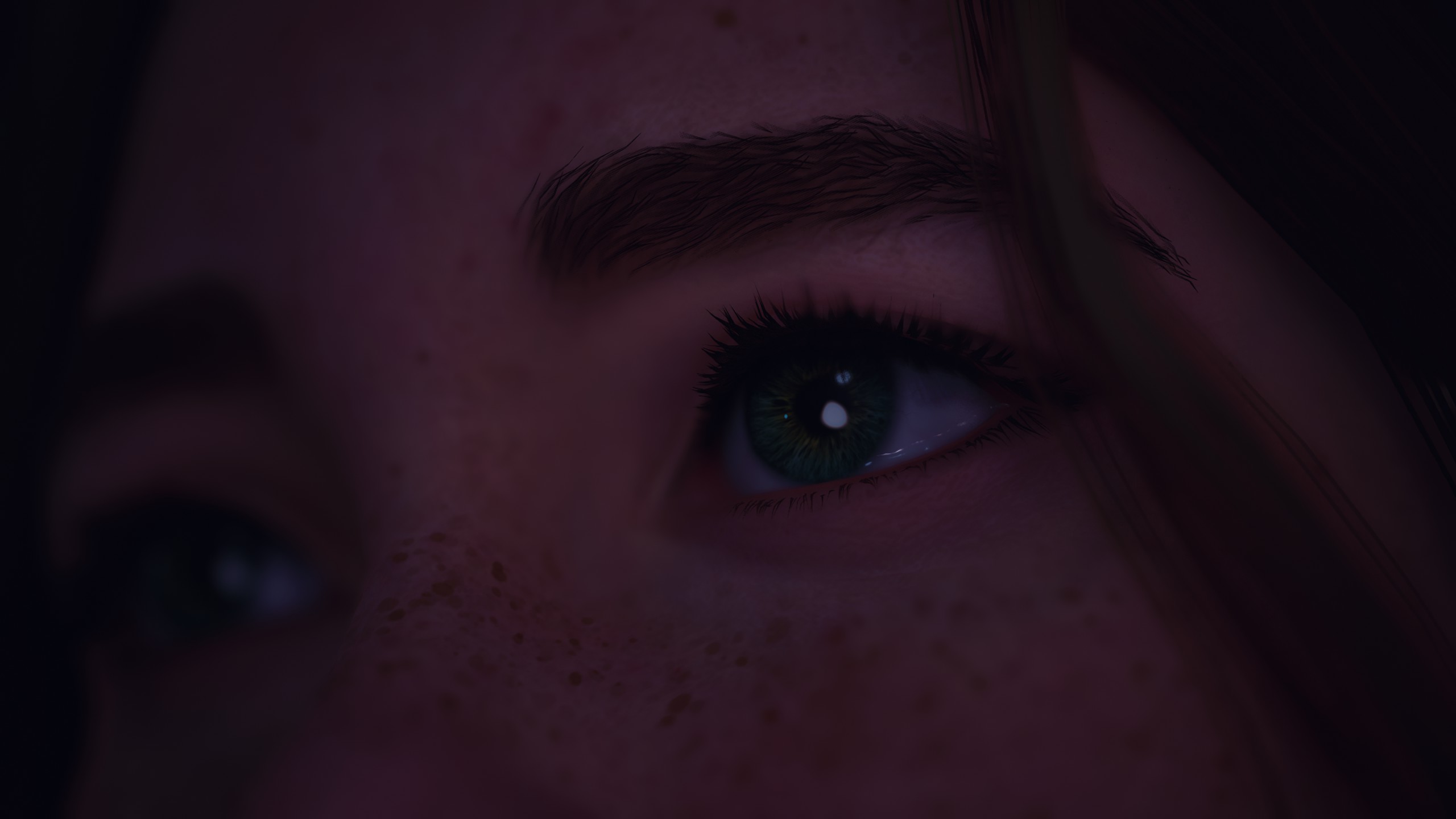
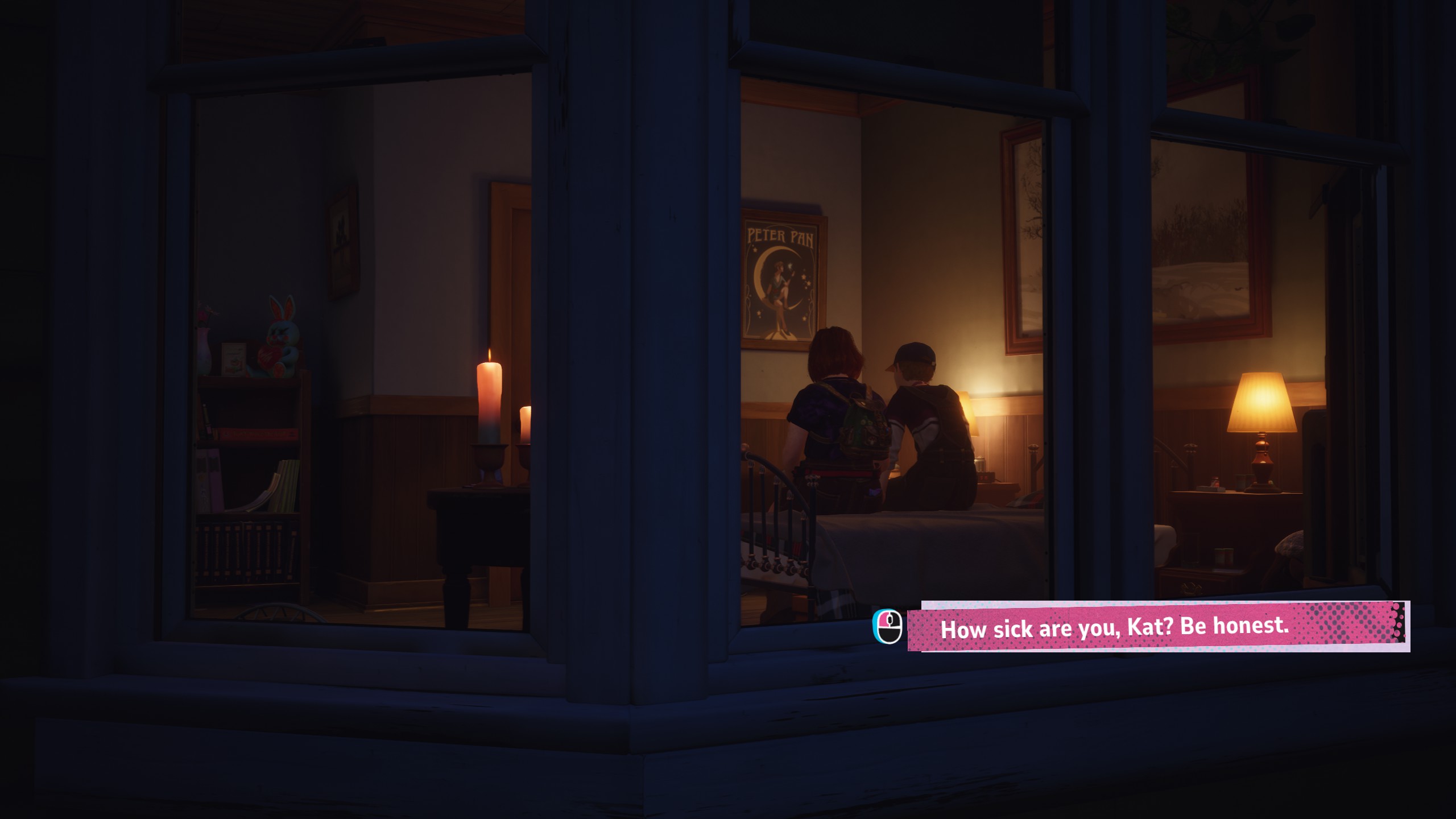
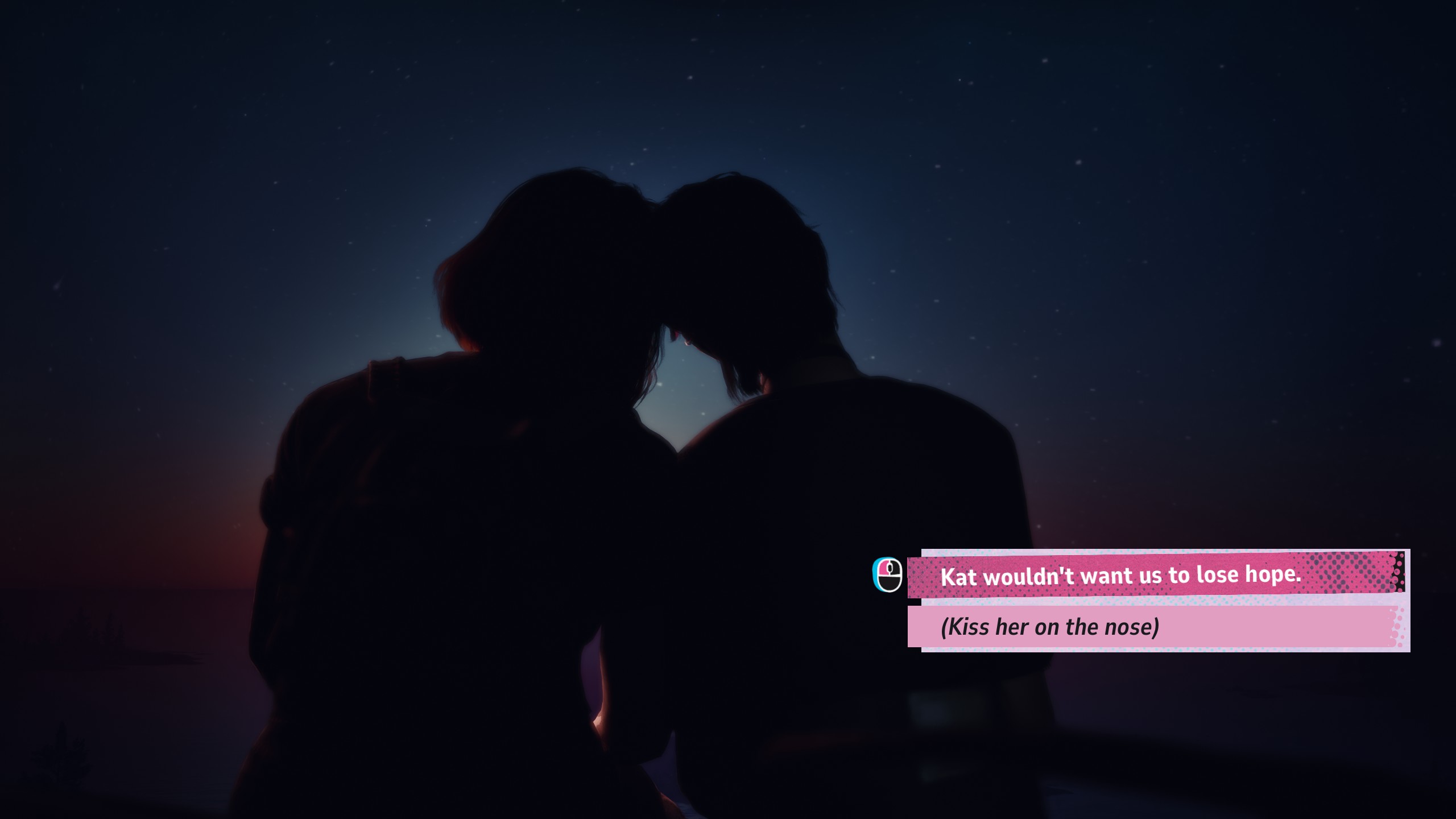
In the present day Nora recalls how we snuck into Kat’s house, broke her out to watch the meteor shower. She offers me a cigarette outside the bar but I decline. I pick up her lighter, turn it over. When she was 16, Nora sang about how small the man was who called her a dyke. She had probably seen Fire Walk With Me when it came out a few years earlier, far too young to understand but woman enough to know what Lynch saw beneath Americana. Now 27 years later she has scratched the title, Laura Palmer’s fate, onto another disposable body.
And this is why Lost Records’ nostalgia in Tape 1 has been resonant to so many queer and trans women playing it this year, why these memories are different from the conservative kind snaking through games culture today. It’s all ephemeral. We don’t hold onto it. Don’t repeat those violences. We realize something like no other has been missing since we were young. Something that can’t be replaced.
And it's why Tape 2's fire is as much a form of nostalgia as the trinkets and movie rentals. They say boys will be boys: Log on to dox a streamer, harass a dev, rage against a world that let the ashes fly. They never forgot the violence of the ‘90s. They just miss the flame.
]]>We described Botanicula in our 2012 review as "the result of Monkey Island and Terry Gilliam falling into a vegan's blender: A gorgeous-looking mix of point-and-clicking surrealism, whipped together out of nature, discovery and adorable humour." And yup, that about nails it: It's weird, funny, heartwarming, and—this is why we're talking about it right now—free for the week on the Epic Games Store.
Botanicula is an Amanita Design game, and if you're familiar with any of the studio's other work then you have a pretty good idea of what to expect. It follows the bizarre adventures of five insectoid weirdos living in a tree that's come under attack by parasitic spiders. That might sound grim, and the spiders are definitely a little creepy, but it's really a lighthearted, upbeat experience overall.
It also bears more than a passing similarity to Amanita's 2018 slapstick adventure Chuchel: Solving puzzles is technically the name of the game, but the real fun is in the aftermath of getting it wrong. As we said in the Botanicula review, "Getting the right answer first time is rubbish: it means you miss out on seeing the failed attempts."
Anyway, Botanicula is a great game, one of Amanita's best (although truth be told, I could point to pretty much any Amanita game and say that), well worth its regular price, and now it's free, which means we really don't need to be talking about it at all—just go grab it.
And yes, for the record, this is the first time Botanicula has been free on the Epic Store—here's our running list of everything that is and has been free from Epic over the years, if you're curious about that sort of thing. This being our first crack at Botanicula makes it an even more notable addition to the freebie lineup.
Botanicula is free on the Epic Games Store until April 24. We'll have this conversation again on that day, because the next Epic freebie is Chuchel. Trust me, you don't want to miss that one either.
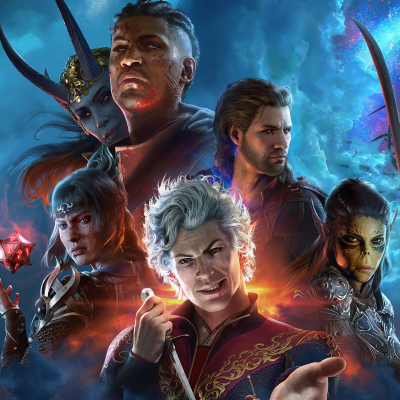
2025 games: This year's upcoming releases
Best PC games: Our all-time favorites
Free PC games: Freebie fest
Best FPS games: Finest gunplay
Best RPGs: Grand adventures
Best co-op games: Better together
You never know what'll catch your eye when you're watching a trailer for a new game: Glitzy graphics, great character design, hot gunplay—or maybe something a little more subtle, as is the case in today's trailer for Ikuma: The Frozen Compass. "Dang, some really good snow in this game," PC Gamer's Tyler Wilde said, a comment that made me curious because really, how good could the snow be? But you know what? Dang, that is some good snow.
Ikuma is a coming-of-age story about a cabin boy named Sam and his sled dog Ellie, who find themselves trapped on an uncharted island in the Arctic in 1864. Venturing through unfamiliar terrain and harsh weather, Sam and Ellie will use the few tools they can find on the island to fish, forage, and try to stay warm and alive. They'll also "find fading traces of a long lost expedition and uncover a dark secret," which I sincerely hope isn't cannibalism. You know how these things go, though.
After taking a moment to appreciate the snow (right around the 32 second mark) and the overall visual style of the trailer which I quite like, I started to get a feeling that this wasn't the first I'd heard of developer Mooneye Studios.
Sure enough, I was right: Mooneye is also the developer of Lost Ember, "a wonderful, unique, and unforgettable experience with a love for nature" that earned a 90% review score in 2019. That's an impressive indie pedigree, and it took me from "yeah, good snow" to genuine interest in what Ikuma is all about.
"We're ridiculously nervous, yet thrilled, to finally be able to talk about what we've been working on in secret for the past five years," Mooneye Studios CEO and story writer Tobias Graff said. "We cannot wait to hear what people think of Ikuma."
Wait they will, though, and so will we: Ikuma isn't expected to be out until sometime in 2026. It's available for wishlisting now on Steam.
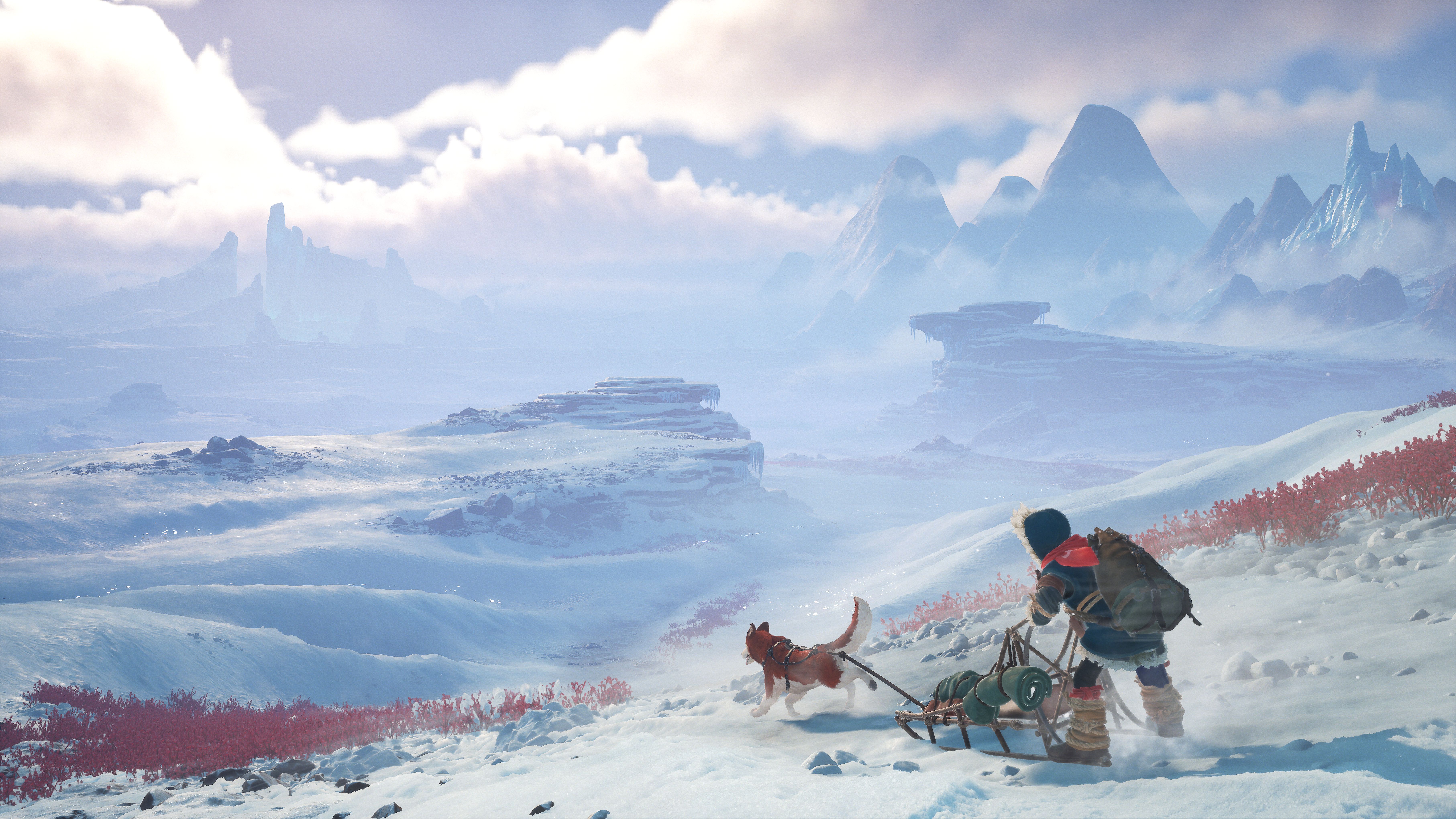
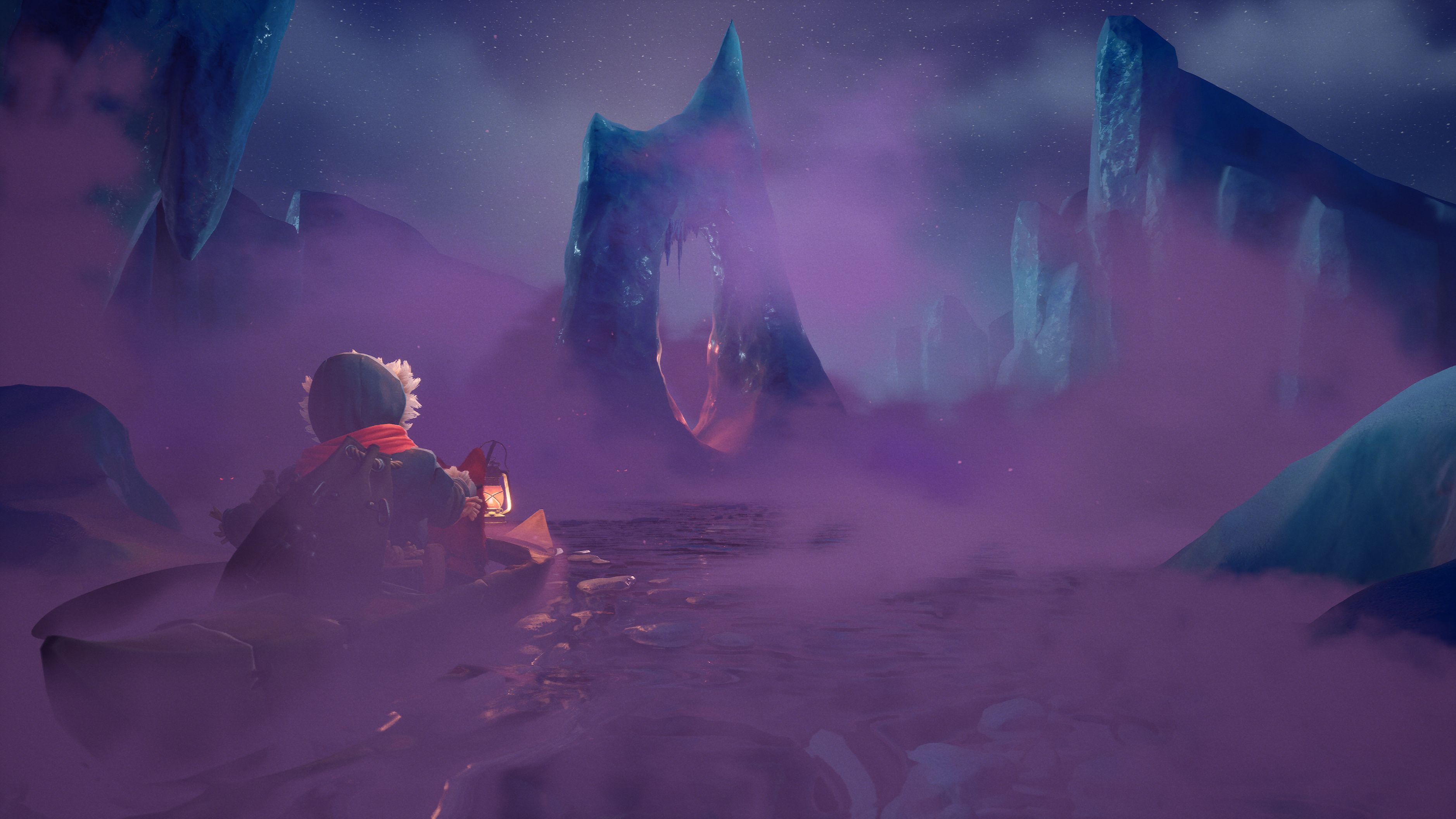
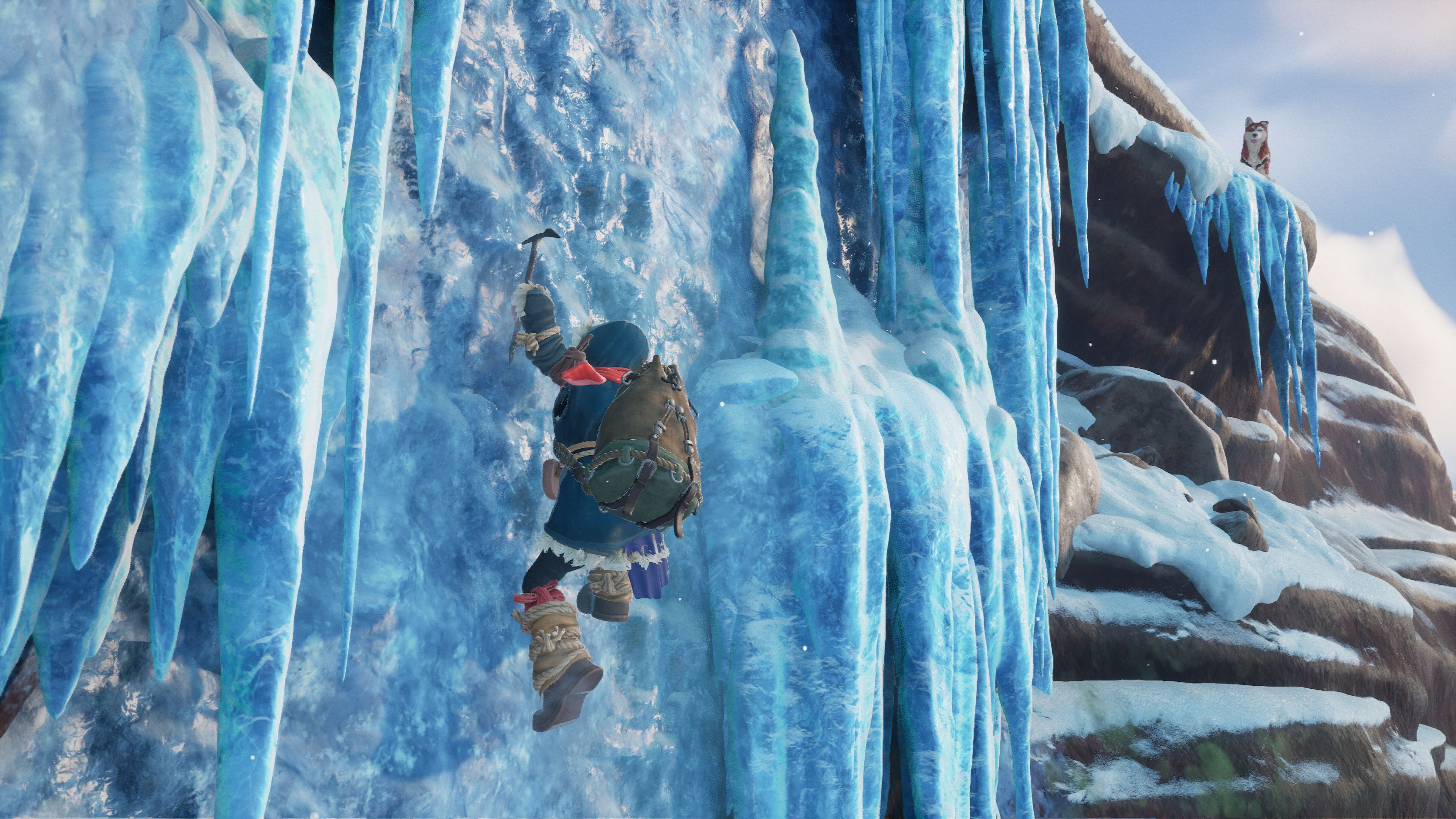

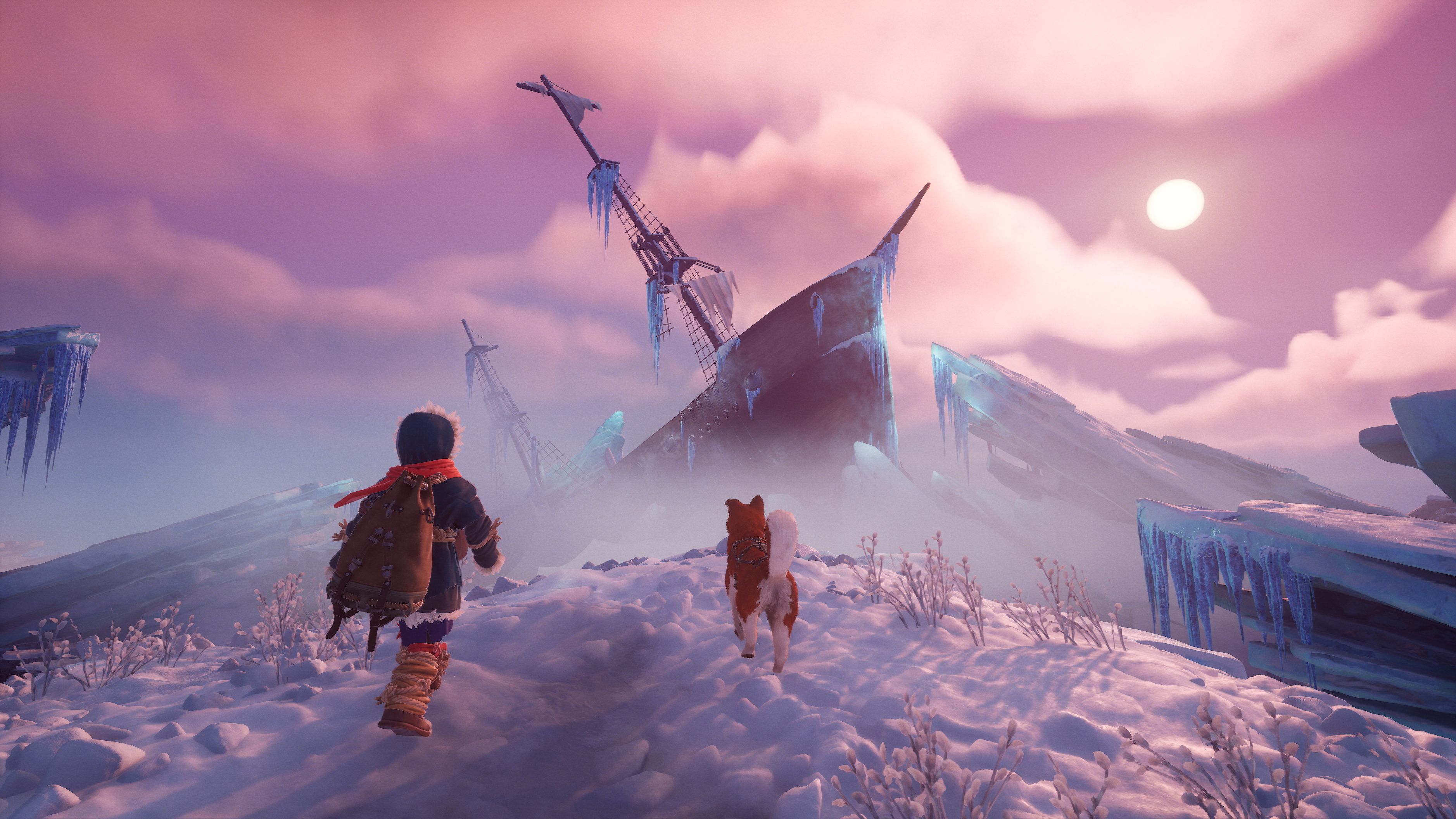
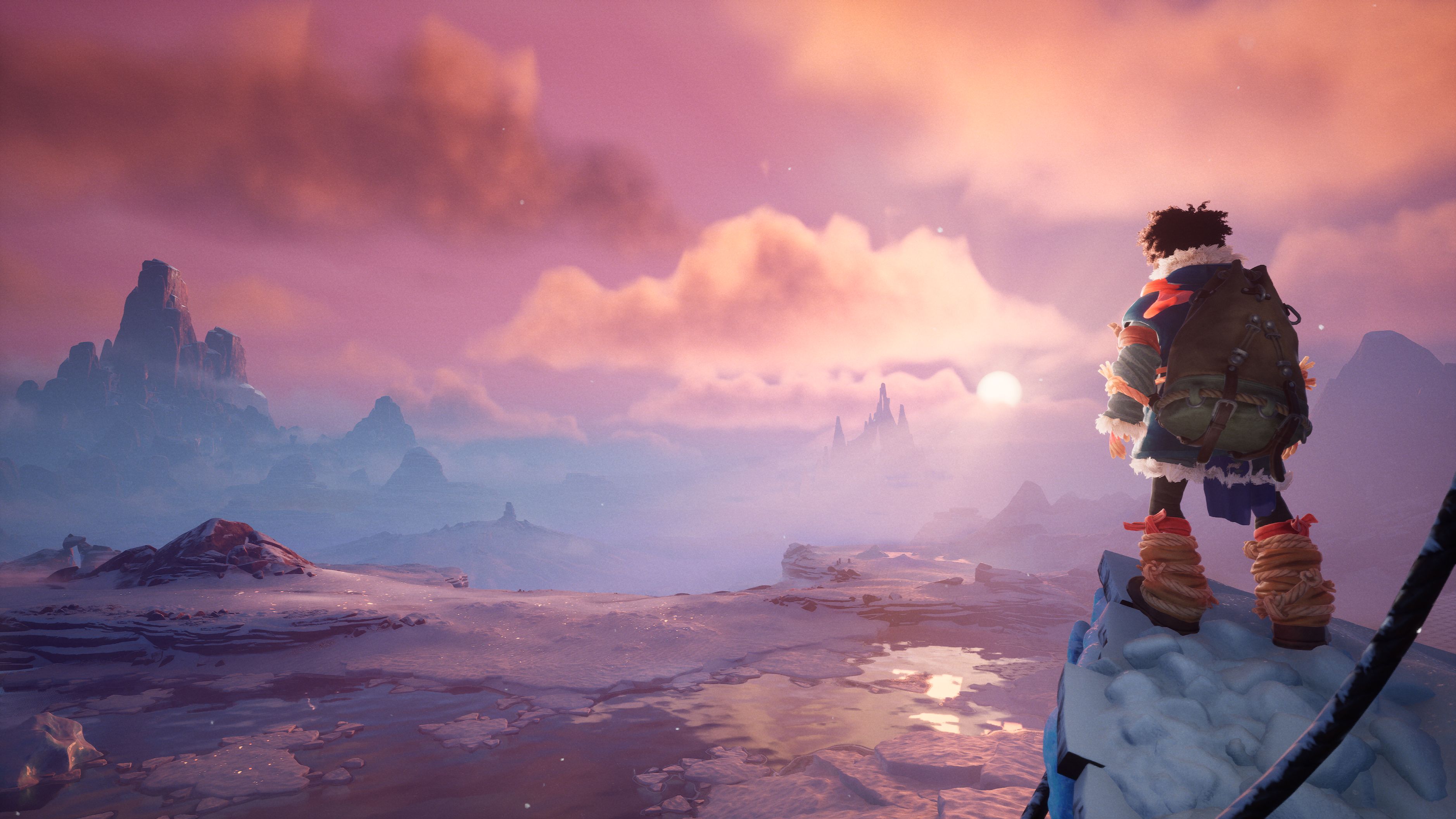
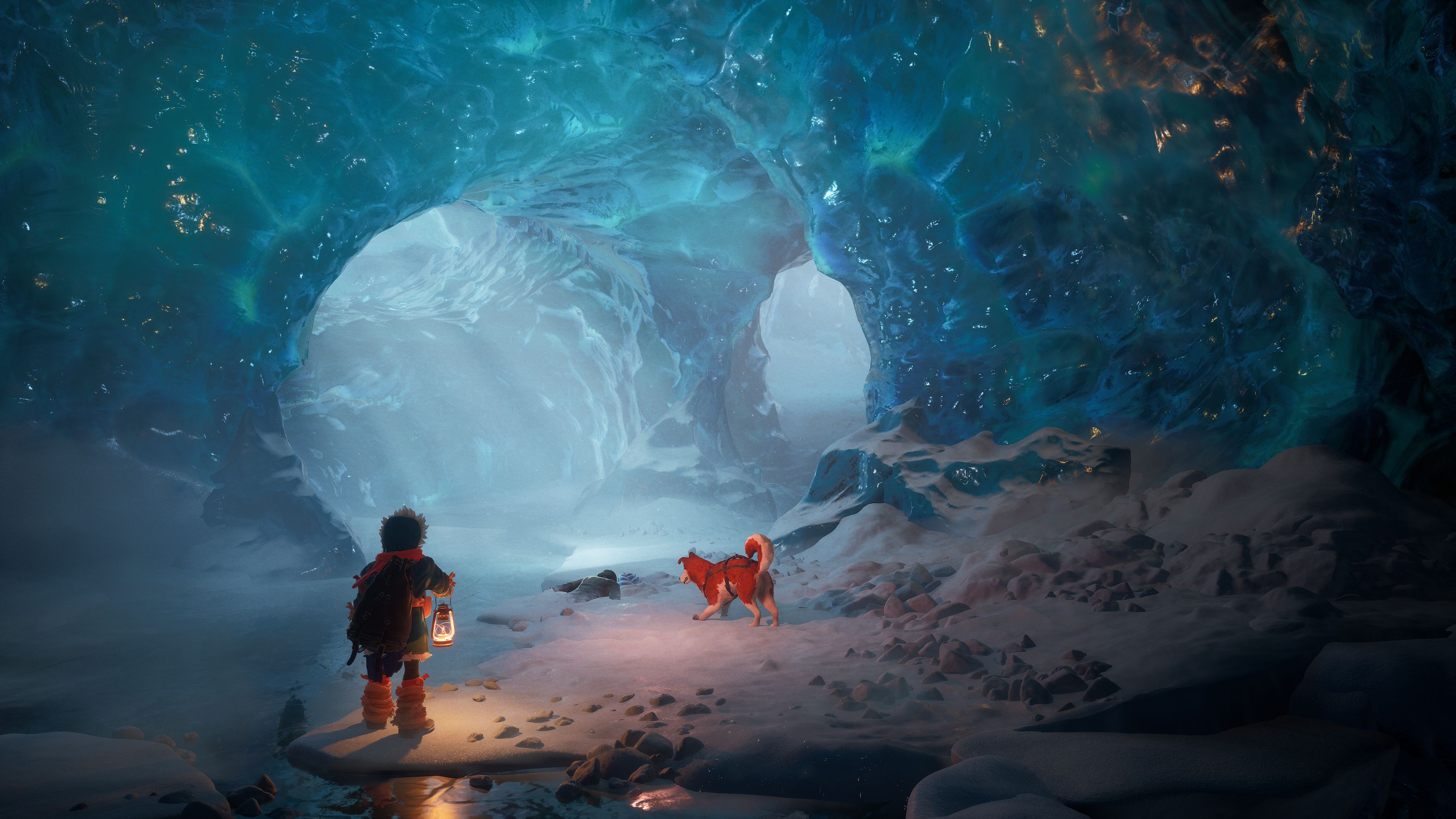

2025 games: This year's upcoming releases
Best PC games: Our all-time favorites
Free PC games: Freebie fest
Best FPS games: Finest gunplay
Best RPGs: Grand adventures
Best co-op games: Better together
Hollow Knight: Silksong wasn't the only long-awaited game to finally get a release date (or, at least, a release year) at today's Nintendo Direct showcase: After long years of waiting, Deltarune developer Toby Fox announced today that Deltarune Chapters 1-4 will be released on June 5 as a launch title for the Nintendo Switch 2—and that chapters 3 and 4 will come to PC on the same day.
It's been a while, yeah? The first chapter of Deltarune, the followup to Undertale, came to PC in 2018, and was free; chapter two showed up in 2021, and was also free. But, channeling the spirit of shareware, Fox said subsequent chapters would not be free, so if you wanted the full Deltarune experience you were going to have to kick in some cash. Hey, fair enough.
Since then, though, it's been quiet. 2022 was a bust, and both 2023 and 2024 brought promises that things were happening but no actually happenings. 2025 brought more of the same, including an explanation for the extended wait—game development is complicated, basically—until today's Nintendo Direct and subsequent confirmation from Fox that yes, it's coming to us too.
"Deltarune Chapters 1-4 will be released on June 5th as a launch title for Nintendo Switch 2!" Fox wrote on Bluesky. "It's also coming to Steam, Switch, PS4, and PS5 the same day!"
Fox also shared this cryptic declaration:

In a follow-up newsletter on Fangamer, Fox said Deltarune will cost $25, which will include all the game's chapters. A fifth is in the works—Fox originally intended to release chapters 3, 4, and 5 together but decided the wait would just be too damn long—but to my reading it sounds like there may be plans for more beyond that.
"This $24.99 to me represents the exact price of four chapters!" Fox wrote. "But, it's my hope that as we complete more chapters, you'll feel like this game was a super super super super good deal. Just wait, I'll prove it to you...!"
I guess we'll see how that shakes out later. For now, Deltarune, with the newly-added launch date for chapters 3 and 4, is up for wishlisting on Steam, and chapters 1 and 2 remain available for free.

2025 games: This year's upcoming releases
Best PC games: Our all-time favorites
Free PC games: Freebie fest
Best FPS games: Finest gunplay
Best RPGs: Grand adventures
Best co-op games: Better together
What is it? Western point-and-click adventure game, and a spiritual successor to Lamplight City
Release date: March 27, 2025
Expect to pay: $20 / ?17
Developer: Grundislav Games
Publisher: Application Systems Heidelberg
Reviewed on: Windows 11, NVIDIA GeForce RTX 2060, AMD Ryzen 9 4900HS, 16GB RAM
Steam Deck: Playable
Multiplayer? N/A
Link: Official site
Journalist Harley Leger is on her way to town to take a job at the Rosewater Post, a small but competitive newspaper looking to broaden its reach. Her first assignment is interviewing Gentleman Jake Ackerman, a Wild West showman who's come to town, but her involvement with him quickly spirals into a treasure hunt that takes her, Jake, and their ragtag crew of misfits all across the West.
The West, in Rosewater, is a bit different than you might remember: Society is reeling from the catastrophic consequences of recent developments in the field of "aethericity," continuing the steampunk-alternate history setting from Rosewater's predecessor Lamplight City. This isn’t a West ruled by lone men on horses and quickdraw gunplay, where it’s the toughest and the quickest that get out alive, but one steeped in a sense of intrigue and mystery that pulls the genre away from its bloody roots.
As a journalist, Harley’s an excellent protagonist for the role. Instead of a revolver her weapons are curiosity, stubbornness, and a nose for the truth; instead of a hunt for gold she’s hunting for a story.
Rosewater has a habit of taking western staples and giving them a bit of a twist. Instead of the somber journey of a silent loner Rosewater is a chattering road trip of Harley and, it seems, everyone else she can find: boastful Jake and his talented assistant Danny Luo, charming rebel leader Filomeno Marquez (Phil for short), soft-spoken aspiring doctor Nadine Redbird, and their caravan driver, hard-as-nails Lola Johnson. The majority of the game takes place in Lola’s wagon as they make their way to El Presidio, encountering settlers, travelers, bandits, merchants, refugees, con men, and laborers.
There’s not a single time that they drive by with cold focus on their goal. Instead, they stop to talk, to help, and to poke around. Every time. Absent a ruthless pursuit for justice or gold, Rosewater is relaxed to the point of feeling aimless.
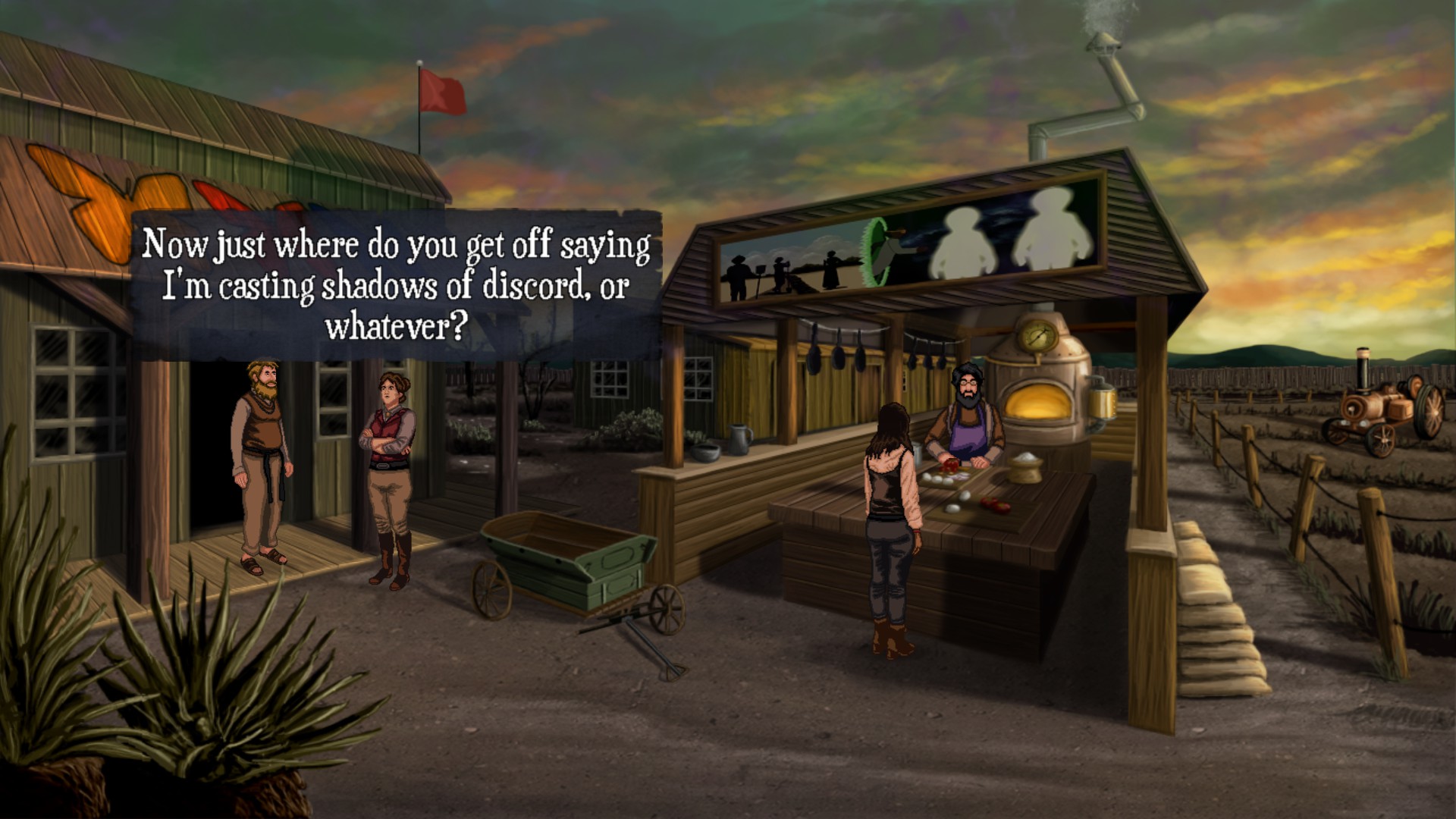
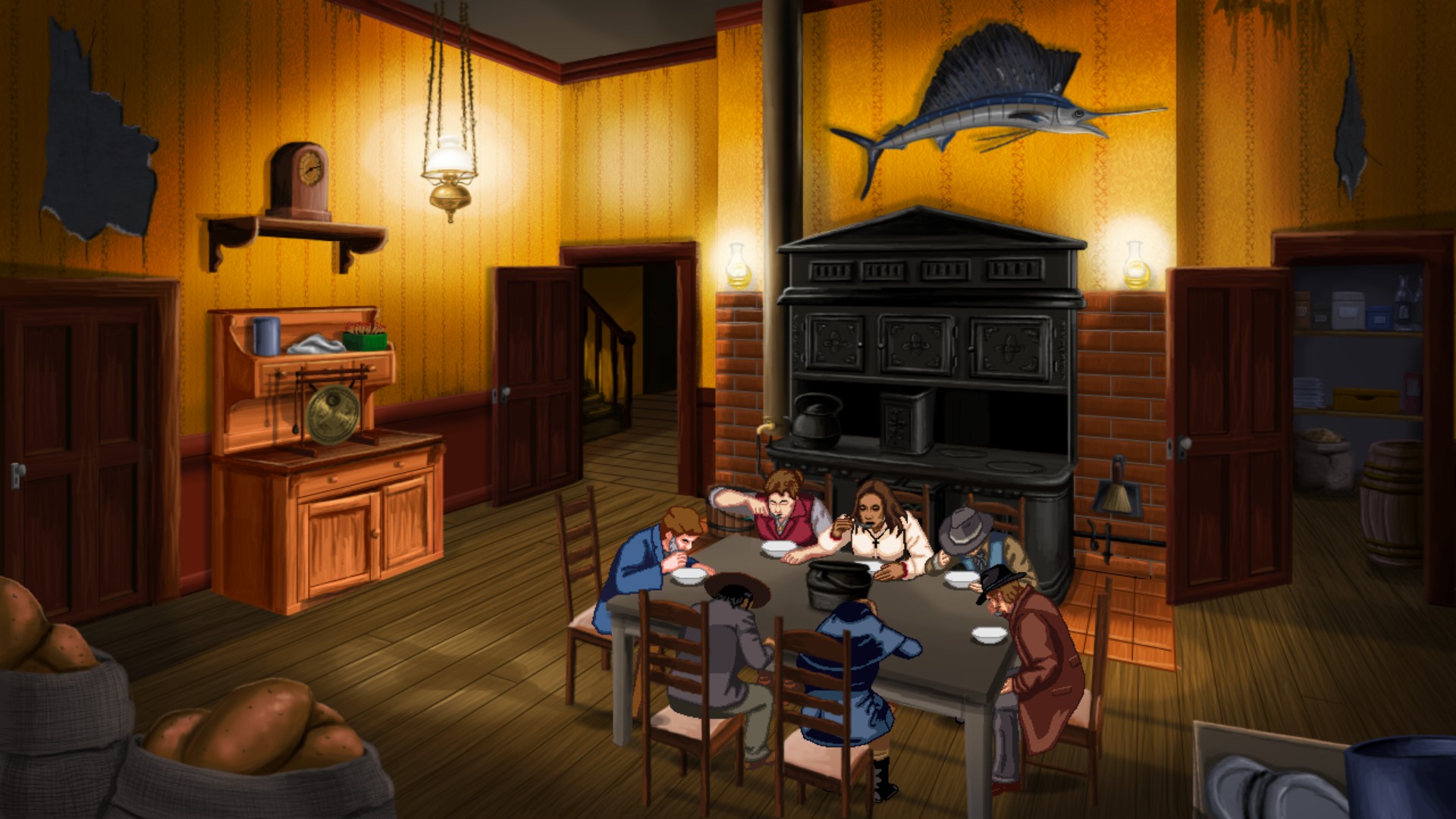
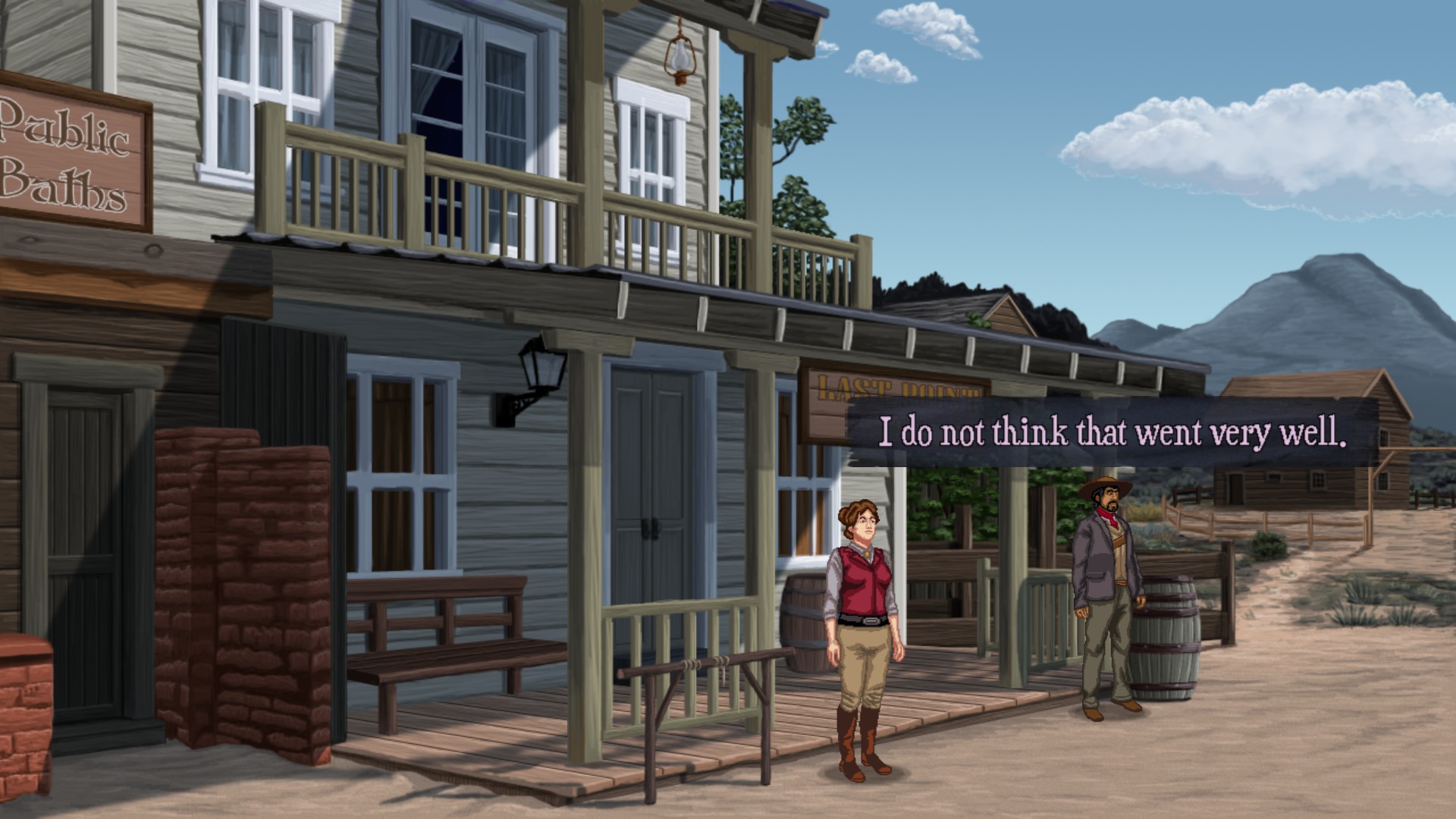
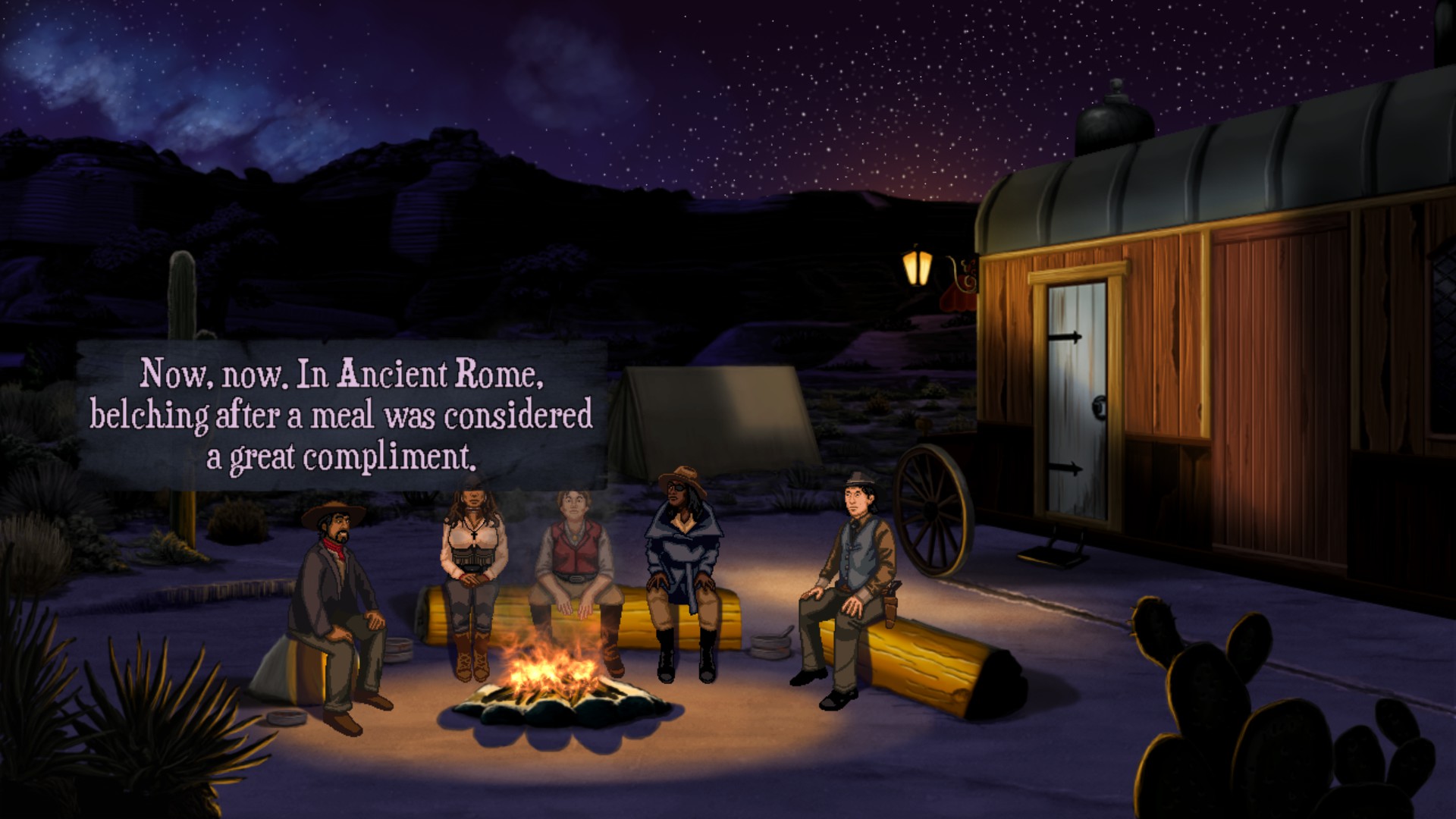
The road trip itself is an extended series of vignettes, varying widely in depth and complexity. Some smaller events are randomized, and can be encountered any time in the story or skipped entirely. Others are complicated setpiece scenes with more interesting puzzles and a focus on the companion characters, where Harley is not just doing her own searching but directing and assisting the others, learning about them at the same time as they all learn about the new people and places they’re encountering.
It's charming to watch Danny get scammed by a fake psychic or Lola pretend she's not enamored with a traveling family's neglected puppy, and occasionally these scenes will lead into fairly intense companion interactions, as in a scene where Phil runs into former friends who became refugees because of choices he’d made.
As the trip progresses, puzzles get more complicated—as in all good adventure games, one drove me to the point of utter frustration only to learn that the obvious answer had been under my nose the whole time—but in general they require just enough work to stay engaging without losing my attention. I had an especially good time with the side story of a retired sea captain whose home the gang retreats to during a storm: with multiple layered smaller puzzles in a limited area centered around the background of a single character, it makes the climactic scene of the subplot—an extremely goofy yet quite charming seance-ish scenario that involves everyone dressing up like people from the captain’s past—feel like a worthwhile reward for the time spent snooping around his house.
Less entertaining are the minigames, which mostly serve to waste time until Harley can determine she is actually not very good at the thing she is trying to do and hand it off to a more talented companion. Simpler ones like fishing are forgivable (move your mouse in the opposite direction the fish is pulling) but the less said for Harley’s attempts at sharpshooting, the better (click that thing that’s moving fast oh my god so fast!). Similarly, a map mechanic introduced late in the game feels distracting, and is made almost illegible by the simplicity of the art style. Luckily these detours don't come up too often.
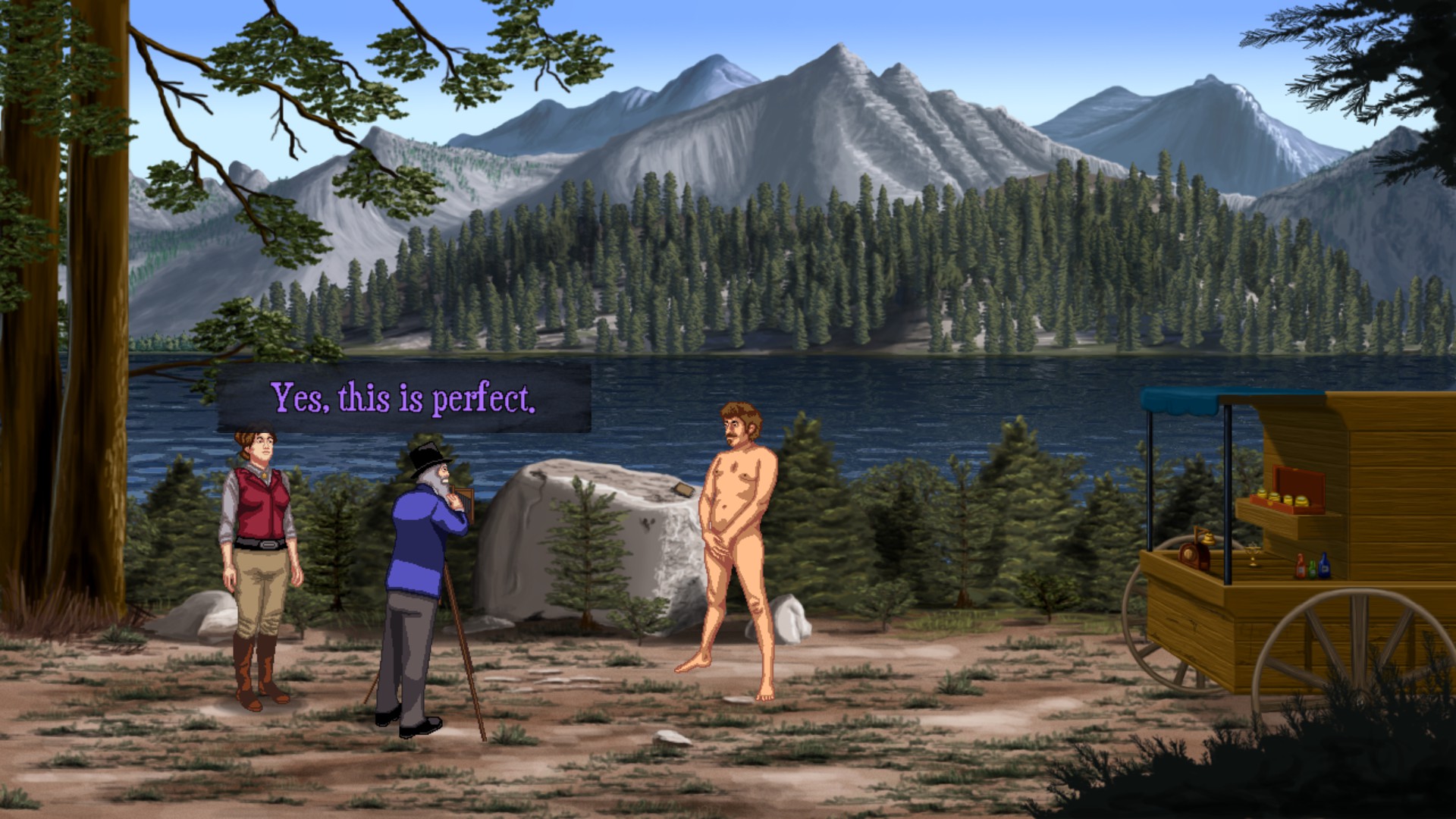
Rosewater is sun-baked and unhurried. The lack of urgency works fits Harley, whose dry humor and sense of general competence carries much of the game. Though the group find themselves in occasionally bizarre or extraordinary situations—in the lab of a mad scientist, swept up with a patrolling military party, ambushed by psuedo-Pinkertons, or trapped with overly friendly religious cultists—Harley always keeps her cool. The game especially shines in her short moments of narration and her rarely-referenced diary, which contains some of Rosewater's best writing and lends an incredible sense of atmosphere to its interpretation of the West.
Of course, the sunny lethargy can't last. There's a narrowing of focus as Rosewater approaches the climax, and a feeling of claustrophobia from the return to urbanity as the group nears El Presidio. My trepidation grew alongside the characters; there is a sense that the eyes of the world have returned to us. This is a stark contrast with the rest of the game, where I had the ever-present sense that the world has been left behind, that the grand events of history have already happened, and that the places and people around which Harley finds herself are not pointed towards any particular future but instead pointed away from this unseen past.
The myth of the West, in Rosewater, is less one of expansionism and settlement and more one of refuge. Rosewater does not ignore the problematic history of the Western genre—in fact, it spends a great deal of time with the consequences of the imperialist brutality against both Native tribes and the New Spanish—but it finds the bulk of its empathy in stories other than bloodshed.

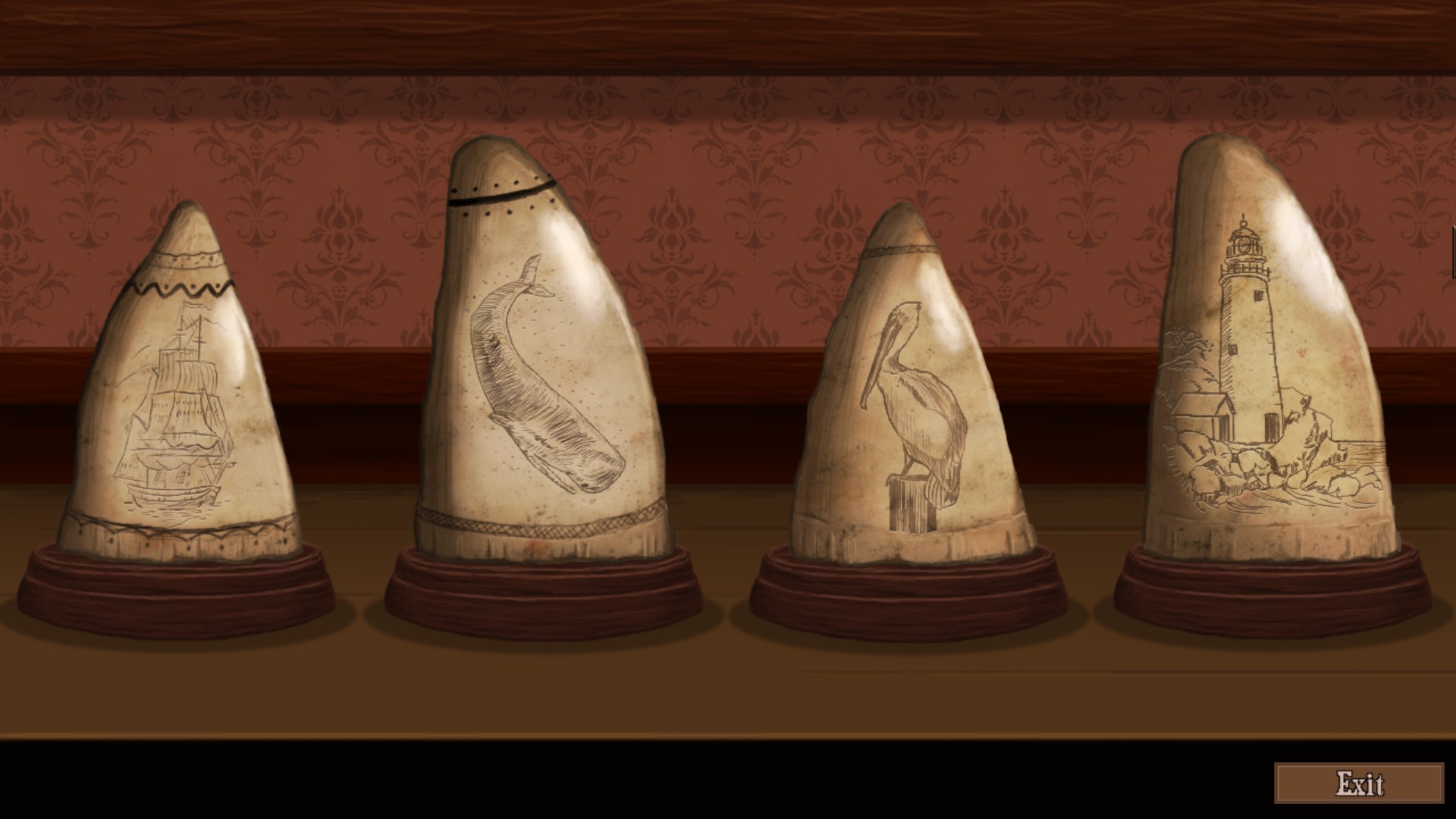
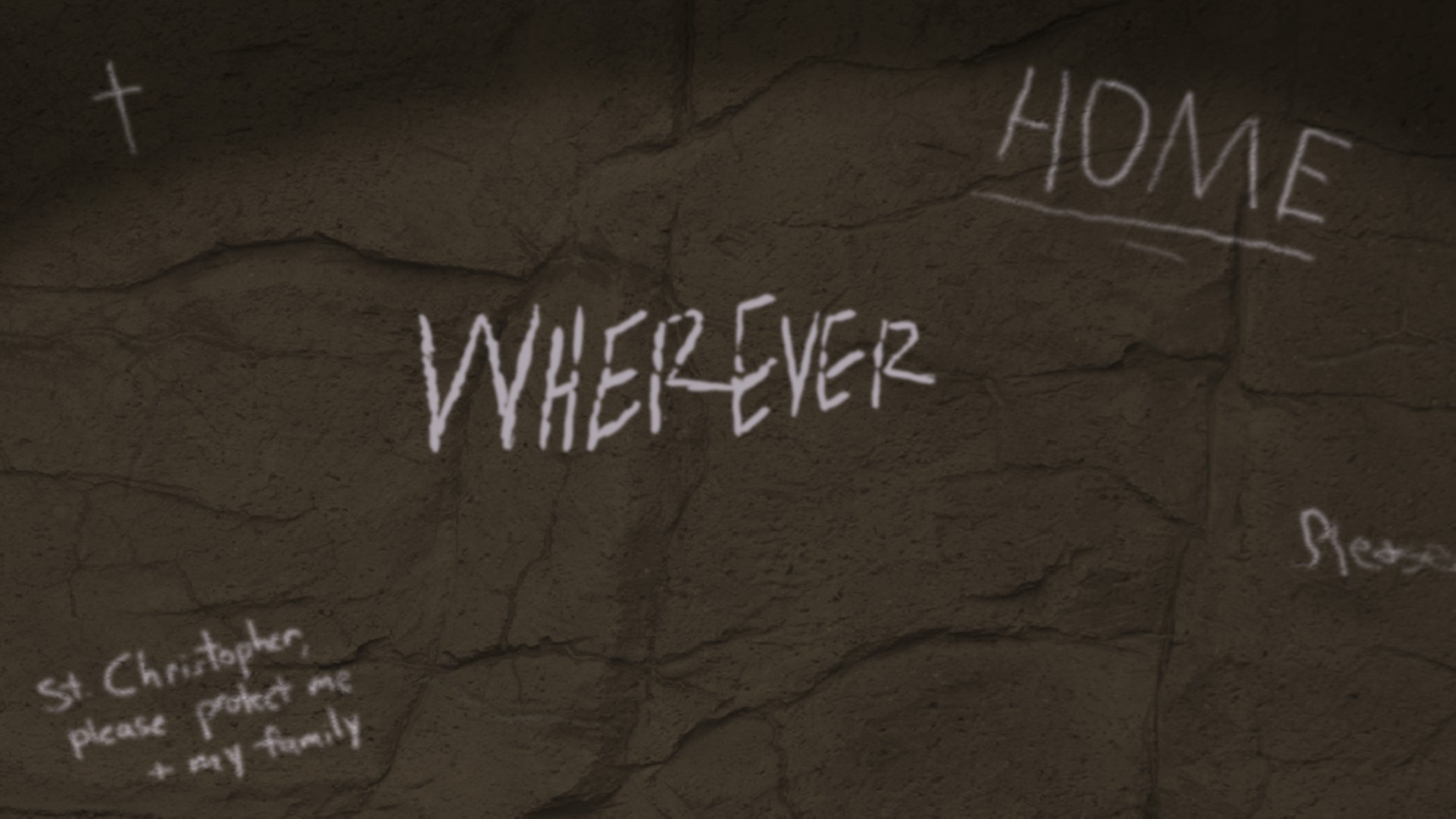
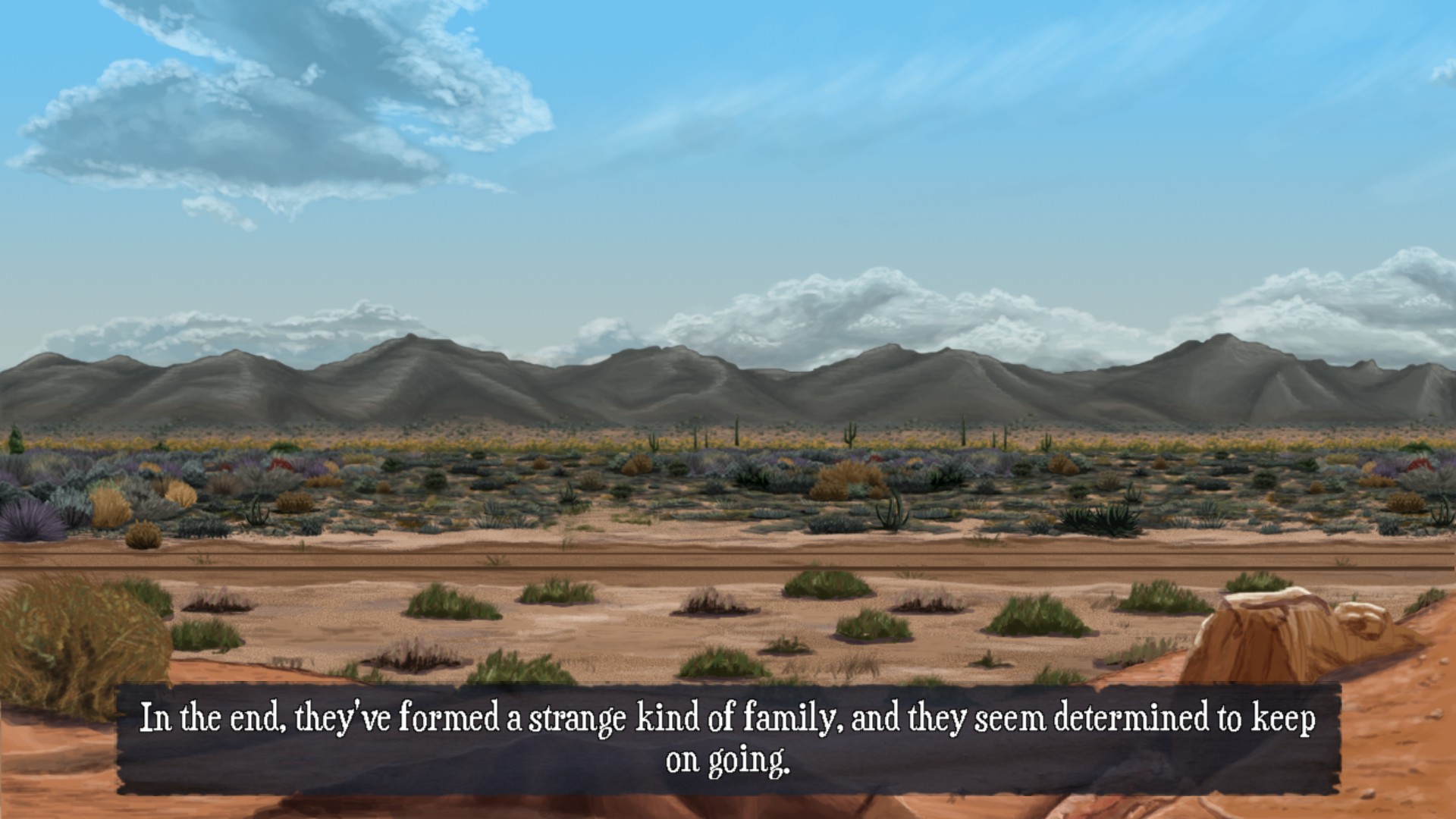
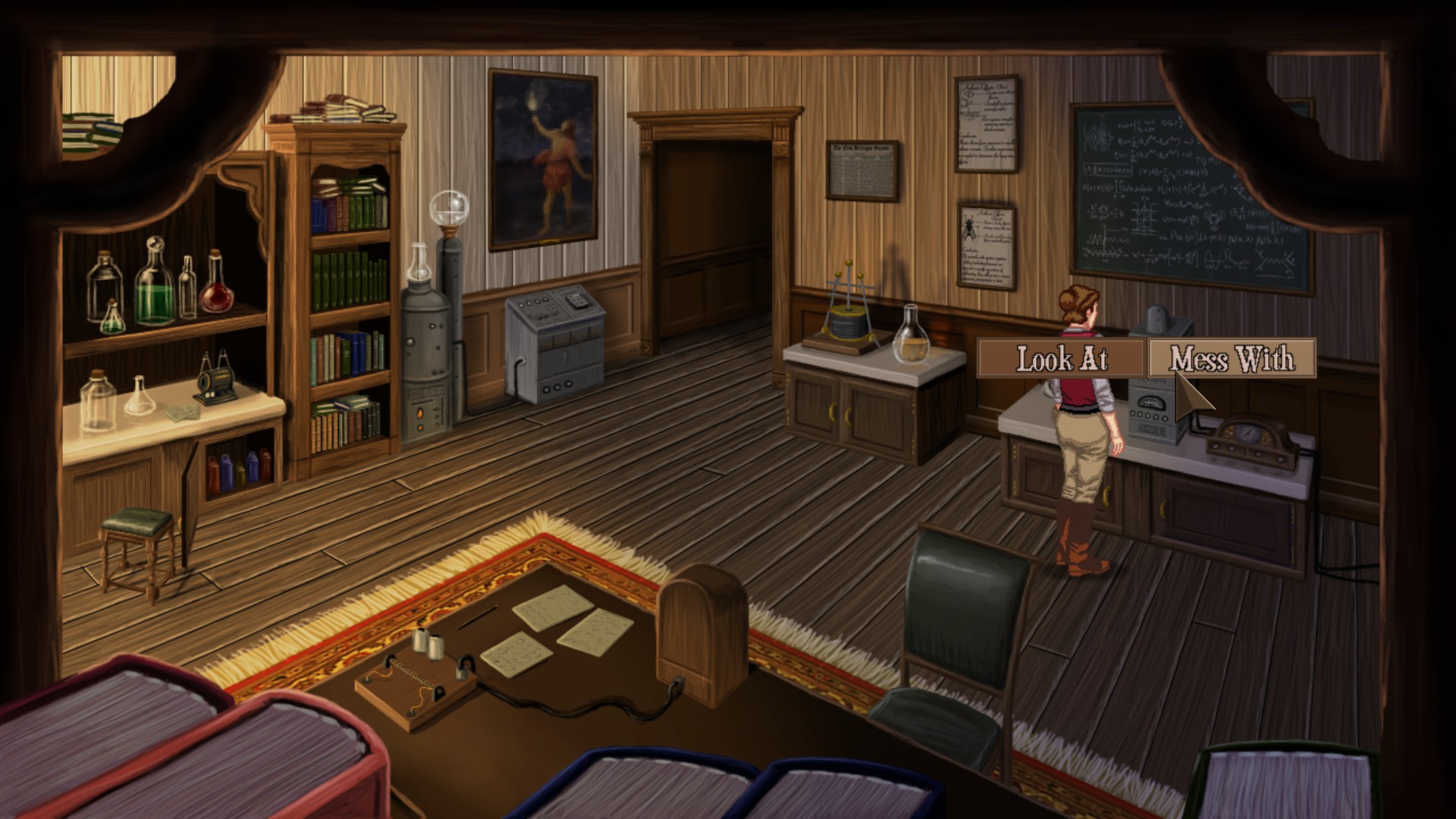
Everywhere Harley and her companions go they find people who are trying to figure out how to live. If Rosewater buys into one myth of the West more than anything, it's this: the West in Rosewater is a future, uncharted, undefined, for those who come to it and for those who are already there.
It’s why it feels right that Harley can make her journey equipped with a notebook and not a gun. The treasure they’ve set out to hunt is far removed from its origin: the fortune of a scientist hiding from a scandal following a catastrophe in a city far away, where some of these characters might have been once but no longer are now. Without a race to the gold or a hunt for a killer, there’s time for her to look for her future and for her story, and help her companions and the people she meets along the way look for the same.
It feels appropriate for a game like Rosewater and what it’s trying to be: a version of the West that we know, but not quite.
]]>Joe Morrissey, a seasoned writer and director who spoke at GDC this year, has a few solid ideas. In case you're unfamiliar, Morrissey has quite a few credits, including Diablo 2 and 3, InFamous 1 and 2, and Ghost of Tsushima.
His talk, "Making Collectibles Count", was an illuminating chat on what makes a pickup worth it. It's also a very funny, eight-point dunk on Breath of the Wild, which infamously made you grab 999 Korok Seeds for a bit of golden poo.
Morrissey breaks things down into three tiers—one that stamps out the fundamentals, one that elevates them, and a couple of cautionary tales.
The golden rule(s)
First up is "discoverability", which Morrissey says is "also the one that most developers, including myself, at times, have fallen short on. This trait is the player asking the question, 'how do I find this collectible?'"
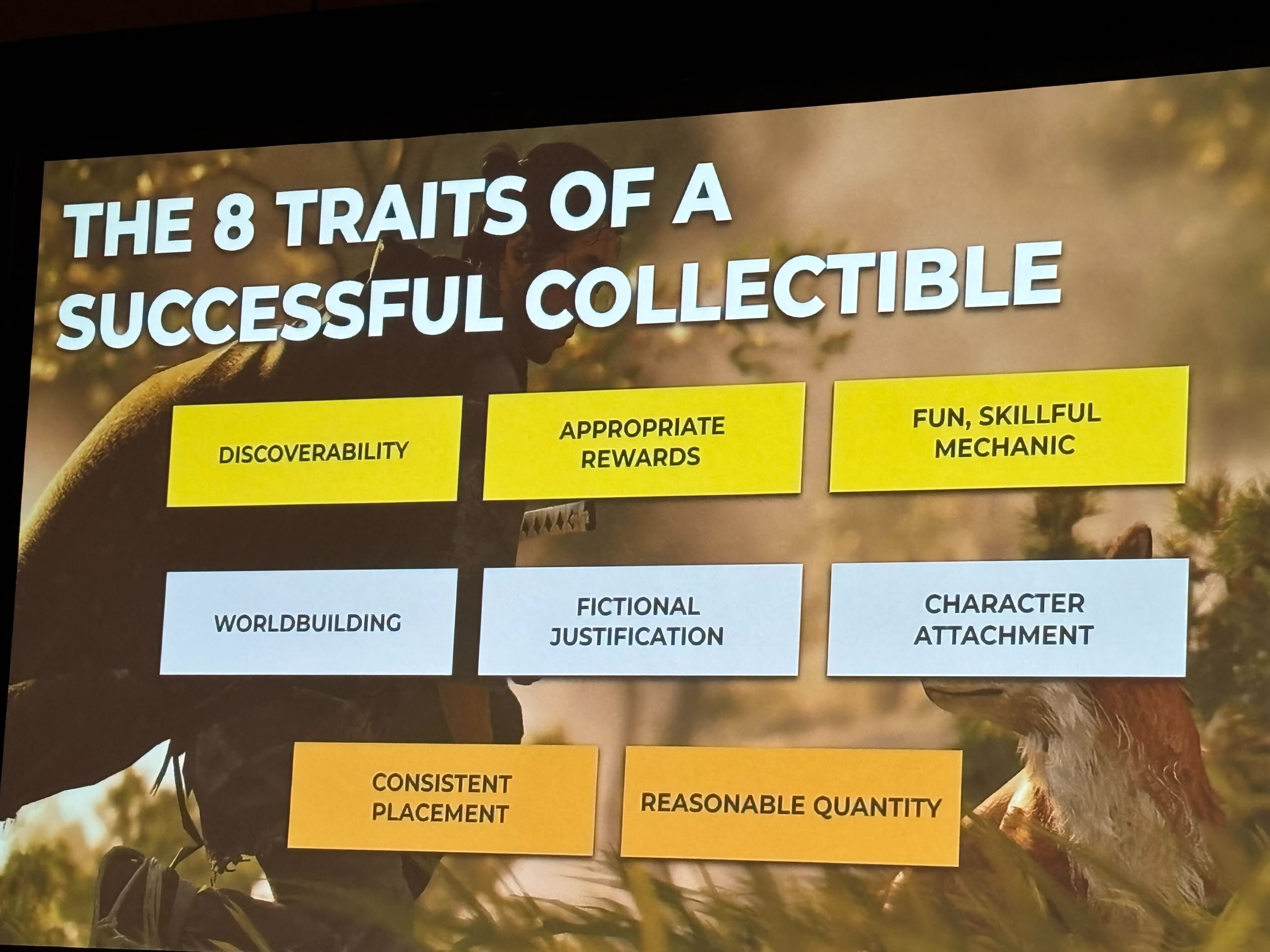
There's a sort of tipping point he outlines whereupon finding your first gubbin, a player might ask "I wanna [find] more of those, how do I do that?" However, "if the answer is 'well, you just gotta search for them' … that's not gonna be a good time. Nobody is gonna have fun with that. They'll just go online and find wherever the stuff is."
It's here where Korok Seeds catch a stray, and not for the first time in the talk: "I'm lookin' at you, Korok Seeds."
The way you work around this, he argues, is to add ways for players to seek out the collectibles—systems where you can scan the environment work, but you can also use visual cues. Ghost of Tsushima utilised black smoke, fireflies, steam, and a little bird that'd try and get your attention to steer you towards a locale.
The second 'gold-tier' rule is obvious on the face of it: You gotta reward players for what they find, and that reward has to encourage more exploration—he shouts out the jump orbs from Crackdown here, astutely observing:
"The more of these orbs you collect, the higher you can jump, and the further you jump, the more you're allowed to get to those previously impossible orbs. So your reward for getting these hard-to-get orbs was the ability to get harder-to-get orbs."
I've talked to a number of creative directors at different places I've been at where they're like, 'hey, we're not going to give you the rewards for the collectible'. No one really cares about this, it isn't a big deal."
Joe Morrissey, GDC 2025
This honestly tracks—this kind of reward system is something MMOs have used to keep players trucking along when it comes to gear upgrades, so the fact it's effective in collect-athons scans nicely, as well. It's a lesson some creative directors have ignored, Morrissey says.
"I've talked to a number of creative directors at different places I've been at where they're like, 'hey, we're not going to give you the rewards for the collectible'. No one really cares about this, it isn't a big deal.' And then, sure enough, we do very early play testing. And all the play testers are like, 'why would I waste my time doing this?'"
The last point of import is—as you might wager—making it fun to pick this stuff up. "You can create a fun mechanic that actually gives the players some sort of skill that they can improve on," he says. "It could be collecting the SKATE in Tony Hawk's Pro Skater." These things help to break up gameplay flow, making the whole process more active—think Riddler Trophies in the Arkham Games.
Fluff and stuff
The next tier helps elevate your garden variety collectible with flavor, via worldbuilding, fictional justification, and character attachment.
Worldbuilding's pretty self-explanatory—the things you collect are an opportunity to "reveal more about the world of the character." Basically, doohickeys with backstories—he uses the example of the backpacks in the Spider-Man games, which all come with a 3D model and a snippet of backstory to help you get "a sense of the man behind the mask".
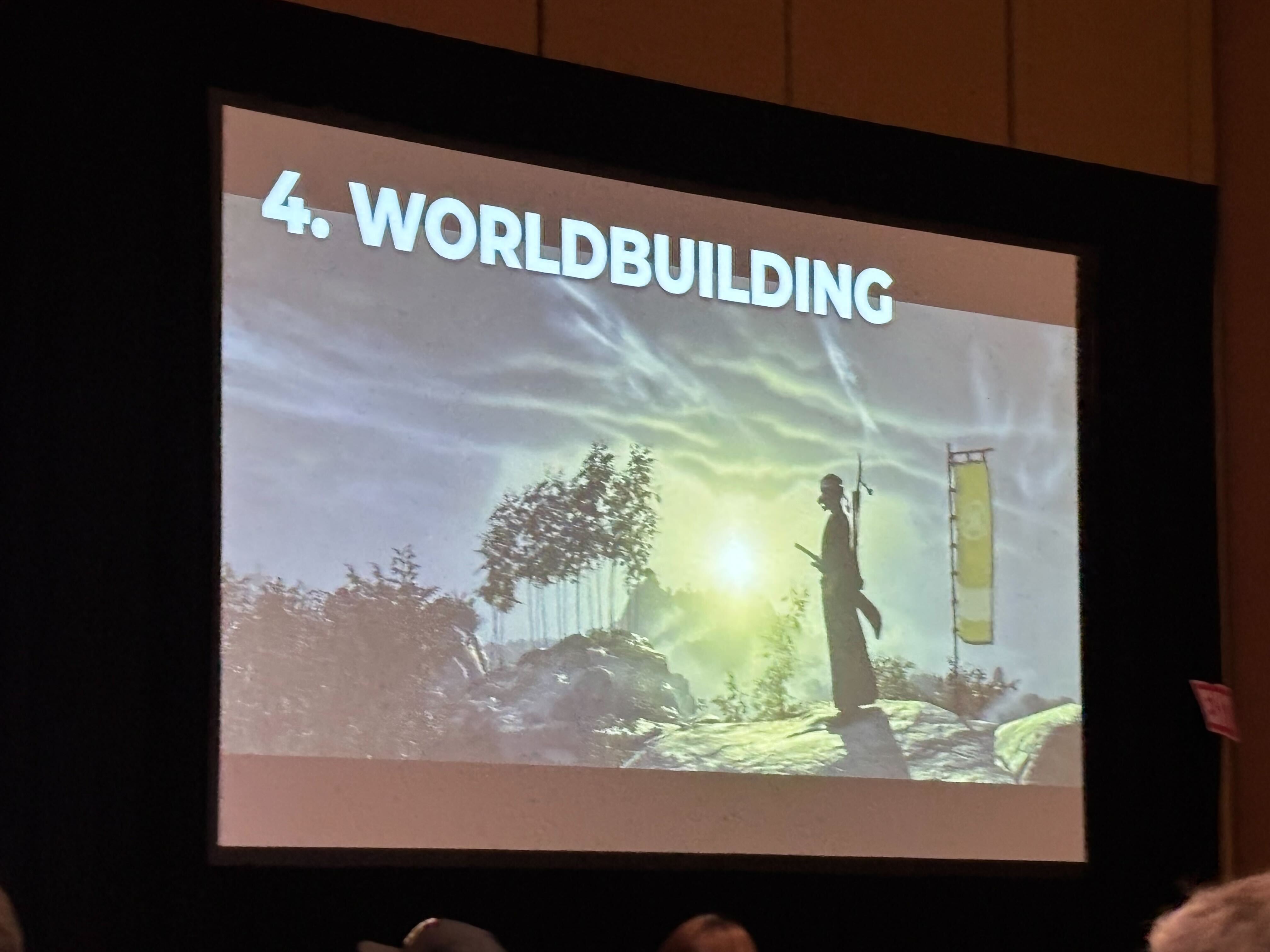
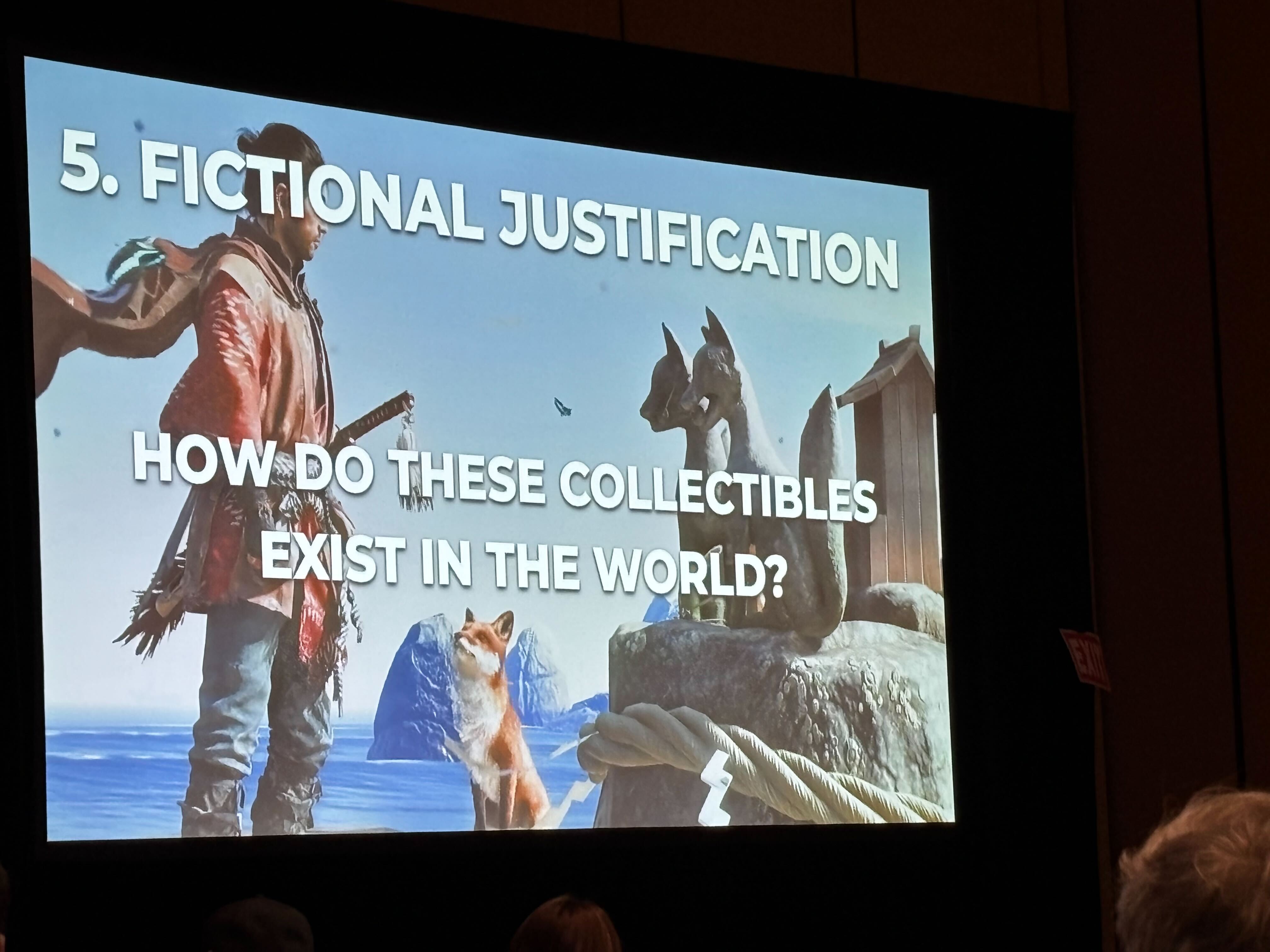
Fictional justification just means making it make sense: "This trait asks us as designers to justify what all of these glowy, hard-to-get-to, often very noisy things actually are in the world." Despite his enduring love of Crackdown's orbs, he notes that they fail on this point—nobody's suspension of disbelief is maintained by the Jump Spheres. "Just take a beat and think about it, because it's not that hard."
Character attachment runs a little deeper, and has more to do with overarching narrative. He uses an example from Assassin's Creed: Odyssey—its Standing Stones being linked in the story to the protagonist's dead family. "Now it's on them to kind of go to these places that their son couldn't." Essentially, it's stuff that makes you think: "This is exactly what my character would do."
The final two points are more about courtesy, and have the lowest weighting in his eventual tier list. Morrissey thinks that collectibles should be in a "relatively consistent location," because "players will pick up on that, and it'll make sense to them." Meanwhile, they ought to be in a "reasonable quantity". Or, rather, "How many times are you going to make players do this"? Too many, at times. Too many.
He then uses these tiered elements to grade a bunch of different items in games, captured here by PCG's own Tim Clark. Unsurprisingly, Korok Seeds are C-tier.
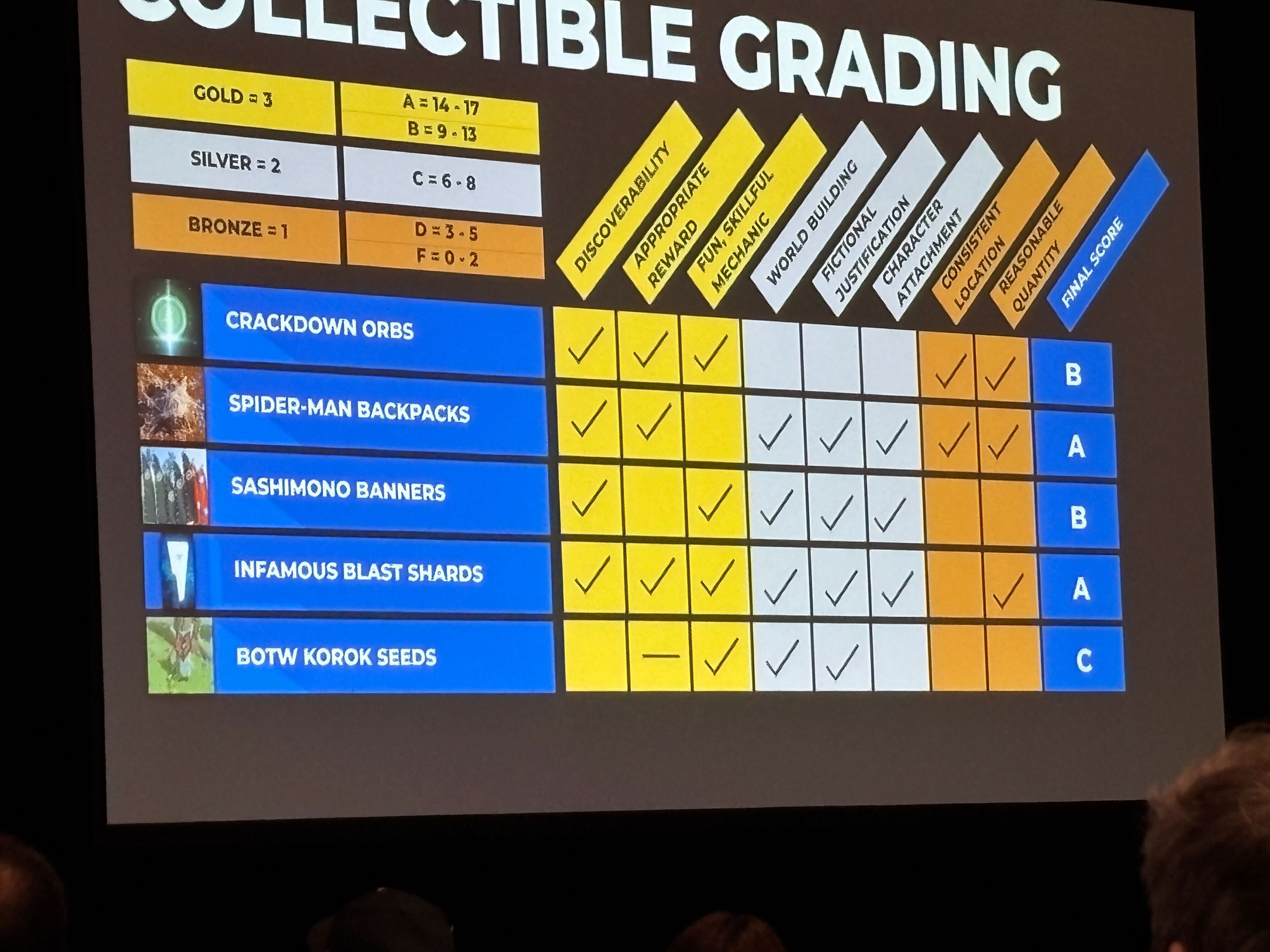
Honestly, while it's funny to see Nintendo's 999-item long collectathon duly roasted, I'm more impressed with the depth of thought that goes into making something we take for granted. I'm sure we can all list collection quests we were annoyed by, but it's harder to outline ones we enjoyed and why—as Morrissey has done here.

2025 games: This year's upcoming releases
Best PC games: Our all-time favorites
Free PC games: Freebie fest
Best FPS games: Finest gunplay
Best RPGs: Grand adventures
Best co-op games: Better together
Amanita Design, the Czech studio best known for Machinarium and the Samorost trilogy, is currently offering up to 85% off all its games, with money from all sales going to humanitarian aid in Ukraine.
"From March 26 to April 2, we're donating 100% of the proceeds from all our games and DLC to People in Need to support humanitarian relief in Ukraine," writes Amanita in a Steam announcement. "Your contribution will help provide food, warmth, home repairs, and essential care to families and individuals suffering under the ongoing Russian aggression."
The deal includes heavy discounts on both Machinarium and the Samorost series. The original Samorost, which launched as a browser game in 2003, is actually free to download, while Samorost 2 is currently available for $1.50/?1.28, Samorost 3, the biggest and arguably best game in the trilogy, is reduced 85% to ?2.54/$3. As for Machinarium, which remains Amanita's most famous and celebrated game, that's available for ?5/$6.
In my opinion, though, the highlights here are the games Amanita developed in the latter half of its existence, all of which are wilder and weirder than either Samorost or Machinarium. 2012's Botanicula is a marvellous comedy adventure about microscopic organisms, and remains one of the funniest games I've ever played. 2020's Creaks, meanwhile, is a spooky, atmospheric adventure with incredible art that saw the developer diverge from its point 'n' click roots to a slightly mechanically broader puzzle-platformer. That's down to ?5/$6.
Amanita's current project is Phonopolis, an adventure game with assets all hand-made from cardboard, where you play a dustman called Felix who suddenly finds himself at the forefront of a revolution against a dystopian regime. "Loosely inspired by the works of Karel ?apek and George Orwell, the story of Phonopolis explores themes of social manipulation and individualism, but keeps the overall experience playful and light-hearted," its Steam page explains.
Each of Amanita's games is on sale individually, but you can also buy the full Amanita bundle, which includes all the game's soundtracks, for just over ?25/$33. Not bad for eight of the weirdest, most imaginative adventure games you'll ever play. The deal runs until April 2.

Best laptop games: Low-spec life
Best Steam Deck games: Handheld must-haves
Best browser games: No install needed
Best indie games: Independent excellence
Best co-op games: Better together
Finally fed up with the detective lark, Holmes retires to the village of Fulworth to start a new life as a beekeeper. He's eventually joined by Dr Watson, who Holmes wants to help "rest and recuperate" from his service as a medic in the first world war. As part of this, Holmes decides to arrange a picnic for his pal.
Unfortunately for the (former) world's greatest detective, reality simply can't stop throwing mysteries in his path. A woman from the village fete has been kidnapped, a kid's cat has gone missing, a relic from the British museum has been stolen, and a 'mermaid' has apparently washed up on Fulworth beach. Indeed, as shown in the trailer, Holmes can't even go for a walk without tripping over a corpse. "I feel the need to remind you I am retired", he jests.
he game offers a blend of classic and more modern adventure game mechanics. The village of Fulworth is openly explorable, with numerous characters to speak to like a "prickly police officer" and a "clown with a tragic past." According to developer Afoot games, solving the various mysteries will involve both logical deduction and more narrative-based decision making. "Puzzles have multiple solutions, some of which may please your neighbours more than others."
Interestingly, the Beekeeper's Picnic's Steam page features a badge that proudly proclaims "no gen AI was used in this indie game." Steam requires developers who use generative AI tools to disclose the fact as part of its terms of service. But this is the first time I've seen a developer declare no generative AI was used in the game.
Despite my initial statement, I rather like this more playful take on Sherlock Holmes, especially given Frogwares' games that star Conan Doyle's detective tend to be more serious. Frogwares' most recent effort was 2023's Sherlock Holmes: The Awakened, which folded Lovecraftian elements into the mysteries and was generally well-liked by players. It's likely to be a while before we see another Holmes game by the Ukrainian studio, as it's currently working on The Sinking City 2.

Best cozy games: Relaxed gaming
Best anime games: Animation-inspired
Best JRPGs: Classics and beyond
Best cyberpunk games: Techno futures
Best gacha games: Freemium fanatics
It looks like the moderately unhinged dream-detective Kaname Date (absent for most of the second game) is back on his usual beat. That is, saving the frequently-kidnapped Vtuber Iris Sagan (aka A-Set) from danger once again. She really needs to take out some insurance against this kinda stuff.
The debut trailer below (ignore the Nintendo branding, the PC version is confirmed) shows her in some kind of pseudo-ancient UFO with a dwindling oxygen supply. Given that she's a conspiracy-brained weirdo herself, it's likely that this isn't the work of aliens, and might just be a dream, but those are pretty important in this series.
For those new to the series, they're story-heavy point-and-click mystery adventures set in near-future Japan. Kaname Date is the lead detective at an oddball new agency that solves crimes by diving into the dreams of victims, witnesses and suspects alike with the aid of his sassy AI companion, Aiba. She's built into his cybernetic prosthetic eye—an Ai-Ball, even. These games are kinda goofy.
While dreams tend to be weird tangles of un-logic, if you can pull at the right threads of memory or solve the right puzzles, you can uncover all kinds of buried or even suppressed thoughts to use as clues in the mystery at large. While the previous games kept most of their puzzles relegated to dream-diving, Spike Chunsoft promise/threaten some 'real-world' escape rooms to fry your noodle this time that should follow slightly more coherent reasoning. Hopefully.
Interestingly, series writer and director (on the first game, at least) Kotaro Uchikoshi is relegated to the role of 'assistant scenario director' this time, according to the game's official announcement page. This time, the lesser known Kazuya Yamada is stepping up as primary writer and development lead from his earlier role as sub-director on the previous game. So, talent from within the team, but I'm a little concerned that it just won't be the same without Uchikoshi's particular can of brain-worms being in play.
Also as a returning fan of the series, I'm curious whether they'll be expanding on the B-plot of the previous game, The Nirvana Initiative. Not to spoil too much, it was a fun optional mystery to pick at, even if it threatened to punch some large, messy holes in the fourth wall. Just an easter egg, or a hook to hang the next adventure from? I'm looking forward to finding out on July 25th. In the meantime, I highly recommend the first two games. They're deeply weird, unapologetically packed with anime tropes, and great rides.

Cyberpunk 2077 romances: Who you can choose
Cyberpunk 2077 Meredith romance: Business or pleasure
Cyberpunk 2077 Panam romance: Ride or die
Cyberpunk 2077 joytoy locations: No strings flings
Cyberpunk 2077 best settings: As of 2.0
The expansion hadn't been formally announced, but the Definitive Edition in question is presumably the director's cut version that was first reported in 2024. The Bloomberg report says the expansion was cancelled because the cost of making it wasn't justified by the amount of content expected to result.
Warner embarked upon a restructuring of its game division earlier this year, following the high-profile failures of Suicide Squad: Kill the Justice League and Multiversus, which resulted in a staggering $300 million loss between them. The fallout was ugly: In February, Warner closed Monolith, Player First Games, and WB San Diego, and cancelled its struggling Wonder Woman game. A month prior to those closures, Warner Bros Games chief David Haddad announced that he was stepping down from the position.
Even in the wake of all that, though, the cancellation of a Hogwarts Legacy expansion and re-release is surprising. Hogwarts Legacy was a massive success for Warner in 2023, and the company was still talking about it last month after closing all those studios, saying Harry Potter was one of four "tentpole franchises"—along with Game of Thrones, Mortal Kombat, and DC—that would be the priority of its game business going forward.
A sequel to Hogwarts Legacy, which Warner said in September 2024 was one of its "biggest priorities," is still in development, according to the report, but it's hard to imagine that an expansion wouldn't do gangbusters business too, and arrive much sooner than an entirely new game.
I've reached out to Warner for comment and will update if I receive a reply.

2025 games: This year's upcoming releases
Best PC games: Our all-time favorites
Free PC games: Freebie fest
Best FPS games: Finest gunplay
Best RPGs: Grand adventures
Best co-op games: Better together
Rosewater is an old western road-trip adventure about a mismatched posse (led by a freelance writer, of all things) travelling across alt-universe America. West Vespuccia, they call it here. A troubled land, with revolutionaries and weirdos abound.
Plus apparently some mad science, as the gang set out to investigate the story of aetheric technology gone awry, and some folks that appear to have been disintegrated. So, not your usual western yarn, obviously. But well befitting a classic point-and-clicker.
While Rosewater's aesthetics are thoroughly old-school, replete with that characteristic stiffness that most '90s point-and-click protagonists seemed to be afflicted by (despite some rotoscoped animations), developers Grundislav Games promise a more flexible adventure than its forebears.
Reminding me a little bit of the excellent Unavowed, your gang of buddies and relationships between them provide multiple solutions to problems, potentially opening up new plot branches and multiple play-styles. There are also some random encounters which should give the game a little more replay value than point-and-clickers are primarily known for.
Old-school adventure fans have been looking forward to Rosewater for some time now, with post-apocalyptic romp Shardlight (developed along with Wadjet Eye) and dickensian detective adventure Lamplight City putting the studio on the radar, and Rosewater's demo (which is still available) proving that the indie studio still has the spark.
In the meantime, we've had plenty of other contenders, including recent '80s style gem The Crimson Diamond and excellent Lucasarts-inspired comedy whodunnit Loco Motive, proving that the old-school adventure is alive and kicking. Rosewater is in good company.
Rosewater is out now on Steam and GOG for $20/?16.75, skipping on the customary launch discount in favour of pricing from a simpler age, although Steam does offer some loyalty discounts if you've got other recent adventure releases, including Lamplight City, The Longing and Prim.
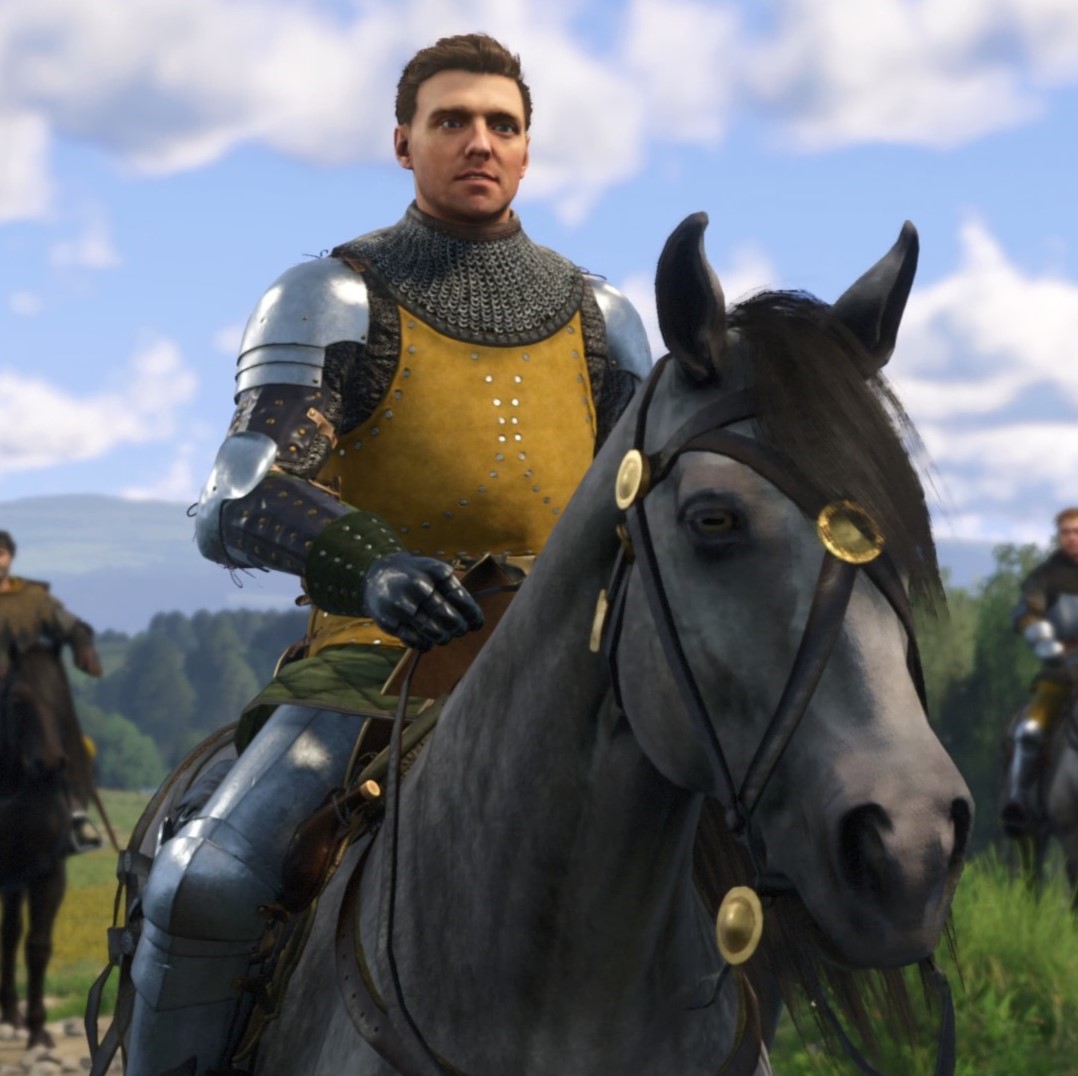
KCD2 console commands: How to use cheats
KCD2 treasure maps: Every loot location
KCD2 mods: Best Bohemian tweaks
KCD2 romance options: Bohemian romantasy
KCD2 Riddler Barley: All the right answers
The Ena animations thus far felt like a peek into the dreams of someone raised on a diet of early CD-ROM era ‘multimedia experiences’ and subtitled foreign animation. A kaleidoscopic blend of aesthetics and animation styles, from slick CGI renders to overly compressed FMV overlays, to heavily aliased low-fi 3D corridors and everything in-between.
From the hour I’ve played so far, Dream BBQ doubles down on that, but its world feels so much larger and more tangible. Its characters (existing across multiple mediums and speaking a dozen different languages) are given more opportunity to linger, ramble and get their hooks into your brain. The terribly reductive would just call this a ‘walking simulator’. An exploration heavy, mechanics-light ramble through strange environments, and while not inaccurate, that also feels like it sells the experience short.
This is a genuinely fractured, dreamlike experience that defies any attempt to make sense of it. The game opens under a blood red sky in shadowed, irregular asian streets. A giant silhouette of a person swims lazily through the air above. An inviting blue bed stands in the street. Interacting with it asks you if you wish to open the door. Of course you do. And now you’re Ena, at work. She’s looking for The Boss, with the aid of a Japanese man-frog and a masked Dracula.
For those who’ve watched the animations, this particular incarnation of Ena is more focused, aggressive and businesslike. Overbearing, almost. She’s a woman on a mission, full of useful business buzzwords. In this chapter, she’s looking for a Genie, except that every attempt to say that word becomes overwritten with ‘Bathroom’. The answer to this bathroom mystery might lie in a strange desert realm where veiny hipposnake octahedrons float through the sky. Go on then, you’ve got work to do.
The game might be free, but that’s not to say it’s underfunded work. Guerra runs an active Patreon page, Fangamer have an extensive merch page, and Dream BBQ has an optional bit of ‘supporter edition’ DLC that adds funny little collectible dogs to the game which unlock behind-the-scenes development commentary and production notes.
The rabbit hole is as deep as you want it to be, but as curious as I am about the production process, I do enjoy this stuff having an air of mystery to it. Like it’s a mysterious artifact from another plane of existence. Something to be experienced, but never fully understood.
As for whether we’ll see the other chapters anytime soon, or even at all, I wouldn’t even hazard a guess. Part of the fun of Ena’s world is not knowing what lies around the next corner. But I can’t deny that even before I’ve had a chance to fully explore this strange pocket dimension, I’m already hungry for more. But who isn’t at a good barbeque? Go grab yourself a bite.

Best cozy games: Relaxed gaming
Best anime games: Animation-inspired
Best JRPGs: Classics and beyond
Best cyberpunk games: Techno futures
Best gacha games: Freemium fanatics
It wasn't the devs cursing, mind you, it was the characters, and it was 100% unintentional.
If you've not played Pentiment, the game has no voice acting. Instead, everyone communicates via text which is rendered in lusciously detailed fonts: priests might talk in a pretty gothic script, peasants in a scribble, and the town printer in stamped block capitals. They even make errors using what Sawyer called a "procedural effect", sometimes writing in the wrong letter that then has to be scratched out and filled in correctly.
"Letter replacements became the thing that we did," said Sawyer on stage at GDC. "We did this fairly early, and even though we didn't need to do it fairly early, I'm glad we did, because naughtiness abounded."
Naughtiness means the village monks might inadvertently start swearing like sailors, if you're uncertain. It's not hard to see how that could happen. For instance, if Obsidian's error-generation system decided to insert a slip-up into words like 'shut,' or 'can't', or 'feckless'. Ahem.
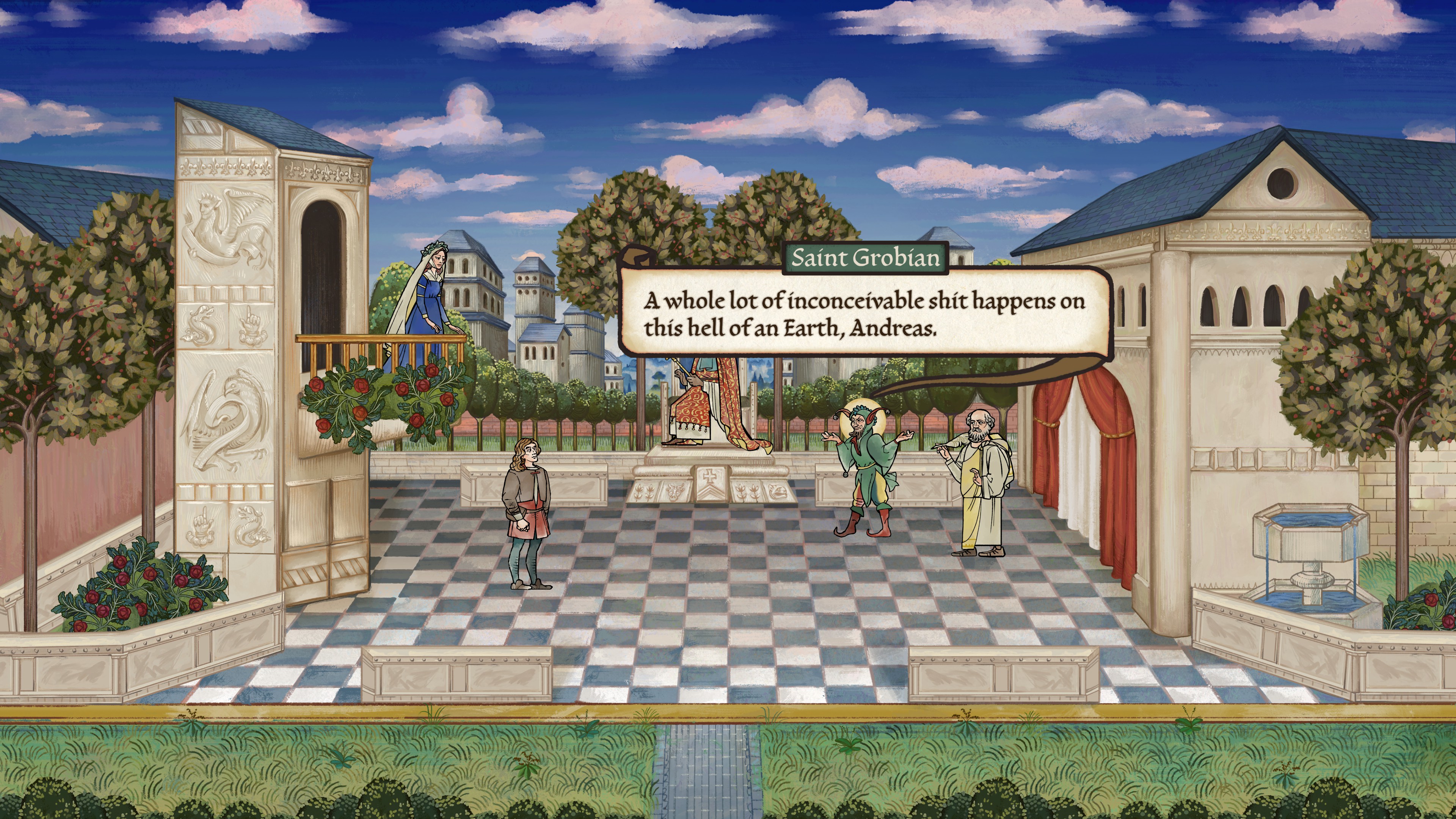
"When you start just replacing letters in words, sometimes you get words that you don't really want to be seen by a player," said Sawyer. "So the longer we played, the more we saw those." This led to Obsidian compiling a no-no list for its error-maker: "We [had] this growing list of like, 'don't do that'," said Sawyer, though overall the system "worked pretty well."
Alas, Sawyer kept schtum about just what was on that list, but like I said, I reckon we can hazard at least a few guesses. If nothing else, Sawyer gets to use it as a parable for other devs on the sometimes unforeseen benefits of doing things early: "It probably should have come later… But the benefit of doing it too early is that we caught a lot more of the naughty words. So it had a side effect that was positive."

Best laptop games: Low-spec life
Best Steam Deck games: Handheld must-haves
Best browser games: No install needed
Best indie games: Independent excellence
Best co-op games: Better together
Anyway, a similar flash of recognition recently happened to adventure game streamer Mike Piontek, who discovered an interesting fact about the Sierra classic King's Quest IV: The Perils of Rosella that was staring him in the face twice at the same time. And it's all to do with a picture of the game's designer Roberta Williams. Two pictures, in fact.
Williams is stamped all over King's Quest IV. I'm not referring to her design philosophy here, although that's very much true too given she wrote and designed it. I mean she literally appears in and around the game in multiple instances. Not only is there a picture of her on the rear of the game's box art, she also crops up in the game itself.
When you either finish the game or die trying (since it's King's Quest, the latter is far more likely) a text box appears in which Williams thanks you for playing, then lightly chastises you for failing (if you did) with the phrase 'Next time… be more careful!'. To the side of this text box is an image of Williams rendered in glorious 8-bit colours.
What Piontek noticed is that they are the same image, or at least, the in-game image is a digitised version of the box portrait. "I never noticed it before, but this author photo, from the back of the King’s Quest IV box, is absolutely the reference image for the portrait of Roberta Williams that appears in the game."

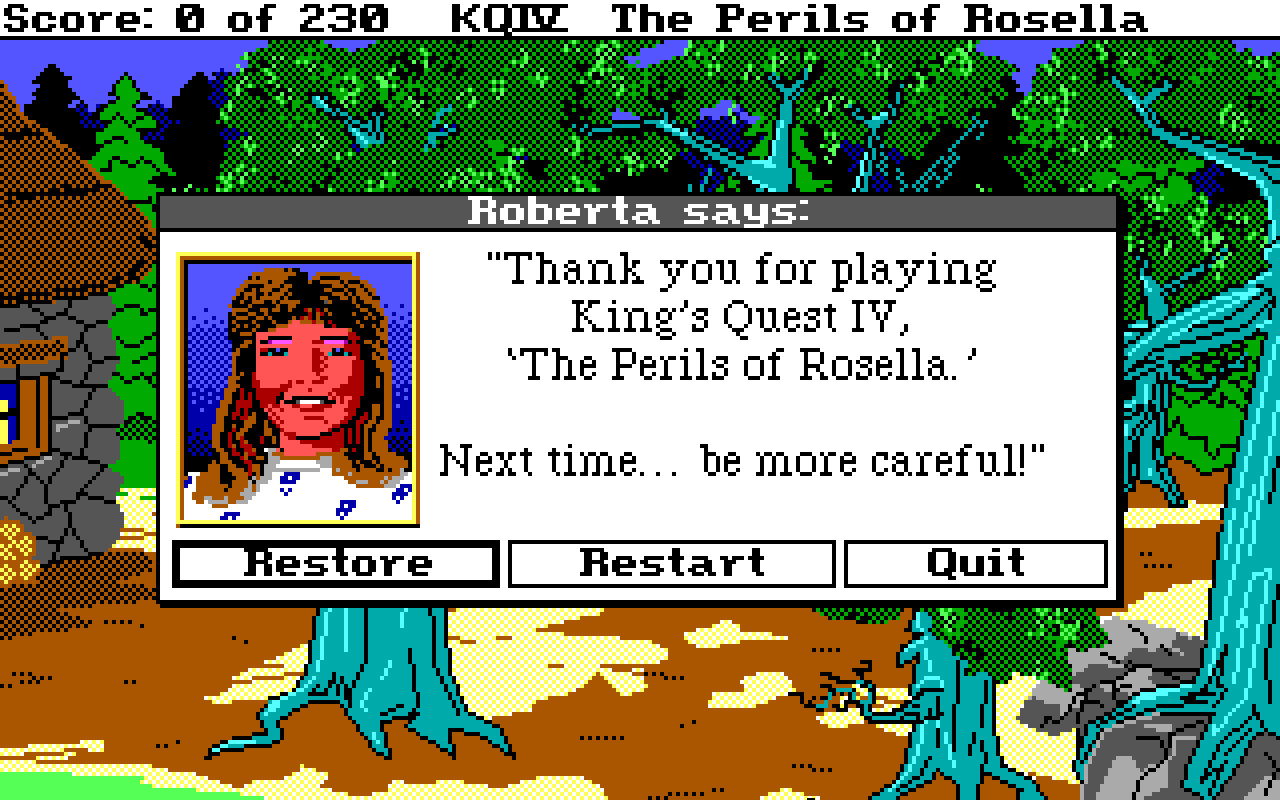
The key giveaway, as Piontek notes, is Roberta's woollen sweater, which is white with a distinctive pattern of black squares flanked by chevrons above and below. This, combined with her expression and the angle of her pose, makes it abundantly clear that it derives from the author photo.
One question remains: why? The likely reason is simple pragmatism. Why use a different image when the simple act of converting the original into 8-bit graphics will substantially change the look of it anyway? That said, I like to believe it's because Sierra wanted to induce a subliminal sense of paranoia in players, that Roberta was watching them try and fail over and over from every corner of the game.
What's almost as fascinating here is the mere concept of a game having an author's photo. It'd be almost impossible to do that for most games today. Not only are PC games almost entirely digital these days, but they're also made by teams of hundreds. You do get a few personalities that stand out, however, such as Kojima or Hidetaka Miyazaki.
The latter would work particularly well with Piontek's final assertion " PS We really gotta bring back game devs telling you to get better at the game when you die". Imagine seeing Miyazaki's disappointed face every time you got battered by Melania in Elden Ring.

2025 games: This year's upcoming releases
Best PC games: Our all-time favorites
Free PC games: Freebie fest
Best FPS games: Finest gunplay
Best RPGs: Grand adventures
Best co-op games: Better together
We should pause a moment, however, to clarify what "new" means here. The world of Rime is indeed new to Cyan's contemporary overhaul of Myst, but the history of this island stretches back a quarter of a century. While Rime never appeared in the 1993 edition of Myst, it was introduced in 2000's realMyst, which converted the game from pre-rendered images into full realtime 3D.
Rime is more like a bonus area than an expansion, a reward for completing the game that provides some additional context for Myst's story. As in the original version, the rebooted Rime centres around a laboratory space dedicated to research of the game's Linking Books. As you'd expect from a remake, though, Cyan appears to have given Rime a lick of paint, stating in the update's Steam post that "sweeping vistas, beautiful ice structures, and fantastical natural phenomena await new visitors".
As for why Cyan has added it into their modern remake, it appears the community has been requesting it, with the developer proudly proclaiming, "You’ve been asking, and we’ve been listening." Alongside adding Rime, the update makes several smaller additions to Myst, updating DLSS support to version 4.0, adding a zoom function, and making some "visual improvements" to the Myst island library.
Designed as a hybrid VR and flatscreen title, the Myst remake released back in 2021. Chris reviewed it at the time, finding it to be a faithful redux of the original, albeit perhaps a little too faithful. "It is nice to be able to actually walk through the world this time, and for a while, it's novel experiencing a familiar place in a new way," he wrote. "But even in the 3D, the classic puzzle slideshow still feels like a series of pretty pictures to be looked at rather than a real location to visit."

Best laptop games: Low-spec life
Best Steam Deck games: Handheld must-haves
Best browser games: No install needed
Best indie games: Independent excellence
Best co-op games: Better together
I am playing—attempting to play—Big Brother, the recently unearthed demo of a doomed, never-released videogame sequel to George Orwell's 1984 and a videogame technology pioneer in that it seems to actively resist being played.
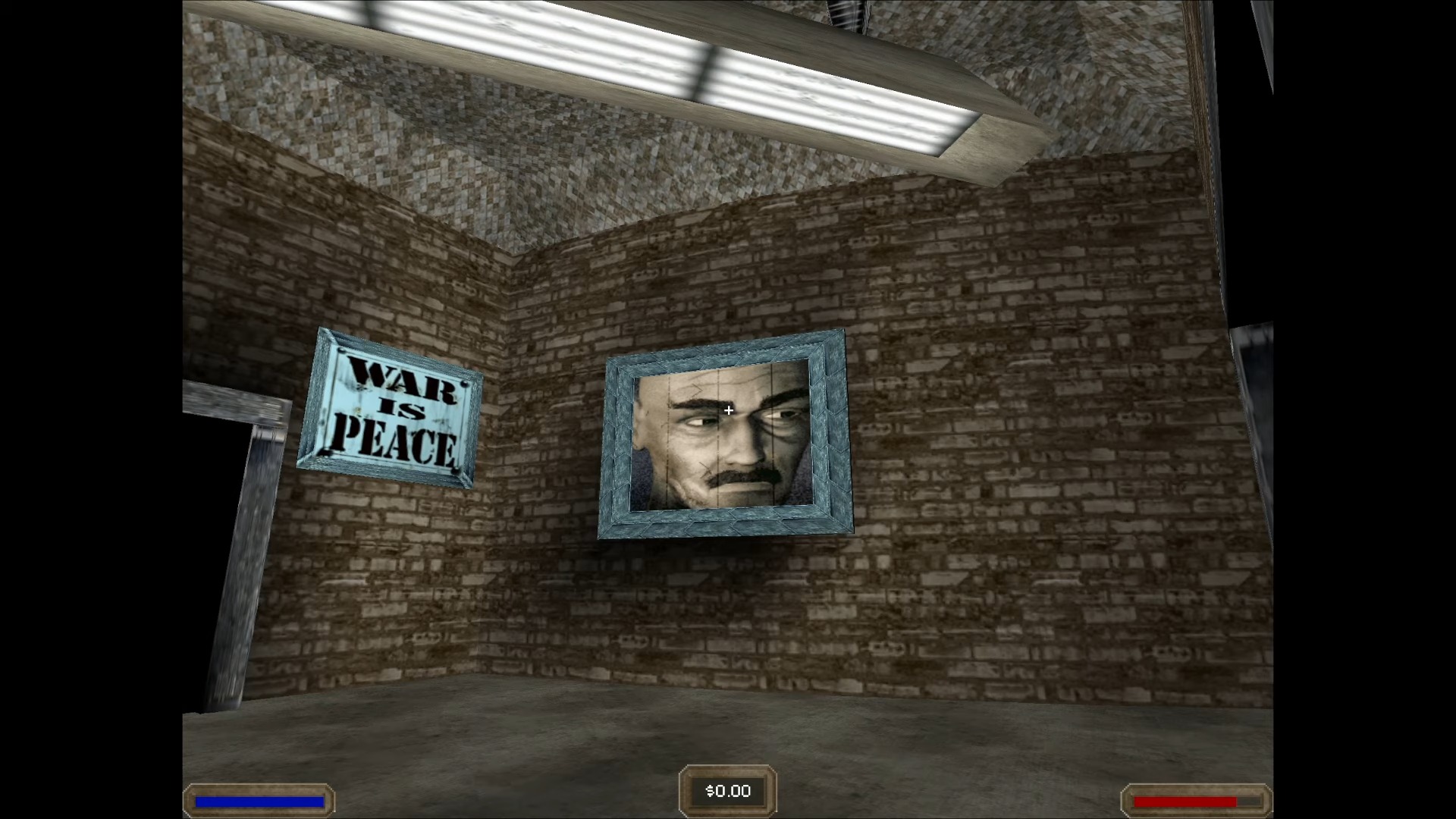
It comes from that post-Myst heyday when devs were convinced that games were the future, man, and why shouldn't we try to create a canonical sequel to a profoundly influential work of Trotsky-flavoured fiction as a videogame where you kill yourself by falling off a lift?
I salute the ambition. There is, I think, something magical to that awkward adolescent phase videogames went through in the '90s to mid-'00s—like devs knew they had all sorts of powers but didn't quite know where their limits were, and a feeling that what videogames were even going to be was still a little bit up for grabs. So, sure, make a sequel to 1984 where you're rescuing your fiancee from the state via a series of water pressure puzzles. Maybe that's what this medium is.
Ignorance is strength
Warping the plot of 1984—a doomed, suicidal, and maybe pointless individual struggle against a seemingly omnipotent state—to fit a videogame is a tall order. So instead, Big Brother just kind of turns the whole thing into a Die Hard adventure.
The plot is simple: a bald man, his every other word punctuated by a fresh bang from WarNoises.wav, needs you to break into the Ministry of Peace and cause a distraction. This will aid the rebellion—there's a rebellion now, keep up—in their quest to do whatever it is they're doing. Also, your fiancee is in there? Maybe?
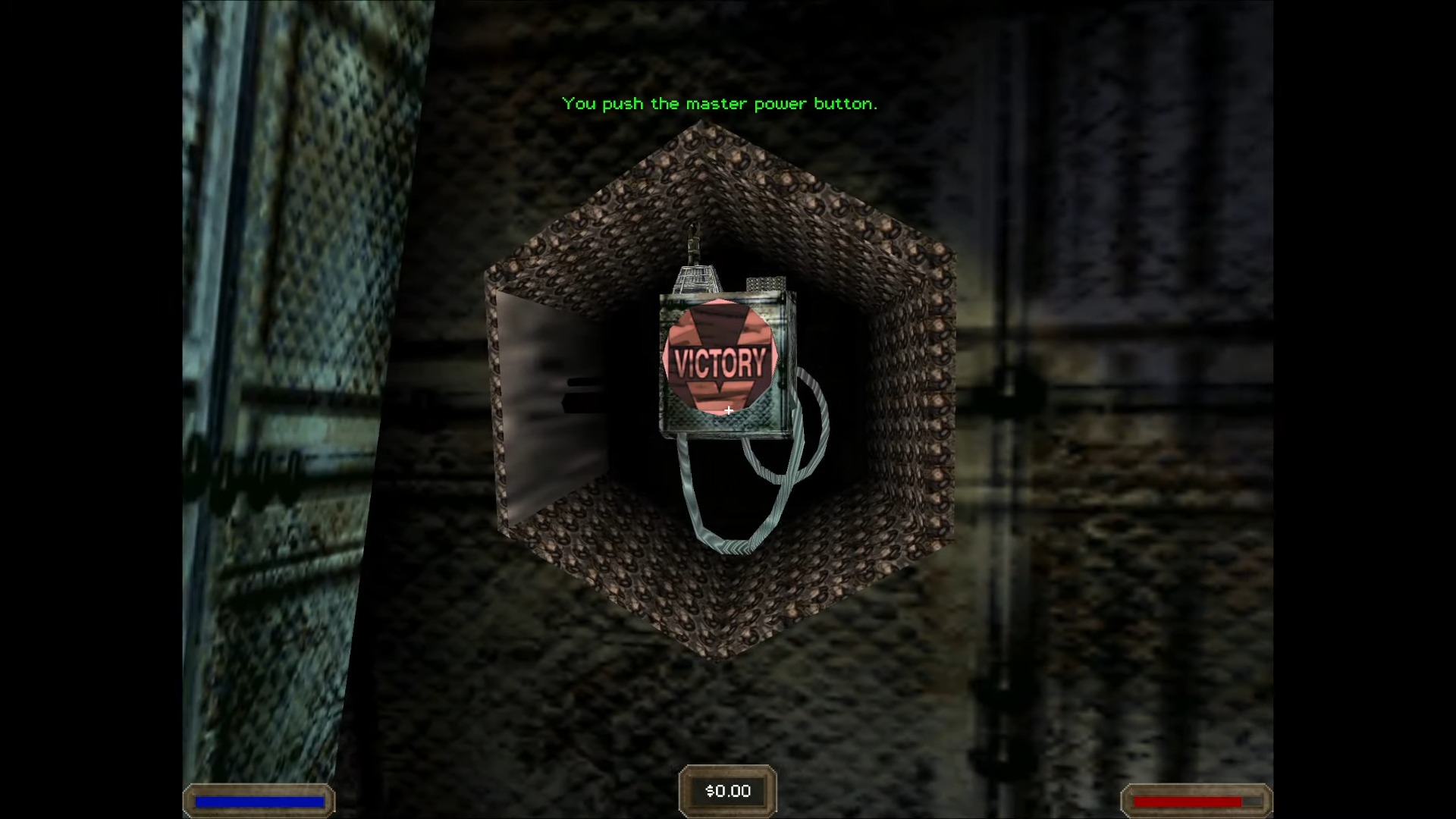
Which is kind of odd, since Big Brother is not a Quake-like, it's a Myst-like. Its levels, at least the ones I experienced, are wide and empty, all about solving puzzles rather than blasting the Thought Police. But it had defaulted to what was, in 1999, kind of a gaming go-to narrative.
It's not a very Orwell plot. It is a very videogame plot, but it's very videogame in such an era-specific way. Today, a generic game narrative is either a lavishly produced HBO knock-off or a low-budget extended metaphor for IBS. The days of videogames defaulting to gruff men ordering war crimes directly into the camera are behind us. Unless you're COD.
For the better? Yes. But there's a nostalgia here; a sense of becoming. Like when you look at teenage pictures of yourself. You look awful, yes, and almost assuredly worse than today, but you were at a phase of your life where it was still possible to become pretty much anything.
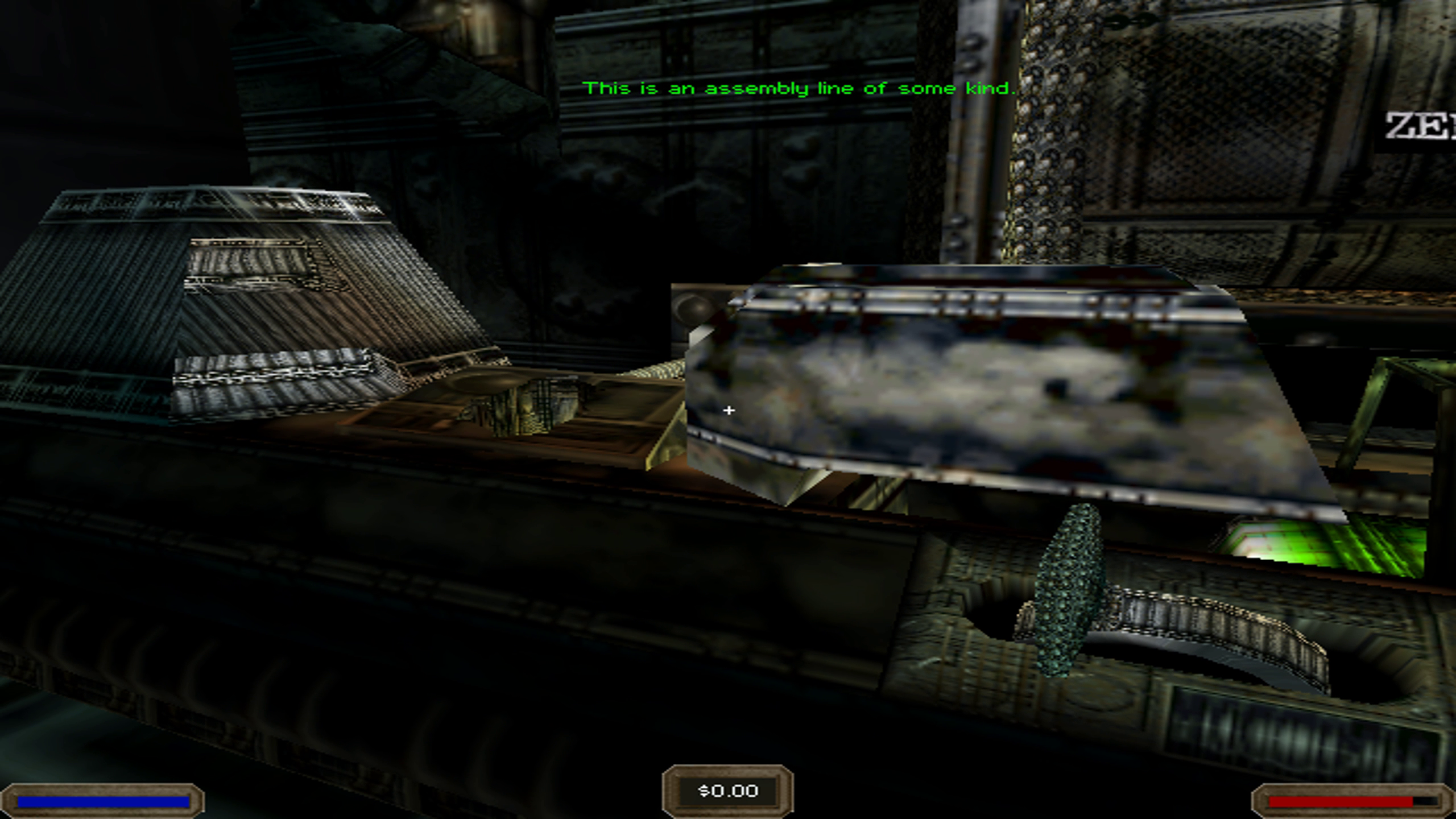
Lightning round
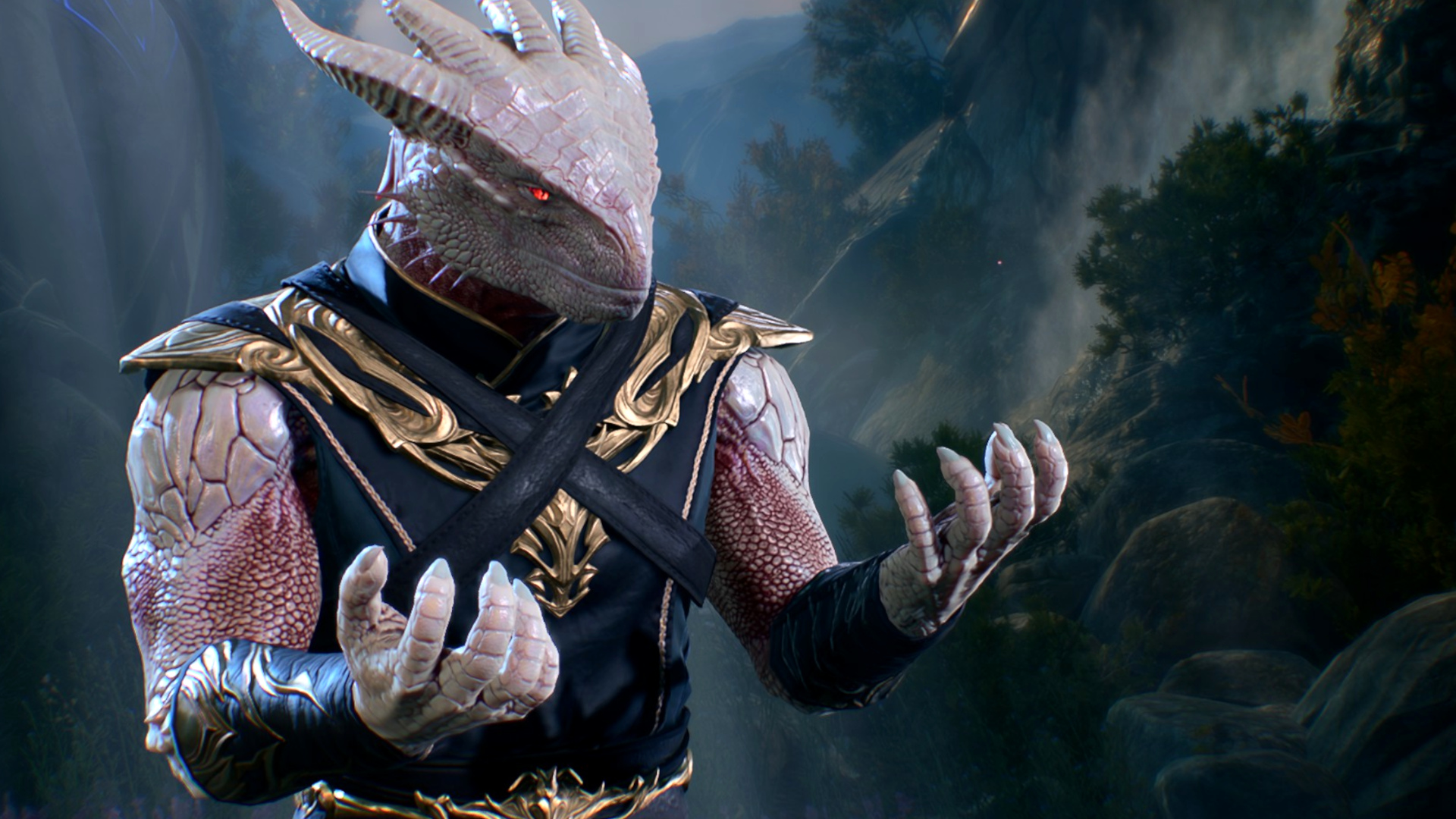
2025 games: Upcoming releases
Best PC games: All-time favorites
Free PC games: Freebie fest
Best FPS games: Finest gunplay
Best RPGs: Grand adventures
Best co-op games: Better together
These are the things you might feel if you ever luck into getting Big Brother running, a process which required me to install two separate pieces of software for mounting .cue files, arbitrarily copy and paste dgVoodoo 2 files into most directories on my PC, and download a whole new set of DLLs for arcane purposes.
These are lost, ancient rituals now, in the days of digital downloads and over 80% of us having some species of Nvidia GPU. Again, it's undeniably better, but there's a kind of intimacy you build with a game when you have to root around filetrees and directly edit .ini files that I don't think you quite get these days.

Back in 2008 I came to understand my less than legitimate copy of Deus Ex like it was my wayward child as I screwed with all manner of tweaks and edits and fan patches to translate it from an .iso on my spinning platter hard drive into a game I could actually play. I still remember where I need to install Shifter, which precise version of the Kentie renderer is best, and how to get to the advanced rendering options menu in the game's console. But the last game I played, Avowed? I don't have half that familiarity.
There's a kind of intimacy you build with a game when you have to root around filetrees and directly edit .ini files that I don't think you quite get these days.
Which, you know, maybe is for the best. Even once I'd performed the sacraments and consulted the auguries, Big Brother still ended up running at Doom-guy speeds. One section, in which I had to hit a button on one side of a room before walking over to the elevator it triggered on the other, became possibly the hardest thing I ever had to do in a game because everything was moving at light speed.
Reaching it before it rocketed back up to the top floor was borderline impossible when I kept smashing into walls and getting caught behind geometry. That's to say nothing of the game's random tendency to kill me stone-dead when I stumbled into obstacles I had no way of identifying.
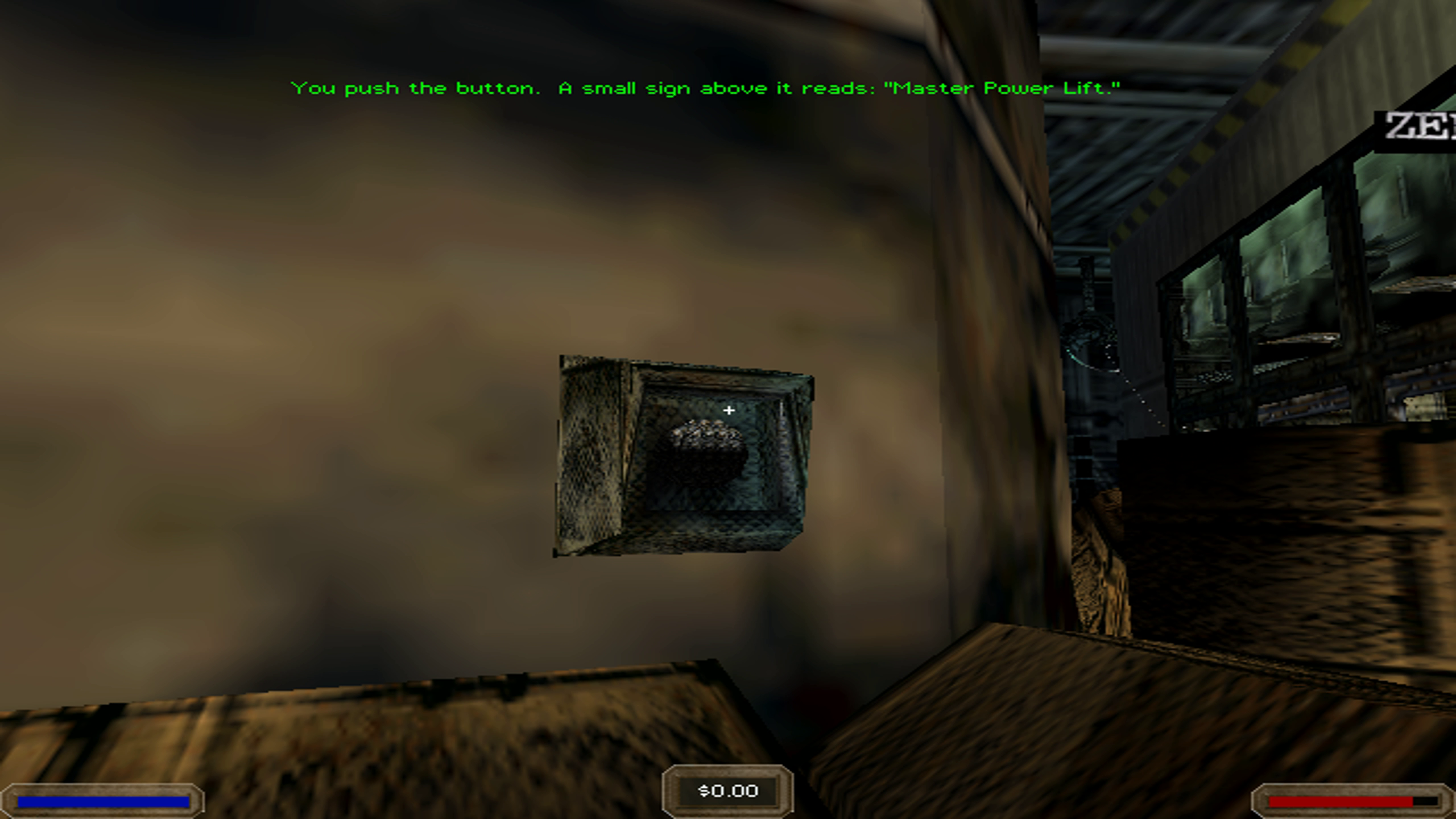
And when I did finally make it, well, the juice wasn't worth the squeeze. I was confronted by a row of showers and a completely inscrutable puzzle that meant I had to configure the water pressure in the base's boiler to be just so. Meanwhile, the mise-en-scene of the whole thing had all the subtlety of a school play: enormous posters containing catchphrases from the book—"WAR IS PEACE" and "FREEDOM IS SLAVERY"—all over the walls alongside looping gifs of Big Brother himself rotating his head threateningly, like some kind of territorial owl.
Game over
I meandered among the tele-screens, all of which seemed to be live CCTV feeds of empty prison cells, and the desolate levels, picking up a seemingly endless series of medkits. Which was odd, because literally nothing in the levels seemed like it had any way of damaging me. Or so I would think until I tripped into yet another completely invisible thing that threw up the "You have been re-educated" game over screen.
Big Brother is not, you might have gathered, a good game, which is probably why its devs never actually released a full version of it. But if you're in the exact right age window, someone whose formative years and awkward teens coincided precisely with the awkward teens of videogames as a thing, you might find yourself strangely charmed anyway.
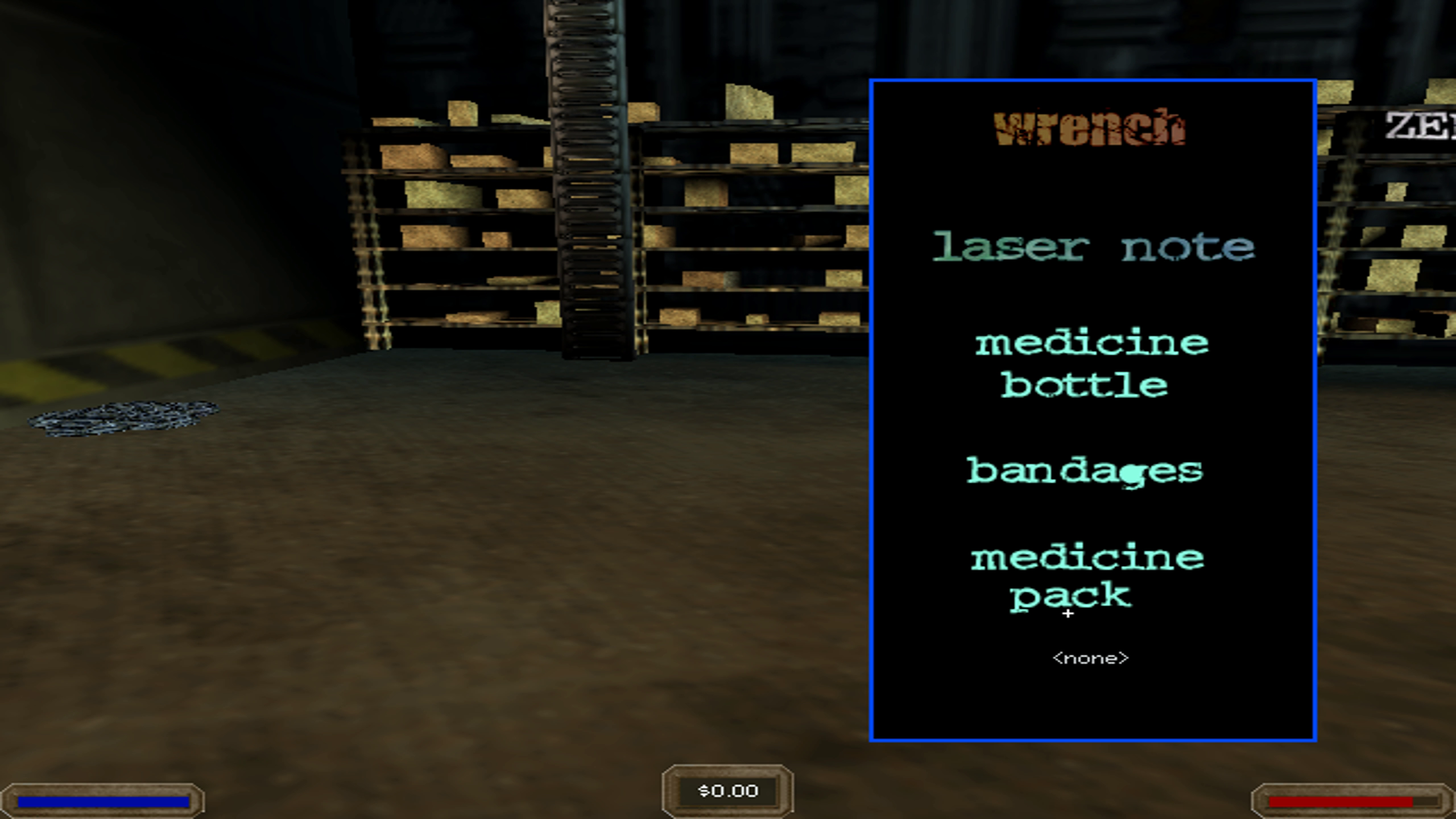
They really don't make them like this anymore, and for good reason, but there's a magic all its own to an entire medium feeling itself out, taking wild swings at things like 'a sequel to 1984' because they're still starry-eyed enough to think that could ever possibly go well. And there's a magic to wrestling the beast that results from those misaimed ambitions into submission, even if I wouldn't really wish it on anyone. Big Brother's not a great game, but as a fossil-in-amber of what it was like to play videogames in a certain period of time? There might not be anything better.
]]>What is it? Detective game where you have to solve and cover up the crime.
Expect to pay: $15/?12.79
Release date: March 12, 2025
Developer: Inkle
Publisher: Inkle
Reviewed on: ASUS ROG ALLY, Gigabyte G5
Steam Deck: Unknown
Link: Official site
Expelled takes the basic bones of that game's structure and sets it this time in Miss Mulligatawney's School for Promising Girls, an elite 1920s training ground for wretched entitled cretins. You're Verity Amersham, the lowly scholarship student, and you've just been framed—possibly—for smashing a stained glass window. Oh, and shoving another girl out of it. You have until the end of the school day to clear your name, frame someone else, and/or discover why this happened in the first place.
That's immediately a more knotty collection of mysteries than Overboard's nice clean premise of 'you've given your spouse a permanent bath, now get away with it'. Each loop starts at 7:30 with that window smashing and the girl taking a tumble. To start with you can flee the crime scene (probably wise), or hide a crucial bit of incriminating evidence (oh, probably wiser), or even just mill around waiting for someone to catch you (er…).
Whatever you choose will carry a time penalty, whether it's exploring the school, talking with other students or teachers, or even just checking how your hair is doing in a mirror. It's a point and click game at heart, a pretty one too, just with an extra layer of time pressure. It gets stressful, particularly in the early runs where you have no idea what you're doing, watching time mercilessly deplete towards that expulsion deadline.
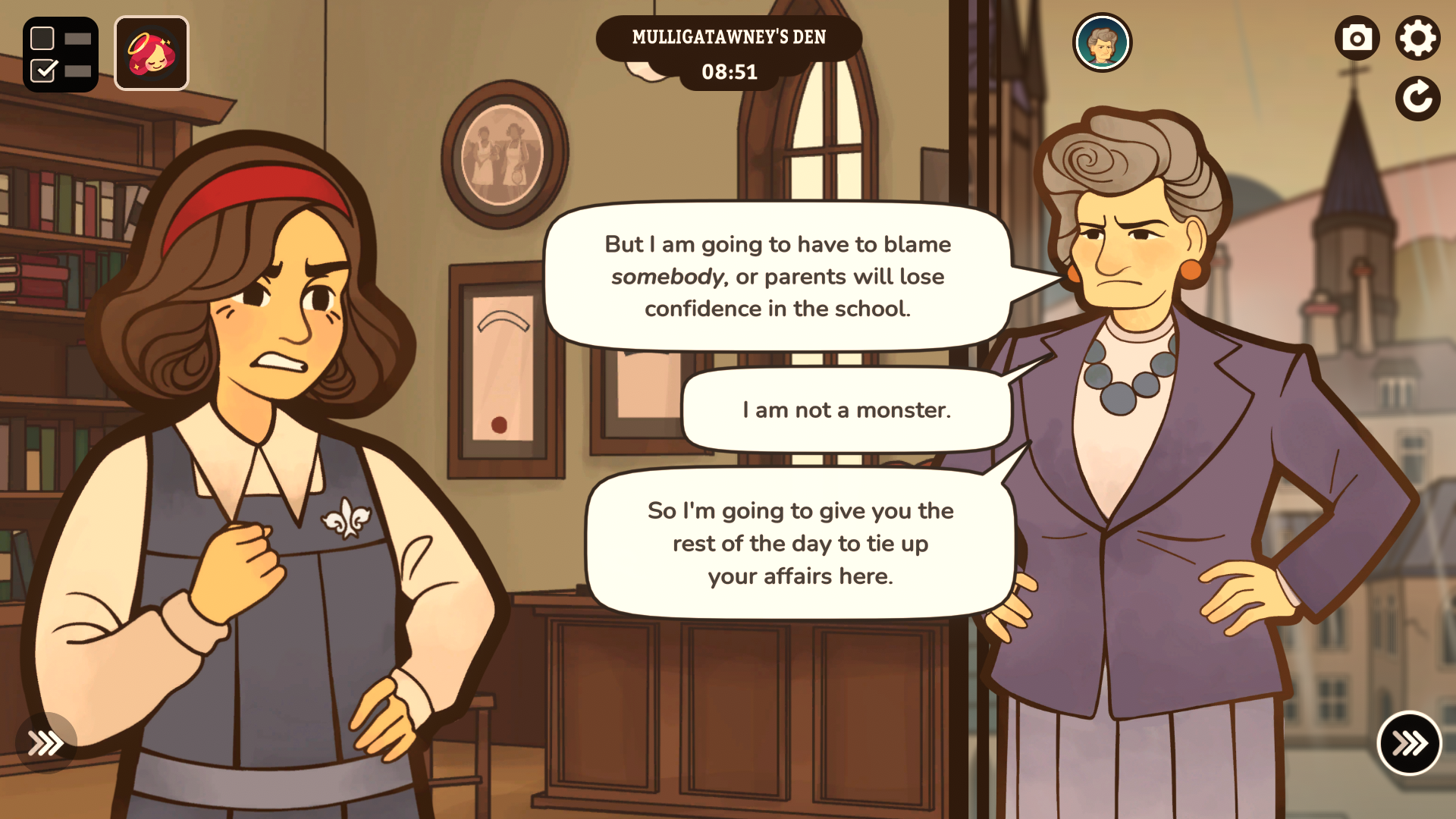
Not always an enjoyable stress, either. Splitting the difference between trying to investigate a crime and get away with it felt frustrating. Like the game was constantly offering me two opposing paths and then punishing me no matter what I picked because I didn't have enough information yet. Naturally the more you play, the more you learn, but the first few irritating loops made me worry that Overboard's much more immediately enjoyable magic had been lost.
Being a schoolgirl, Verity also has a lot less power and agency than Overboard's black widow. Authority figures constantly drag me to locations I don't want to waste my precious time visiting, bad behaviour is punished with essentially 'bad points', and I can't seem to kill anyone. Boo! What, not even that horrid brat Fifi Vaudeville who wants my part in the school play? Or my bizarre roommate Nattie who behaves like she's the protagonist in a tragic Russian novel?
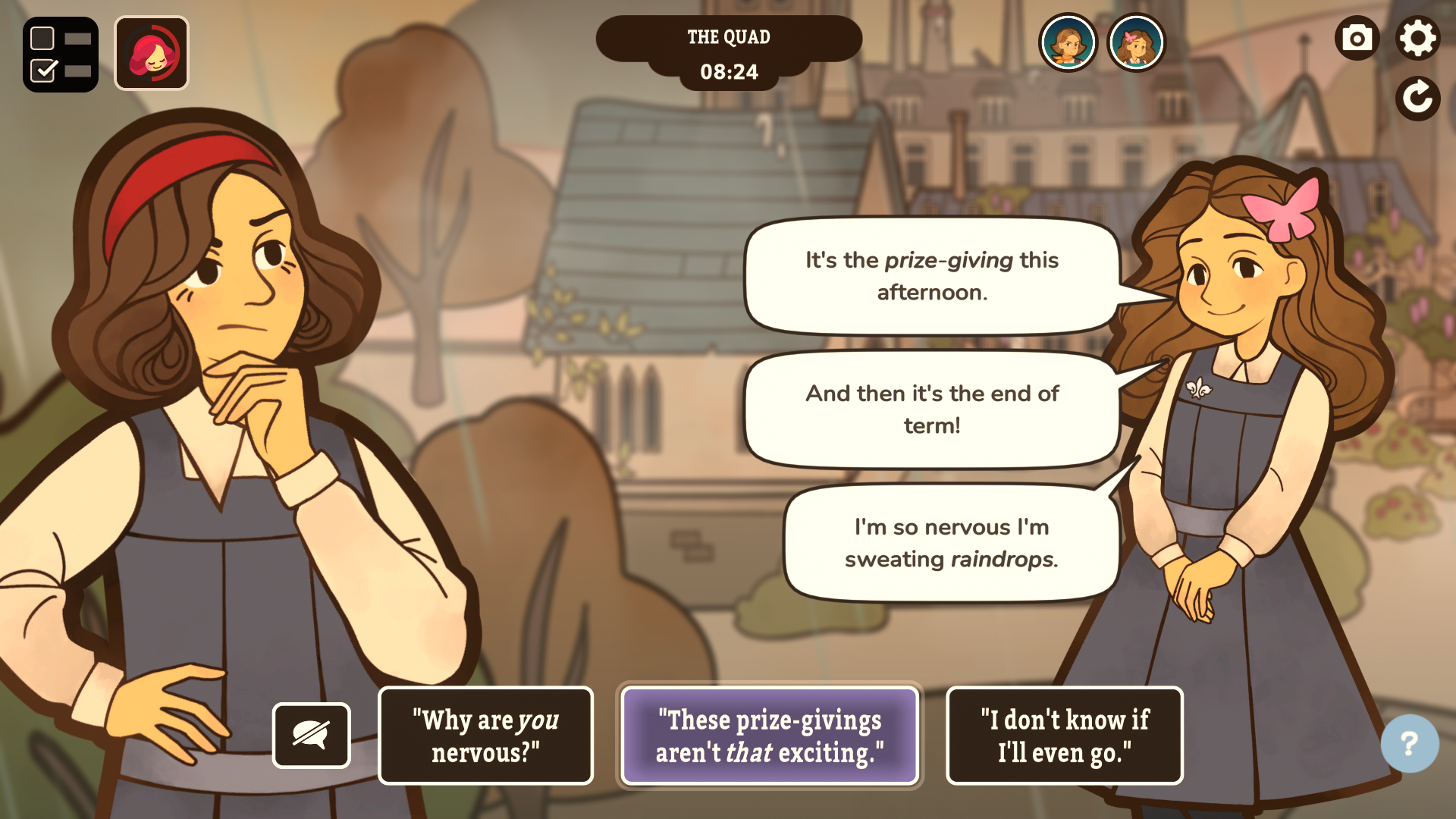
Ah, yes, good news there—Inkle hasn't suddenly lost its talent for writing great characters. Melodramatic Nattie might be my favourite ("must my life be non-stop suffering?" she asks aloud when she can't find her slippers). But I also really enjoy Verity's poor, powerfully-Northern father, and Sal, the girl in the sick bay who may have supernatural powers that she's using to torture the matron. A terrific cast made that initial frustration go down a lot easier.
Then, once I did finally start making some inroads, my frustrations started fading away and a great detective game emerged. With every loop you learn more about each character's schedules, where and when crucial items can be obtained, and the benefits of lobbing an incriminating hockey stick out of a shattered window. Oh, but it'll smack that poor girl who's already fallen out of the window in the head, rapping me with more of those blasted bad points…
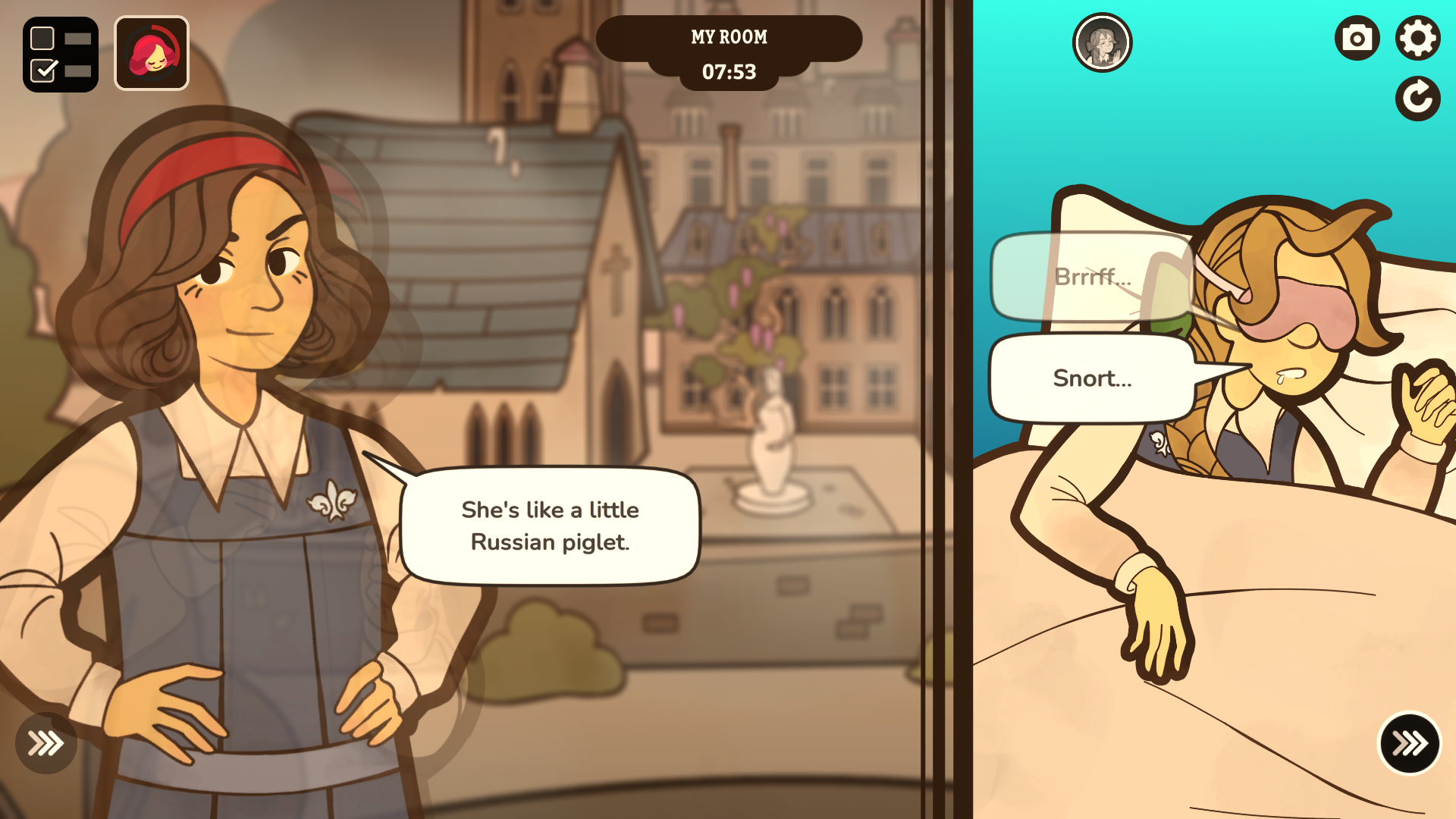
But it turns out, wonderfully, you want those points. There's precious little good karma to be found here and your bad points persist between runs. Once the penny dropped that Expelled wanted me to become an asshole, suddenly this stopped feeling like an Overboard game in name only. Milestones of depravity are steadily reached the more your sins pile up and these in turn unlock more options for increasingly bad behaviour.
Soon I was able to sneak into unattended classrooms and, better yet, throw increasingly creative insults at stupid Fifi ("you puffed-up cockerel!"). Eventually I was rotten enough to the core to be able to silence witnesses properly. It was wonderfully cathartic, after so many failed attempts at trying to flatter stubborn bookworm Bridget into keeping schtum, to be able to simply shove her down a staircase instead.
Getting through the day without expulsion is just the start. The game wants you to get away with the crime, stop one of your rivals becoming head girl, and even somehow snatch that title yourself. I managed a head girl run in about three hours, but even that's not the true end. You have a checklist of outstanding mysteries to pick away at, giving some welcome guidance without spelling out what you need to do.
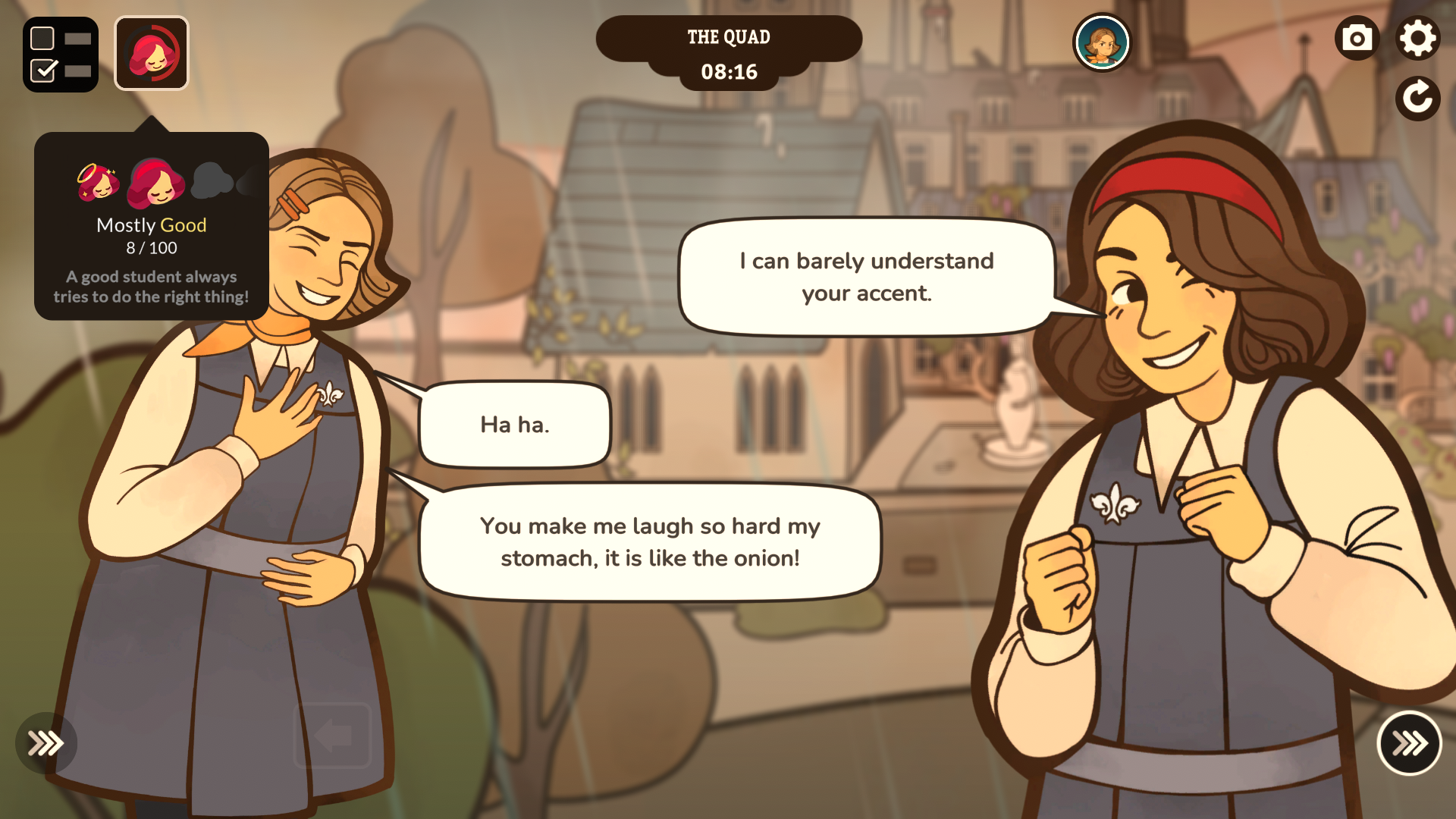
Speedily skipping through dialogue you've seen before is intuitive enough and when you do discover new dialogue trees they're almost always entertaining and often shed further light on the game's bigger mysteries. Timeloop games are inherently repetitive, but the steady unlocking of more bastardly behavior helps that go down a lot easier. I can think of countless games where a replay would be improved immensely by learning I could now push my conversation partner down the stairs.
So after a slightly unfriendly start, Inkle has successfully proven the Overboard structure can tell a more complex story without losing the malicious glee in being a wrong 'un. A game that starts off as a slightly too accurate simulation of the frustrations of being a schoolgirl in a pompous boarding school steadily blossoms into the origin story of a horrid bitch for the ages. Terrific.
]]>Retreading the same 'best friend dead' ground with the initial game's protagonist felt like, well, trying to play the hits, rather than coming up with something new and inventive. You know, like the OG Life is Strange was, growing up in the afterglow era of Telltale's golden age while we still had an appetite for choice simulators, keeping things interesting with a time-travelling twist.
Mollie still quite enjoyed it in her review, even if she wasn't "sure it's a game I needed". That same decent-but-not-necessary result has, as reported by Japanese analyst Hideki Yasuda (via TheGamer), led to a "large loss".
In his analysis on the Japanese gaming industry as a whole, Yasuda states that a recent financial meeting at Square Enix saw company president Takashi Kiryu claim that the publisher's smash hit of Dragon Quest 3 was "offset by the large losses of 'Life is Strange: Double Exposure'."
While it's not painting the whole picture, we can at least get a glimpse of how well the game did by peeking over at its SteamDB numbers. Its all-time peak struck a humble 8,524 players on release—less than half of the hype that Episode One achieved back in 2015, with a peak of 18,260. And that was a few months post-launch, hinting at a solid word-of-mouth popularity that Double Exposure never captured. It's also an ill omen that, around a month after its release, development studio Deck Nine laid off around 20% of its staff.
The following (machine-translated) statement by Yasuda just about sums up Square Enix's foibles: "The company's IP fundamentally varies too much between 'good' and 'bad,' making performance unstable." It doesn't help that Square Enix itself seems to've had astronomical expectations, with Kiryu even going on record to say that its "winning formula is no longer effective".
As a Final Fantasy enjoyer myself, I've been regarding Square's recently stumbling with a bit of sadness (and worry for one of my favourite MMOs), but given Mollie's confirmation that the game did "a lot of retreading old narrative ground of its predecessor", I'm putting Double Exposure firmly in my 'this just wasn't a great plan, guys' pile. Still a few rungs up from that baffling NFT project, mind.

Best cozy games: Relaxed gaming
Best anime games: Animation-inspired
Best JRPGs: Classics and beyond
Best cyberpunk games: Techno futures
Best gacha games: Freemium fanatics
In an email to Game Developer, Playdead confirmed it has "submitted demands" to Patti, claiming it has "found it necessary to take this action to protect our trademarks and copyrights, which are essential to Playdead's business and reputation".
The legal demand was originally brought to public attention by Patti himself, who claimed he'd received a "legal love letter" from his former business partner Arnt Jensen several days ago. Posting on LinkedIn, Patti stated that "my old partner has threatened me with an IP lawsuit because I used a publicly available picture, in a LinkedIn post 3 months ago, of the game Limbo that we created at Playdead together."
Patti also posted screenshots of the purported letter, which references this earlier LinkedIn post directly. "In the post you included a copyright protected image owned by Arnt Jensen, founder of Playdead, as well as a registered and well-known trademark 'Limbo' belonging to Playdead." For this "infringement and unauthorized use", Playdead demands "suitable compensation and reimbursement totalling 500,000 DKK" (approximately ?56,000).
The letter also makes some bold claims regarding Patti's role in the creation of Limbo, which was the subject of Patti's initial LinkedIn post that seemingly prompted the letter. "By providing recipients with core insights to the process of developing Limbo, you are falsely giving the impression that you played a significant role, including a creative role, in the developer of the game."
Going further, the letter claims that "by stating that we designed, we crafted, we allowed players…. This gives a false and misleading impression to business partners and to the game industry as you were actually not an essential part of the creative development of LIMBO."
According to Patti, such demands from Playdead are nothing new. He states in his LinkedIn post that "it's happened repeatedly over the last nine years". He also claims that on one of the previous occasions Jensen "tried to bully" him, he told his former business partner he would "make it public."
In response to the letter, Patti states he was "a significant part of building Playdead from the ground up" and that "without me, Playdead wouldn't have existed. That's not ego, that's a fact." While he doesn't directly challenge Jensen's claims regarding Patti's role in Limbo, he does say that "we created" the game "at Playdead together."
Patti departed Playdead following the launch of 2016's Inside, going on to help found Jumpship Games with Chris Olsen, which went on to developer 2022's Somerville. The letter posted on LinkedIn by Patti references this game too, stating Playdead wants to "emphasise and reiterate previously stated concerns about Somerville, and the importance that Playdead's intellectual property rights remain respected at all times." The letter doesn't specify what these concerns are, however.
Playdead, meanwhile, hasn't released a game since the launch of Inside. According to the studio's X profile, its current project is a "3rd-person science fiction adventure set in a remote corner of the universe". Our last glimpse of this nameless game came in February last year, when Playdead revealed two new pieces of concept art from the project.

2025 games: This year's upcoming releases
Best PC games: Our all-time favorites
Free PC games: Freebie fest
Best FPS games: Finest gunplay
Best RPGs: Grand adventures
Best co-op games: Better together
What is it? An adventure about a fallen warrior running a cozy tea shop
Expect to Pay: $24.99/?19.99
Developer: Ivy Road
Publisher: Annapurna Interactive
Reviewed on: Intel i7 9700K, RTX 4070 Ti, 16GB RAM
Multiplayer? No
Steam Deck: Playable
Link: Steam
Go to therapy. That's the message I received in Wanderstop, a narrative adventure about a troubled warrior running a tea shop. I think it's excellent advice, especially since it comes with an important and honest caveat: therapy, helpful as it may be, won't fix you. It's just a starting point.
In Wanderstop you play as Alta, a fierce warrior who hasn't known a single defeat in years, but who one day starts losing all her fights and eventually finds herself so weak she can't even lift her sword. She collapses and awakens in an idyllic forest clearing where a cozy tea shop owner named Boro suggests she recover her strength while learning how to make tea for a collection of oddball customers.
What follows is part tea shop management sim—figuring out what sort of tea a customer wants, farming the ingredients, and brewing the tea—and part story-driven adventure as Alta grapples with her mental health and personal history, and examines her relentless need to be a champion. Wanderstop is successful on both ends: it's a satisfying tea shop sim and a well-written story I'm still thinking about after I've finished.
Steep and deep
It's a good thing Alta is a warrior because making tea in Wanderstop is more of a physical activity than you might guess, mostly because Boro's teakettle is a towering two-story contraption built more like a giant alchemy set than a teakettle. You have to clamber up a ladder to pull the chain that fills it with water, pump the bellows to heat the water to a boil, and kick the valve that sends the water through a spiralling tube to a teapot the size of a jacuzzi.
Then you chuck in the ingredients: an orb of tea leaves the size of a soccer ball, a colorful piece of fruit from your garden, maybe a mushroom, occasionally even an object like a book: it all depends on what type of tea the customer has ordered, and these customers usually have eccentric tastes. Smack another valve and the brew descends to the spout where you can fill a mug with tea and hand it to a customer. Or to Boro, if you want to see how he likes it. Or you can find a quiet spot in the clearing to sit and sip it yourself.
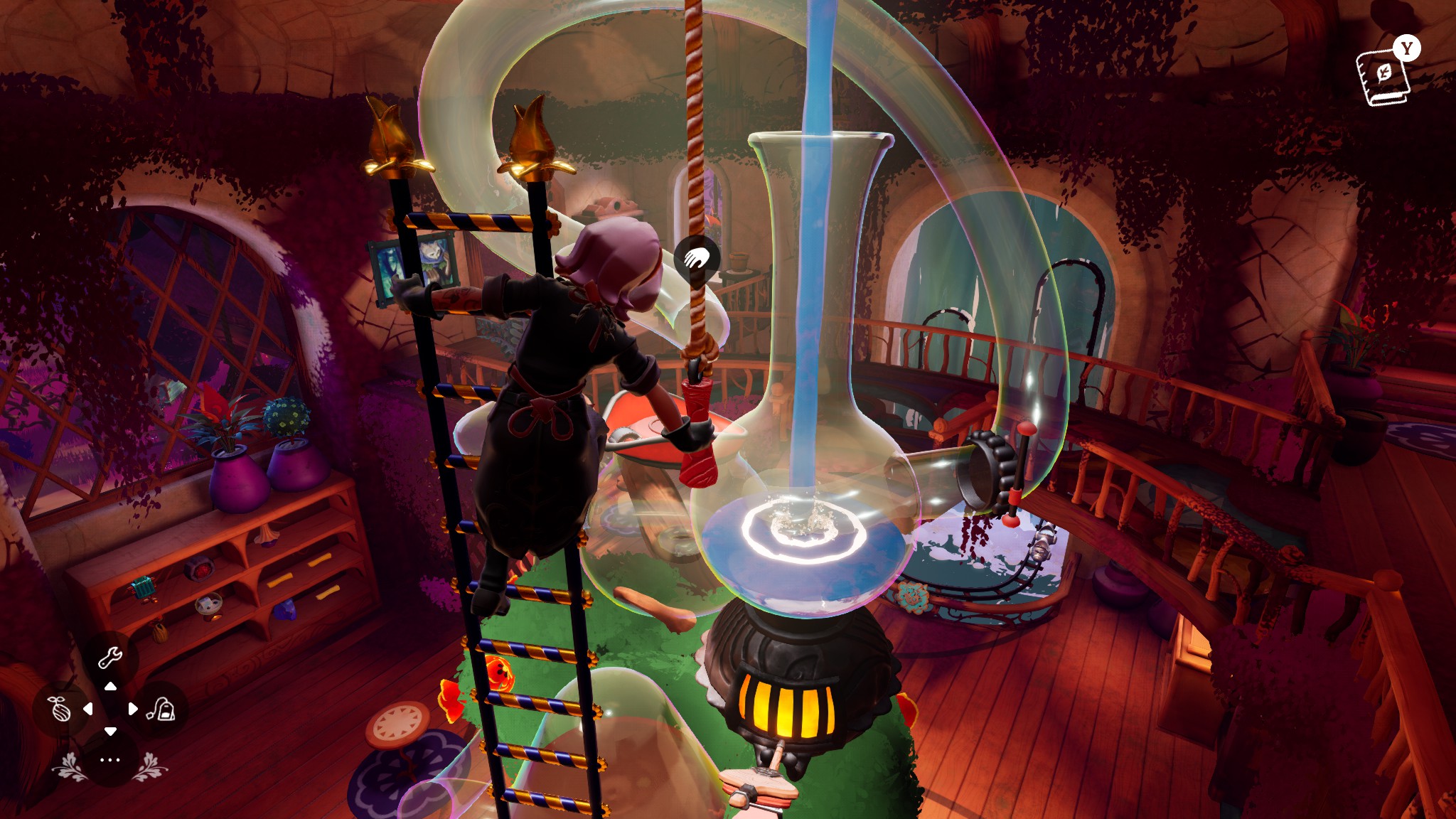
It's all beautifully done: the teashop management system in Wanderstop could have been an enjoyable game all on its own, with charming fantasy characters placing bizarre tea orders and you farming, mixing ingredients, and clambering around on your enormous alchemy set to make them happy—sort of like Strange Horticulture but for caffeinated drinks.
But there's the other half of the game, where you learn about Alta's life and history and self-doubts, where you talk to customers about your problems (and theirs), where you speak regularly with the kind, gentle, and generous Boro, who listens to your troubles without judgement, who doesn't give advice but instead offers his own perspective.
Sort of like therapy. I've never really told anyone this, so why not do it in a videogame review, I guess: I was in therapy for a couple of years, and several moments in Wanderstop are reminiscent of my experience. At one point Alta explains to Boro that she's been pushing herself to her limits for years and she never felt tired before. She simply can't understand why she's suddenly tired now. Boro gently suggests: isn't it possible she's tired because she's been pushing herself to her limits for years?
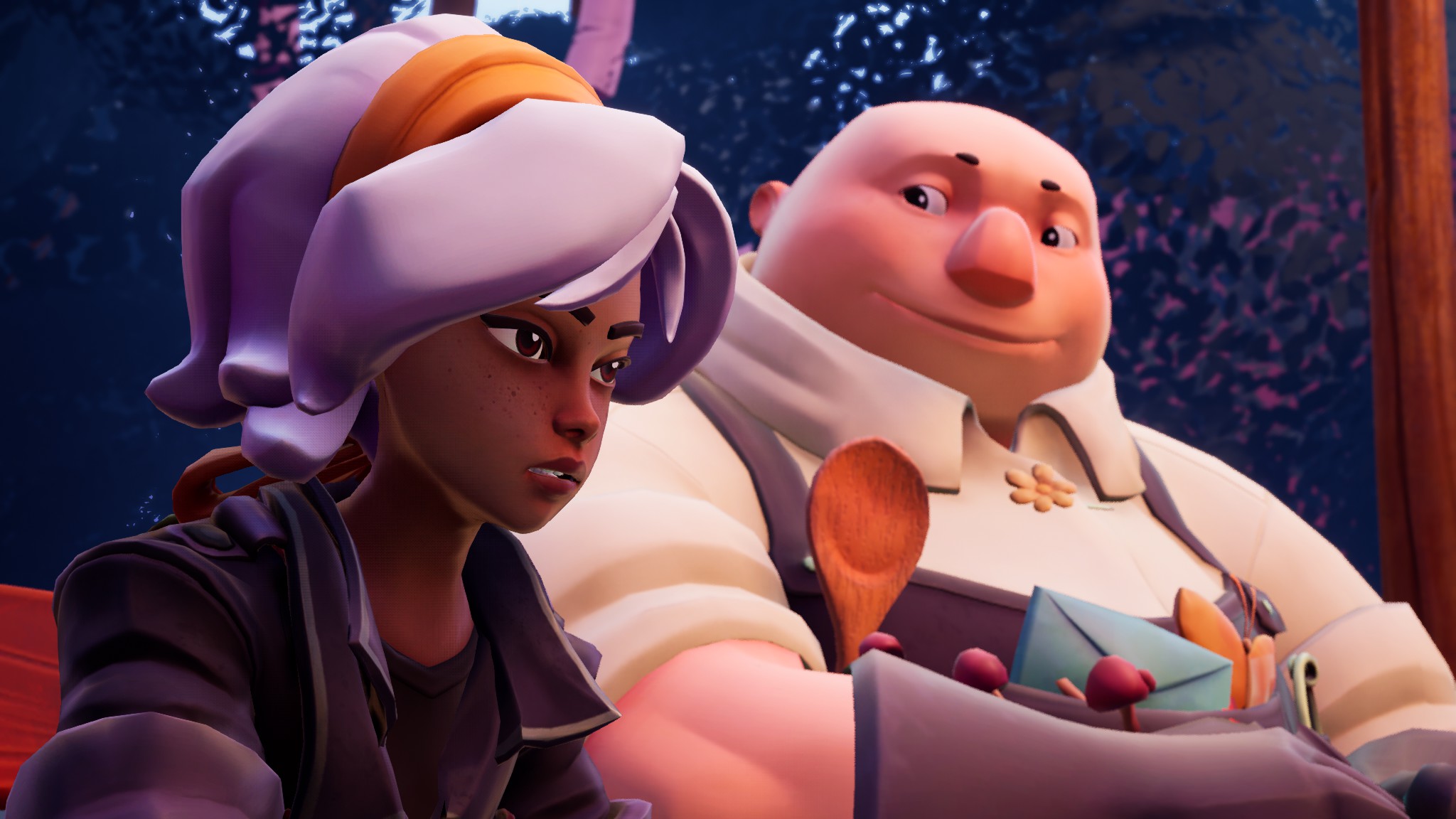
The most helpful moments in therapy for me were a lot like this: gaining a new perspective, sometimes a painfully obvious one I'd somehow been missing despite stewing over my problems for years. Sometimes it just takes someone else to look at your situation and give you a little bit of information you were unable to grasp yourself.
That's also, in some ways, what I found to be the limits of therapy. I was given information, I gained some new perspectives, but I didn't walk away from it as a whole new person. I wasn't "fixed," not even a little. I had been given some new tools, but I still had to actually decide on my own if I would use them or not. This theme also comes through in Wanderstop: as magical as this cozy little tea shop in the forest clearing is, no one is going to wave a wand that will solve Alta's problems.
Help wanted
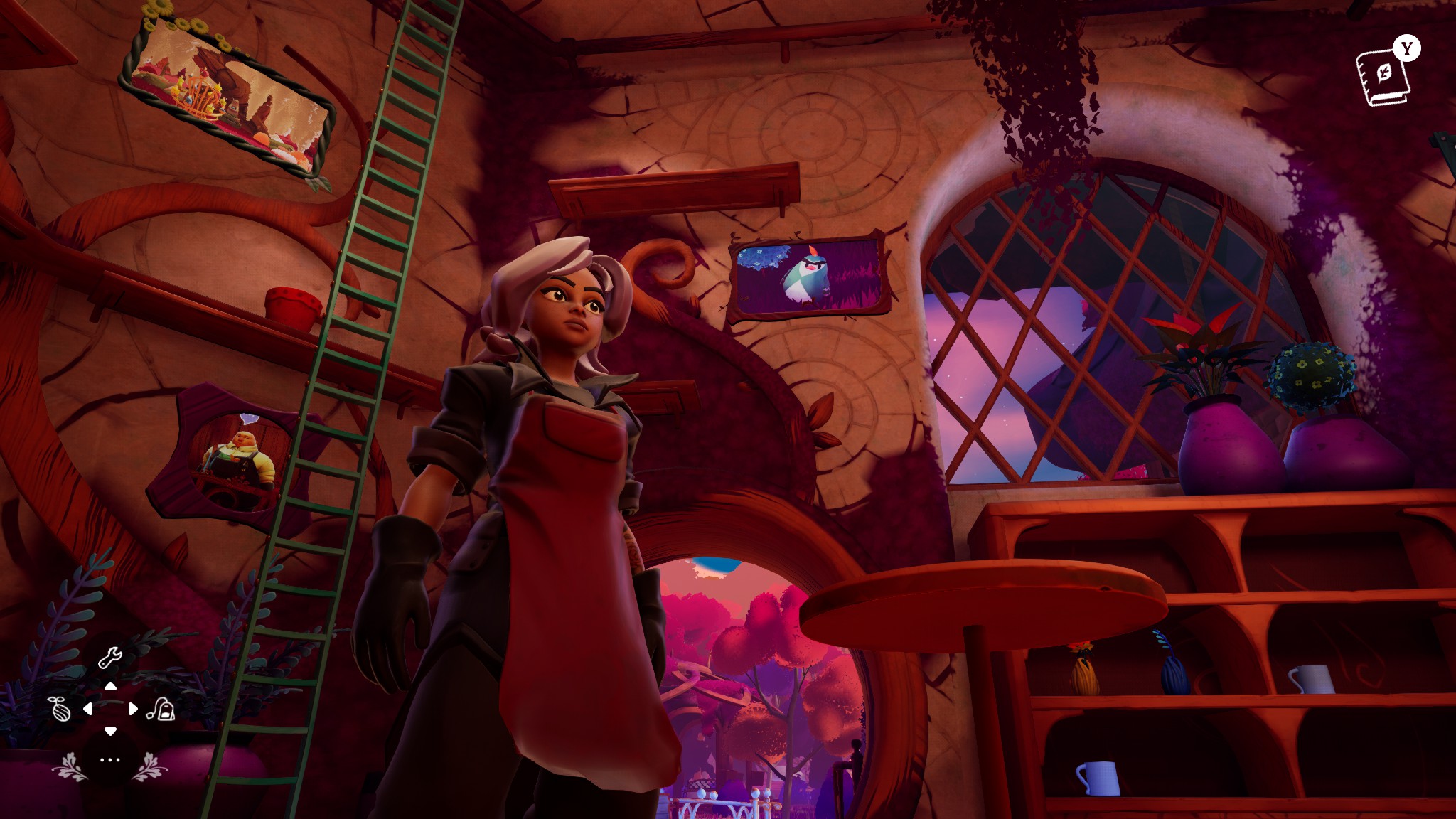
There are other moments I appreciate in the writing by Davey Wrenden (The Stanley Parable) and Karla Zimonja (Tacoma). Not long after I met one character, they began asking me some personal questions, and for a moment I was torn: telling this stranger my feelings felt like the videogame thing to do, in that it would advance our relationship and thus the story. But it didn't feel natural to open up to someone I'd just met, same as I'm reluctant to share myself with people I don't know well in real life.
It's rare to follow a non-gaming instinct in a game and see it rewarded.
A dialogue option let me essentially say, "I don't know you well enough to talk about that," and the character left. I wondered for a while if I'd messed up and missed part of the story, but a little later that character returned and basically apologized for pushing me to reveal personal information I wasn't ready to share. I liked that: it's rare to follow a non-gaming instinct in a game and see it rewarded.
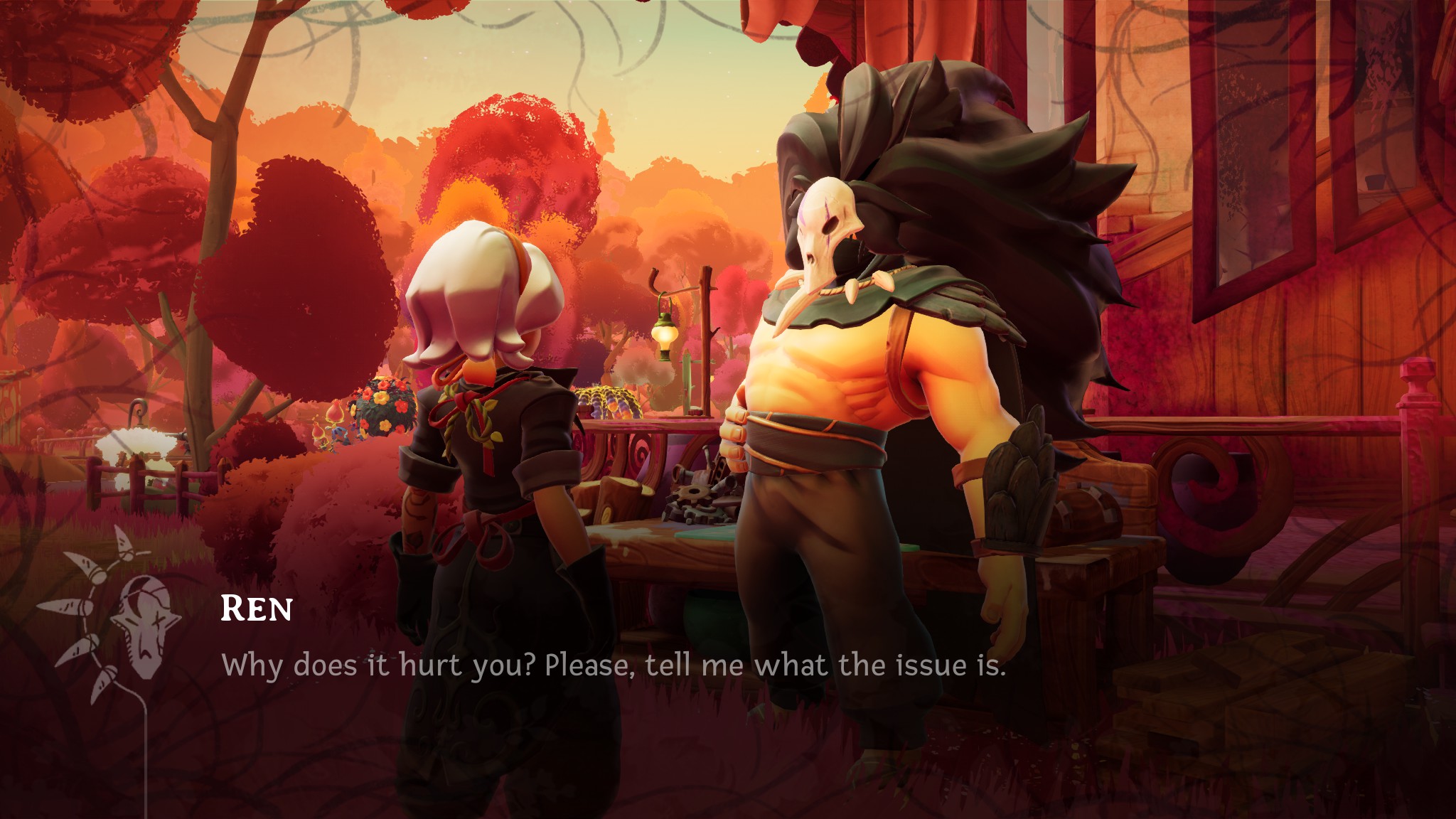
Wanderstop also presents another important truth: when people see you hurting they will often try to help, but even though they may mean well, they are probably unequipped to actually help. Acquaintances, friends, family, they may think they know how to solve your problem, but they can be just plain wrong. That's the case with one of the customers you slowly get to know in Wanderstop.
It's extremely difficult to turn down that help, especially when it comes from a place of kindness and caring—and especially if the person offering is increasingly insistent. It can even feel like you're letting them down by denying them the help they're offering. But even coming from a place of good intentions, it can do you harm. It's good to see that message in a game, too.
Wannastop
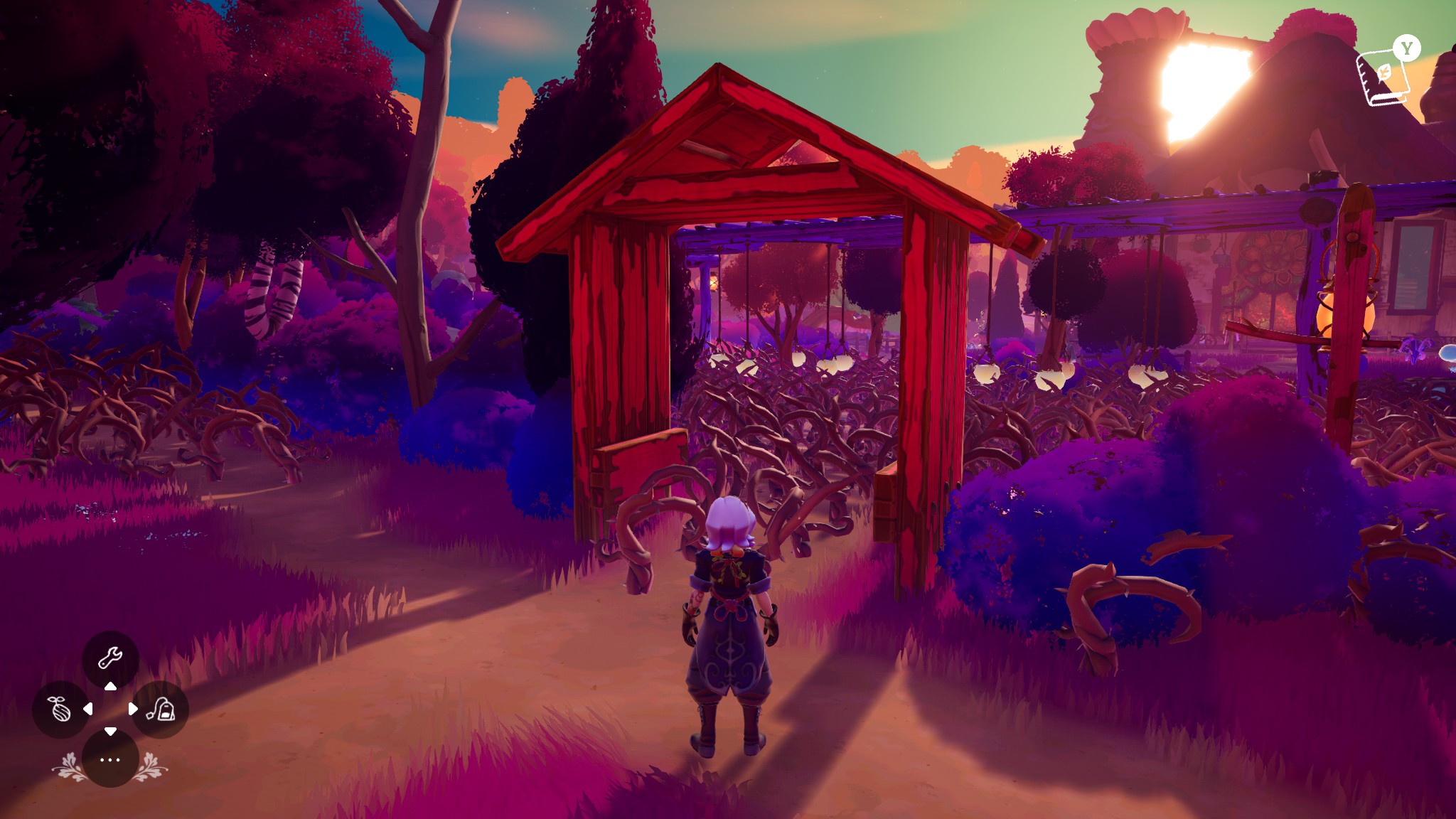
Wanderstop does a great job with its two halves: there's a satisfying farming and alchemy system that makes brewing tea a genuine pleasure, and there's a well-written story with meaningful themes and interesting characters. One thing I noticed, though: as a sort of side-effect of the self-reflective nature of Wanderstop, I found myself examining how I was actually playing it.
Here I was, playing a warrior who needs rest and relaxation, and what was I doing? Holding down the sprint button as I rushed around gathering ingredients and making tea. Getting stressed out by the thorny weeds that would grow across the clearing if I didn't snip them with my shears. I gave a bird some coffee and it started following me everywhere, squawking: I started worrying I'd gotten it addicted to caffeine.
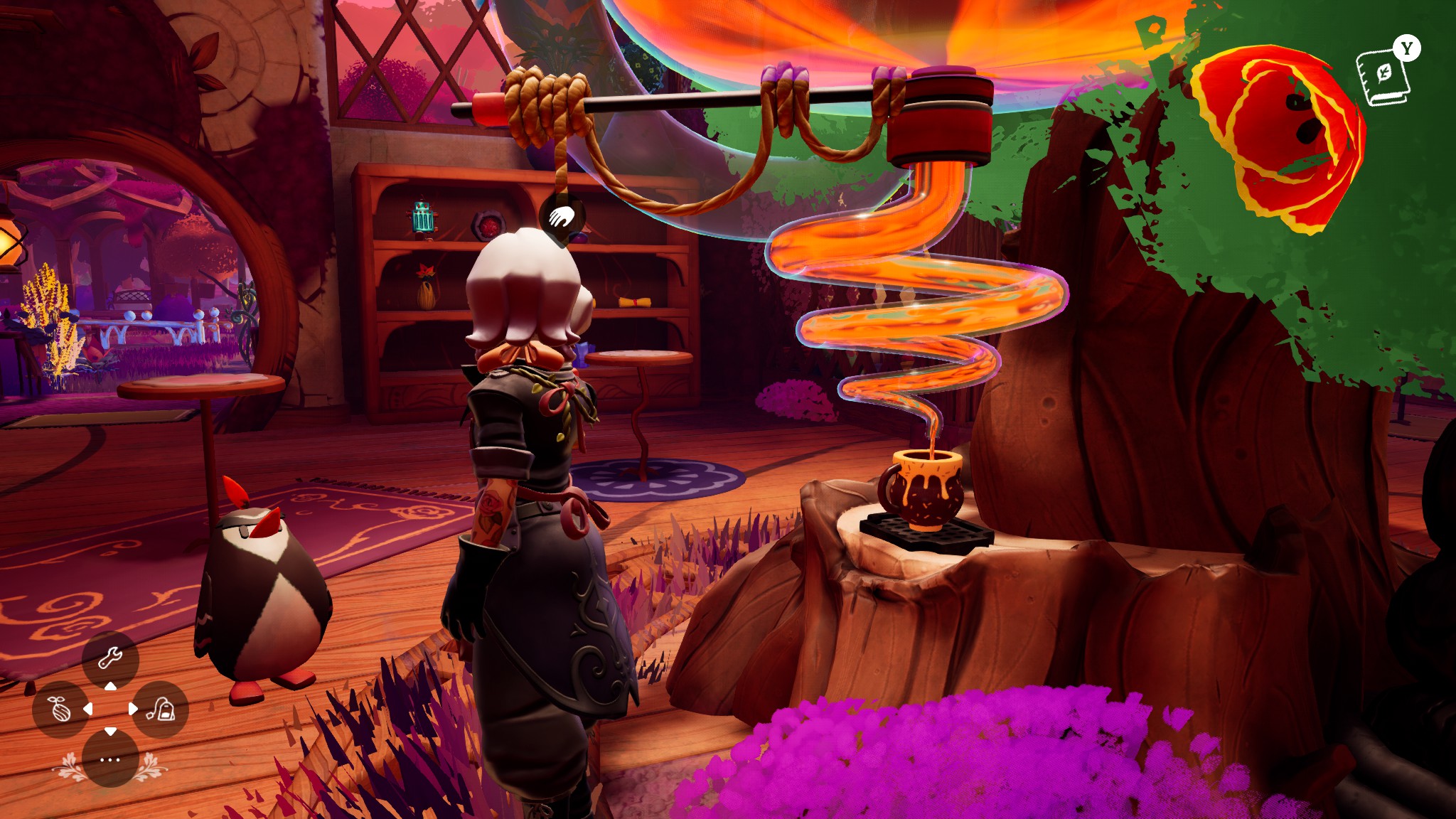
If this is a cozy game about chilling out, why was I usually a bundle of nerves while playing it? With such serious themes, and the stakes of Alta's mental health on the line, and my own need to complete tasks in a brisk manner, I didn't really find Wanderstop all that relaxing.
Maybe I'm more like Alta than I thought: I have trouble slowing down and taking it easy when there are so many things to do. Something for me to examine in therapy, I suppose.
]]>What is it? A world-hopping co-op adventure with a pair of aspiring authors.
Release date March 6, 2025
Expect to pay $50/?40
Developer Hazelight Studios
Publisher EA
Reviewed on RTX 4090, Intel i9-13900k, 32GB RAM
Steam Deck Verified
Link Official site
Split Fiction sets a relentless pace—one that it maintains throughout the entire 15-hour caper. To play Hazelight's co-op adventure is to experience the entirety of a theme park's myriad diversions while you're on a rollercoaster: plummeting down into the hall of mirrors, leaving nothing but a trail of glass behind; hurtling through a shooting gallery, gunning down targets as you blitz past; colliding with a haunted house, spilling animatronic horrors everywhere.
Except Split Fiction's diversions are a wee bit more thrilling than funky mirrors and cheap scares. One minute you're solving puzzles in a fantasy realm by shape-shifting into apes and fairies, the next you're space marines in a 2.5D sidescroller, using your guns and the power of friendship to bust into a futuristic prison. Whatever you're doing, though, there's usually a lot of running, jumping and flying—gotta go fast.
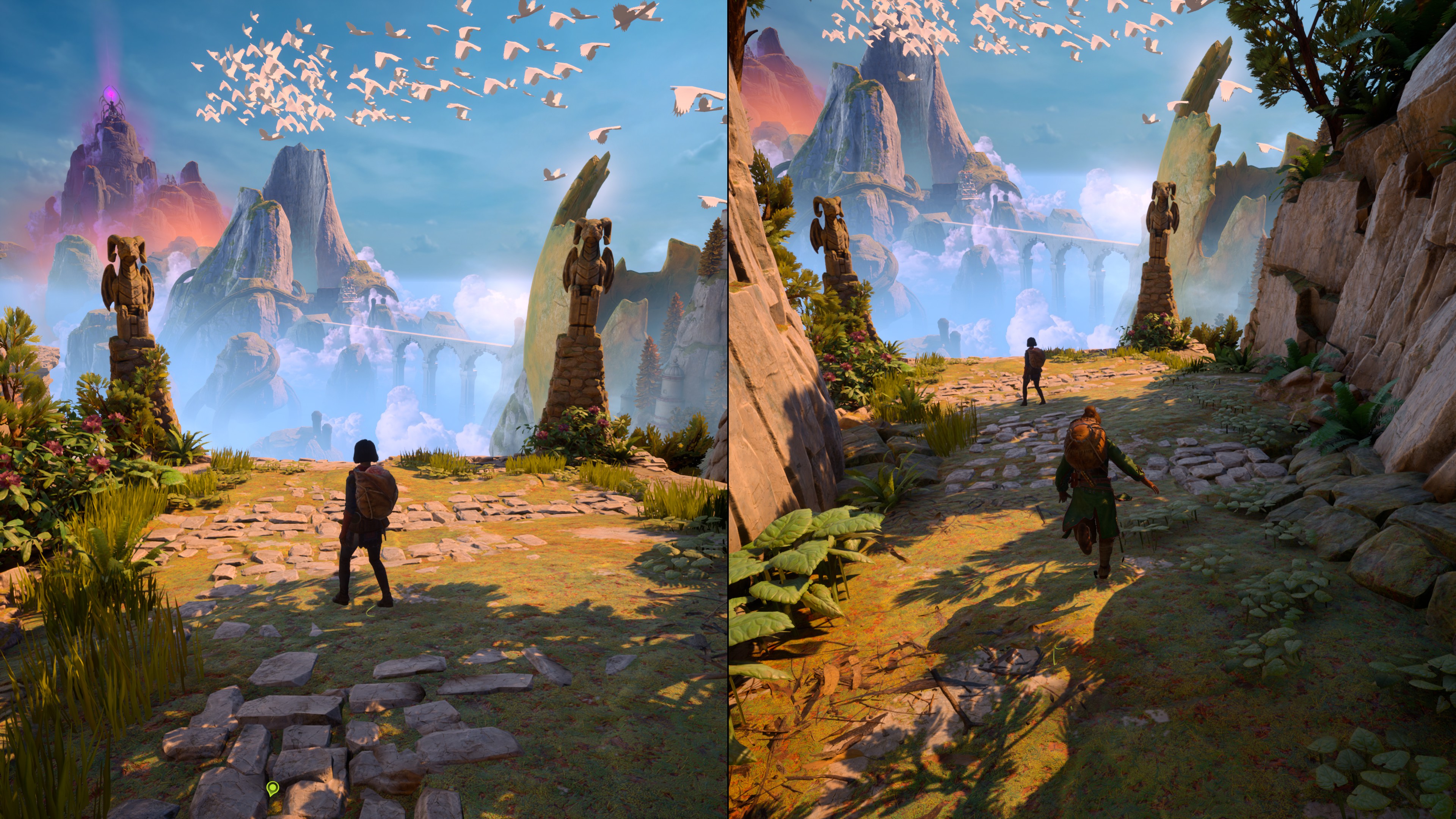
It is quite frankly nuts how frequently Split Fiction shakes things up—even more than Hazelight's It Takes Two—given its unstoppable forward momentum. But this is baked into the very premise. Two aspiring authors, Mio and Zoe, have been invited to a meeting with a publisher, Radar, whose CEO turns out to be a massive arsehole and plagiariser.
Mio and Zoe find themselves stuck in their stories, forced to work together to escape the worlds of their own creation.
Through some half-baked sci-fi nonsense, Mio and Zoe find themselves stuck in their stories, forced to work together to escape the worlds of their own creation. I say "forced" because they are far from willing collaborators. Mio loves sci-fi, hates fantasy and has no social skills. Zoe is annoyingly extroverted, loves fantasy and hates sci-fi. It's a very basic, very on-the-nose odd-couple dynamic with two dull, broadly-written characters.
Naturally, they discover that they are more alike than they realised (I'll let you get your gasps out of the way), and that they make a great team. Oh yeah, the thing that makes them bond? Trauma. Which is revealed through the stories they've written, and by playing through them together, they let each other in. It's cheesy and obvious, but look: sometimes you just wanna see some people become buddies. It's nice! It's even occasionally touching.
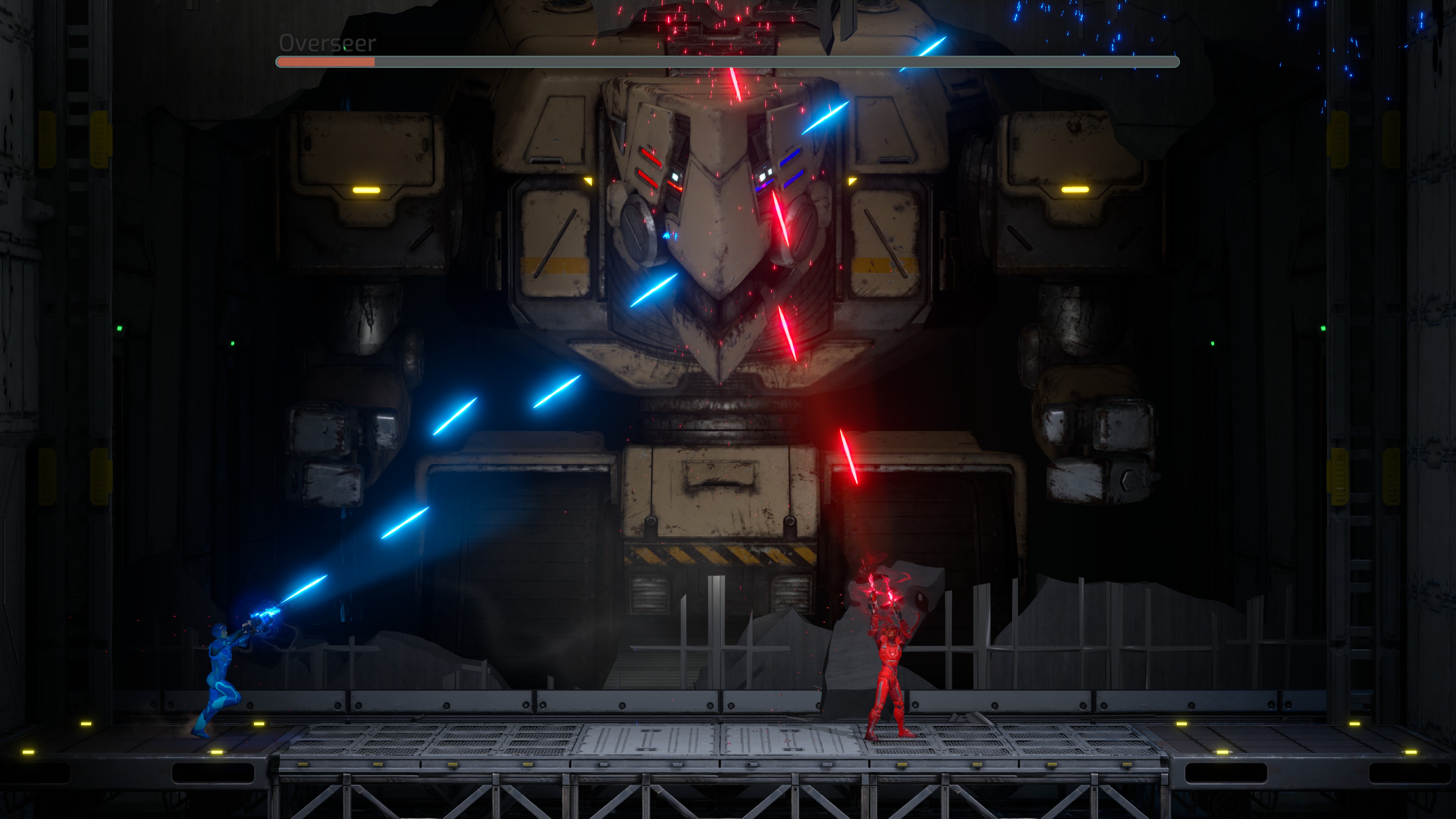
There are benches scattered around the stories where Mio and Zoe can have a quick rest and check in with each other. Some brief bonding before the next madcap misadventure. It's very twee, but you'd better believe my co-op buddy and I made sure to stop at each of them, hitting all those heart-to-hearts. They're brief palette cleansers, before you hop back into the lunacy.
I confess that I did consider skipping some of the cutscenes, though—at least the ones where nothing exciting was happening. Mio and Zoe aren't the most interesting of authors, and the story of their blossoming friendship isn't exactly novel. You'll see all the beats coming a mile away. Also, I wish the game would just once acknowledge that they are terrible writers—their stories are a blast to play through, but you couldn't pay me to read them.
Co-op cocktail
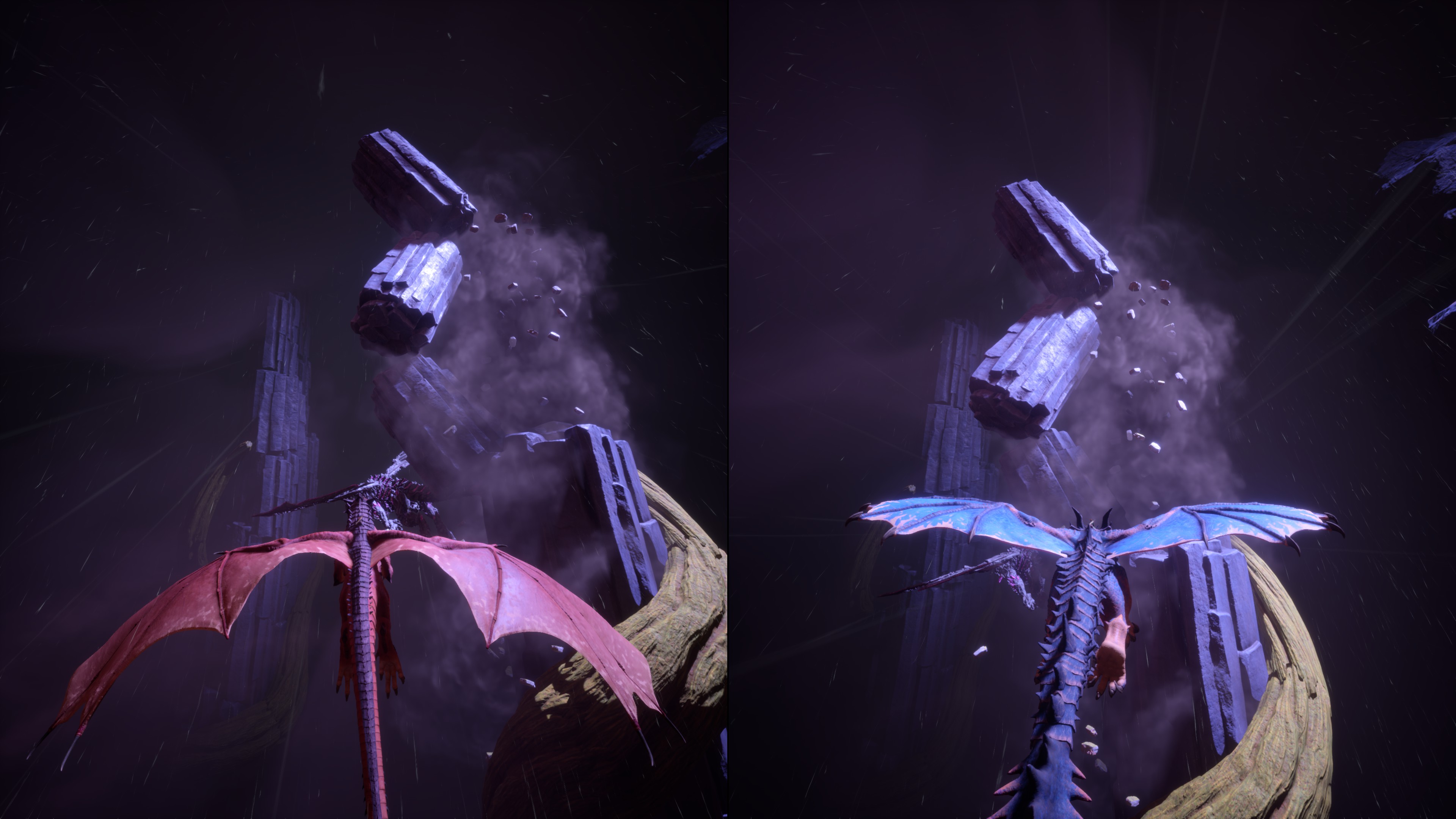
Ultimately it's an excuse to throw all sorts of world-hopping, reality-flipping, genre-switching shenanigans into the mix. Each chapter is dedicated to one of the buddies, so either sci-fi or fantasy, but they're all from different stories, meaning that every chapter introduces new mechanics, rules and themes. And within these chapters you can find side stories—mini-levels inspired by Mio and Zoe's short stories, which Hazelight smartly places in the other writer's worlds, switching things up with a short detour to another genre.
This lets Hazelight pull off a convincing illusion that this is a game devoid of repetition.
This lets Hazelight pull off a convincing illusion that this is a game devoid of repetition. Just a cavalcade of endless surprises and new distractions. The reality is that you'll tread over the same ground quite a bit, but there are frequent tweaks and wrinkles, and every activity is shuffled and reconfigured to such a degree that the illusion might as well be real.
Where there is repetition, it stems from user-friendliness rather than a lack of ideas. There need to be some consistent mechanics and concepts running through the game—they keep the brisk rhythm from becoming discordant. Even when it is spitting out a barrage of new twists, you'll never be clueless for long. It's always fairly obvious what you need to do—or at least how you can engage with the world.
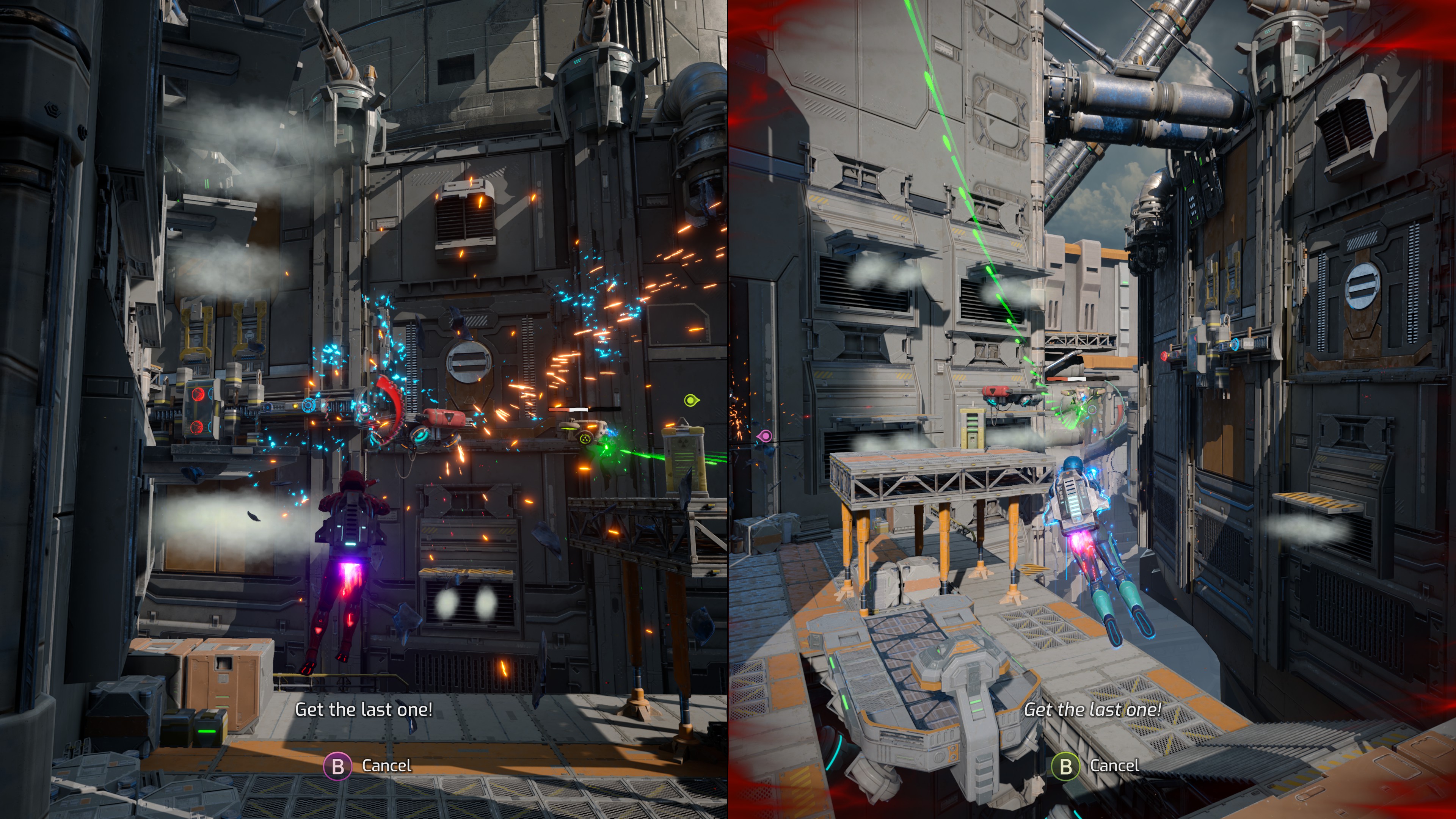
This is not to say there's an absence of conundrums. Indeed, there are puzzles scattered throughout the adventure, ranging from very basic rhythm games to physics teasers. These almost always lean into the game's cooperative nature—like Mio transforming her little robot buddies into a boat to ferry Zoe's sentient robo-ball across a series of water-based puzzles—elevating them well beyond their simplicity. Somehow, basic cause and effect feels like magic in a co-op game. "If I stand here and do this, you'll be able to go over here and do that! It's a miracle!" They aren't really obstacles; they're excuses for teamwork. And, occasionally, mischief.
Hazelight—I'm sure very deliberately—included a whole bunch of ways to troll our buddies, including commanding a giant plant to eat them, or letting them plummet to their death by taking your hand off a button. I particularly enjoyed locking my partner-in-crime in a jail cell. He deserved it. You'll also find mini-games hidden away, which serve no purpose other than to get you cooperating and competing. Split Fiction always wants you to do things together.
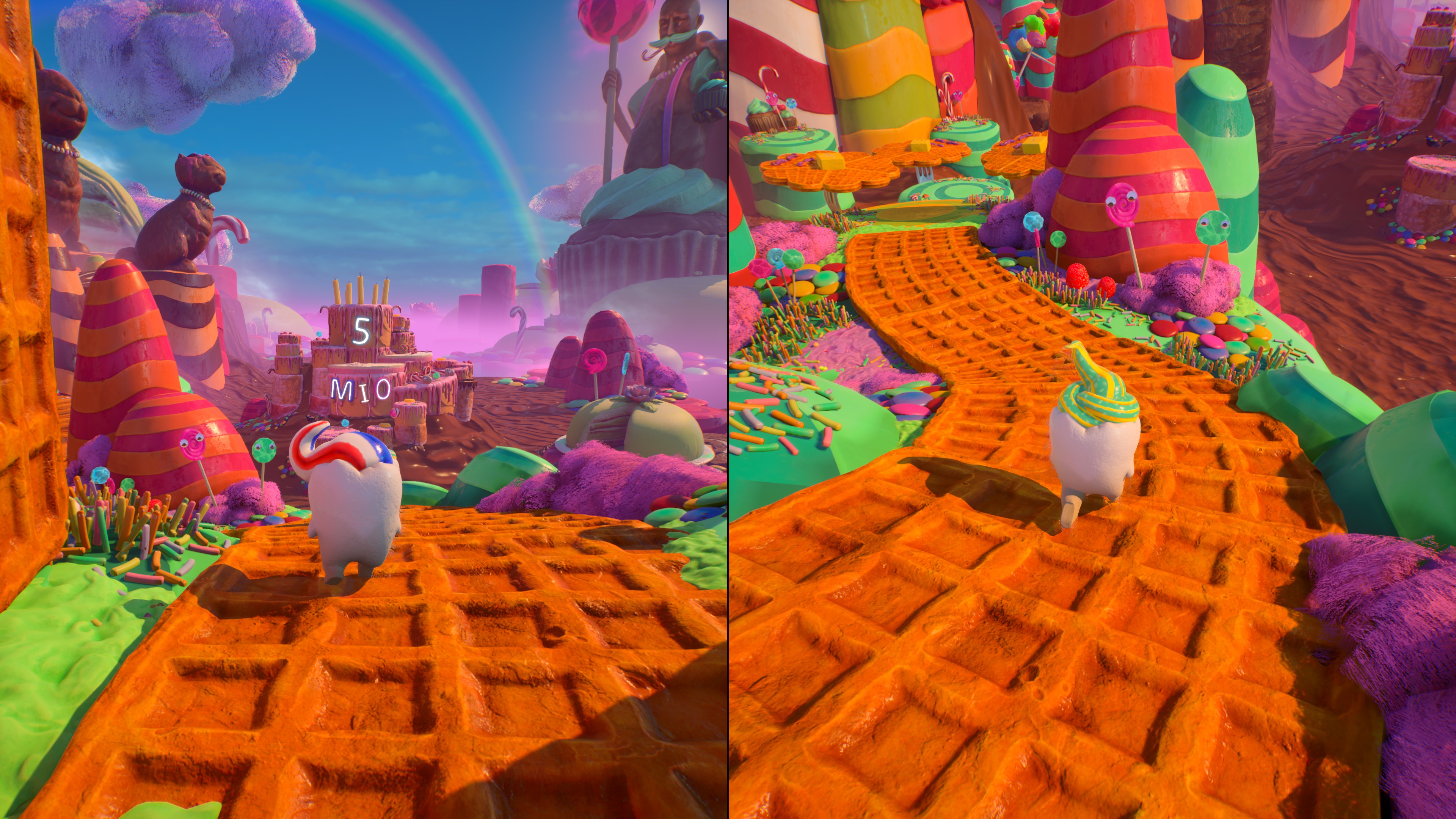
You'll always see what your partner is doing, too. While I started playing in local co-op, I was unable to get my buddy—a middle-aged dad of two, with a real job—to commit to a 15-hour play session, so we played the second half online. Even then, it was in splitscreen. The only time this vanishes is during activities where you're always going to be right next to each other, and that transition is usually done in an extremely striking way at just the right moment.
This makes it a lot easier when you're working together but not seeing the conundrum from the same perspective, since you can make sense of the puzzle by checking your partner's screen. Sometimes, though, you can't spare a glance over at what your pal's doing, which is why my neighbours got to enjoy two men loudly shouting things like "UP! NO, TO THE LEFT! DOWN, NOW, DOWN!" at 12 am last Saturday.
Dynamic duo

Split Fiction's dedication to variety extends to the differences between the characters, too, with each chapter giving them new, distinct powers. In the first chapter—a cheesy cyber ninja yarn about unpaid parking tickets—Mio dashes around with swords, slicing and dicing, while Zoe has a whip that can grab objects. Both are central to smashing the chapter's challenges, and often need to be used in tandem, but the rules and mechanics governing them are unique.
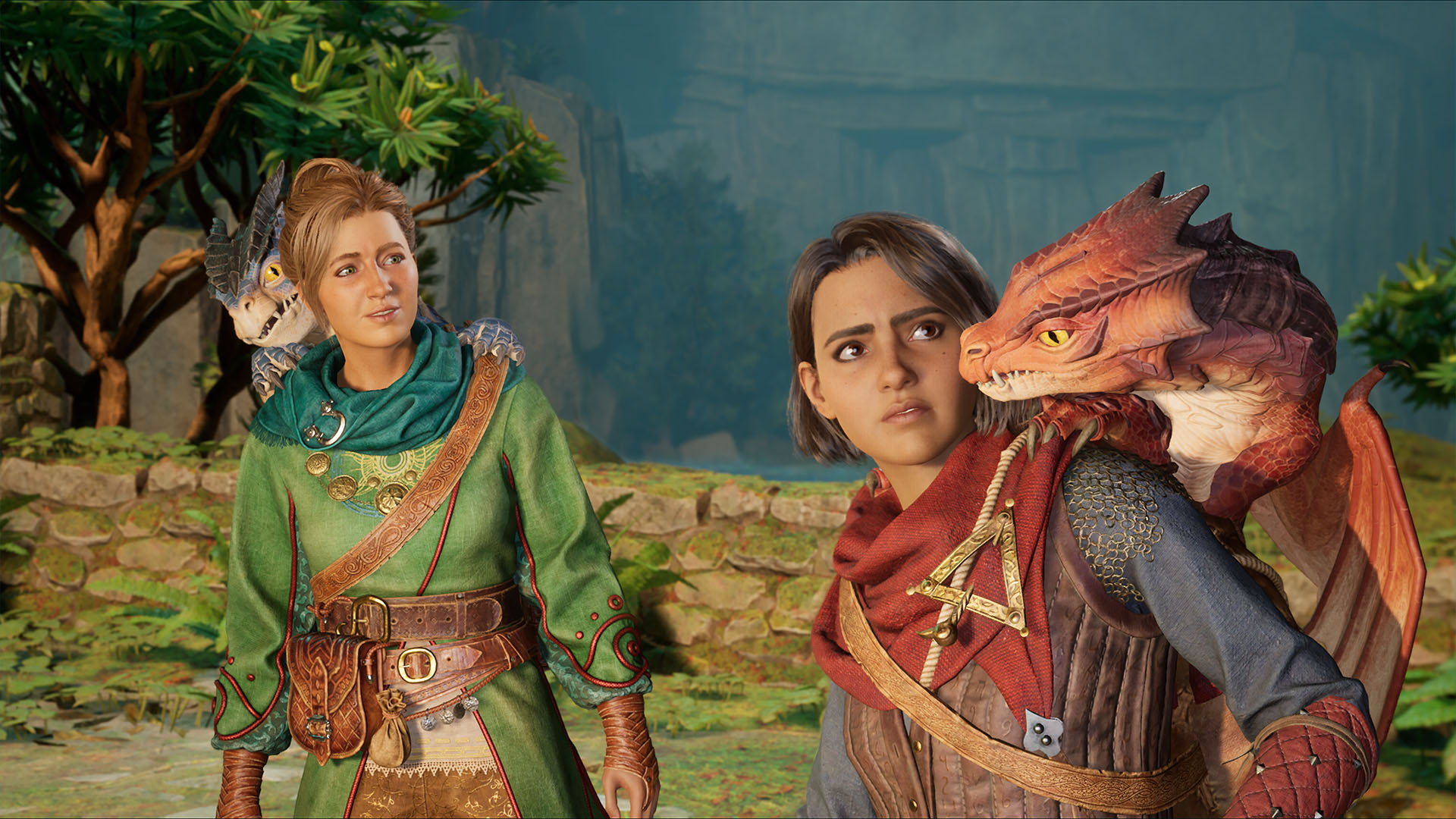
To make it easier to play with a buddy, Split Fiction comes with a Friends Pass. Like It Takes Two's pass, this allows you to play with a pal even if they don't own the game. You just need one copy between the two of you. Even better, this time it's crossplay, so as long as your mate has an Xbox Series X/S, PlayStation 5 or PC, you'll be able to play together.
In a later chapter, we got to raise a pair of baby dragons. At each stage of their life, the dragons unlock new, more powerful abilities. Mio's dragon can spit acid and gets to fly first, which I'm convinced means she got the best dragon. That said, it was hard to ignore the whoops of delight coming from my friend, who was rolling all around the place and gleefully smashing into things with Zoe's dragon.
There's no time for anything to out stay its welcome, so even when there's a dud, and there are a few, it never sticks around for so long that it leaves a bad smell. This economical use of time blesses even the simplest of activities with a freshness that keeps them entertaining.
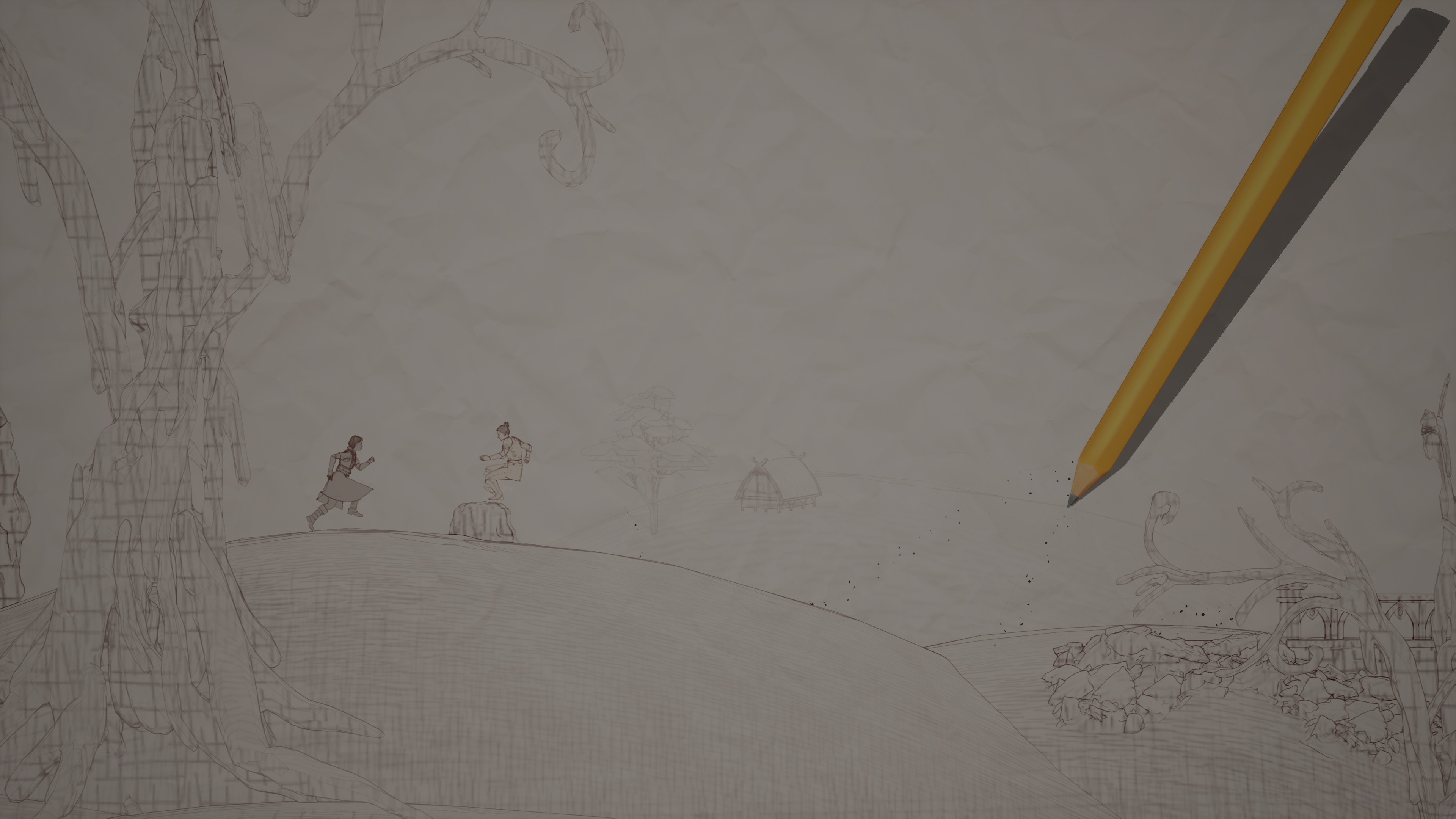
A section where I controlled a drone that my friend was hanging from—floating him above, below and between lasers—was tense as hell and genuinely fun, but would have absolutely had diminishing returns if I'd needed to do it 10 times, or if the section was stretched out to five minutes instead of two. It came out of the blue, gave us something new to do, and then got out of the way.
Hazelight also clearly knows how to make a memorable scene.
It's genuinely impressive how perfectly Hazelight has timed each section—just enough room to generate some laughs and anecdotes, a wee bit of tension, a dash of risk, and then it's off to a jetpack chase, or a boss fight or a physics puzzle. This is not to say that everything is over in a flash. It's more that every section is as long and full-on as it needs to be—though there's absolutely a tendency towards brevity.
Some ugly 2.5D platforming sections aside, Hazelight also clearly knows how to make a memorable scene, and it loves a good set piece sequence. Free-falling from a drop ship into a secret facility, spelunking through the innards of an unfriendly dragon, leaping across flying cars on a sci-fi highway—the backdrops and settings do a great deal of heavy lifting, and even when little is really being asked of you, it still feels thrilling and high-stakes.

While I reckon that a lot of parts of Split Fiction, in isolation, wouldn't necessarily stand out, the way it's been constructed elevates the whole. And I don't want to suggest that there aren't some genuinely brilliant individual moments. A section where you're working together while gravity appears to be flipped for just one of you proved to be a real trip, and I had a hoot during my short sports career, tossing an explosive ball to my buddy while screaming.
Then there are all the times the game plays with perspective in weird and fascinating ways. Just as Split Fiction keeps throwing new activities at you, it just as frequently changes how it presents those activities, altering the screen's layout on the fly and forcing you to adapt to a different way of thinking. It's another way Hazelight keeps things exciting and engaging—leaving your brain perpetually vibrating.
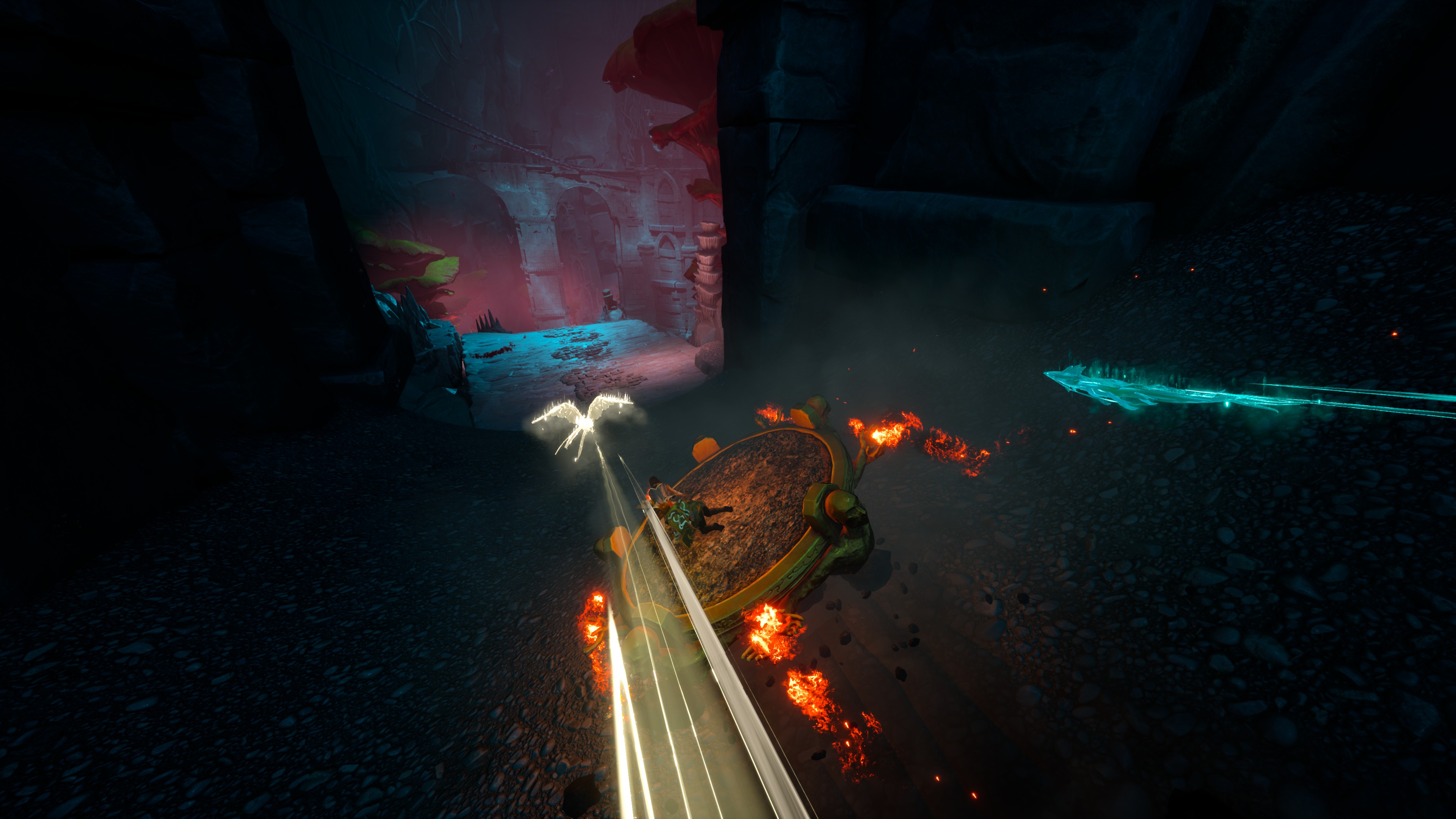
This is all leading up to an exceptional final chapter. Crikey. I will show some restraint and not give anything away, but it's probably the raddest thing I've ever seen in a co-op game, building on everything Split Fiction did in the previous 14 hours, and then throwing in some new mind-fucks for good measure. This has become a bit of a theme, but let's just say there was a lot of yelling.
It's hard to imagine another game cramming so many surprises and script-flips into a single 15-hour romp, but I thought something similar when I played It Takes Two. Clearly Hazelight isn't done trying to push how much it can keep us on our toes. While these two stand out as the studio's most similar games, Split Fiction is absolutely trying to aim higher. More intense, more variety, more flash and spectacle. And it's paid off. This is the studio's best game—though I'll always carry a torch for A Way Out—and one of the greatest co-op games around.
]]>Sometimes, magical things happen when games studios go outside of their wheelhouse. Without Creative Assembly getting experimental, we wouldn't have the terrifying Alien Isolation. And with Rusty Rabbit, renowned visual novel studio Nitro Plus is branching out in an unusual direction, seemingly blending its knack for storytelling with a cute 2D mascot platformer. One starring the (Japanese) voice of Yakuza's Kazuma Kiryu as its lackadaisical lagomorph hero, Rusty, who you can hear in the demo on Steam now.
What we're looking at here feels a bit like a mash-up of Steamworld Dig and a metroidvania with a heavy narrative focus, at least judging by the (tragically short) demo. Rusty is a middle-aged, carrot-cigar-smoking scavenger, piloting his power suit through the ruins left behind by now-extinct humans. He seems a likeable sort—world-weary but friendly, wistful, and ready to throw down for anyone in trouble. Kiryu in fuzzy bunny form, pretty much.
Much of the demo's playtime is dedicated to basic tutorial stuff, giving players a first look at Rusty's basic movement tech, including teases of future abilities like jump-jetting and a handy grappling hook, before taking them away to focus on the basics. There's some satisfying Mega Man X-like wall grabbing and a major focus on tunnelling through soft blocks of scrap for XP, which can be poured into an intimidatingly large grid of perks. The blocks sometimes contain loot, which can presumably be traded or used in the full game, although we don't get the chance to do it here.
The demo does mention that some items can be shared with other bunnies at the diner or donated to the church; two locations that we don't get to see yet—intriguing hints at what could potentially be quite complex, but it's hard to get a sense for the game's true scope right now. One thing that is for certain is that Nitro Plus hasn't forgotten its roots as a visual novel studio, and the game often segues into full screens of (narrated) prose and illustrations. The script seems fun so far, penned by Gen Urobuchi, author of genre-subverting anime hit Madoka Magica and deeply transgressive horror classic VN Song of Saya.
While I doubt there's going to be anything here that would forever traumatize a child (or adult, for that matter—Song of Saya goes hard), there's just enough edge to the writing here that I wouldn't completely write off the possibility of tragic character deaths. Urobuchi has earned the nickname 'the butcher' in some circles, after all. But even if everything remains upbeat and fluffy, I'm still very curious to see how the full game pans out, given how many brief glimpses at game mechanics the demo gave me.
Despite the game coming to Switch as well, the PC version is no slouch graphically. If you've got the hardware for it (and it can make a 4090 sweat at max settings), the combination of Lumen ray-tracing and lush fur rendering makes for a surprisingly handsome game, and some adorably squishy looking bunnies. It's a surprisingly polished product, standing at interesting odds with Nitro Plus' other upcoming action title, the Armored Core/BLAME!-inspired souls-like Dolls Nest, which also has a demo on Steam right now.
]]>Announced in October 2024, Pathologic 3 promises to blend the notorious weirdness of the Pathologic series with a new twist: Time travel, enabling players to "revisit key events and alter them" in hopes that things will turn out slightly less awful than they did the first time around. We still don't have a release date, although it's slated to be out in 2025, but we'll soon be able to get a taste of what's coming in Pathologic 3: Quarantine, a free prologue chapter that's set to arrive in March.
Pathologic 3: Quarantine follows the tale of Daniil Dankovsky, a doctor from the capital who travels to a distant small town in search of immortality. This irritates his superiors, who take him to task for his presumed missteps, but did he really do (or not do) the things he's accused of? And if he did (or did not), can he go back in time to change his choices and correct his mistakes?
Normally, I would say no, you can't go back in time so you might as well learn to live with it, but this is Pathologic, so probably a little bit of chronological hopscotch is in the cards. Your task sounds grim regardless: You'll have to examine and diagnose patients to fight the Sand Plague, but also dig deeper into their lives "to find out the unpleasant truths they may hide." Is that relevant to a medical diagnosis? Again, in Pathologic, I'm going to say probably yes.
Courtesy of a recently posted developer's blog, here's a closer look at some Pathologic 3 gameplay—note that it does have some "spoilers about gameplay mechanics," so if you really want to go into it cold, maybe give it a pass.
Pathologic 3: Quarantine is set to come out on March 17, and as mentioned, it's free. You can snag it from Steam.

2025 games: This year's upcoming releases
Best PC games: Our all-time favorites
Free PC games: Freebie fest
Best FPS games: Finest gunplay
Best RPGs: Grand adventures
Best co-op games: Better together
Lost Records' Velvet Cove isn't quite the now-iconic locale of Arcadia Bay. Set in a small town in the Upper Peninsula of Michigan (on that smaller, northernmost peninsula of Keweenaw County) it is essentially nowhere. And that is what that part of the world feels like, sure, but Velvet Cove needs to exist in this anywhere-and-nowhere state to emphasize the game's relationship to time.
At the end of the game's first part (Part 2 releases April 15), there's no time travel in Lost Records. There's no telepathy either; just some magic, as of now still largely undefined. Rather, the past is a constructed narration from the women in the present day of 2022, remembering their 16th summer in '95. The one before they graduated. Before Swann moved away. Before they promised to never speak of it. Before…
At home I pick up the objects and rotate them, but there's something different about these. Trolls, PEZ, VHS Rentals in chunky plastic boxes, Pogs, serial paperbacks, diaries, marbles, pads, pin screens, bubbly plastic pencil cases, Newton's Pendulums, a CD binder, sci-fi show magazines, a sticker covered alarm clock, and a Tamagotchi I can feed, play, and clean with each button. Also: That story you wrote, ripped out of a journal hidden with the romance novel you kept under the bed. These aren't clues. There are no puzzles to solve. Each is a rendered artifact—no, a relic—of girlhood.
Swann, an outcast who at this point prefers to go unnoticed, takes her camcorder out to the trail and records the animals. The ruins. Comes home and films her cat around the bedroom. The game splices the tape together, lets me edit the footage. I make a film, a moving diary that looks like the grainy spool that spun in Swann's hands a few seconds at a time. And when I watch it all back through the grain it feels like I held that tape in my own hands, not something rendered on my computer. Then one day she's noticed, befriended by three girls who also don't fit in for reasons they never really understood.
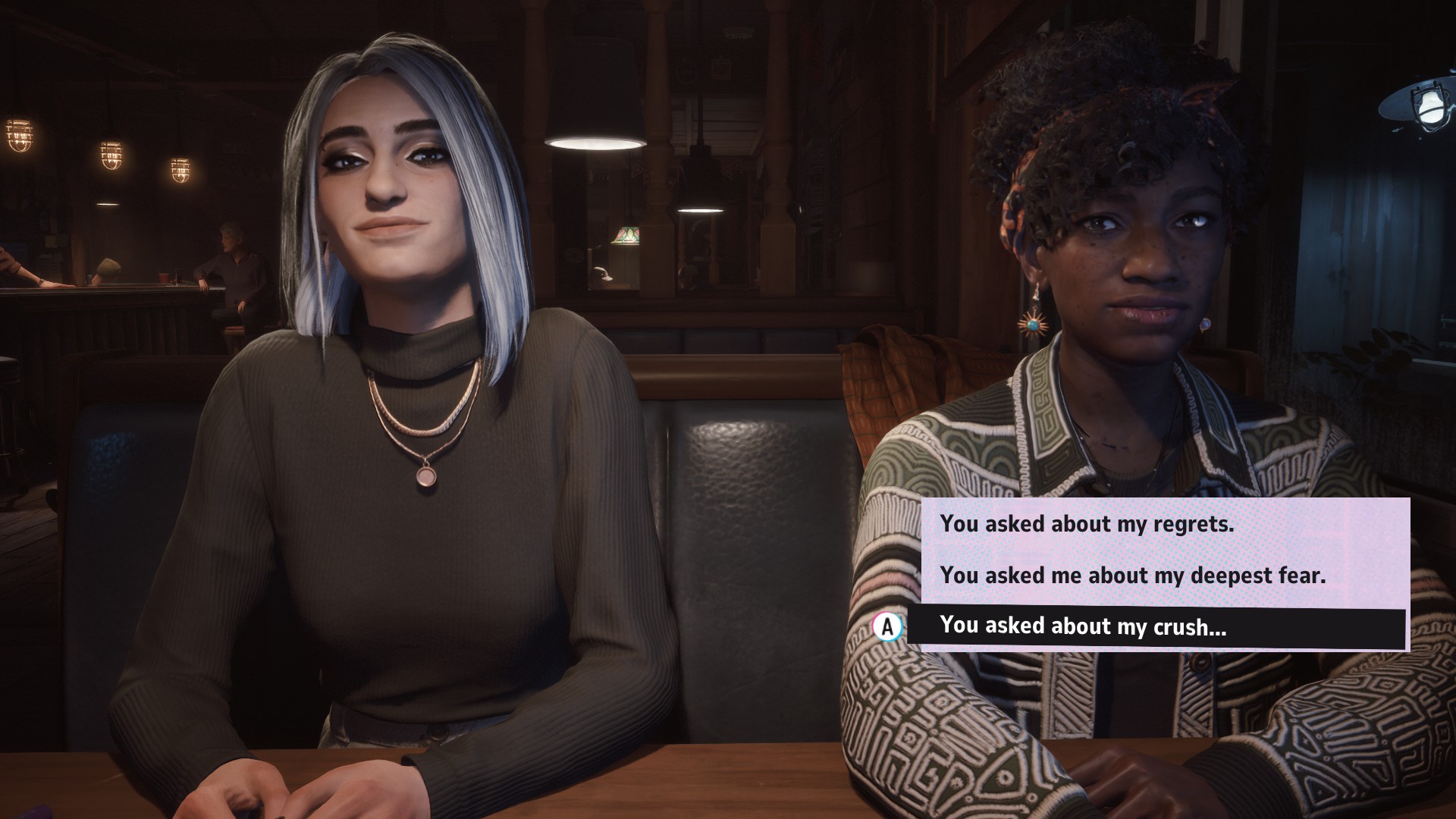
There are moments where time jumps 27 years between the bar and Velvet Cove within a single scene, others when days play out with commentary echoing from above. Through this ongoing conversation, choices are made. Swann remembers who it was she called on the phone 27 years ago, what they all named that hideout you found and decorated down by the lake. And if these nostalgic memories of such an idealized moment are wrong, well there's those tapes Swann has, the ones you have been recording this whole time. Right?
Lost Records is nostalgic, but it is also concerned with nostalgia and the fuzzy, lossy memory making of queer childhood—at least at this halfway point in its narrative. The past is certainly romanticized, but it feels eerie. The light is too pretty, the adventures too tropey. They even say as much, referencing Blair Witch as Swann helplessly films while lost in the woods one night. But maybe I just desire a critique of '90s nostalgia right now.
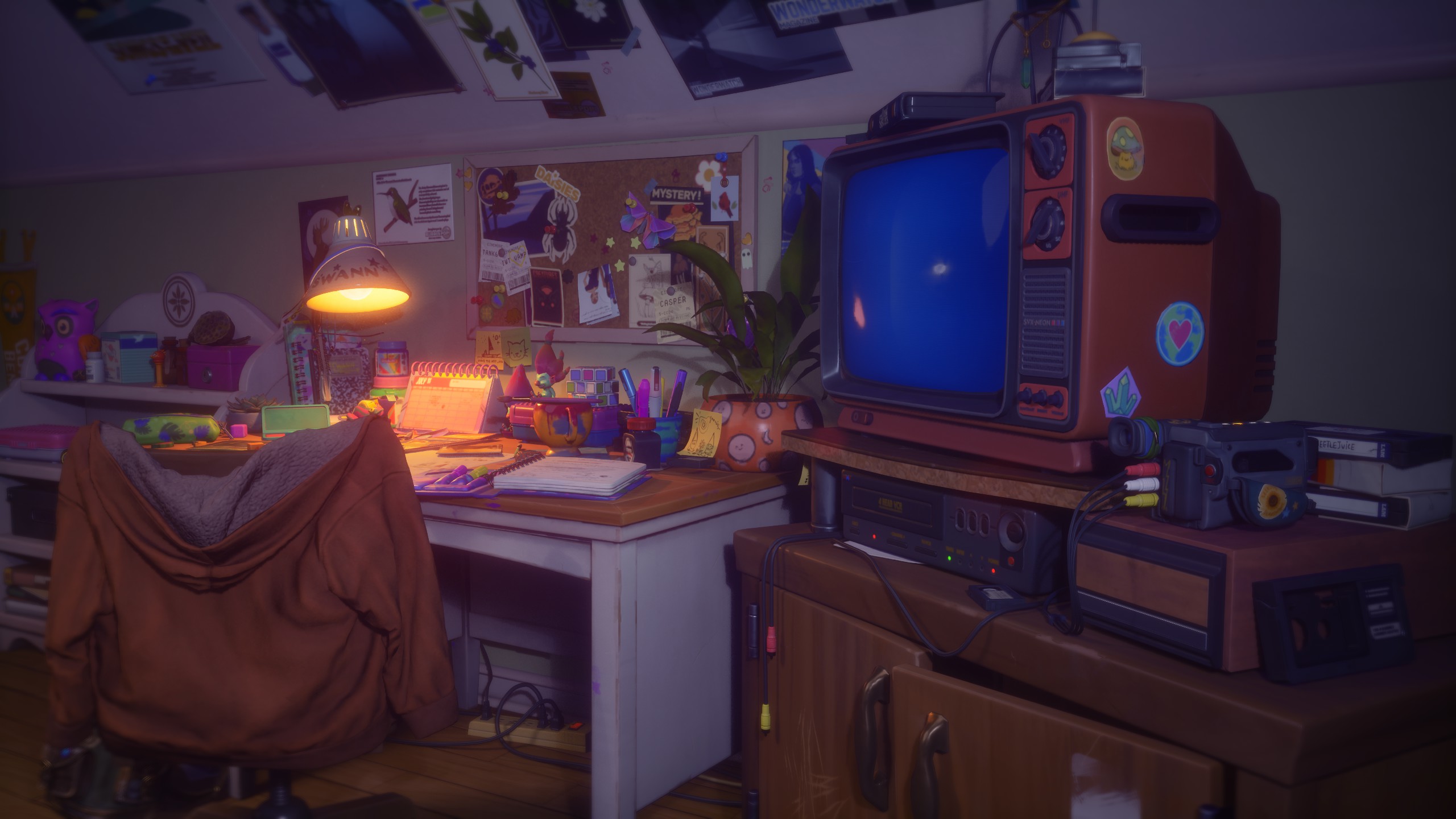
Lost Records is releasing under similar circumstances to Life is Strange in 2015. I know screenshots of this review might circulate on X like other recent writing on games that simply contain queer people. And I know a lot of those people are nostalgic for the games they played in their romanticized '90s childhood they feel were taken away from them.
It is not a purely affirming mirror. Romanticized, but not idealized.
In her essay "Let's Play Life," Liz Ryerson observes the role of '90s gaming nostalgia in the contemporary conservative backlash, retvrn rhetoric capitalizing on an idealized past that looks "a lot like those kitschy Thomas Kinkade style tableaus of consumer childhood nostalgia done by artist Rachid Lotf." These men were surrounded by mirrors their whole lives—childhood stories and a mediasphere growing up around them constantly reflecting back their own stories. They never had to look through a window at a story that might offer something unfamiliar, unknowable to them,, and now AI images can endlessly regurgitate rose colored vomit back to them. Those boys probably broke a few of those windows with baseballs, like what happens in the movies back then, when kids could wander the neighborhood and play pick up games. Not like today, on Xbox Live or Battle Net.
But Lost Records is for the girls who know what finding Bikini Kill or Team Dresch or Siouxsie and the Banshees after all those years feels like. Who made a religion of Rocky Horror and found out there's other people that don't fit in like them. It's also an interactive game with clumsy dialogue mechanics that we've seen done better in the decade since.
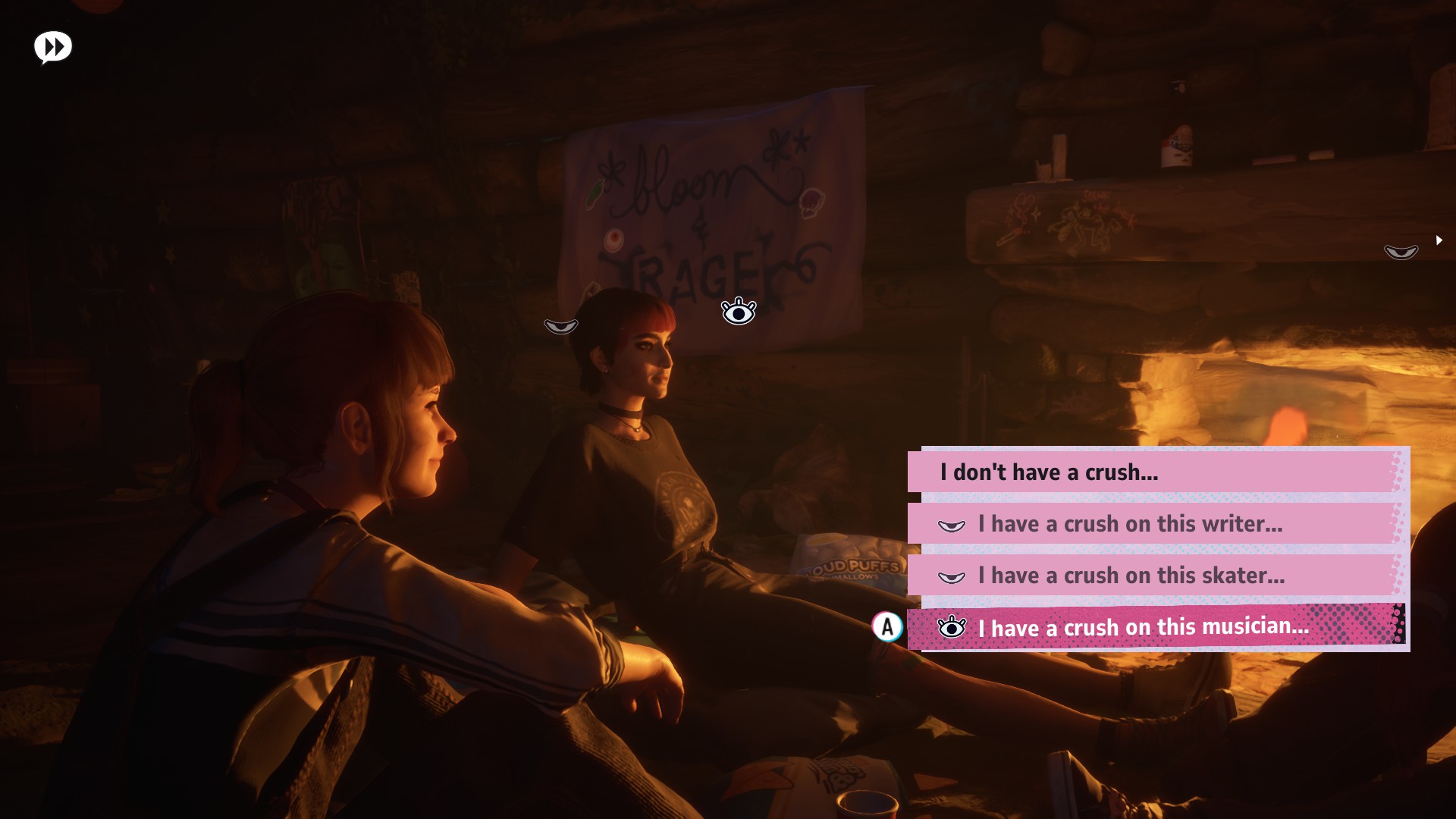
While it's easy to say Lost Records is a Stand By Me for girls, it is not creating quite the same fantasy. It is not a purely affirming mirror. Romanticized, but not idealized. Swann's called a lesbo, fatso, freak. She makes all these tapes of her cats and her toys because she's alone, and when she has friends she makes videos of them because she never found those mirrors to her girlhood at the Movie Palace.
But then, Keweenaw County. Velvet Cove. It's cool that this is a game about 40 year old women talking over drinks as much as it is cool that this is a game about teenage dykes discovering riot grrrl and each other and themselves all at once. But Velvet Cove is a movie rental store with an ice cream stand, a dilapidated playground under a conspicuously large underpass, Nora's garage, a trail through the woods near the lake, your bedroom, and this bar we're sitting in today remembering it all. All connected by roads and woods that you never see, just the water tower on the horizon.
What Lost Records: Bloom and Rage has set up is deeply compelling, though flawed.
Perhaps that is also a consequence of memory, though, these isolated moments and spaces, but I don't totally buy that we're in some definitive version of the past yet. There are no other kids. Hardly a mention of school. I can't for the life of me figure out why they would put on a show in a parking lot with no other kids their age around. Where are all the tapes Swann and I have been recording this whole time?
Maybe that's just been lost to memory. Maybe Part 2 will answer questions I don't even have yet. What Lost Records: Bloom and Rage has set up is deeply compelling, though flawed. PC Gamer's original review of Life is Strange strikes a similar chord: "unfocused but earnest." With such earnestness comes some amount of vulnerability—seeing beneath the armor of goth makeup, piercings, and loud music. Lost Records knows the armor we wore. Might still wear, too. That girlhood is a thing we all failed in our own way. And that the perfect needle drop can make up for a clumsy confession.
]]>Normally I feel about brand crossovers the same way I feel about poutine. Gravy and chips are both wonderful things when eaten separately, but combine them and you end up with a soggy mush that loses all sense of texture. But I'm willing to give Dave the Diver's latest Like a Dragon DLC crossover a pass, because the story behind it is really rather sweet. The latest DLC for Mintrocket's wildly successful aquatic adventure brings Like a Dragon's Ichiban and several other characters and minigames from the series into Dave the Diver.
I'll belly flop into the details shortly. But I was mainly struck by the words of Jaeho Hwang, Dave the Diver's director, when introducing the DLC on the PlayStation blog. "As some of you may already know, I’ve often cited the Like a Dragon series as one of my greatest gaming inspirations," he writes. "From the original 2005 release to the latest RPG iterations, I’ve been captivated by the rich character development and genre-defying gameplay. It’s been a dream of mine to invite these iconic characters into Dave’s world, and now, that dream is becoming a reality."
Now, taken on its own, this could all be interpreted as superficial marketing bluster. But a cursory Google brought up a LinkedIn post in which Hwang discusses meeting Like a Dragon's head honcho Masayoshi Yokoyama. Hwang writes that he "screamed like a K-pop fanboy" when he saw Yokoyama and "got his autograph on the dialogue book of the very first game I have kept since 2005." He also reiterates that Like a Dragon is "one of the biggest" inspirations for Dave the Diver. So I think it's fair to say his enthusiasm is legit.
In short, it's all rather wholesome as brand crossovers go. The Like a Dragon DLC sees Ichiban and the Bartender from the Survive Bar taking a break at the Blue Hole, when they stumble upon a "sinister plot" that involves a dolphin-poaching syndicate, which our trusty Dave helps them unravel. The DLC adds a beat 'em up style infiltration mission where Ichiban and an ex-arms dealer called Cobra infiltrate the poachers' hideout, while you can also "cheer along with Ichiban's unforgettable karaoke performances" and hire various other Like a Dragon characters to work in your restaurant as staff.
Ichiban will arrive in Dave the Diver's restaurant at some point in April. This isn't the first time Dave has crossed paths with other video game characters. Dave himself turned up in Balatro last year, while before that some spooky cultists from Dredge paid a surprise visit to the Blue Hole. Yet even without all this brand based gubbins, Dave the Diver is still an excellent time, with Chris Livingston calling it "the biggest surprise of 2023 and hands-down my favorite game of the year so far" in his review.

2025 games: This year's upcoming releases
Best PC games: Our all-time favorites
Free PC games: Freebie fest
Best FPS games: Finest gunplay
Best RPGs: Grand adventures
Best co-op games: Better together
It ain't Elden Ring 2, that's for sure, but a much simpler and more streamlined experience: And as a spinoff, the asking price is an unexpectedly reasonable $40 (you know Bandai Namco could've charged whatever it wanted for this). But that may not be the only price you end up paying. Elden Ring Neightreign's release date came with a Steam page, which initially contained the following at the bottom of the game's description:
"Additional DLC—Additional playable characters and bosses."
That line has now been removed, but seems a fairly straightforward slip-up and confirmation that there will be more Elden Ring Neightreign to come.
I'm probably going to sound a bit fanboy here, but this can only be good news. FromSoftware's track record with DLC and expansions is frankly outstanding, and over time the studio has only become more ambitious: My personal favourite remains Bloodborne's The Old Hunters, but there's no denying that Elden Ring's own Shadow of the Erdtree was truly epic in scope and a fitting capstone on a magnificent game.
Admittedly this description makes Nightreign's future DLC sound much smaller in scope than that, and no doubt it will be, but in a game constructed around character builds and boss fights, don't expect FromSoftware to just be content knocking out the usual, but using the DLC to invert and change-up the vanilla experience.
Elden Ring Nightreign arrives on May 30, and we already know a lot about it. "Nightreign will be an interesting litmus test of why people come to Souls games," reckons Morgan. "If it's all about swinging big swords and dodge-rolling away from impossibly hard bosses, Nightreign is gonna be a feast. But if it's From's quieter moments that stick with you—exchanges with weird NPCs, taking careful steps deeper into a vast fortress, contemplating The Lands Between's cryptic questlines—well, Nightreign ain't got time for any of that."
]]>"A very first look at just a few characters from the ABSURDAVERSE. Prepare to meet some new kinds of heroes (and watch them suffer). More information to come this year about the first animation projects and about our original story-driven action-comedy adventure game set in the Absurdaverse, now in development at Absurd Ventures," says the announcement post.
I'm not entirely sure what that genre is, to be frank. "Action-comedy adventure" is so broad a genre that it could be God of War (but funny), or it could be that shooter the Rick and Morty people did. Knowing Houser's past work, though, we can know that the core will be the laughs. The only thing we can reliably draw from the image is a mix of fantasy tropes and modern-day people—skeleton dude and businessman next to each other. That's about it.
For my part, those character drawings are aggressively stock-stereotype-comedy-coded. They're ridiculously generic to the point that I can tell the primary joke for every character just looking at it—annoying kid, small guy who is fit, plus-size woman, diversity stereotype woman, barbarian, obnoxious trendy guy, competent-yet-ignored woman, annoying magician/inventor. I could go on, though I'm open to being surprised by the quality of whatever comes out. I'm just not betting, based on the title and on the image, that anything innovative is going to happen with whatever the "ABSURDAVERSE" ends up being.
To be frank, this looks like an almost transparent attempt to produce from zero a mass-marketable world to sell merch about. It just tastes commercial, rather than creative. Like a webseries from 2012 that got a single overfunded season and was subsequently cancelled. Hopefully for the sake of all those people from the Immortals of Aveum studio that now work at Absurd Ventures it's better than that and I have to eat my words.
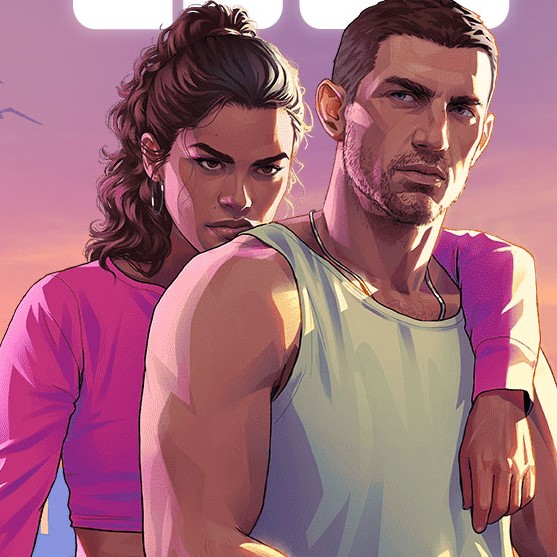
GTA 6: Everything we know
GTA 5 mods: Revved up
GTA 5 cheats: Phone it in
GTA 6 cars: The lineup
San Andreas cheats: All the codes
Techno Banter is a first-person RPG about Nill, a burly dog-headed guy, back working as the bouncer for the Green Door club after being fired from a cushy corporate security gig. Each night, he stumbles out of his shitty apartment to spend some time chatting with the locals on the streets of alt-universe Berlin before you begin your nightly battle of wills against a procession of would-be club patrons. Eye them up, assess their vibe, and let them through if they seem legit. Or try to turn them away, which initiates a multi-choice battle of banter.
For a game with no real combat (although you can throw the occasional punch if you've got the stats for it), there's a surprising amount going on with Techno Banter's battles. You've got to wear down surly clubbers' morale until they go somewhere else, usually by no-selling their verbal abuse or picking the perfect retort to their insult in timed dialogue challenges. Build up a combo of verbal hits and you can spend that energy on special attacks, either tailored to your opponent's personality type, or just hit them with a rapid-fire string of cutting remarks, most of which are pretty funny if you pick all the right options.
There's a couple light arcade minigames in there too, like dodging pointed stares or mashing buttons to maintain a steely gaze, but nothing too fancy. There's levelling and stats to give each of your verbal strengths a boost, and options to customize the club each night, find Nill new outfits, and tackle side-quests for your co-workers (like helping your bartender write a song in exchange for free drinks), before and after the night's shift. It all feels a bit Yakuza.
Having once worked as a night-shift cabbie ferrying the weirdest of people to and from pubs and clubs from dusk 'til dawn, it all feels weirdly authentic despite this being a satirical cartoon world where animal-people hang out with us regular humans like it's no big deal. There's something about the night that brings out the strangest and most memorable of people, and I'm already developing a fondness for some of the regulars here, wanting to see where their story threads go.
I've only played the first couple nights of Techno Banter, but I'm sure I'm going to see this one through to the end. Beyond the club scene comedy and drama, there's a growing secondary plot about a death cult with possible big-money corporate ties, a checkpointed upper city and political tensions brewing. I have very little idea where it's going with all of this, but I'm excited to find out. And you can now, too. Techno Banter is out now for ?11.99/$14.39, and you don't even have to tip the doorman.
]]>"A little robot digs to repair her world," reads the topline sell on Mashina's Kickstarter page. Dig, build, discover, and mend in a chill, stop-motion world." Rather than the druidic, pastoral fantasy of Judero, Mashina takes place in a green, yellow, and grey industrial moonscape, and instead of Judero's ugly-cute potato men, the world of Mashina is inhabited by greebly robot dudes of all shapes and sizes, but with many boasting the same "face" of a simple hand-drawn smiley on a blank screen.
It's giving Wall-E, both superficially?—robots making a life in the aftermath of human society?—but also in the cheerfulness and sense of hope to it all. Talha & Jack Co. say they think of it as a positive game, one about nurturing and creation in the midst of its grim surroundings.
Gameplay looks to be divided between full 3D exploration of your semi-customizable robot village on the surface of the world, with 2D, side-scrolling exploration of the underground. Looking at the excavation gameplay, Mashina reminds me a bit of Terraria, but with more focus than the beloved sandbox game?, or maybe Dave the Diver, but substitute digging and minerals for swimming and fish. There will presumably be surprises and story beats to find down below, but your basic activity is chopping through the earth, gathering minerals to upgrade your aboveground village as well as a subterranean base camp.
That has me excited because I found Judero's hack 'n slash brawling to be the weakest part of the experience compared to its exploration, writing, and vibes?—a more experimental, novel core mechanic feels like a better fit for the team's style and ambitions.
And even though Mashina is going for a whole different sort of thing from Judero, it looks like it will carry the same quirky, surreal sensibility and atmosphere I loved so much. Mashina currently has no release window, but it has already been fully funded on Kickstarter with 19 days to go. Mashina's tactile nature has led to one of the better backer rewards I've seen on one of these: One of the handmade robot figures used for the game's art, yours at the max-level ?500 donation tier.

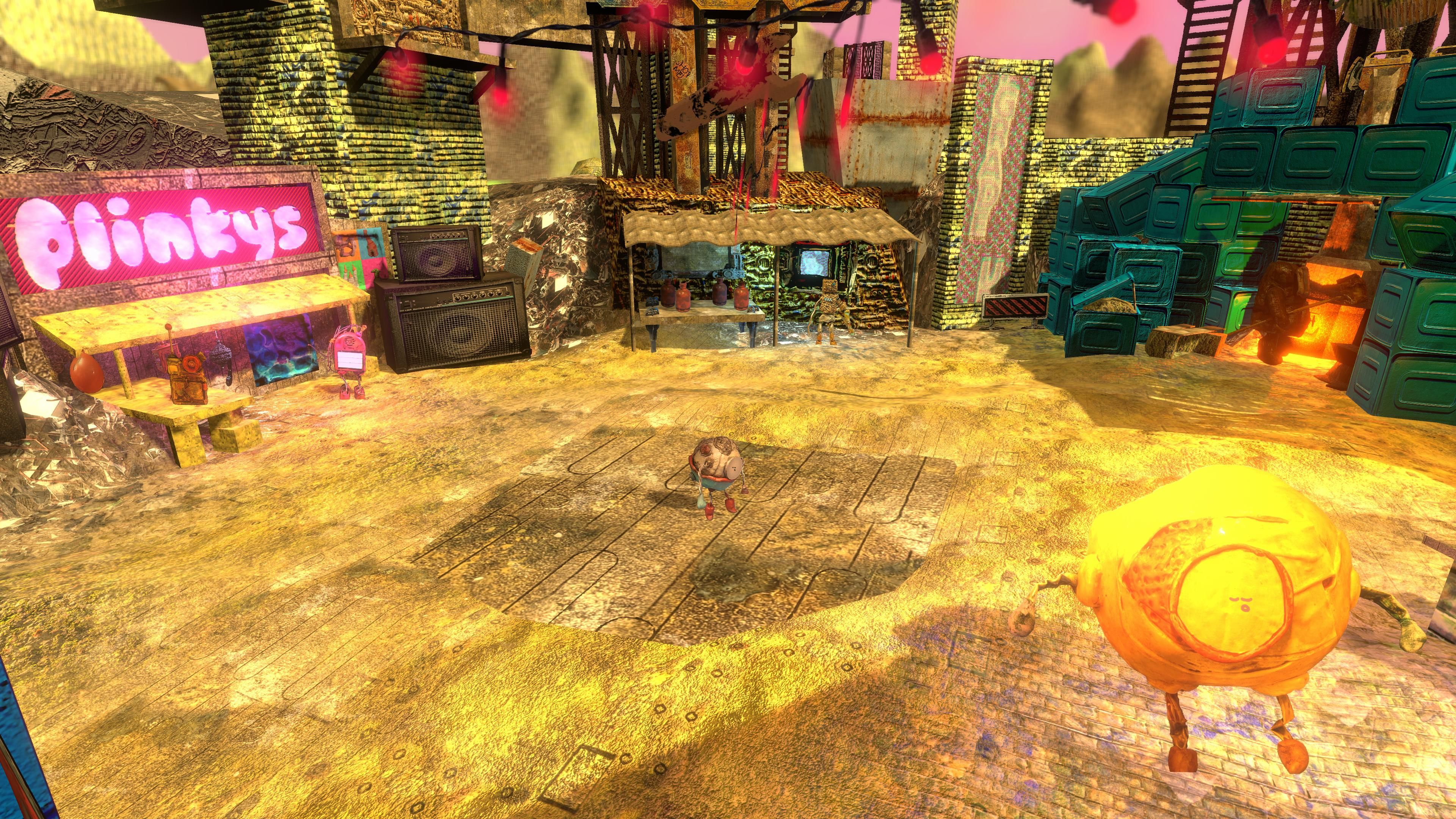
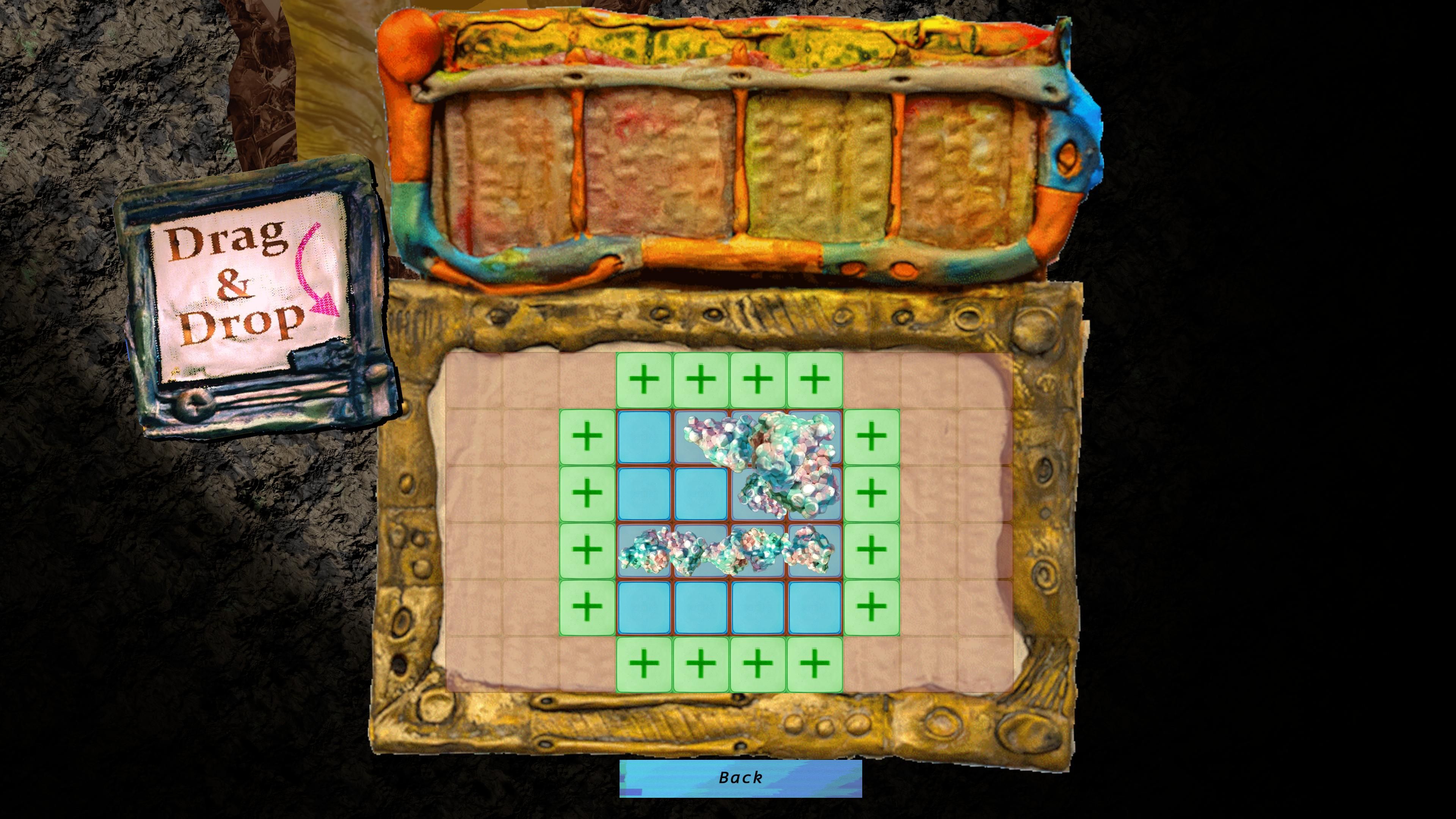
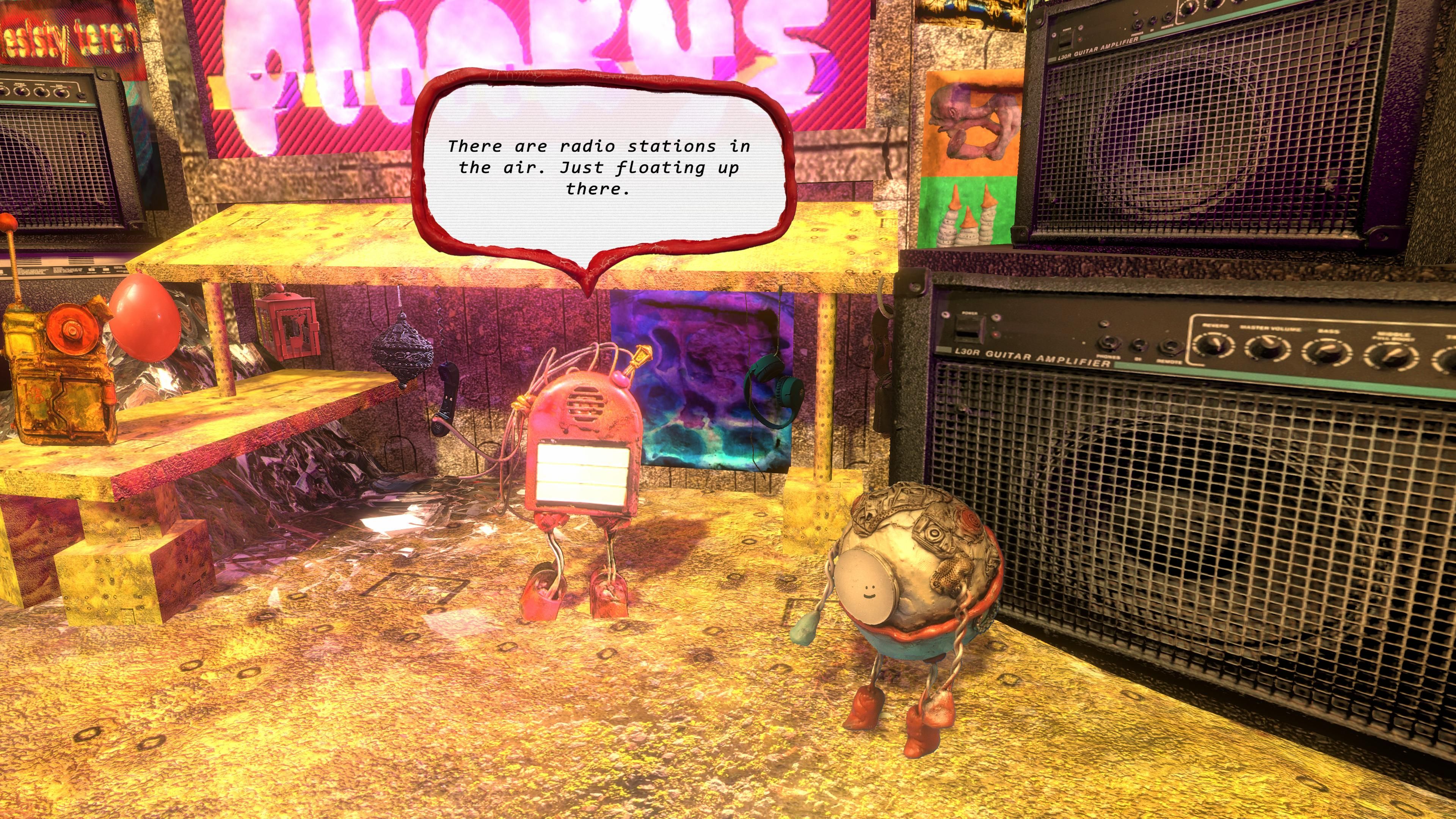

2025 games: This year's upcoming releases
Best PC games: Our all-time favorites
Free PC games: Freebie fest
Best FPS games: Finest gunplay
Best RPGs: Grand adventures
Best co-op games: Better together
This is according to former Arkane Lyon designer Julien Eveillé, who started as a QA on Dishonored 2 before joining the design team for the series' final game Dishonored: Death of the Outsider. Despite being a superb follow-up, it similarly did not have the impact both Arkane and Bethesda might have hoped for.
"It was a bit strange and weird," he says. "I think when Bethesda was looking at the numbers, they thought, OK, Skyrim sold so much. And it cost less than Dishonored 2 to make. So they were asking questions. From an executive spend standpoint, it makes sense to ask those questions of, 'Why should we keep going with you?' But we knew that we had a kind of seal-of-quality protection, making what would maybe be considered the most refined games of the whole Bethesda catalogue."
Certainly, Dishonored had a very different level of refinement when compared to Skyrim, and the rest of the Elder Scrolls series. Bethesda's RPGs also have some immersive sim qualities, being massive sandboxes where players are given a lot of leeway in terms of how they interact with the world. But where Skyrim was a wonderful, janky playground, Dishonored took a more precise approach to its chaos, with stricter rules but just as much potential for mayhem.
This reputation "kind of saved the studio," says Eveillé. But he also notes how studio director Dinga Bakaba stepped up and gave "confidence back to the upper management" following the departure of founder Raphael Colantionio, who left to create WolfEye Studios. At the time, the folks at Arkane wanted to focus on what the studio was known for, rather than chasing trends like live service games. This ended up being critical to the "future success of the studio," he reckons.
While Arkane Lyon went on to make Deathloop and is now working on Blade, its American studio, Arkane Austin, was not so lucky. It unfortunately did get saddled with a live service game, Redfall, which had a disastrous launch that ultimately culminated in the closure of the studio that gave us the phenomenal Prey.
Eveillé eventually left Arkane and, just last year, released his immersive horror game Threshold—an extremely stressful experience that will leave you fatally short of breath.
]]>But for the life of me, I could never fathom why. Why engage with a sport that can so easily kill you, regardless of how good you are at it. One that will kill half of your friends and peers even if you personally emerge from your career unscathed. When George Mallory was asked why he wanted to climb Everest, he allegedly responded "because it's there!" But back in the 1920s, Everest wasn't covered in litter and climbed by 15 millionaires a week.
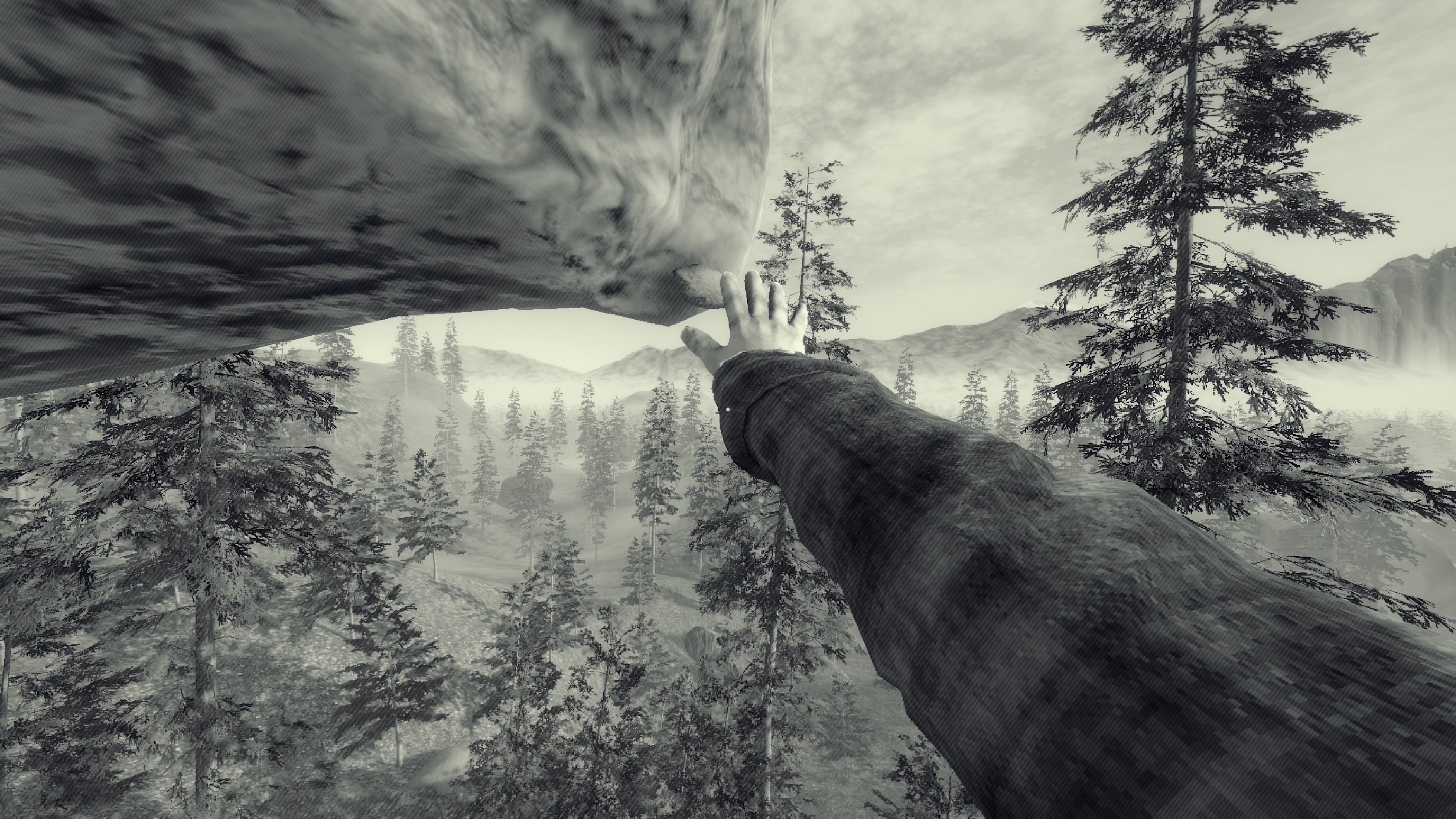
I didn't come to Peaks of Yore expecting an answer to this question. I came to it because I like climbing games as much as other mountaineering media, and this one had somehow escaped my notice. Released in 2023, this 19th-century physics adventure throws you back to the primordial days of alpinism, casting you as a tweed-wearing gentleman adventurer who has challenged themselves with ascending the 20 Fundamental Peaks of The Great Gales, a mountain range that blends the crags and valleys of the Lake District with the more precipitous peaks of the Alps.
Presented in sepia-tinged monochrome (though colour is available if you want it), Peaks of Yore starts out with the vibe of an afternoon hike. The first couple of climbs you do are simple bouldering challenges designed to introduce the basic mechanics, which involve pressing the mouse buttons to reach out alternate arms to clasp onto rock outcrops, before using the A + D keys to swing yourself up to the next handhold.
Initially, it doesn't seem like the most serious climbing simulation. There's something faintly comical about your climber's long, rubbery arms, which combined with the swinging motions make you feel more like an ape than a mountaineer. As you proceed through the first few levels, you also encounter an eccentric cast of fellow climbers, such as a pair of brothers trying to boost one-another up the side of a cliff.
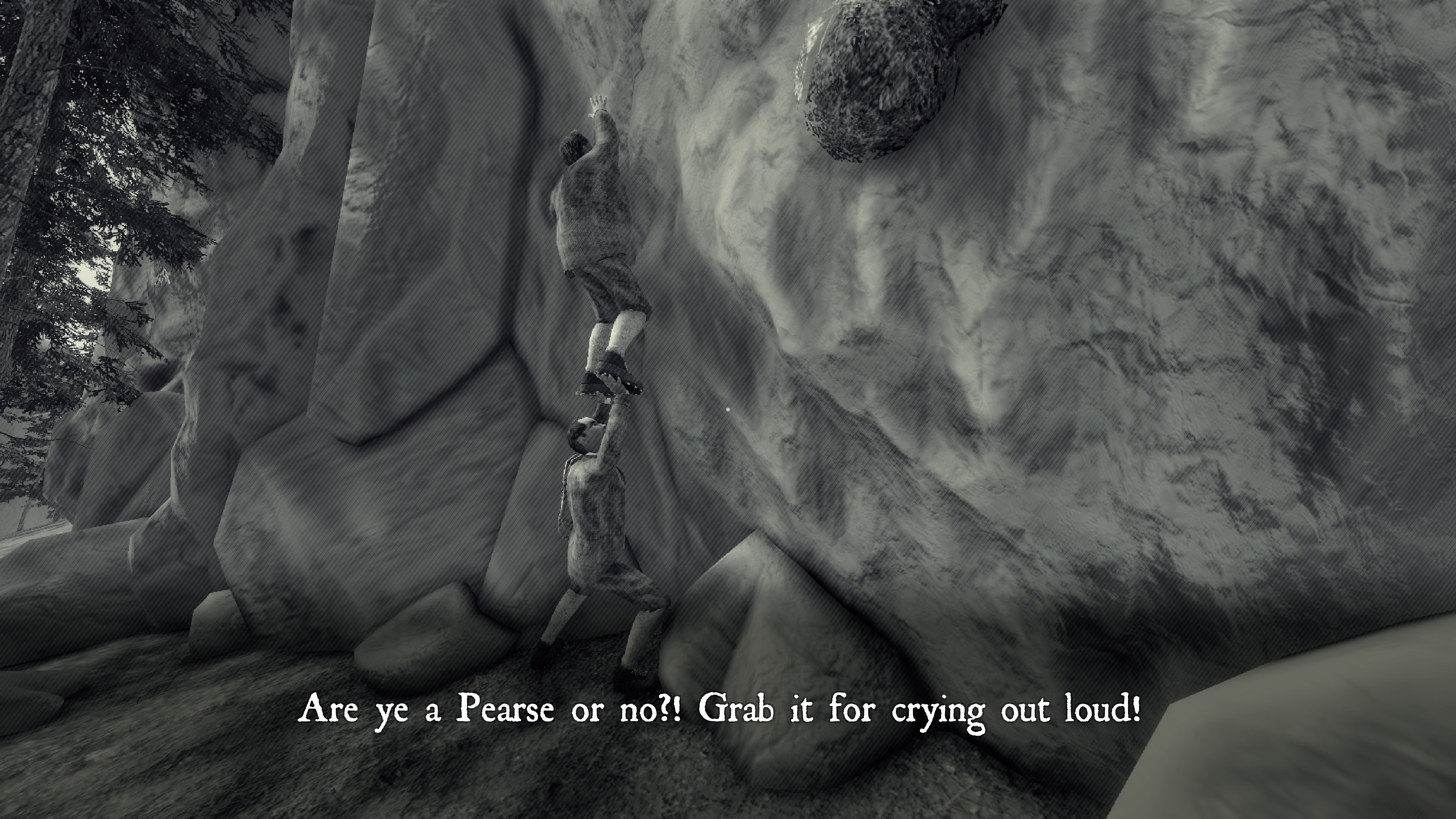
It's all a bit 'tally-ho, chaps!' and although I enjoyed the gentle humour and generally supportive nature of your fellow climbers, Peaks of Yore didn't feel particularly substantial. My feelings about the game changed quickly, however, once I reached the lighthouse. This isn't a colourful name for a peak; it's exactly what it sounds like—a looming coastal watchtower made of crumbling brick that forms the first intermediate route of the game.
Up to this point, I'd scaled all the challenges without much difficulty, monkey-swinging my way to the summit while blithely ignoring all the game's advice about ropes and pitons and whatnot. I carried on in this manner until, a third of the way up the lighthouse, I grabbed an exposed brick and it pulled clean free of the wall, sending me plummeting to the ground.
Luckily, the drop proved merely inconvenient—you can fall a good thirty feet in Peaks of Yore before starting to take damage. Nonetheless, it startled me into taking this climb more cautiously. And just as well, because the lighthouse, it transpires, is a gnarly ascend. As well as loose bricks that pull right out of the lighthouse wall, there are bricks that slide slowly out under your weight. It's also the first climb where some handholds lie beyond your character's orangutan-like reach, forcing you to leap between holds without the guarantee that the brick you grasp on the far side will hold your weight.
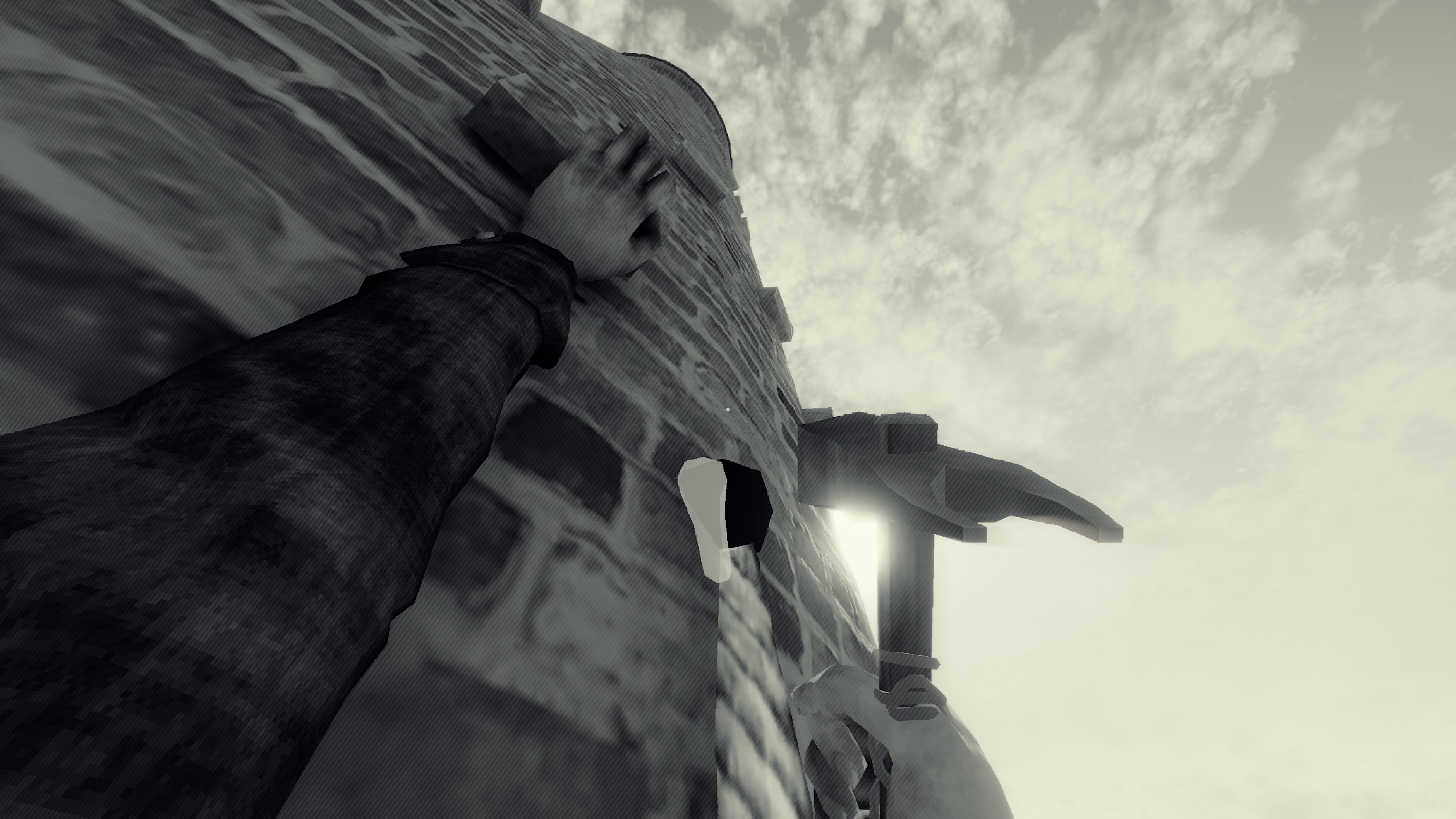
By the time I'd ascended two thirds of the lighthouse, I'd become much more measured in my climbing, testing new bricks with a quick grab to see if it slipped before committing to the move, and roping up whenever a leap presented itself. After passing a particularly tricky obstacle that involved leaping around a corner of the lighthouse to catch a brick I couldn't see, I thought I was home.
I was genuinely frightened.
And then I realised that I'd somehow slipped free of my rope.
With no way to get back to my lifeline, I had to free solo the remaining third of the lighthouse without making a single mistake. Even if I survived the fall—which seemed unlikely at my present height—I'd have to start the whole climb from scratch.
I was genuinely frightened. Getting to this point had been enormously challenging, and I really didn't want to have to repeat the climb. Yet once I'd accepted the reality of the situation, my terror was replaced by a strangely unyielding focus. My mind shed all my other worries, not just the chasm beneath me, but all the emails I need to send, the gaping hole in my overdraft, the tax bill looming at the end of January, everything fell away save the staggered column of bricks between me and the top of the lighthouse.
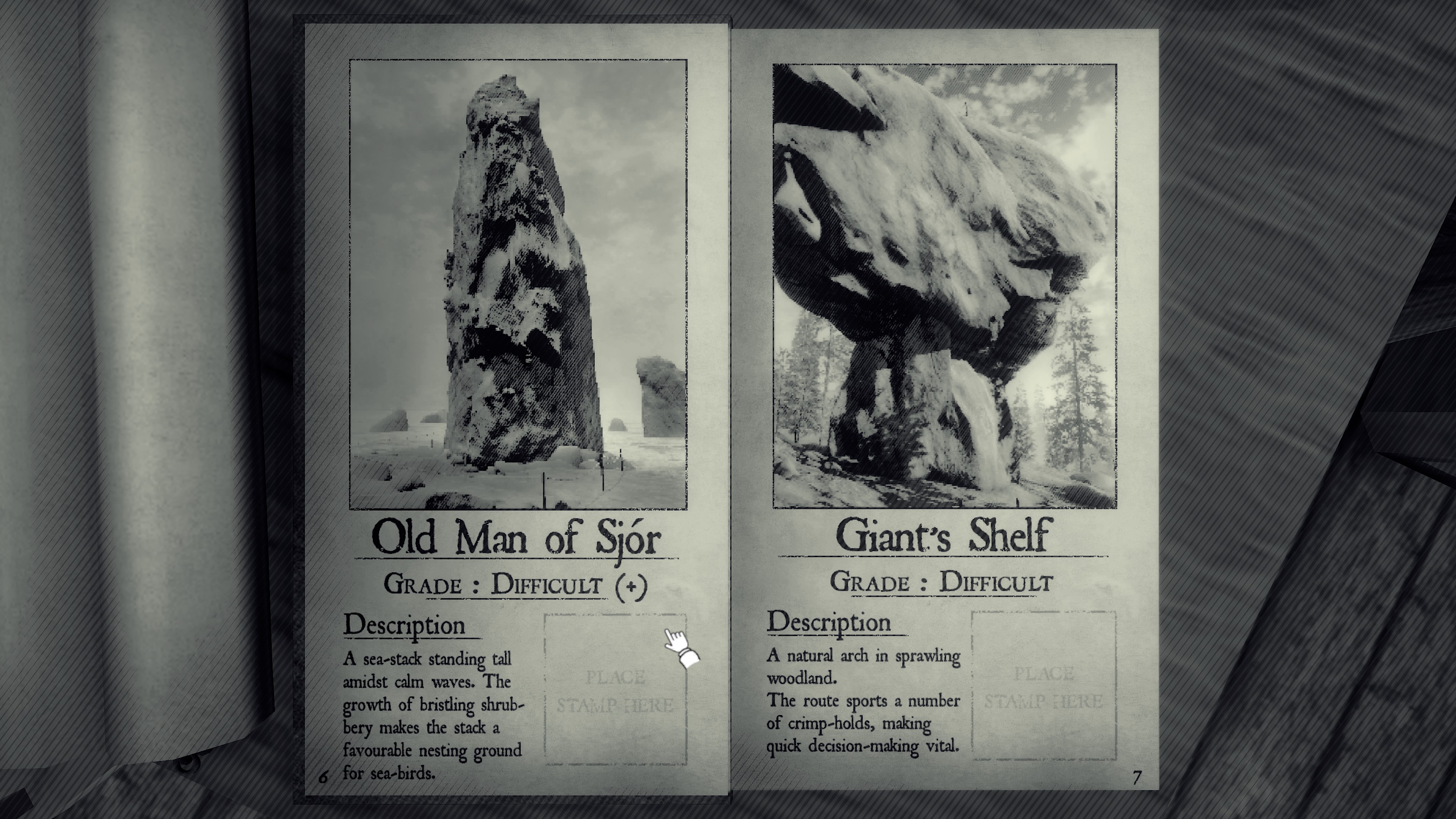
Afterword, as I stood on the lighthouse's external balcony gazing across the simulated shoreline, I thought 'Oh, is that the feeling people chase to the top of the world?' that Zen-like state where your brain just dumps all the clutter and attunes your entire body to the completion of one, singular goal? And if a silly game where you climb cliff-faces as a tweed-wearing chimp can afford me that brief taste of serenity, what must it feel like to be several thousand feet up, spitting the laws of physics as you flow seamlessly to a summit?
This isn't me declaring a new life of mountaineering—my legs start to go when descending one of those long escalators on the London underground. Merely that playing Peaks of Yore has helped me comprehend a sport I've admired but also been baffled by for many years. I've played and enjoyed other climbing games before, like Crytek's excellent VR sim The Climb and DontNod's breathtaking vertical adventure Jusant. But the configuration of Peaks of Yore's challenges sparked a part of my brain that those games didn't, despite being a less refined experience than either.
Needless to say, I'll be continuing my climbing career in Peaks of Yore. I've already sampled many of its deeper delights, which fold in timed 'crimp' holds, seagulls that nip at your hands as you scale a mildewy shoreline stack, and even ice-climbing on its more extreme routes. Last year also brought a DLC pack that adds proper alpine ascents, which I can't wait to get my calloused mitts on once I finally beat the highest peaks of the Great Gales. Watch out, Wuthering Crest, I'm coming for you.
]]>What is it? A sci-fi metroidvania with sublimely satisfying, parry-driven combat.
Release date May 29, 2024
Expect to pay $30/?25
Developer Red Candle Games
Publisher Red Candle Games
Reviewed on ASUS ROG ALLY, Gigabyte G5
Steam Deck Verified
Link Official site
Six months. That’s how long poor Red Candle Games spent trying to come up with a combat move for their debut metroidvania that was as unique as Hollow Knight’s downward slash. Personally, I would have given up after six minutes.
Thankfully these developers were made of more disciplined stuff and their efforts have paid off magnificently. Because I’m struggling to think of a combat system I’ve enjoyed in a 2D game more. A lucky Dead Cells run might just beat it for moment-to-moment pleasures, but for the satisfaction of mastering the fine art of slicing and blowing things up, I think Nine Sols’ swordplay had every Soulslike of 2024 beat (yes, even that one).
You play as Yi, a feline samurai who looks cute, but is actually as shadily motivated and untrustworthy as my actual cat. After taking a seemingly fatal tumble off a cliff, Yi cashes in one of his nine lives and recovers in a village full of humans. But when the village engages in a spectacularly violent ritual seemingly conceived by someone who’s seen Hereditary one too many times, Yi abandons the village and starts exploring a mysterious facility. From there he’s basically seeking out a series of wonderfully charismatic utter bastards worthy of a Metal Gear game so he can slice them all into ribbons.
Red Candle Games’ first major achievement is successfully squashing Sekiro’s parry-or-perish combat into two dimensions. Incidentally, if you’re not a fan of parrying, take 90 points off the review score. You can muddle through for a while with the dodge button, and there’s a small window of forgiveness either side of a perfect parry where you'll still take the damage but very slowly regenerate it back (Wow. Thanks.). But these small concessions aren’t going to save you for long. Refuse to learn that parry properly and the game’s first boss will absolutely call your bluff, merrily decorating the walls with your insides.
Luckily you have an ace up your sleeve worthy of Balatro. Nine Sols’ masterstroke is that simply pulling off a parry isn’t just a reward in itself here. It also fills up your Qi, which Yi uses to slap deadly talismans on his enemies. So long as you keep that slap button held down uninterrupted, the talisman will then explode, often a fatal experience for the poor sap you slapped it on. You’ll find enhancements for these too, like one that briefly freezes enemies in place when you talisman-slap them, or creates a more powerful explosion depending on how long you can keep your finger on the trigger.
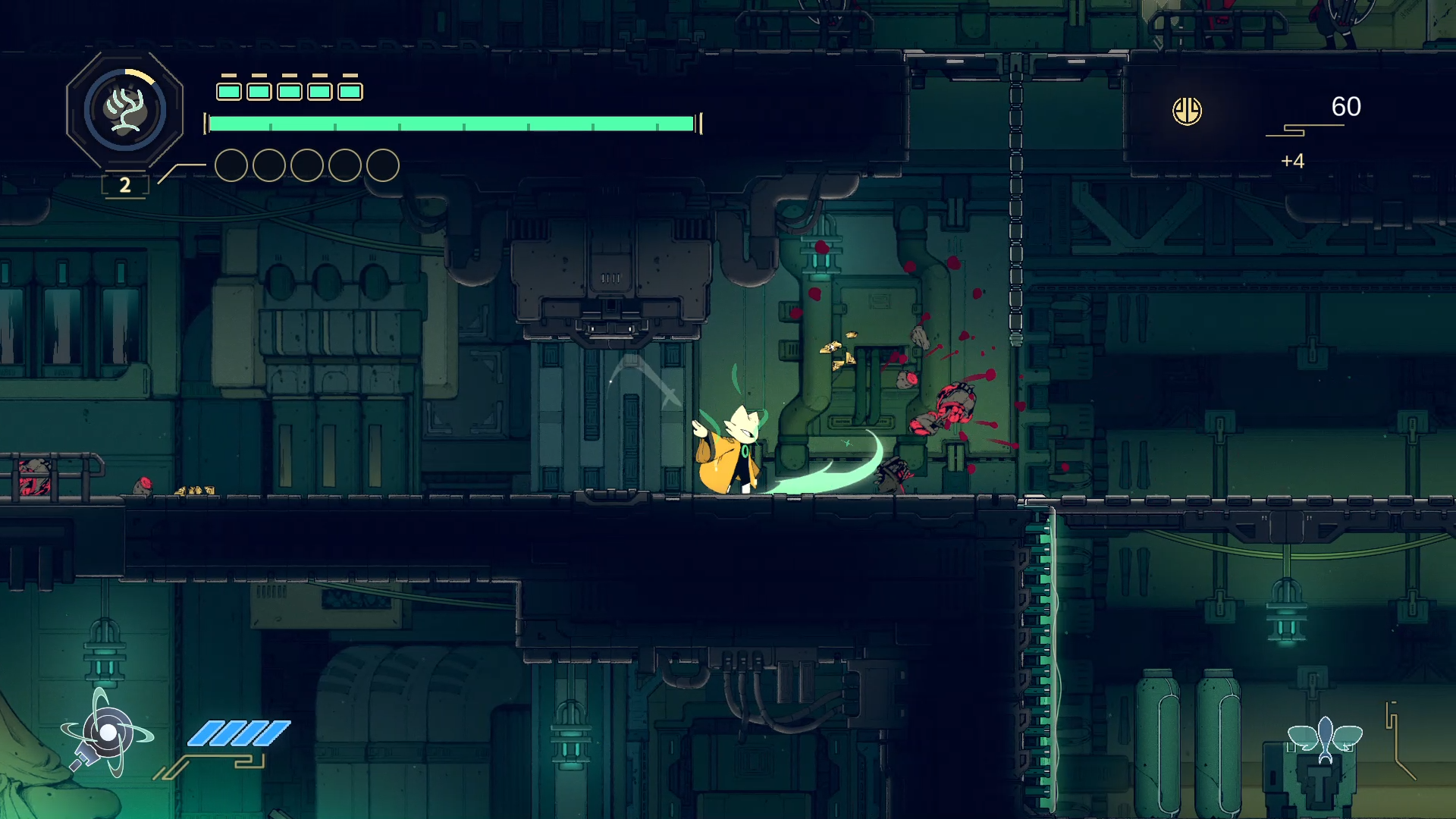
There were a few games last year that we didn't have time to review, so before 2025 gets too crazy we're playing review catch-up and rectifying some of these omissions. So if you're reading this and wondering if you've slipped through a wormhole back into 2024, don't worry, you've not become unfastened from time. We're just running late.
It's immensely rewarding to have an enemy go in for the kill, only for you to successfully interrupt their attack, dash past them with a talisman slap, then blow them up for daring to ever think they could hit you. Bosses are naturally made of sterner stuff, with their gigantic health bars and—sigh—'surprise’ second phases (actually, maybe I want to take 90 off the score too). In time-honored Soulslike tradition, these bosses start off seemingly impossible. But stick with it, and you’ll gradually master the parry timing and rhythm of parry-talisman-boom-repeat. When you finally ricochet and detonate your way through a boss without taking a single blow, it feels like taking down Ornstein and Smough blindfolded. With a guitar hero controller. That’s not even plugged in.
When you’re not repeating a boss fight five million times, you’ll find plenty of tight platforming challenges, clever puzzles, and well-hidden secrets that make it a pleasure to explore. That this studio has never made a Metroidvania before is just ridiculous. Nine Sols is so good that a certain charismatic genius recently called it the second best Metroidvania of 2024.
The combat is the main draw, but it also knows how to tell an entertaining story, full of intrigue, humor, and terrifying moments worthy of the studio’s horror roots. Even its initially slightly tired setting (can we ban the word ‘warehouse’ from level designers' vocabulary?) gets increasingly more surreal and inspired with each new area. I might mod a meme of the Chinese president into the game just to get this studio cancelled again, purely out of professional jealousy.
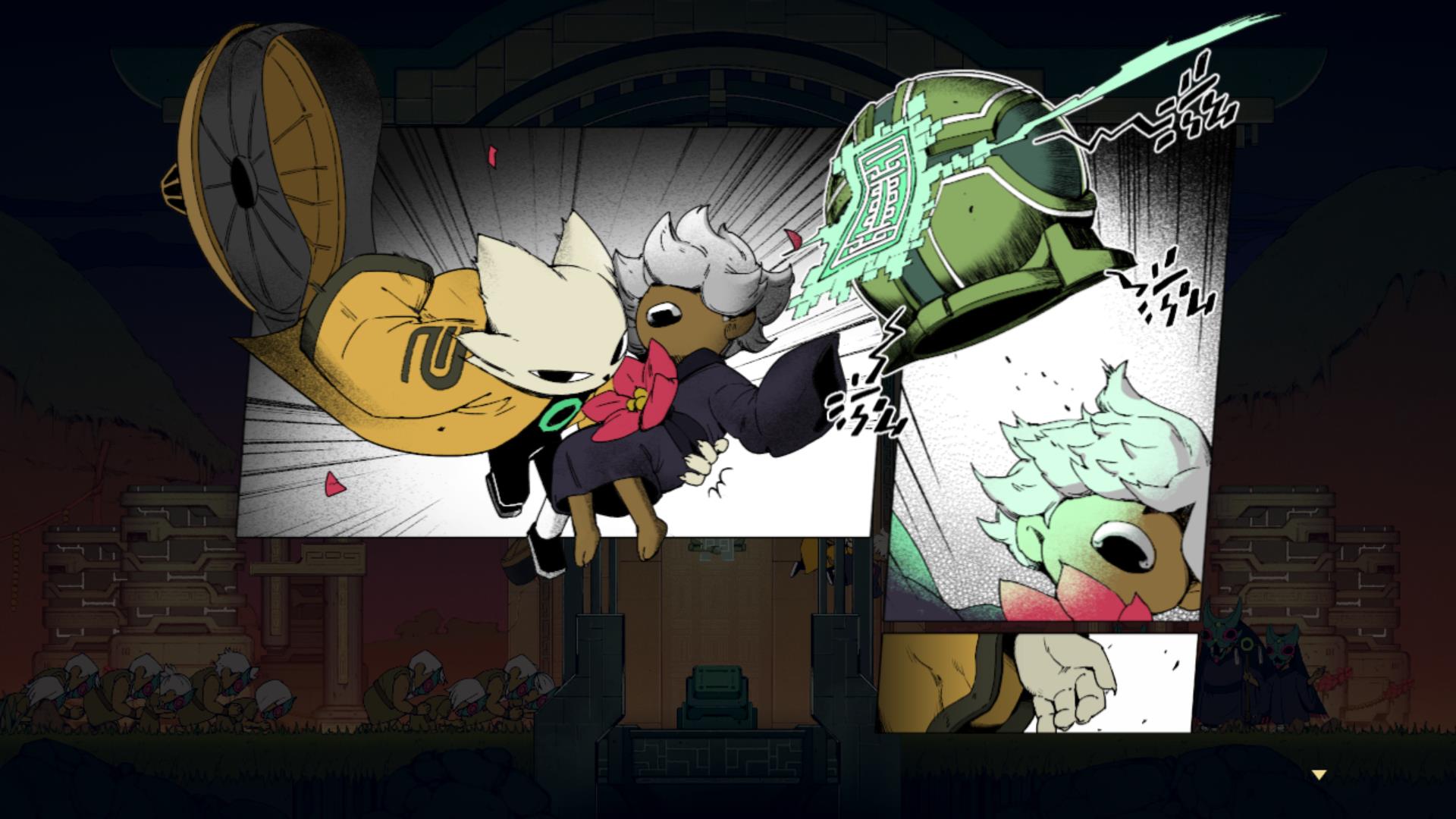
Nitpicks? Well, it can be a little overly chatty, especially when you get back to your main hub and find every NPC wants to monologue at you. Still, when the dialogue is so consistently entertaining, it's easy to swallow. Particularly in the case of Shaunshuan, Yi’s surrogate son. He's an adorable human child that Yi saves early on, and he's the beating heart that makes Nine Sols’ gruesome body horror go down a little easier. He doodles on the walls, writes fan fiction of your adventures, and even occasionally does something useful. The precious little guy also hero worships Yi, despite increasing evidence that Yi is far from deserving of such treatment.
Ah, but I’ve already said too much. Go find out for yourself how great Nine Sols is, even if it’s just so you can yell at me in the comments section that it’s nowhere near as good as Shadow of the Erdtree (oh yes it is, teeheehee!). Hold out for Hollow Knight: Silksong for another year if you must, but I highly recommend picking up one of 2024’s best games in the meantime.
]]>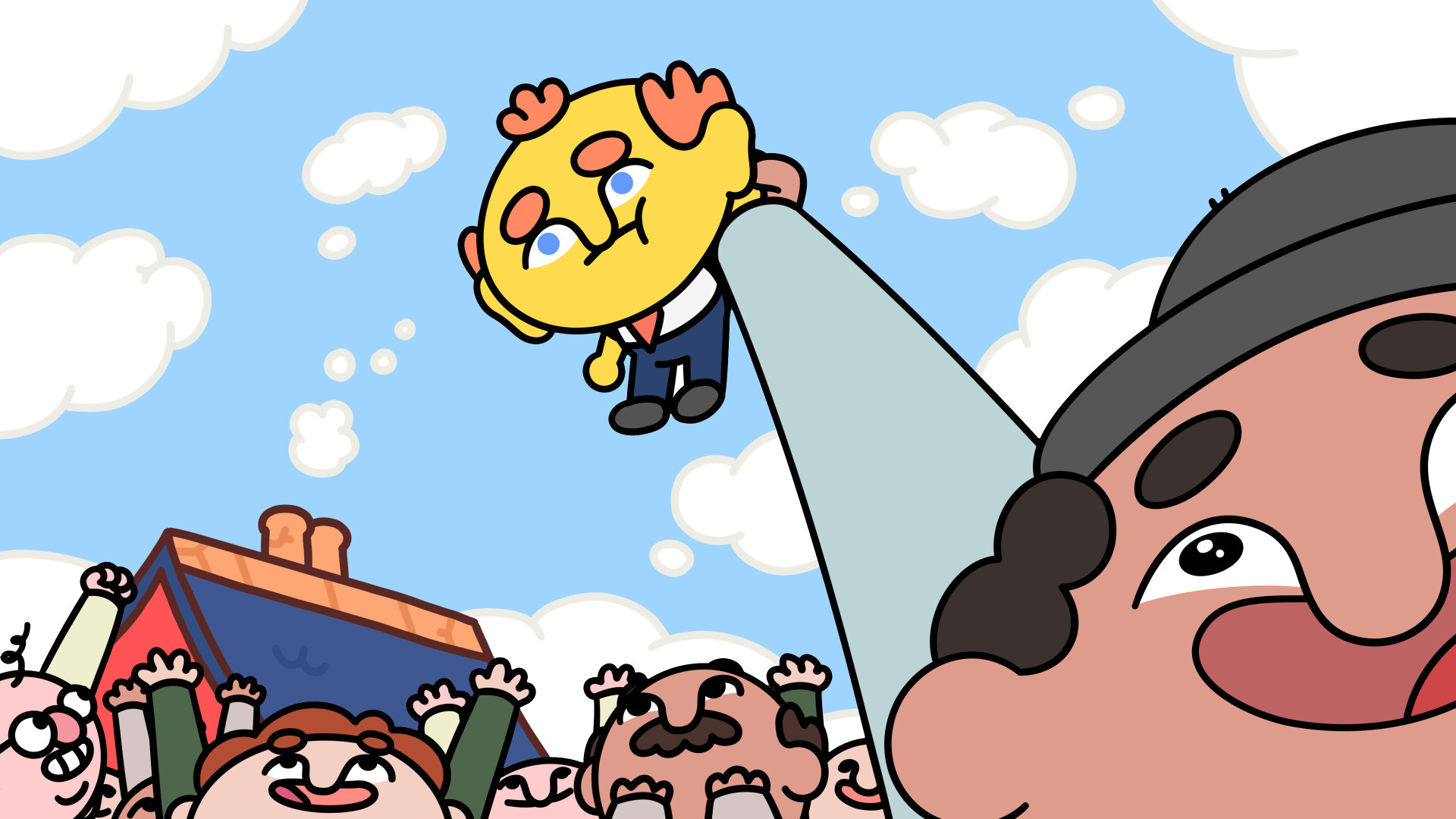
There were a few games last year that we didn't have time to review, so before 2025 gets too crazy we're playing review catch-up and rectifying some of these omissions. So if you're reading this and wondering if you've slipped through a wormhole back into 2024, don't worry, you've not become unfastened from time. We're just running late.
Thank Goodness You're Here! has an unwavering commitment to eliciting the kind of laughter that makes a little bit of pee come out. From the opening montage of surreal, whimsical and ever-so-slightly unnerving adverts to the anarchic musical number it ends on, it offers no time to breathe between all the guffawing you'll be doing. But it is absolutely worth risking the gag-induced asphyxiation for—it's a small price to pay.
At the end of last year, we called it the Best Comedy Game in our 2024 GOTYs, but for some reason we never actually got around to reviewing it, and thus it falls to me to slap a number on this thing and tell you that you owe it to yourself to spend a couple of hours exploring the fictional Yorkshire town of Barnsworth.
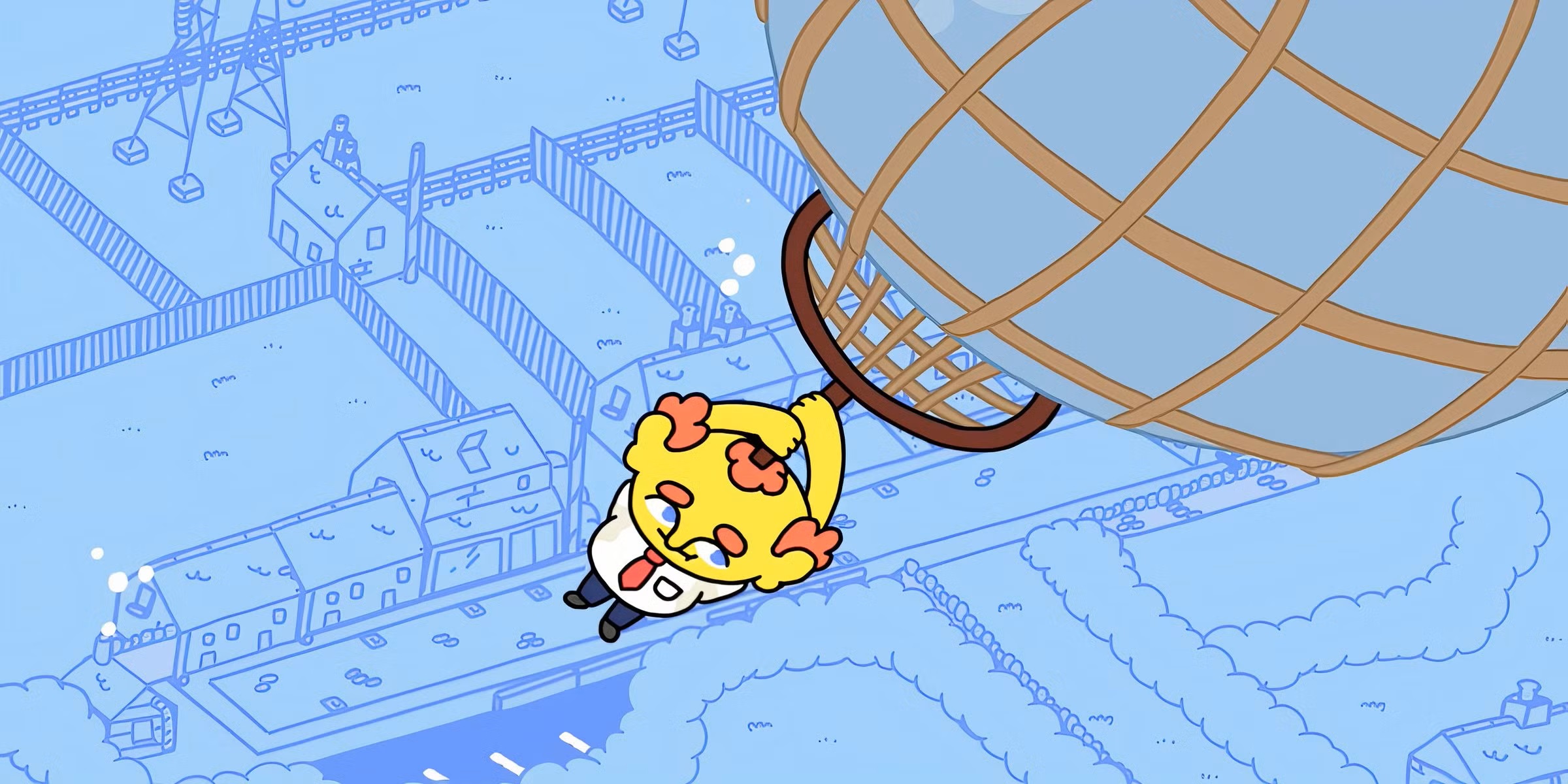
Technically we're in adventure game territory, but it has little in common with its joke-filled compatriots like Monkey Island and Sam & Max. You'll find no tricky conundrums or pixel-hunting puzzles here. Instead, playing as a nameless, voiceless, dogsbody of inconsistent size—allowing you to, say, explore a disturbing meat dimension inside a slab of ham—you'll mostly be finding yourself at the centre of increasingly bizarre skits.
Your task is to help the eccentric residents of Barnsworth with simple problems. Typically, the solution amounts to simply pushing forward, exploring this weird cartoon reality and embracing its lunacy. Sometimes you'll jump on something, knock another thing over, or give someone a playful slap. There's no inventory management to take you out of the world. Rather, you're like a child, randomly touching things with your sticky fingers to see what will happen.
Despite the absence of headscratchers, though, solving problems in Thank Goodness You're Here! is just as satisfying, if not more so, than it is in a traditional adventure game—such is the power of the jokes and their pay-offs.
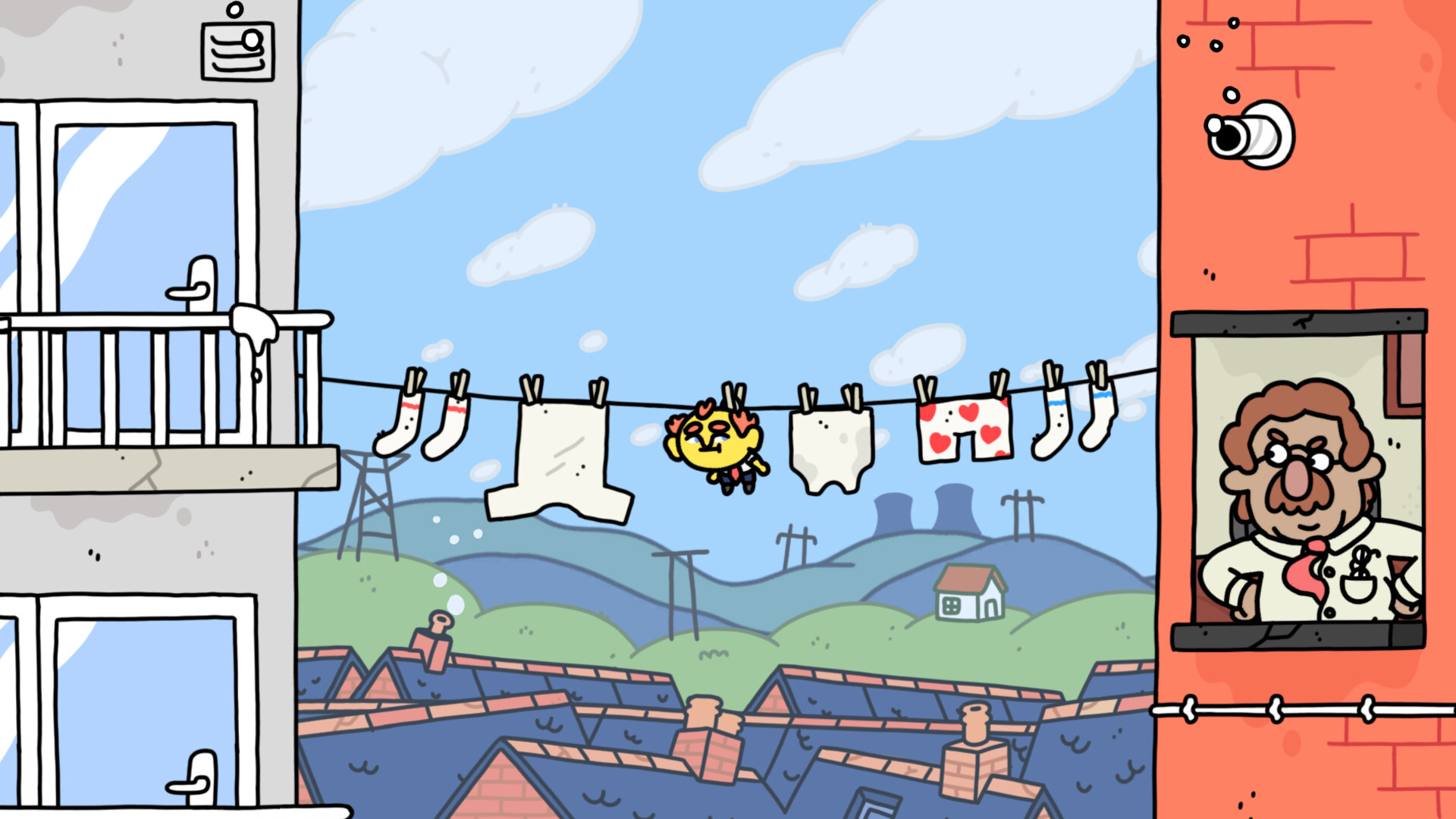
One task sees you helping a new bed-ridden pal do their shopping, which immediately becomes a ridiculous escapade when you realise that their hand will be accompanying you, as their increasingly long arm slithers across Barnsworth. Inside the shop, you'll need to find the perfect soup for them, but it's just another excuse for a lark as you cause a terrible mess on the shelves and revel in some very silly product names, like "Tiny Tom's Tinned Pie" and "Herbert's Lovely Boy Soup". Knocking a tin of "Soup To Push" into the trolley, your pal—talking through their hand—will complain that it's "too meta".
Everything is tied together by one central objective: making you laugh.
Barnsworth is a small town, but you'll do several loops of it, giving the game the opportunity to create some brilliant running gags. God, there are so many great ones, full of escalating madness. But my favourite has to be the use of a chimney as a shortcut, covering a poor old fella's living room in soot, time and time again. The way the homeowner becomes resigned to their fate, trapped in a filthy cycle, endlessly tidying their home only for a tiny man to ruin it without offering even a single apology, it's slightly tragic. But mostly very funny.
Developer Coal Supper works comedy magic with this tiny scope, filling each loop with bizarre asides, new gags and weird detours. You'll find yourself shrinking down to the size of a rodent to briefly explore a society of rats one minute, then the next, you'll be treated to a cutscene that explains why the grocer with the huge noggin is so angry, delving into his past traumas and broken marriage. Scale and perspective are constantly being played with, both being almost pathologically inconsistent, but everything is tied together by one central objective: making you laugh.
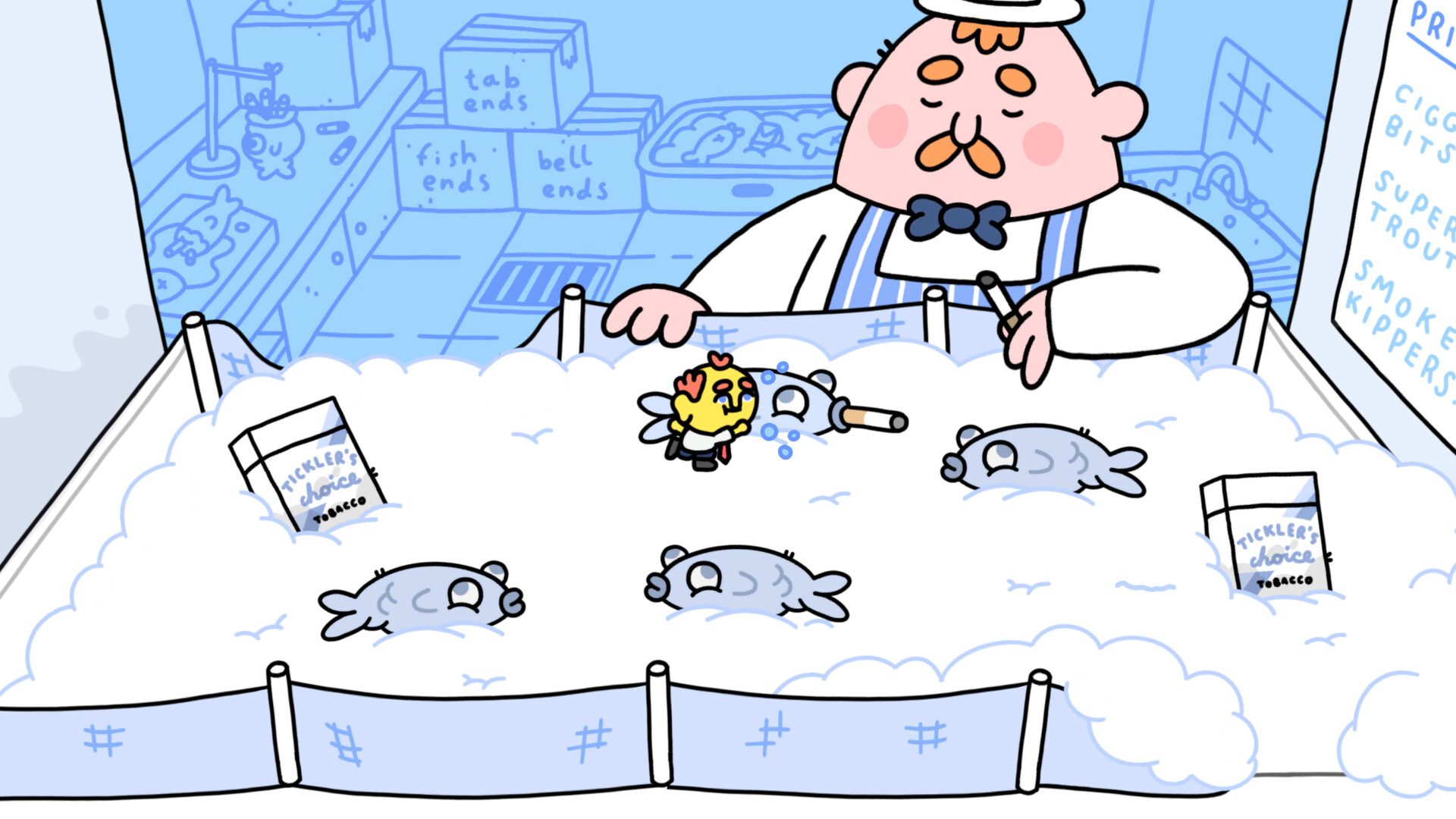
The tone is cheeky and often veers into the puerile—plenty of cartoon violence and jokes about bodily functions—and along with the art style this gives Thank Goodness You're Here! strong Viz vibes. For the uninitiated (and outside of the UK, that's probably most of you), Viz is a long-running adult comic that serves as a rude alternative to the likes of The Beano and Dandy. The surrealism and occasional dark undertones, meanwhile, call to mind fellow Northern comedy The League of Gentleman.
One crucial difference, though, is that Thank Goodness You're Here! is never mean-spirited, nor does it set out to shock—though it's certainly full of surprises. Barnsworth might be filled to the brim with lunatics, but it's never anything less than warm and welcoming. It's steeped in colloquialisms and geographically specific oddities, but it's not a million miles away from Parks and Rec's Pawnee, Indiana.
It might be harder for players outside of the UK to connect with, but none of its gags are really exclusionary. If you've ever laughed at Monty Python, I Think You Should Leave, Aunty Donna—basically any surrealist sketch show—you're probably going to have a great couple of hours slapping your way through Barnsworth.
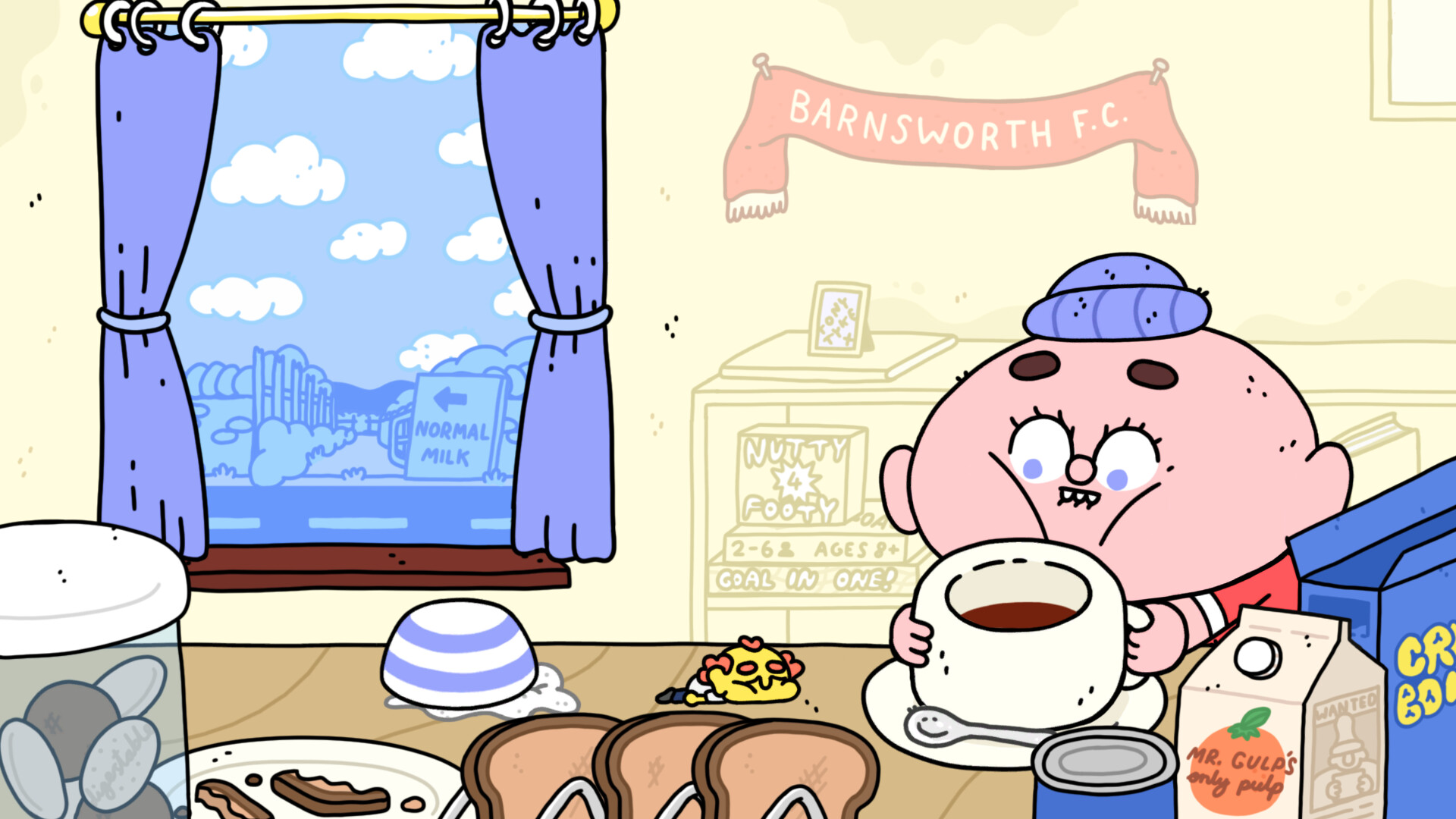
Indeed, a lot of effort went into getting the jokes to work in different languages, from Brazilian Portuguese to Simplified Chinese, since so many of them don't really make sense in a straight translation. But the concept of a small post-industrial town full of oddballs is pretty universal. Besides, when you're dealing with a game as strange as Thank Goodness You're Here!, everything doesn't have to make complete sense.
The lunacy, though, belies how tightly structured it is, as it funnels you through sketch after sketch, ensuring that no space or character is wasted. It is meticulously designed to evoke an absurd number of laughs per minute. And when it's over, you'll be pleasantly exhausted. It is so rare in games for something to give itself entirely to the noble pursuit of leaving us in stitches, and Thank Goodness You're Here! does so with such skill and glee that it's impossible to avoid becoming smitten.
]]>Heading into this new year, we're giving you a jumpstart on your winter fitness goals with a series called Train Like You Game. We're setting you up with articles detailing workout plans inspired by two video game genres: turn-based RPGs and today's example, the action-adventure workout. Created by personal trainer Tyler Buckingham and utilizing equipment you can find at your local Anytime Fitness, this series is geared toward giving you the XP boost you need to get started. The open world is your oyster. Time to level up.
The Warm-up:
2 Sets
- Squats x 10
- Push-ups x 6
- Reverse Lunges x 5 per leg
- Lateral Shoulder Raises x 10
Rest 30 seconds
The Train Like You Game Action-Adventure Workout
This will be a circuit workout, meaning we'll be doing all of the exercises one after the other for a series of rounds. Depending on your level of experience, you can begin at Starter (5-6 rounds), Experienced (7-8 rounds), or Hard Mode (9-10 rounds). You'll rest for 1:30 to 2:00 minutes between rounds. Let's get started.
Bear Crawls x 30 Seconds

Stay low for stealth sections with 30 seconds of bear crawls. As Buckingham says, "Bear crawls are a brutal exercise that completely hits every part of your body. It improves your coordination, core stability, and mental toughness. Bear crawls are only for the brave!"
Bicep Curls to Upright Rows to Toe Touches 3 x 3

You'll be doing three reps of each exercise, three times. "This tri-set will challenge your arms and back in the best of ways," Buckingham told us. "It promotes growth in your forearms, shoulders, and biceps, while also challenging your mobility throughout your spine, promoting strength and adaptability—something every adventurer needs to have at their disposal."
Squat Thrusters x 30 Seconds

This move will prepare you to blitz your opponent and send them flying with your tree-trunk legs. "Squat thrusters force production throughout the whole body. Your arm and core strength will be vital here as you pull the weights off the ground and use your legs to drive them up overhead."
Walking Lunges with Plate Twist x 30 Seconds

Whether you're brandishing a backpack packed with your bodyweight's worth of gear or blocking incoming sword swings with a shield, this will prep you to swing the kind of weight you need to push your way through the horde. "Your coordination, arm, and single-leg strength will be challenged greatly on this. Only the strong will survive," says Buckingham. Seems like a warning…
Superhero Squats x 15 Seconds per Leg

If you want to look like a superhero, you've got to move like a superhero. Testing your grip, core and single-leg strength, the Superhero Squat will get you loaded to spring forward and into action. This exercise might be Buckingham's favorite. "It's the bread and butter of every adventurer's toolkit and a great way to ensure victory against any and all opponents! Keep your balance (and wits) about you as you press through the floor and you'll find yourself lifting more weight than you thought possible."
After all that, you've earned a break. Give yourself a 1:30 to 2-minute rest, then start it all over. Not sure what these exercises look like? Tyler has you covered with a work-through video below.
When you're done, you can cool down with a nice and easy walk, stretch, or mobility flow. Have questions or still wondering if this is right for you? Go check out your local Anytime Fitness. Whether you're an action hero or just a regular gamer trying to get in better shape, the best time to level up your fitness is anytime.
]]>Kara Phillips, Evergreen Writer: A lot of the time, when I say a game makes me laugh, what I really mean is I exhaled through my nose at some point in a half-hearted way that barely resembles anything approaching laughter. But Thank Goodness You're Here! actually had me open mouth cackling through the vast majority of it. Between its ridiculous character design and its quickfire slapstick dialogue, I can't stop trying to convince everyone around me to play it.
It's not a challenging game—most of the jobs you'll complete are minigames that involve simple puzzle solving or very easy platforming. But that plays into its favour, giving you more time to admire the world and characters that Coal Supper has created. Never in my life have I played a game featuring characters that both repulse and entertain me, at least not to this extent. If you've ever had any interest in Don't Hug Me I'm Scared, then you'll understand the morbid sketch show vibe. Plus, it's hard not to love anything that Matt Berry plays a part in, and his character in Thank Goodness You're Here! does not disappoint.
If you want to point and laugh at Britain, this ridiculous game gives you the best opportunity to do so. It's like all the best bits of my favourite British comedy shows mashed together into something I feel the need to force upon everyone who even glances its way. If I had my way, Thank Goodness You're Here! would be everyone's game of the year.
Jacob Ridley, Managing Editor, Hardware: There's one string of bin (trash) jokes in Thank Goodness You're Here! that had me wheezing. It's not only a game with impeccable comedic timing but able to play on good natured joshing about the Great British public at large. A book of colloquialisms might be needed to translate for those further afield than dear ol' Albion, and subtitles come in handy even if you are from around 'ere. But there's enough absurdity to keep anyone hooked—it's filled with surreal and slapstick caricatures.
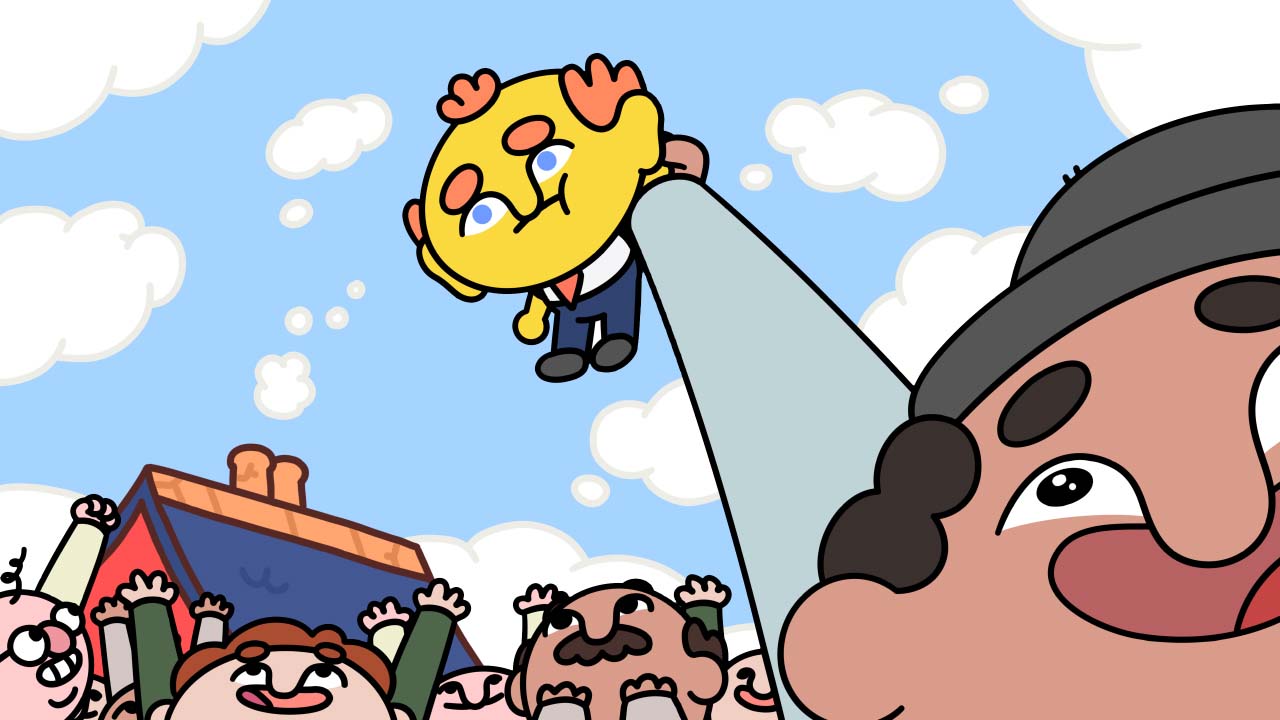
Fraser Brown, Online Editor: Oh god, yeah, the bin gags left me in tears. One of several running jokes that made repeating your loop around the town so rewarding. Even though it's only a couple of hours long, the volume of brilliantly clever, side-splittingly funny gags is truly exceptional. Restraining myself for fear of spoiling them is taking all of my (admittedly limited) willpower.
What makes the whole endeavour even more impressive, though, is the fact that it was translated into so many different languages, despite how colloquial it is. It speaks to the determination of the developer to make sure everyone is in on the joke, whether you're stomping around in North Yorkshire or playing the game in China.
Forgive the sentimentality, but I think it says a lot about the power of comedy to be this great equaliser, at least when the folk writing the gags make an attempt to be inclusive. Even though, on the surface, these gags are inextricably linked to a distinct region and comedic style, a great joke is still a great joke, and it will almost always translate.
James Bentley, Hardware Writer: There's an almost folk horror element to how insular the town of Barnsworth is that would be a little creepy if the whole thing wasn't so darn charming. Our lead is a stand-in for our own desire to mess with the residents but all those gags move from jokes to in-jokes within an hour, and you can't help but feel like part of it. One of us. One of us.
]]>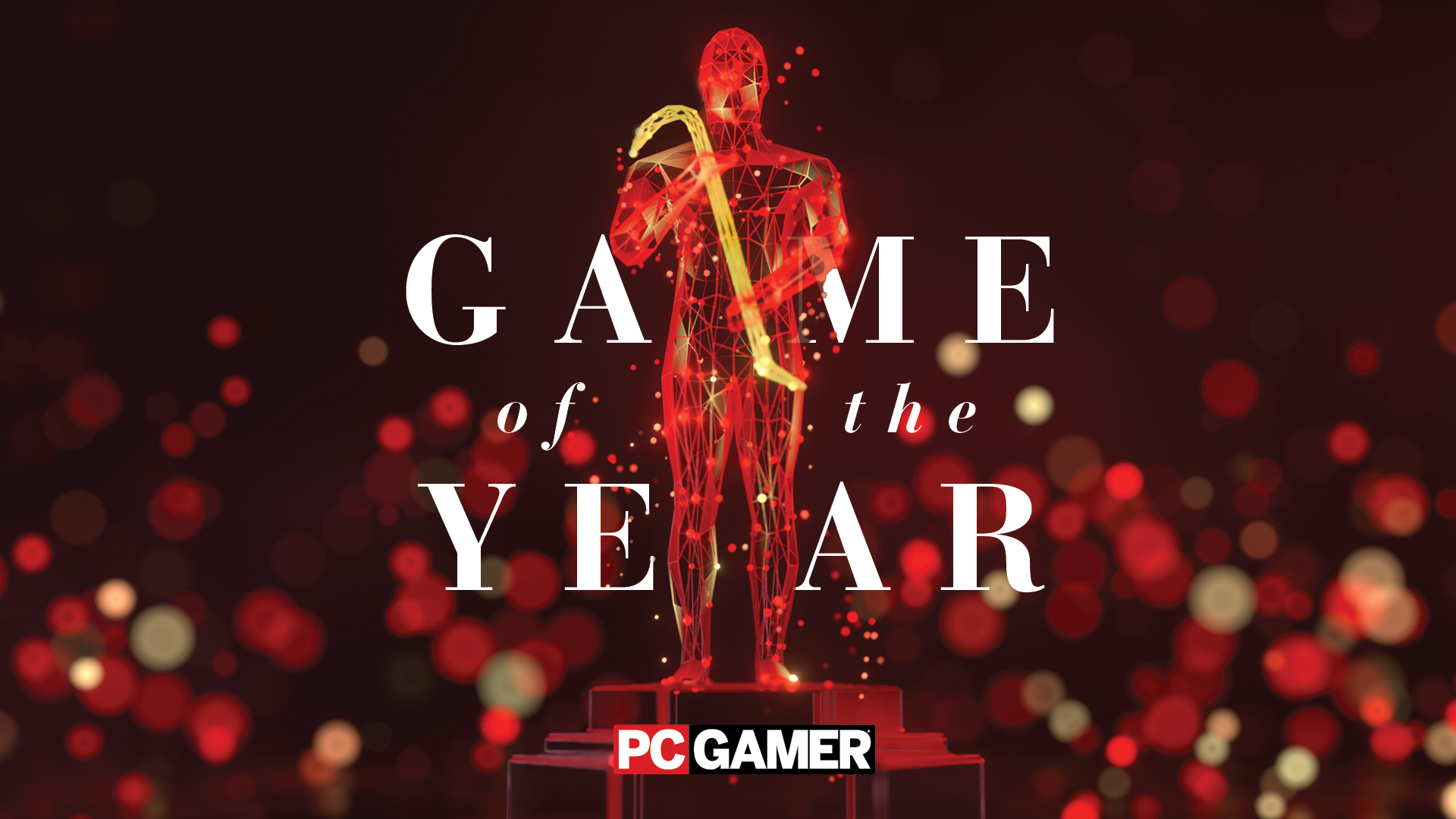
In addition to our main?Game of the Year Awards 2024, each member of the PC Gamer team is shining a spotlight on a game they loved this year. We'll post new personal picks, alongside our main awards, throughout the rest of the month.
The Allmother is dead. Stabbed through the heart for a multitude of cruelties by one of her own cloned 'sisters,' there's no going back. Many stories would end here, in this seeming moment of triumph. But for 1000xResist, it's just the opening image. Long live the Allmother!
In Sunset Visitor's debut game, the Allmother reigns at a distance over a society of her own clones. They dwell under an inside sky, safe from the alien Occupants on the surface but not from an airborne, moisture-purging virus. One crack in a sister's mask and it's all over. The Allmother, on the other hand, is the only one immune to this devastating disease.
It has not always been this way. Once upon a time, the Allmother was just a girl called Iris, the teenaged daughter of parents who left Hong Kong in the wake of the protests throughout 2019 and 2020. Once upon a time, the Allmother was definitely only human.
A pseudo-time-travelling mechanic arguably inspired by Millennium Actress (which just so happens to be one of my favourite films) is core to much of 1000xResist. As Watcher, a clone with a revered function, you are tasked with the responsibility of 'communion'—excavating the Allmother's memories as an immersive simulation. What follows is an exploration focused narrative game, and one of the best sci-fi stories I've experienced in years.
As you hop through Iris' school days either side of a deadly pandemic, there's a simple pleasure to exploration through the lens of Watcher's temporally distant perspective. For instance, typical first names like 'Iris' are seen as 'opaque keywords' by the function-focused society of the clones. For another, when Watcher asks how a school locker works, her travelling companion Secretary explains it hinges on "A password made of numbers and directional choreography." Watcher observes, "There must have been rampant theft." Secretary replies, "Either that, or rampant mistrust." With a smugness recognisable by anyone who has felt superior to denizens of the past, Watcher says, "I feel sorry for them."
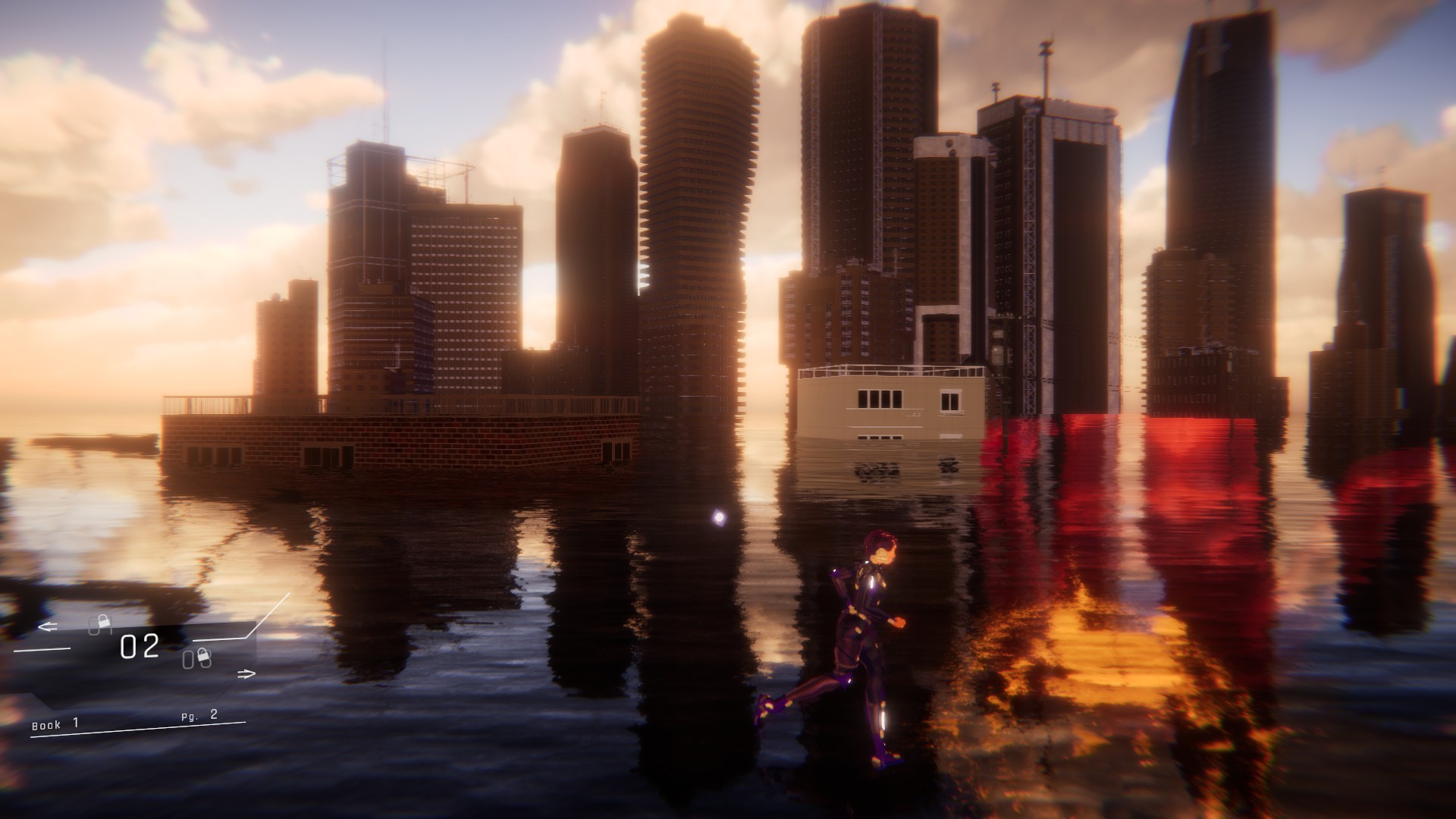
The best speculative fiction, while often laying its scene in the future, still distinctly comments on our present; many recognisable fears and anxieties reside in these halls. Case in point, you can spy the student council fighting over what they will be remembered for. The flashpoint of their argument is a fox statue—the incomplete passion project of a school councillor before them, the context of which has long since been lost to history. The council president makes the case that they should make room in the budget to complete the statue, partly because it meant something to someone, while his opposing speaker argues the most expedient resolution would be to do away with the statue completely. No agreement is reached as both sides run out of time, and the council is told to immediately report to the gym. The treasurer bemoans, "Our great grandchildren will be paying our debts."
Skipping ahead a short span of years, you encounter another character petting the long since abandoned statue. They ask what kind of animal it is—they've only seen foxes in picturebooks from the old world.
'What we leave behind' is a theme that goes hand in hand with many of the characters' desire to understand the inner life of a distant, often parental figure. To say Iris' relationship with her own mother is complicated is to obscure through euphemism, and sharp character writing allows 1000xResist to explore this in a believably messy way. For just one devastating example, in a private conversation exposed by worship, Iris calls her own mother a coward for leaving Hong Kong. This strained parent-child relationship echoes throughout everything that follows as Iris leaves the role of 'daughter' behind in favour of becoming 'Allmother.'
After finishing 1000xResist for the first time, my first thought was, 'I really want to tell my mum about this game.' Though not a huge gamer, she is curious about games; together, we've been picking away at Pentiment, and it turns out we both had strong opinions about Yakuza 0's treatment of its female cast. Like any art, games are another vector for understanding, and I'm still really looking forward to that conversation.?
Upon playing 1000xResist a second time, I'm also left wishing I could call my dad. We both love scifi, so much so that when I wrote his eulogy, I kind of felt it had to conclude with the Tears in Rain speech from Blade Runner. When my dad died, he left behind no handwritten letters, no journals save for a few hastily scribbled notes in pencil. We recently got into his email, discovering the server only holds onto messages through one year of account inactivity—after that, it simply deletes them. In between scrolling through our shared archive of sporadic WhatsApp messages, I find myself thinking about Silent Hill 3; after Harry Mason is killed by the cult, his adoptive daughter Heather travels to the titular town and discovers his notes scattered throughout, coming to understand not only some of the hell he went through, but also his paternal love in spite of it all.?
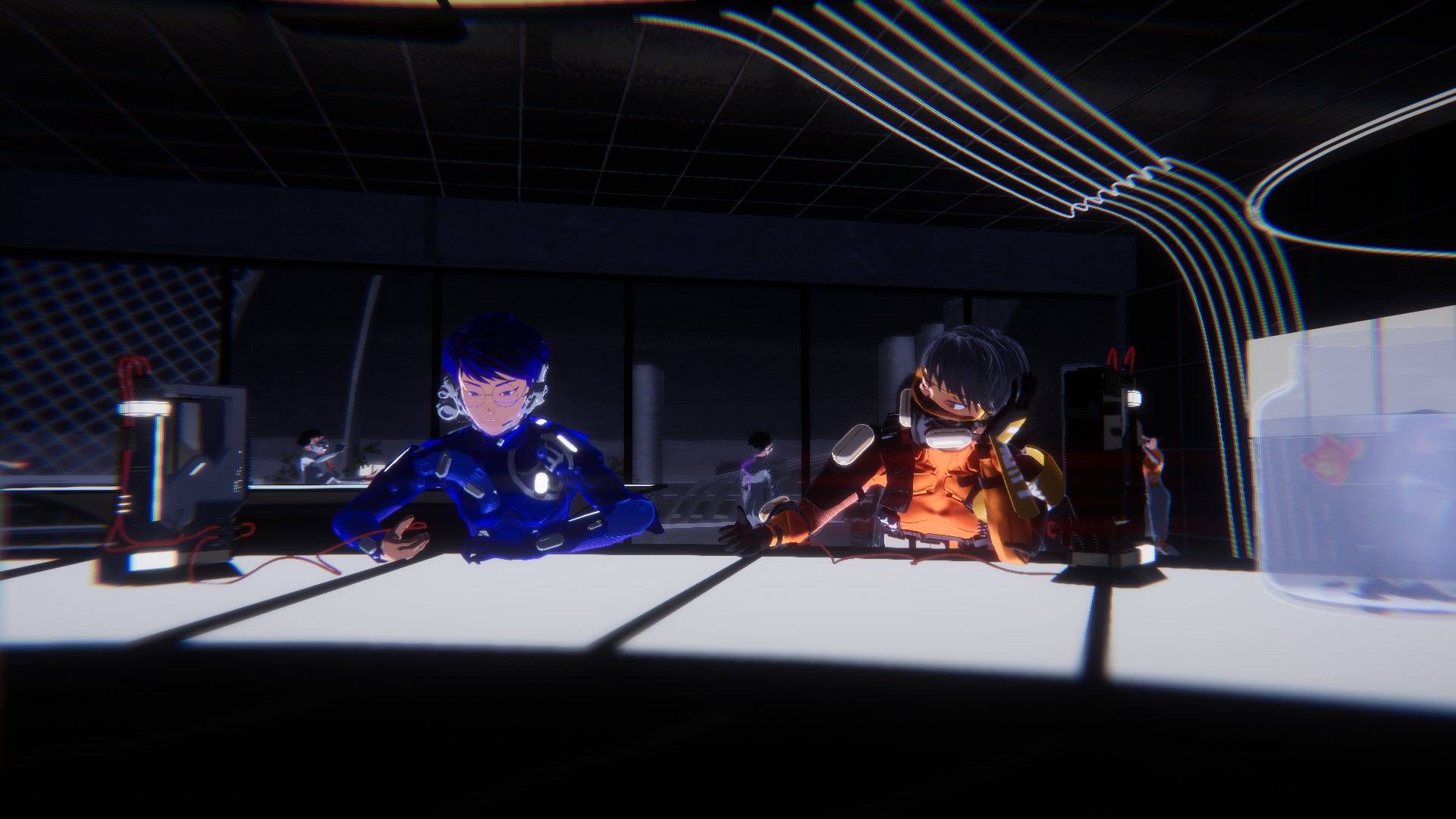
I know I'm hardly the first to mention Silent Hill and 1000xResist in the same breath; there's no Mumblers to fight here, but those fixed camera angles still create school halls suffering from no lack of foreboding. An incredibly stylish game, Sunset Visitor leverages their collective theatrical experience to create stunning tableaus that elevate the game's occasionally unrefined visual assets, and you're treated to one of these standouts as Watcher finally enters the school gym. This memory is the site of the pandemic's first mass spreader event, and is in many ways the beginning of Iris' transformation into the Allmother. The overseer of the clones' inside sky, Principal, is seen dancing on stage, surrounded by the floating forms of those first to die.
Sometimes sci-fi has a surprising amount to say about faith. Principal tells Watcher that excavating these memories through communion is part of that most sacred of duties: "to trust Her." Indeed, Principal always says the appropriately reverent thing, but you soon discover just how far she'll reach for evidence of the Allmother's love. It never seems to be enough, and she is weighted down by the pursuit. She says to Watcher she's revisited this moment in the school gym many times—and yet still warns, "Nostalgia can be a dangerous thing."
The true extent of Principal's reinventorying of the past is just one thread you really should unpick for yourself. Watcher's imperfect understanding of the Allmother, and how that fuels 1000xResist's inciting incident is another—to say nothing of the betrayal that caps off just the first chapter. Even after two playthroughs, I'm still peeling back all of the layers of Sunset Visitor's debut game, and I'm sure this will be far from my final communion. Hekki grace.
]]>
In addition to our main Game of the Year Awards 2024, each member of the PC Gamer team is shining a spotlight on a game they loved this year. We'll post new personal picks, alongside our main awards, throughout the rest of the month.
There you stand, examining a crime scene scattered with clues—an open safe, a blinking light on an answering machine, a passport burning in a fire pit. There's also a rug that appears to have been pulled out of place, a torn curtain and a broken balcony railing, and, oh yeah, is that woman nonchalantly burying something in the yard? It's all a wee bit suspicious.
In mystery adventure The Rise of the Golden Idol, figuring out whodunnit is just the beginning: you also need to figure out how they dunnit and most importantly, why they dunnit. It's the perfect game for anyone who loves mystery novels and detective shows, because even once you've collected all the evidence and identified all the suspects, you'll still have to twist your brain into knots to put it all together so it makes sense—and each case you solve is just one small piece in a much larger and more ominous puzzle.
In 2022, developer Color Gray Games introduced us to a novel new way to untangle a murder mystery. With its crude art and grisly murders, The Case of the Golden Idol presented us with crime scenes frozen in time at the moment the victim horribly perished. We could then play detective, slipping notes from pockets, looking through desk drawers, and piecing together clues by gathering words: names, objects, and verbs. Then we used those words to fill in blanks to form a narrative of events, solving each of the dozen gruesome murders and learning a bit more about the thread connecting them all. What is the Golden Idol, and why are people so obsessed with it that they'll kill to possess it?
Some of the novelty of the original's crime-solving system is lost the second time around, but The Rise of the Golden Idol is still a fantastic sequel and an outstanding mystery game, plus it adds a few new tools to your detective's kit. The setting this time is the 1970s, and the Idol, responsible for all those murders in the first game, has been lost for centuries. But now it's reappeared and is being reassembled, and the moment it surfaces people begin dying once more, either by unfortunate accident or straight-up murder.
In Rise, not every mystery is a murder, which being a fan of Poirot and other murder dicks, I honestly am a wee bit disappointed by. But there are still plenty of bodies to clean up after, and even when a mystery doesn't involve a fatality, such as a brawl at a talent show or a fire in a science lab, they're still satisfying to piece together. And just as in the original game, the slow reveal of the overarching story, a fragment found in each individual case, would fit perfectly into a long, sprawling mystery novel.
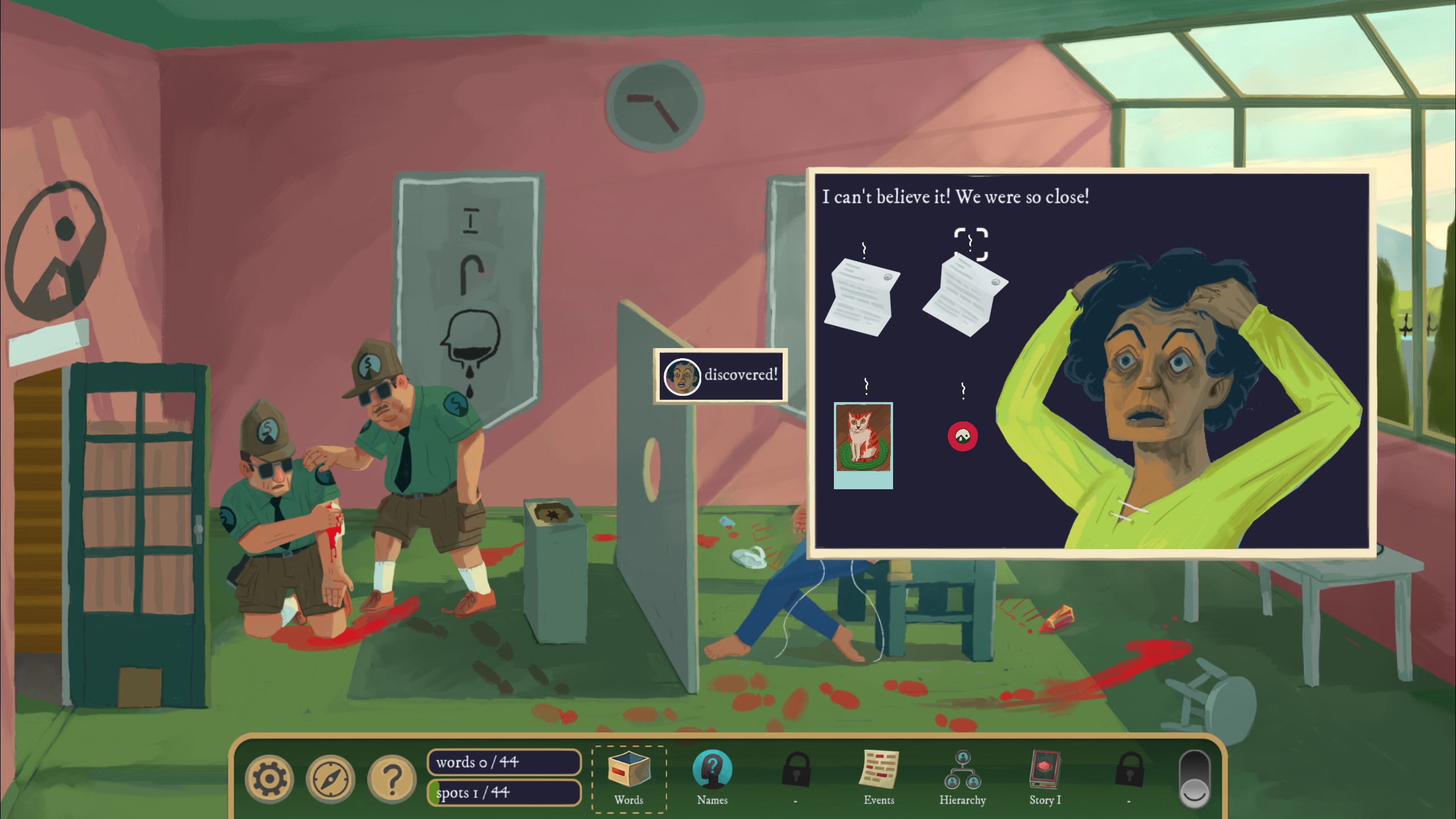
In addition to clicking on items in each scene to gather clues, there are a few new twists that help with your investigations. One clever mystery involves playing and rewinding a video to examine a dancer's movements and determine their meaning by consulting a book. Similarly, a surveillance video recording a party on a boat can be watched and replayed to help you determine which guest stood in a particular spot at a particular time. Another fun scene lets you examine the same scene at two different times: once during an artifact auction, another an hour later when the lights have gone out and things have gone horribly wrong.
What I love about The Rise of the Golden Idol is what I love about the first game: yes, there's the intense satisfaction of gathering clues and identifying suspects and putting together the sequence of events that explain how a murder happened—but the cherry on top is the why of it all. The shadowy motives, the hidden agendas, and the slow reveal of secrets that eventually explain what's really going on. The story of The Rise of the Golden Idol would fit perfectly into a mystery novel, and with more cases coming next year as DLC, I can't wait to discover the next few chapters.
]]>It markets itself as the coziest open world game, and after putting at least 20 hours into it over the last week I definitely agree with this. But, it's also the kind of game that if I had played around 10 years ago, you wouldn't have caught me admitting to enjoying it. It's so stereotypically girly that childhood me would've been embarrassed even knowing about it, let alone pouring time (and eventually money—damn you gacha) into it. However, when trying to understand why games like this were so embarrassing to me growing up, I find it hard to believe that my personal preferences are exclusively to blame.
I guess this is growing up
When I started getting invested in gaming as a hobby, I had a Nintendo DS and a family PC which struggled to load Hotmail on a good day. It was hard to know where to look for new games to play since none of my friends were into it, which is when I started to turn to YouTube. Let's Play videos made up a huge part of my childhood, but the vast majority of these were games like Halo, Garry's Mod and GTA. I wasn't playing any of these games myself—I didn't have the facilities, so I relied on these videos to feel involved in the hobby I so desperately wanted to be—and they felt pretty jarring next to my hours spent in Animal Crossing: Wild World.
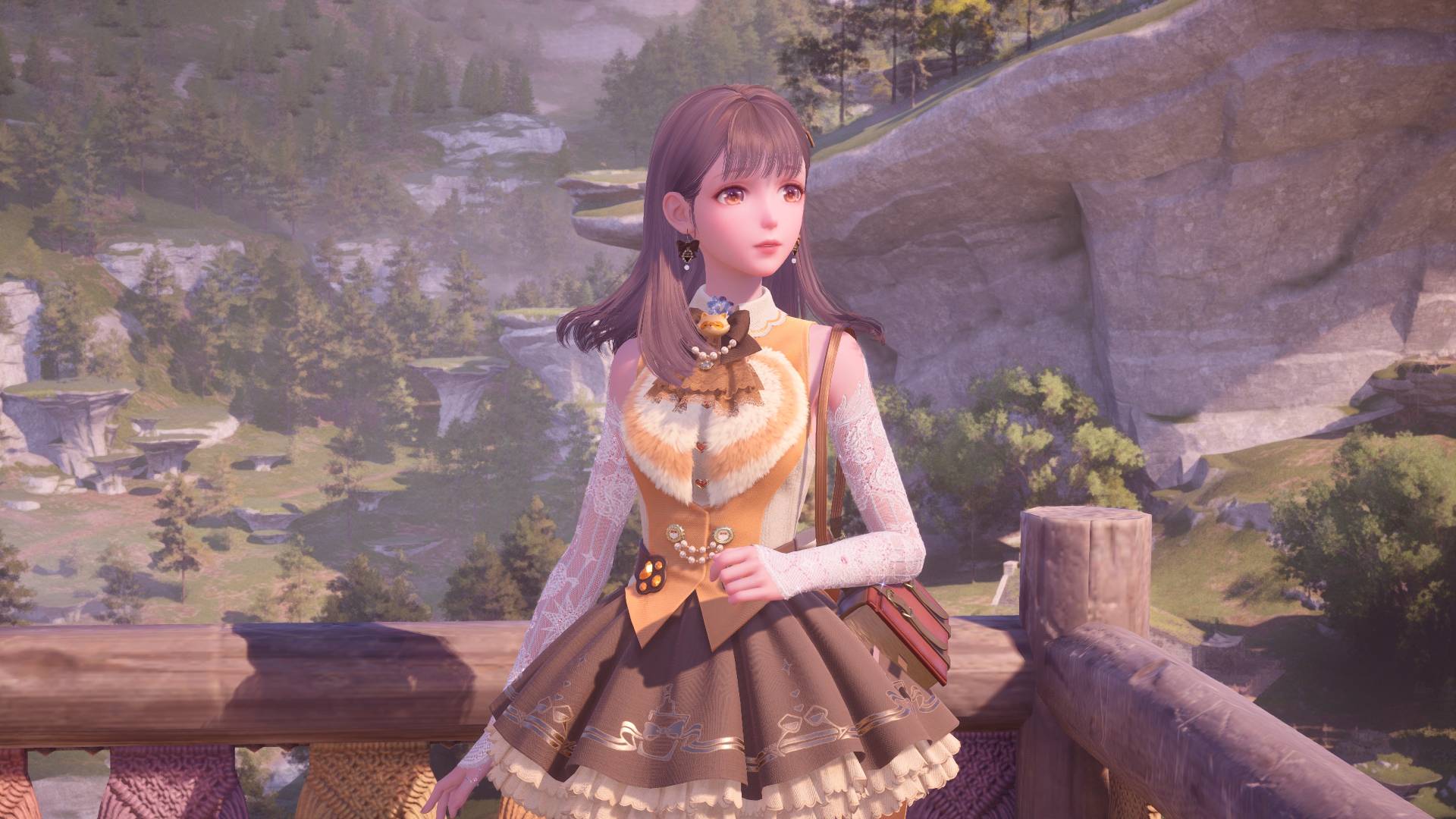
As a result, I started to feel like there wasn't a space for the games I liked playing, and I even started to feel fake for the games I enjoyed. If I wanted to be a gamer, I had to like everything dark, gory and gritty. I couldn't like the cutesy and frilly games that were aimed to appeal to people just like me. So, from the comfort of my pastel-coloured Hello Kitty-themed bedroom, I decided that I was no longer a fan of all things adorable. Instead, I was going to try and like the games I'd usually ignore just to fit in with the gamers, because I was convinced they simply wouldn't let me in otherwise. Now, over a decade and a half later, Infinity Nikki has come along and started to sew back together these parts of me I threw away.
It ticks every box for what we would now refer to as a cozy game, which childhood me would quickly label cringe. Simple combat, an easy storyline that revolves around saving, rescuing, or restoring something, and an animal companion. The world is bursting with flora and fauna and adorable critters to pet and play with, but the main appeal is the outfits. Everything is so glittery and cute—no matter which outfits I've been stringing together they still look great. It makes me want to re-do my entire wardrobe to look like a Barbie who has just been sick everywhere. Which is saying a lot, given I dress like an emo teenage boy most of the time.
I'm gonna take a pic
What I love most is everyone's willingness to share their creations too. The in-game snapshot function lets you drop a picture you've taken anywhere around the map for other players to interact with and take their own photos with. From these hourglasses, you get to see what fellow Nikkis are wearing, and I've had too much fun bringing people's snapshot holograms to life and taking inspiration from their outfits to improve my own.
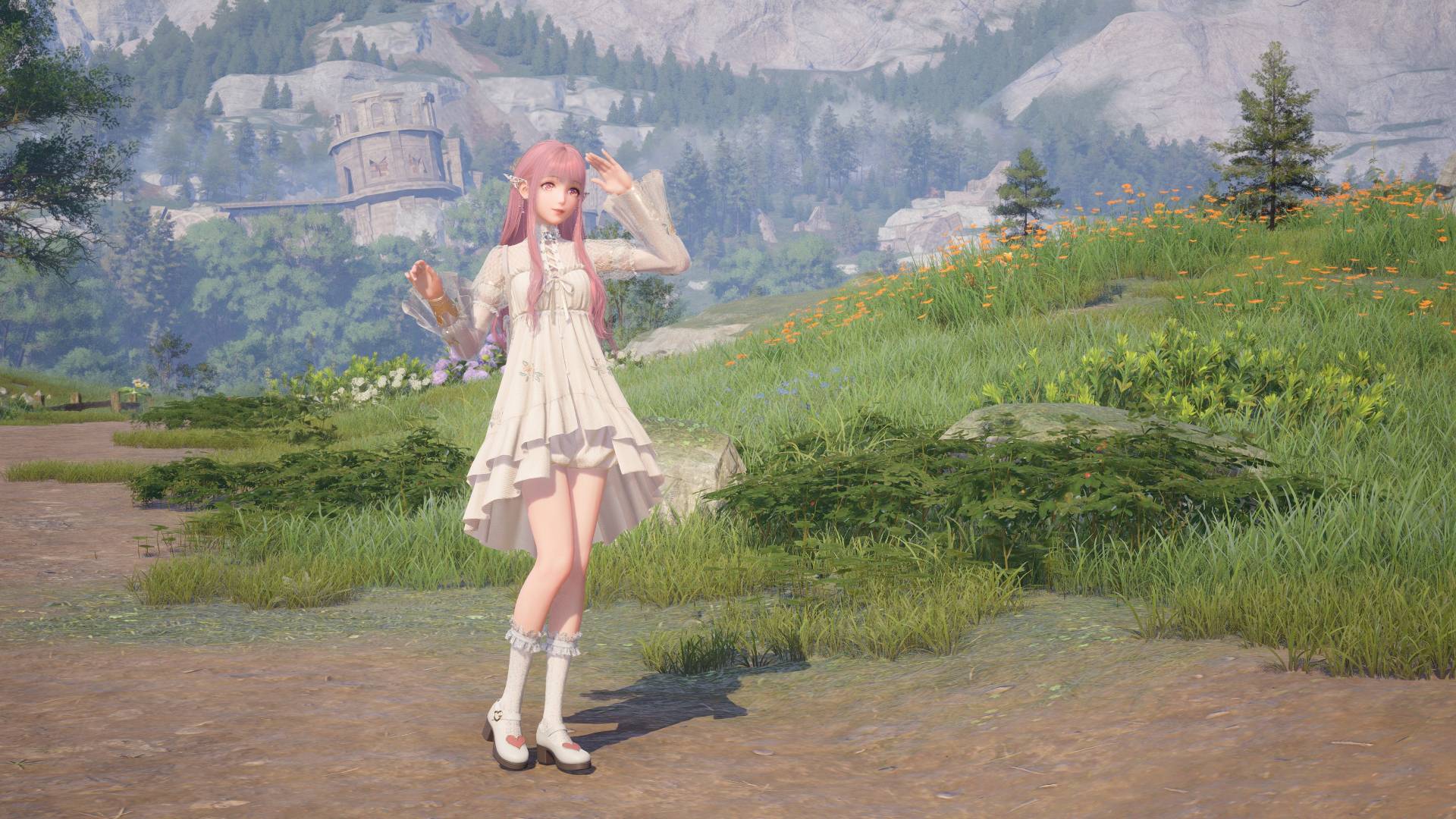
Without any sort of communication needed, Infinity Nikki has created a self-contained community of players who are ecstatic to share their ensembles. There's no sense of toxicity, mostly because no one has the ability to chat and create any negative space, and frankly, it's nice to feel like I finally have a space where I don't feel ashamed to want to join in. It's not limited to in-game either, as my social media feeds have been flooded with outfit inspiration or people asking for help with certain random quests or item locations.
I don't know if I've just been lucky enough to trick my algorithm into showing me the 100% pleasant side of the Infinity Nikki fanbase, or if we are genuinely at a point where no one is ashamed to share what they're playing. But either way, my inner child is sobbing at the fact there's a place where I can go and feel no shame in loving a game like this. Sure, it's taken more time than it probably should've for me to feel like I'm as deserving of a space in the gaming community as anyone else is, but I'm glad I'm finally there and don't have to pretend to like FPS games anymore.
]]>
Developer: Cloak and Dagger
Year: 2022
The Excavation of Hob's Barrow isn't the scariest horror game I've ever played, but it might be the most disarming. The most powerful tool in its arsenal is its close-ups—moments where the classic retro point-and-click adventure look is set aside for detailed and disturbing pixel art scenes.
The game is pure folk horror in a way you don't often see in this medium. The quiet rural village that Victorian academic Thomasina arrives in sits comfortably alongside the likes of The Wicker Man's Summerisle—a seemingly simple and unassuming community that hides a deep undercurrent of darkness behind an idyllic veneer. At times, the setting is almost cosy, lulling you into a false sense of security, before another grisly discovery makes it all the clearer that something is amiss.
That feeling of the sinister hiding in pastoral plain sight is core to the genre, but Hob's Barrow takes it a step further. The structure of the game itself pulls the same trick. On the one hand, it's a throwback to a peaceful style of play. The old-fashioned graphics are unassuming and cosy, and progressing through the story is more often than not down to solving little item-based puzzles. Like an isolated rural community being visited by a hapless city-slicker, it seems to hark back to a simpler and more innocent time.
But when developer Cloak and Dagger wants to cut through the idyll and reveal some of the darkness beneath, it enacts a deliberately jarring shift to a different art style—one still recognisably part of the same pixel art lineage, but more uncanny and disturbing. The things it actually shows you often aren't necessarily grisly—sometimes it's just a raggedy old cat, or a person's face—but there's a stark ugliness to them.
They're not quite jumpscares, but they certainly jolt you out of any sense of comfort or safety, before dropping you unceremoniously back into the point-and-click perspective, often looking at a softer and more harmless-looking version of the person or thing that was just zoomed in on. Like all good horror, it creates space for your own imagination to fill in the gaps.
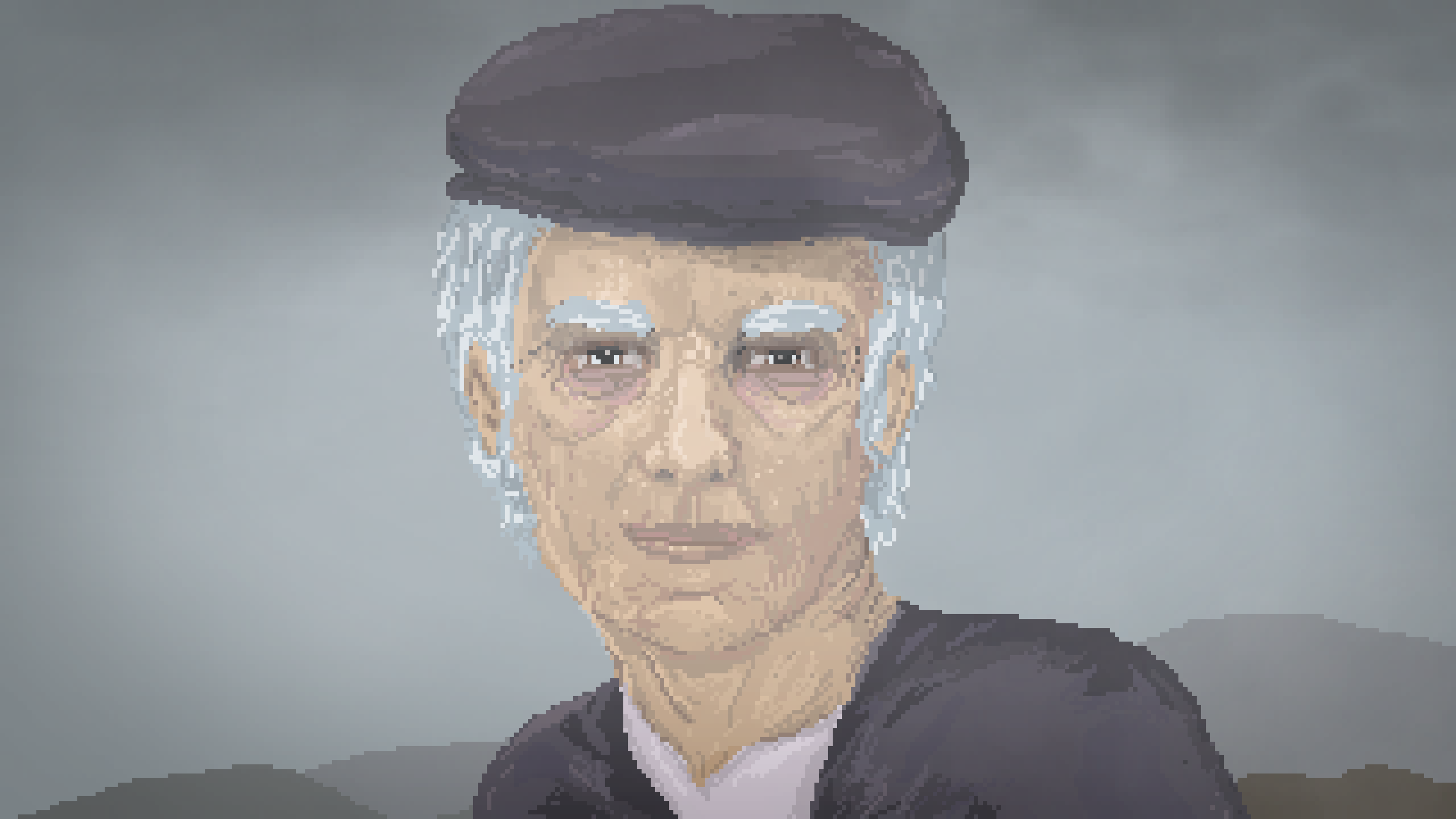
Sometimes you catch yourself meeting a new character or stumbling upon a strange scene and imagining how they would look in close-up. Faces you mentally filled in as being friendly and normal you start to picture as grotesque instead, and the whole game world takes on a feeling of hiding a darker layer of reality.
It's a remarkably effective technique, and one that plays with both our assumptions as players and the history of the genre. I was delighted to see Skald: Against the Black Priory attempt something similar, conjuring a Lovecraftian atmosphere by contrasting a simple top-down RPG aesthetic with grotesque pixel art of its monstrous enemies. What a brilliant way of evoking the sense of probing at Things Man Was Not Meant to Know.
This kind of layered playing with genre and format is so wonderfully unique to games. Never will another medium make me this unsettled with just an animation of a cat.
]]>Following a Game Awards bit in which Laura Bailey of Critical Role fame pretended not to know who Aaron Paul was, praising the Breaking Bad actor for being in "the greatest show of all time, The Wire," the pair announced Dispatch, a "superhero workplace comedy" where we'll send superheroes out to intercept crimes while chasing our own heroic dreams.
The game comes from AdHoc Studios, which was founded in 2018 by ex-Telltale developers, and will feature a number of notable actors and personalities aside from Bailey and Paul, including two other Critical Role cast members, Matt Mercer and Travis Willingham, as well as actors Jeffrey Wright and Erin Yvette, plus Jacksepticeye, Alanah Pearce, Joel Haver, Lance Cantstopolis (the alter ego of comedian Fahim Anwar), and musical artist Thot Squad.
The game looks Telltale-like, as you'd expect—there are multiple choice scenarios—and the Steam page says we'll "strategize who to send to emergencies" while "balancing office politics, personal relationships" and our own "quest to become a hero."
Dispatch will be out in sometime in 2025—it's got a Steam page here.
]]>The fishing and electrical ability outfits you'll collect early in the story are technically cool, at least according to Infinity Nikki's outfit taxonomy. But those outfits don't actually look cool, right? That fishing outfit is pretty dorky. I want to stick Nikki into an actually fresh fit and there are not a lot of readily-available options. But there are two easy to miss merchants slinging some actually cool athleisure and streetwear pieces:
Where to find the secret cool merchants in Infinity Nikki
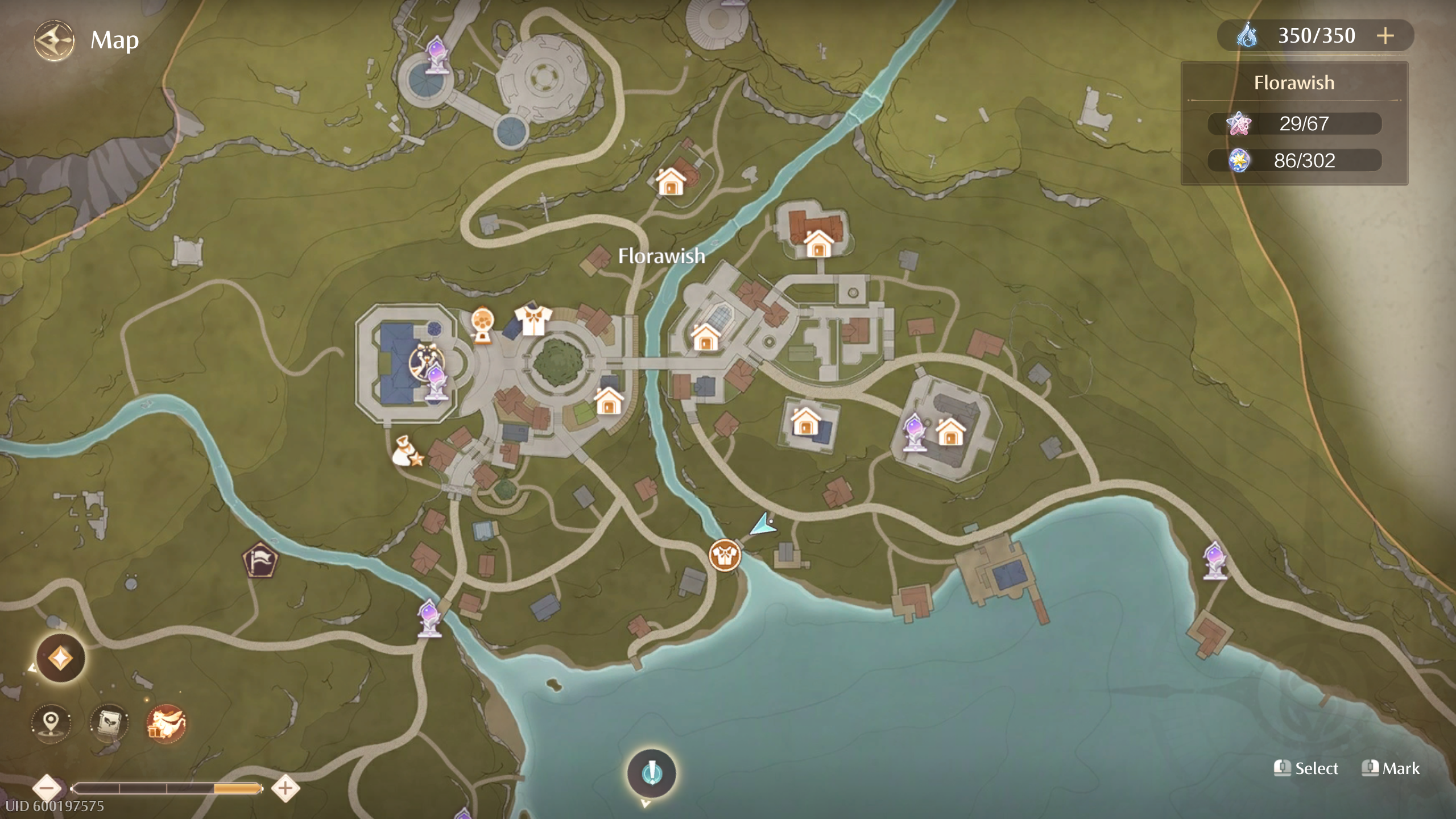
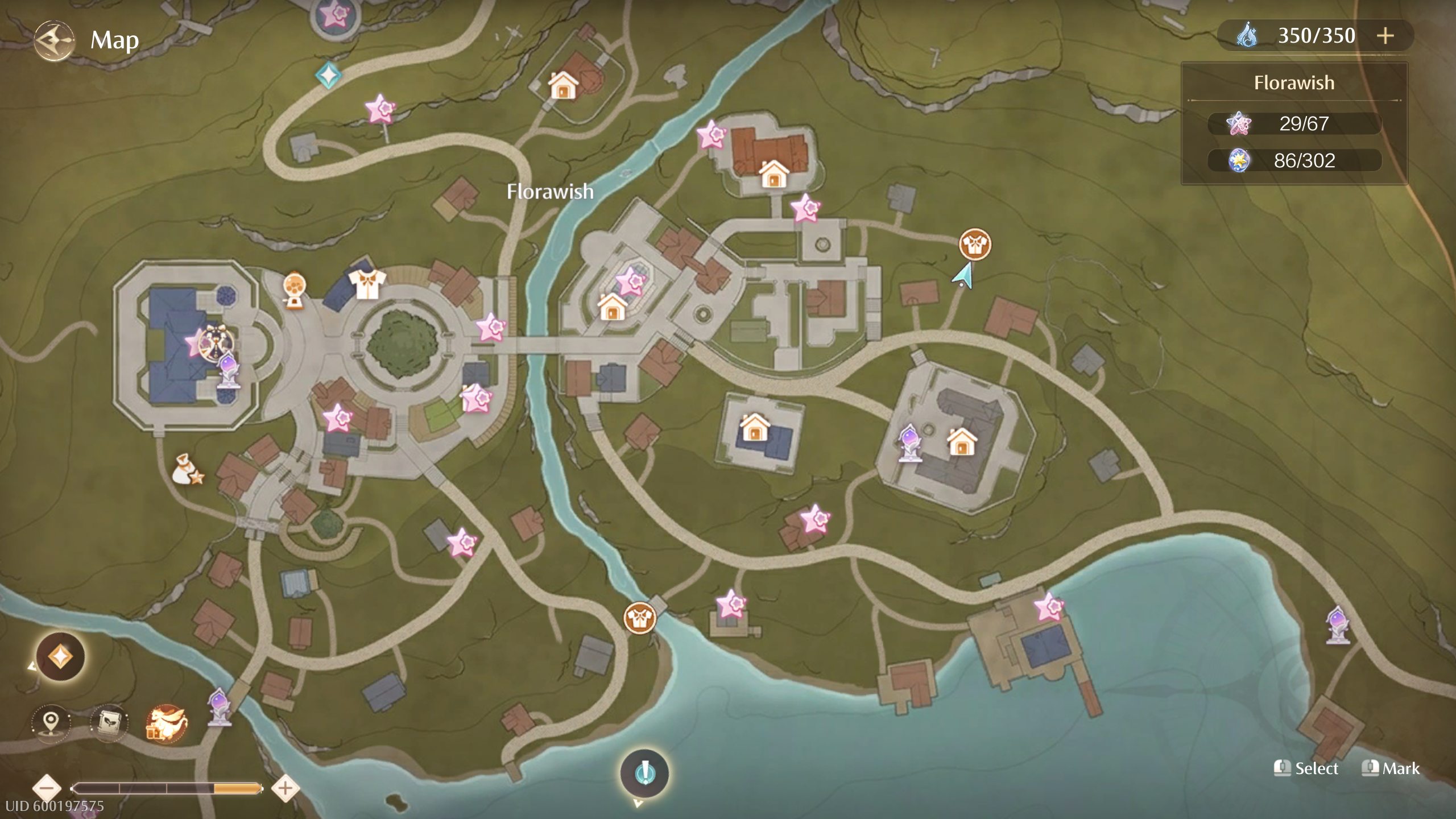
There are two unmarked merchants in Florawish who sell cool clothing pieces:
- Loran: Only present at night on a bridge near the Florawish beach
- Niro: An unmarked merchant at a stall on the dirt road north of the mayor's house in Florawish
Loran is the one that's super easy to miss since she only shows up at night. She sells a black hoodie and a black pair of sweatpants. Remember that you can skip time in Infinity Nikki by using the Pear-Pal if you want to summon Loran up without waiting around.
Niro can be found any time but he isn't marked on the map so you'll have to stop at his stall on the street north of the mayor's house in Florawish to check out his stock: a pair of black aviator style sunglasses and a black top hat. I don't know that I buy into the top hat being cool, exactly, but it's an option.
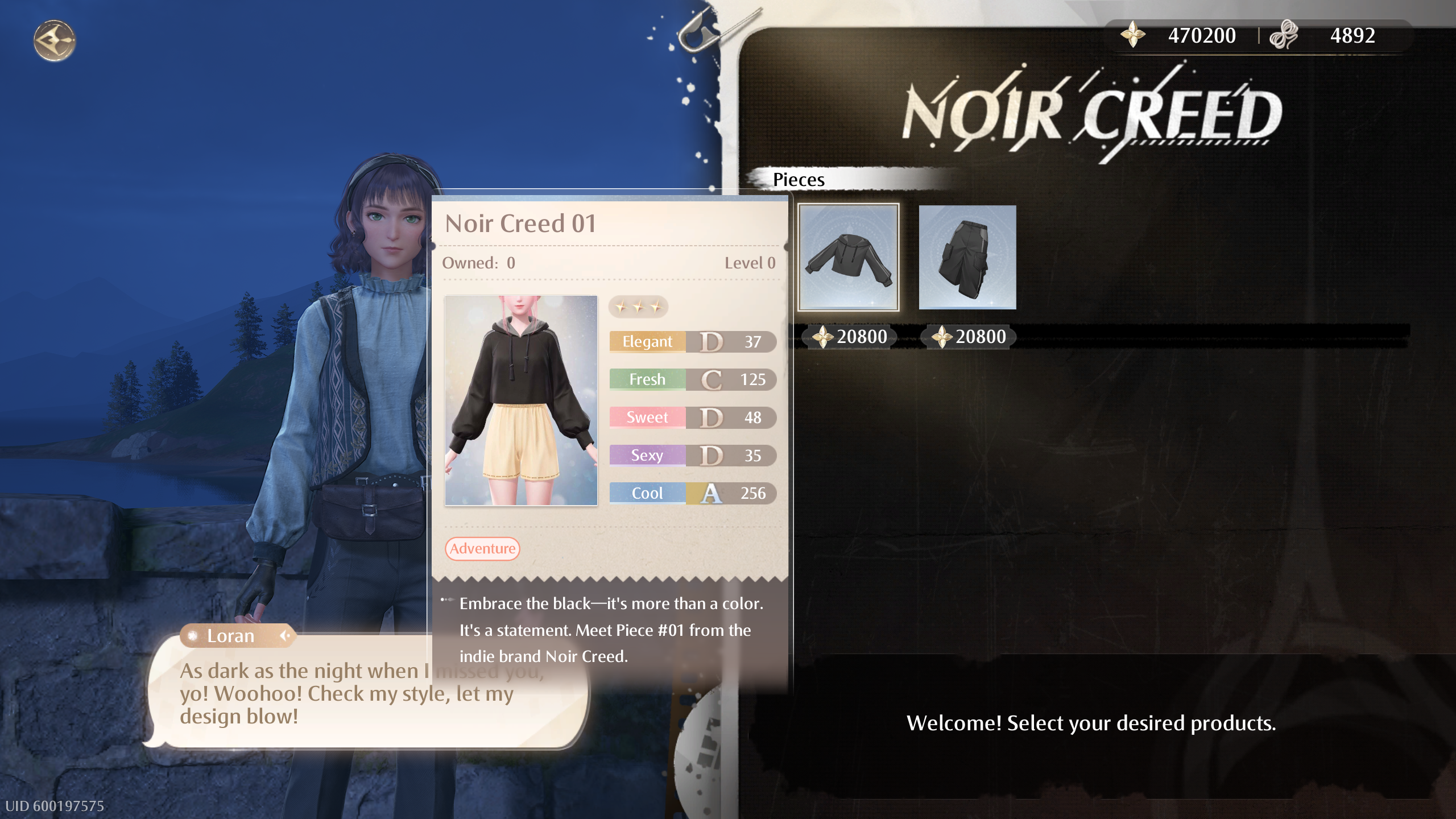
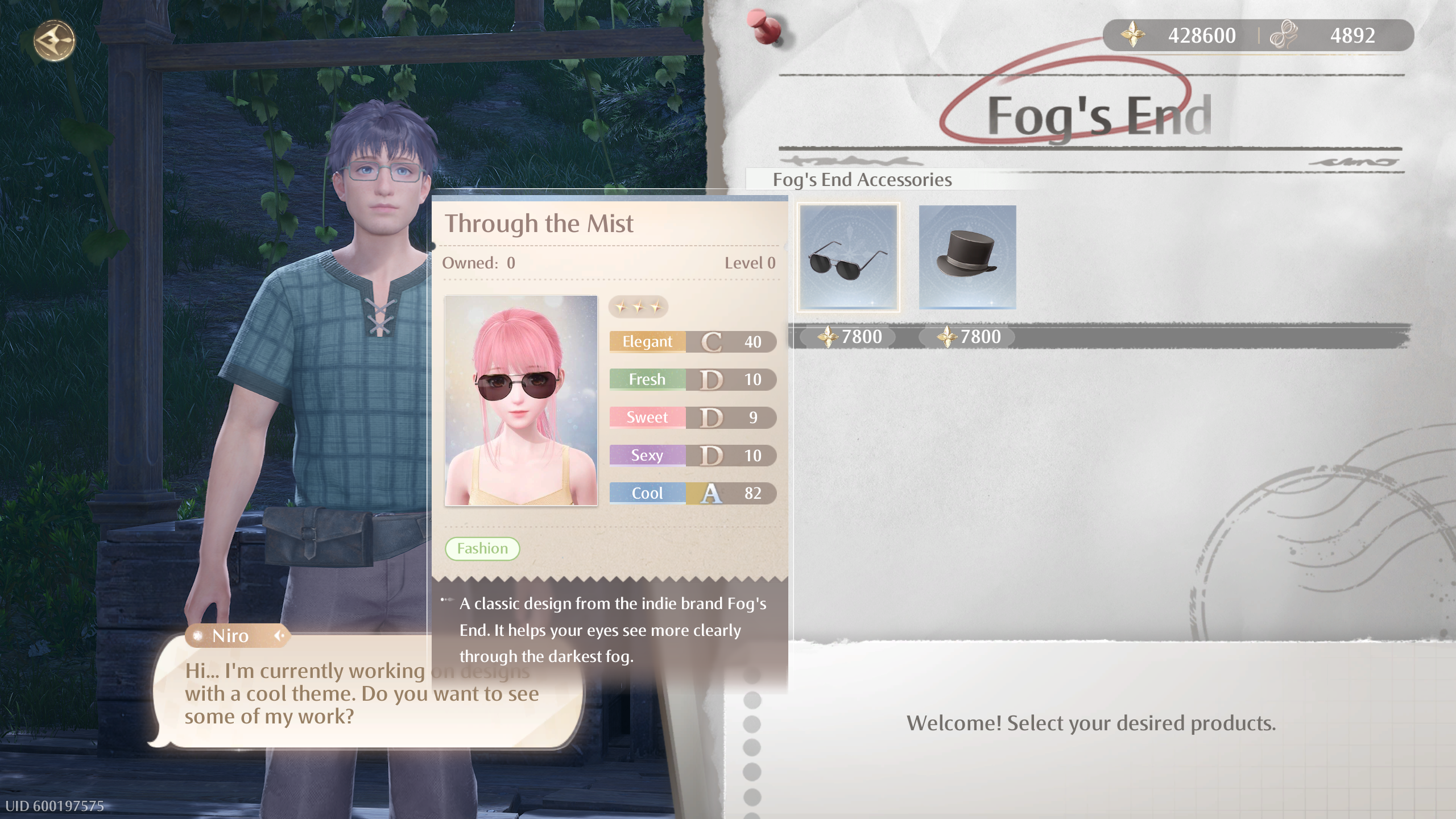
My only complaint now is that these cool clothes are all black and there are so few of them. There are some other cool clothes at the Marques Boutique in Florawish like the leather jacket and leather-strapped cargo pants, but they were difficult to build an outfit around. With the sweat suit pieces from Loran in particular, you'll at least have some cool neural colored pieces to build looks around.

Infinity Nikki codes: Which freebies are active now?
Infinity Nikki multiplayer: How co-op works right now
Infinity Nikki resonance banners: What's active and coming next?
Aventura quiz answers: Observe wisely
Infinity Nikki Wishful Aurosa: how to craft the miracle outfit
Infinity Nikki calm thoughts: Get upgrade materials
One of the best cozy games that I don't ever see enough people putting on their cozy GOAT lists is Toem, a black & white adventure game about completing a photography stamp book challenge. I never anticipated getting more of its silly charm but developer Something We Made has just announced the sequel, Toem 2, during the Wholesome Snack showcase and I am delighted.
The teaser at the Wholesome show was super brief but Something We Made shared a few more screenshots on its new Steam page. Toem 2 is keeping the all black & white aesthetic but looks like it's going proper 3D instead of the isometric perspective of Toem. The rest sounds like a lot more of just what I enjoyed in the original.
"Step back into the shoes of a curious photographer and set off on a brand new adventure all about uncovering hidden details, helping friends along the way, and documenting the world’s little wonders in Toem 2," its developer says.
"The team is back together, including our amazing composers!" Something We Made added on X. "Together, we’re working hard making it something that can stand proudly beside the original game, celebrating what worked, while improving the rest."
The original Toem is an adorably goofy adventure where you follow hints on your stamp rally card to photograph things around you in ways you may not expect, sort of like a Pokémon Snap that moves at your pace. Sometimes you need to find and wear an outfit to complete a clue. Other times you've got to work out how to get your intended subject out of hiding. Other times you're attending and documenting a bear rave in the forest.

Although there's very little to go on in the Toem 2 store page, I'd be willing to bet that it will share a lot of those adventure game vibes by making you figure out how to progress to new areas, solve problems for NPCs, and collect a wardrobe of silly fits.
The only other thing I'm hoping to get from Toem 2 is a slightly longer adventure, even though the original was a delightfully short and sweet few hours. There's no release date for Toem 2 just yet so you'll just need to wishlist it to keep track of it for later.
]]>The story of Naiad puts you in the role of the guardian of a river, and your main aim is to protect your surroundings from the humans who try to take advantage of it. I feel like this theme has been referenced across a lot of 'cozy' games lately, or at least some sort of reiteration of the importance of saving the natural world.
We've saved the wetlands in Kamaeru: A Frog Refuge and ventured through deforestation in Gibbon: Beyond the Trees. I thought there were only so many iterations of different ways we can learn about our impact on the planet through games, but I continue to be impressed by the creativity of developers each time a new one comes to light.
Naiad does a great job of translating this message in a way that stays with you long after you've left it, which I can say from experience given this game has sat in the back of my mind for two years now. This is mostly because such a heavy message is approached in quite a subtle way and it's a story that develops as you float along the game, rather than being thrown at you straight off the bat and then leaving you to pick up the pieces afterwards.
For example, instead of coming face to face with the people you're trying to stop from polluting the river, the story relies more heavily on the natural world as a teaching mechanism. Throughout Naiad you rely on the natural world to teach you different skills. At first, you learn to swim like a duck and you're challenged to unite lost ducklings with their family. Next, you learn to dive like a fish to help navigate obstacles across the river. The game is brimming with these important lessons taught by nature to help you on your way, and these interactions between the protagonist, Naiad, and the curious creatures you encounter is one of the things that kept Naiad from ever leaving my mind since I played its demo.
But the most prominent part of Naiad, and more than likely the thing that will stick out to players who are seeing it for the first time, is the art style. There's something beautifully homemade about its world design, and I don't mean that in the sense of it looking rough around the edges. Naiad looks like it has been painstakingly crafted by hand, even down to every last petal, branch, or ripple in the water.
Despite the game taking pride in its 'minimalist' appearance, I can't help but feel as if it's a lot more detailed than it lets on. I already know it's the type of game I'll play through in no time at all, but then go back to discover whatever secrets I missed the first time around. And finally, I'll be able to finish what I started so many moons ago.
]]>I've been enjoying Infinity Nikki a lot so far, so I'm pleased to see that it's managed to find plenty of new players in a weekend that also saw a lot of attention on record-setting player counts for Path of Exile 2's launch and some big player numbers in Marvel Rivals too.
What we don't know about that number is how many players are specifically on PC between the official Infinity Nikki launcher and the Epic Games store. We also don't know about concurrent player counts, though that metric doesn't mean too much for Nikki. It does have some social elements but Infinity Nikki's multiplayer is still mostly non-existent with some expected developments in the future.
As a thank you for the downloads, Infold Games is awarding all players with 10 Resonite Crystals—the in-game currency that's used to roll for some of the Infinity Nikki resonance banners. That will be delivered to your mailbox in game where you'll need to claim it by December 31.
Cozy games overall have still been on the rise this year as I predicted at the end of last year, and it's been great to see so many fans find something to love in a series that's clearly put so much effort in its jump to PC from its mobile game origins.
In our Infinity Nikki review, series fan Mollie Taylor found a lot to love in its beautiful outfits and environment designs but was overall a little underwhelmed on the difficulty. I'm with her on the hair and cloth physics being lovely and personally I've been really enchanted by the many different musical themes for each area. The platforming puzzles are also good fun, even if they are mostly pretty simple.
Infinity Nikki is carrying on with a slew of limited time launch events as well, so it's still a good time to log in and grab those free Resonite Crystals along with other rewards.

Aventura quiz answers: Observe wisely
Infinity Nikki Wishful Aurosa: how to craft the miracle outfit
Infinity Nikki calm thoughts: Get upgrade materials
Infinity Nikki Bedrock Crystals: Where the heck is a Bouldy at?
How to upgrade outfits: What's the difference between an evolution and a glow up?
It's a frustrating lack of information early on, especially if you're feeling particularly enthusiastic about crafting every sketch you pluck from Miraland's treasure chests or the Heart of Infinity. Thankfully, the unlock happens early on in the story and obtaining Bedrock Crystals becomes an easy endeavour from there. Here's when you'll unlock the ability to grab these crystals and how to go about doing so.
How to obtain Bedrock Crystal
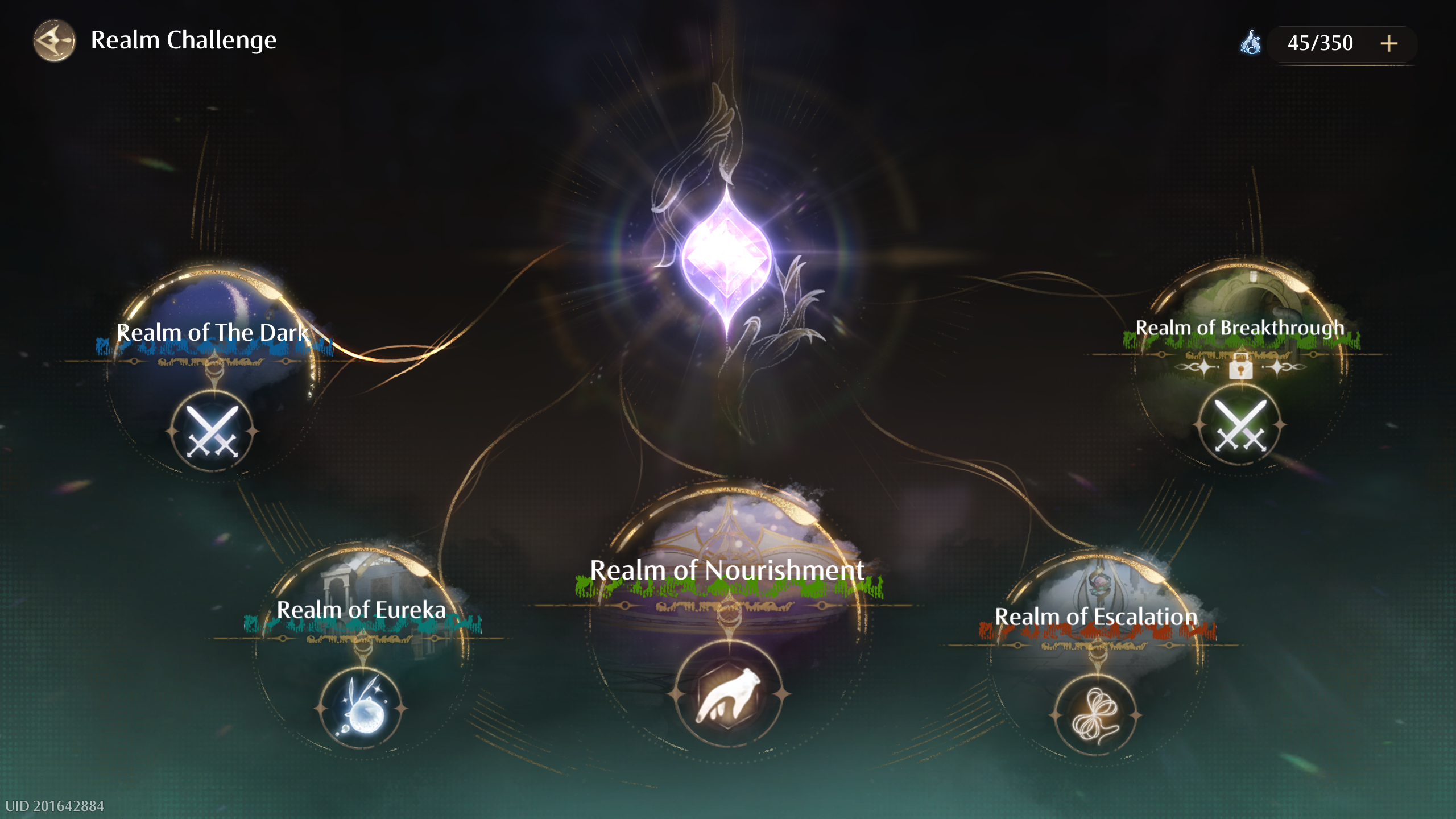
To obtain any Bedrock Crystal, you first need to unlock the Realm of the Dark. This should happen shortly after the chapter 2 quest Secret Ledger, which'll lead you to a cave where you face off against Infinity Nikki's first boss; the Bouldy.
Once you've successfully defeated your first Bouldy, head to any activated Warp Spire on your map and open up the Realm Challenge menu. You can head to the Realm in the Dark—it should be the one on the far left—where you can challenge the Bouldy again and obtain materials.

Infinity Nikki codes: Which freebies are active now?
Infinity Nikki multiplayer: How co-op works right now
Infinity Nikki resonance banners: What's active and coming next?
Aventura quiz answers: Observe wisely
Infinity Nikki Wishful Aurosa: how to craft the miracle outfit
Infinity Nikki calm thoughts: Get upgrade materials
You'll notice, however, that there are actually five different Bouldy challenges to take on, called Phantom Trials. If you look closer at different sketches' material requirements, you'll see that each pinkish-rocky orb has a different symbol on it. There might be a crown with pink iridescent stone, or a bluey-green tear, or bright purple stone with a sort of smiley-looking shape.
Each Bedrock Crystal has a sub-name attached to it: Energy, Hurl, Plummet, Tumble, and Command, so make sure to double check which one is required before you go diving head-first into a random Phantom Trial. Each Bouldy has slightly different mechanics, too, so don't expect the same experience every time.
Each Bouldy defeated will reward you with five Bedrock Crystals for every 40 Vital Energy you spend after completing the fight. Most items of clothing require between three and 10 Bedrock Crystals.
]]>That's still mostly true, until I realised that I wanted to craft the Wishful Aurosa outfit. Turns out, I gotta do a lot of stylist battles across various in-game factions in order to obtain every piece. After initially brushing them off as a tedious grind, I've come to absolutely adore them. They're campy, creative, and secretly one of the coolest parts of the entire game.
The reason I'd largely slept on the styling battles was because the handful I had played started off very samey. I approach an NPC, throw on my highest-scoring clothes according to whatever tags are part of the theme and then sit through a lengthy cutscene as the camera pans around my hideous creation, crossing my fingers that I score high enough so that I don't have to do the whole thing all over again.
The skirt is mightier than the sword
They're sort of the trash mobs of styling battles though, the boring bits I have to slice 'n' dice—or I guess, dress 'n' impress—my way through to get to the far more exciting part. As I inched closer to the Sovereign of Cool, the first fashionista Big Bad you encounter in Infinity Nikki, I became privy to tons of interesting lore around not only her, but the factions that operate under her.
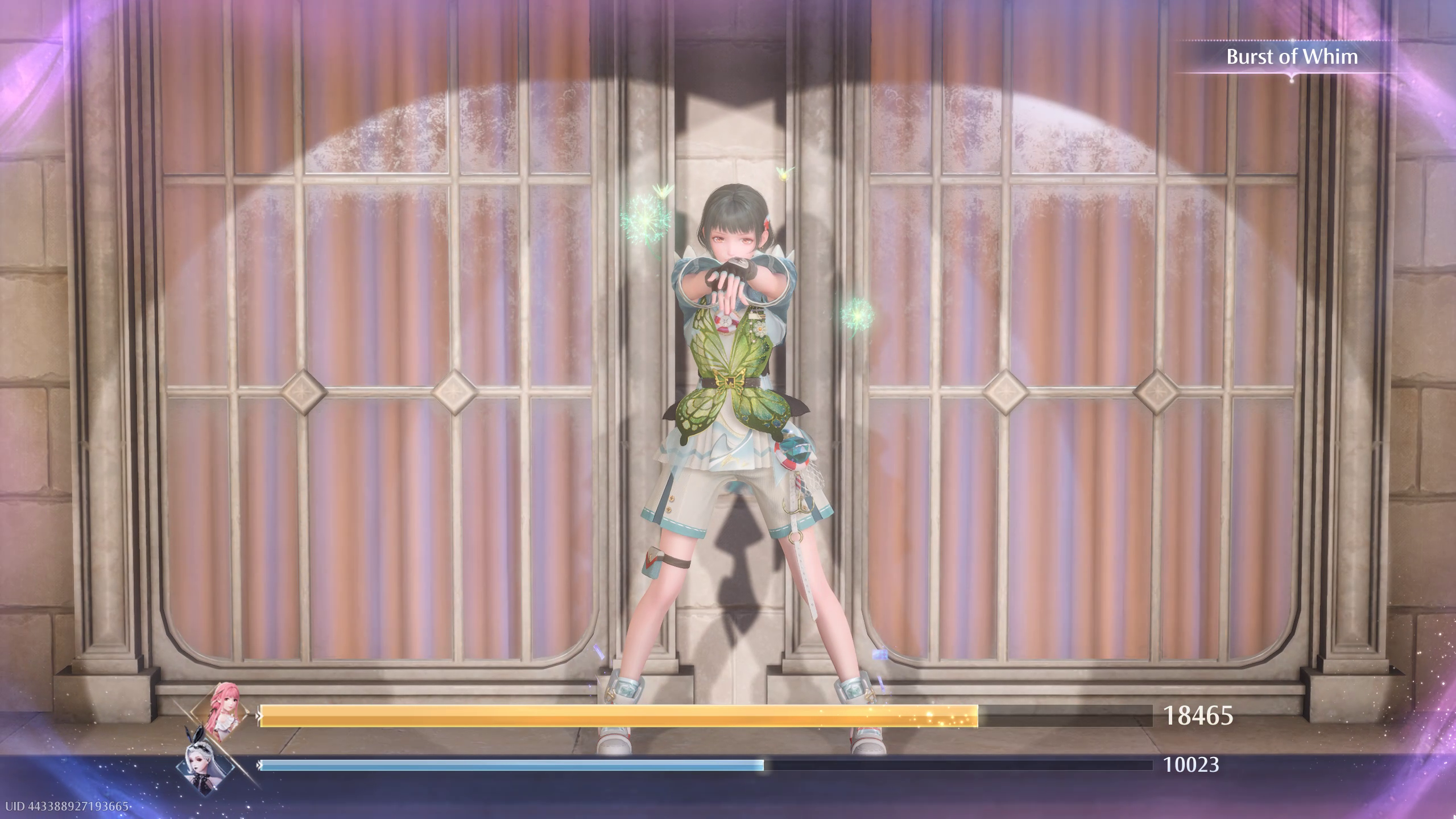
You've got the Golden Daisies, for example, a flora-loving guild who also happen to be beefing with the Ebony Scissors. I also got glimpses of dissent among the ranks—members of Beyond the Basics seem to actively disagree with how the Sovereign of Cool is running things, likening her to a tyrant. Do I feel like a kid crossing paths with Pokémon trainers sometimes as I flitted around each stylist? Sure, but it's also some real neat lore in a world that's supposed to be all about fashion.
Things open up even more as I reach the finish line, being given a quest where I have to venture into a basement bar in the middle of the night and pry the Sovereign of Cool's whereabouts out of three brothers, who act as her lackeys. They're big, burly blokes, but this isn't a game where punch-ups solve problems. As Nikki put it: "They'll try to stop us? With styling, I suppose."
Again, very cartoon bad-guy, but I can't help but be ridiculously invested at this point. I defeat all three brothers, and they point me in the direction of how I can challenge Aderinna, the coveted Sovereign of Cool.
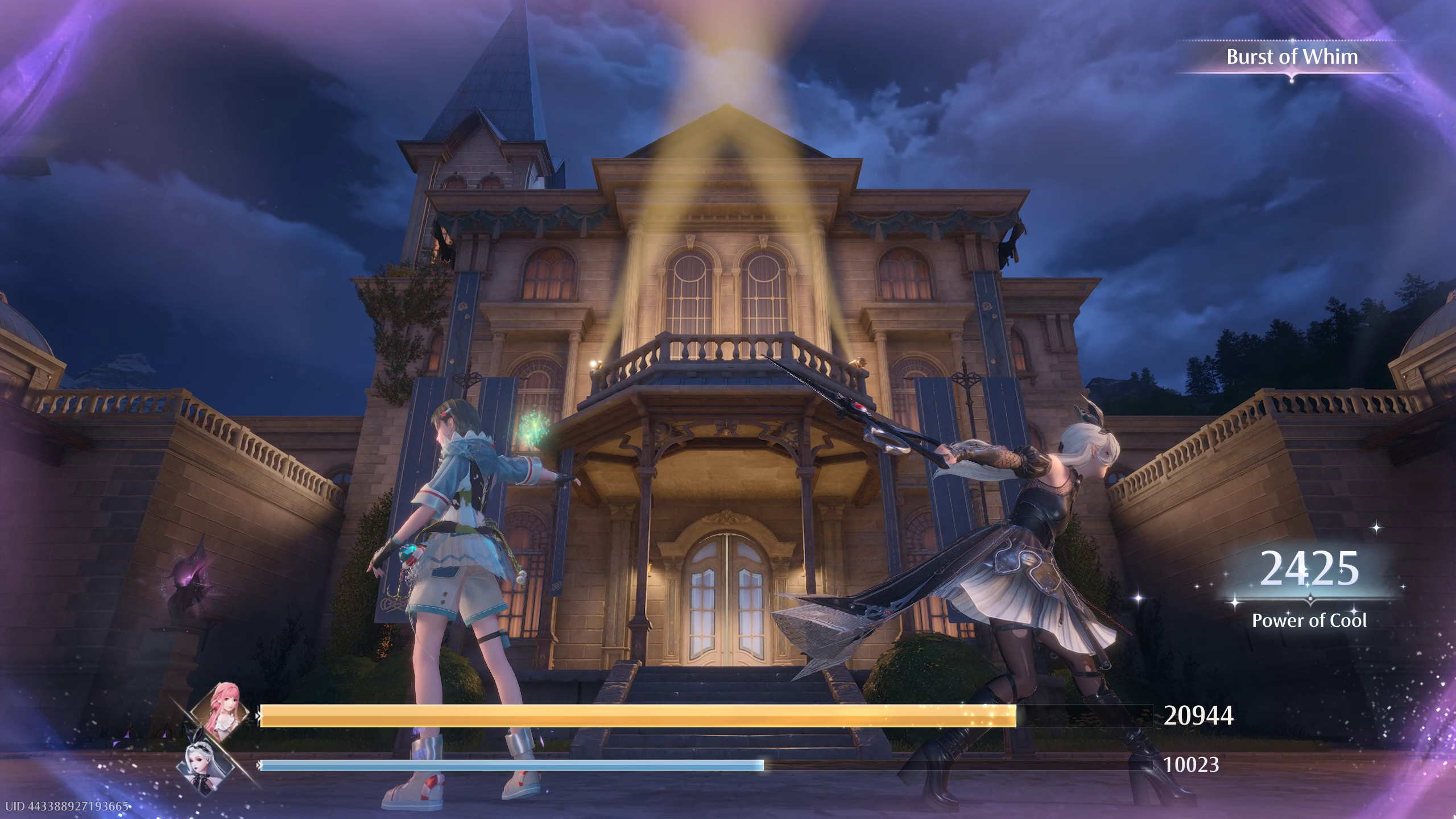
I was expecting the final battle to be the same animation as the previous 15 battles, which had admittedly started wearing on me a touch at this point. What I wasn't expecting was an all-out phantom thieves performance across rooftops and balconies, giant spotlights and dramatic angles that wouldn't go amiss in a theatre performance.
That's exactly what I got, though, and I couldn't help but watch, mouth agape, as my Nikki—dressed downright daft in fishing gear and whatever else I could get my hands on, her glittery green waistcoat clipping like nobody's business while she very seriously strikes poses and stares down Aderinna. Like I said, the whole thing is supremely campy, perhaps unintentionally so, but that's what made the whole thing so downright charming.
It was worth slogging through the initial battles to get there, so much so that I ended up diving straight into the next group of factions to eventually take on the Sovereign of Elegant. That one's led me down a road of rumours and myths relating to banshees, ominous songs, and people being controlled like puppets. This sort of thing is definitely not what I expected in my ultra-cosy game where I prance around fields brushing sheep and picking flowers, but I'm loving every second of it. Let me get flung around in whatever abomination of an outfit I end up throwing together next, please.

Infinity Nikki codes: Which freebies are active now?
Infinity Nikki multiplayer: How co-op works right now
Infinity Nikki resonance banners: What's active and coming next?
Aventura quiz answers: Observe wisely
Infinity Nikki Wishful Aurosa: how to craft the miracle outfit
Infinity Nikki calm thoughts: Get upgrade materials